

10 Non-Touristy Seoul Neighborhoods to Visit
- September 29, 2023
Overview Hide
What to do in seongsu, what to do in mangwon, what to do in seongbuk-dong, what to do in yeonnam, what to do in mullae, what to do in hapjeong, what to do in hyehwa, what to do in seochon, what to do in sangsu-dong, what to do in huam-dong.
While the popular Seoul neighborhoods , like Dongdaemun and Gangnam, are beloved by Koreans and foreigners, only the locals know where the hidden gems are. There are many affordable activities to do in Seoul , but visiting these neighborhoods should be a top priority. Do as the locals do and visit these non-touristy, under-the-radar neighborhoods to get to know Seoul:

Seongsu has quickly risen in the list of hip areas in Seoul in the past few years. Formerly an industrial area, Seoul’s young entrepreneurs have come into the area to convert warehouses and factories into hip cafes, restaurants, and galleries. Seongsu does see its fair share of young tourists but doesn’t feel touristy and retains its unique atmosphere. The area is often compared to New York’s Brooklyn borough, but Seongsu sets itself apart from Brooklyn with its bright and colorful charm.
Visit Seoul Forest
Seongsu’s biggest attraction, Seoul Forest, offers a relaxing place for young couples, families, and the elderly. The park is massive and features natural areas as well as art installations. Going to the park for a stroll or lying on a bench is a common activity among Seongsu residents.
Check out a pop-up store.
Seongsu, being the hip and trendy place, is a hub for pop-up stores. Although knowing when and where pop-up stores will happen is hard, you may stumble upon one while walking around the area. Finding the coolest pop-up stores in Seongsu will be a true test of your status as a Seoul insider.

Even though this neighborhood is in the biggest city in South Korea, it has a quiet, small-town charm. In the area around Mangwon Market, you’ll find grandmas running open grocery markets that sell baskets of fruits and bundles of vegetables. People push their bicycles in the market while talking to the store owners. The surrounding areas of the market are residential, so it’s no surprise that this area has a close-knit feel.
Try the chicken at Mangwon Market.
Trade in the popular and busy Gwangjang market for Mangwon Market. The market primarily caters to locals doing their daily shopping, but Mangwon Market has plenty of Korean street foods comparable to Gwangjang’s in taste and price. The must-try foods at Mangwon are seasoned fried chicken and twigim (튀김) or various fried foods.
Ride a bike at Mangwon Hangang River Park.
After grabbing coffee from one of the many cafes in the Mangwon area, head to Mangwon Hangang park for a bike ride. Renting bikes to ride along the Han River is a popular activity, and Mangwon Hangang park is the perfect place. This park isn’t as talked about as Banpo or Jamwon Hangang, but it is still a great place to see the Han river and cityscape.
Seongbuk-dong

Lying in the north of Seoul is Seongbuk-dong. This neighborhood is perhaps one of the least touristy neighborhoods on this list, arguably adding to its charm. The area is covered in trees and is home to historical attractions such as Suyeonsanbang and Simwoojang.
While the area offers a nice break from the concrete jungle of central Seoul, it’s also well-known for the wealth gap within the neighborhood (the neighborhood even makes a cameo in Bong Joon-Ho’s film Parasite). Seongbuk-dong is home to the wealthy, including ambassadors, but at the same time, it is home to one of Seoul’s last poor hillside villages, Bukjeong.
Visit Simwujang (심우장)
Simwujang is a historically significant location, yet visitors often miss it. The house was the residence of monk, poet, and independence activist Han Yong-un, who wrote under Manhae. The small house is open for visitors to explore and holds Han’s writings and other possessions.
Do a temple stay at Gilsangsa (길상사)
Gilsangsa is a fairly new temple in Seoul, but its location in Seongbuk-dong cannot be beaten. Visiting the temple offers a great look into Korean Buddhist culture and a nature-filled escape from the city. If you can’t get enough of the beauty of Gilsangsa, participate in a temple stay during which you will learn about Buddhism by living alongside and talking with monks.

If you don’t like Hongdae’s crowds, try exploring the nearby Yeonnam neighborhood instead. Yeonnam is littered with cafes and restaurants as trendy and aesthetically pleasing as Hongdae’s. Although it can get busy on the weekends, Yeonnam is fairly quiet and empty during the weekdays, save for the locals in the area. Yeonnam’s quirky and unique cafes make it a great place to hang out with friends or date.
Walk in the Gyeongui Line Forest Park
This park runs for 6.3 kilometers through the Yeonnam neighborhood. If you visit the park, you’ll notice railroad tracks of the old Gyeongui Line that used to go to Pyongyang, North Korea. When the Gyeongui line was moved underground and turned into a subway line, the city transformed the above-ground railway area into a green space for Seoulites to enjoy.
Go cafe-hopping
Yeonnam is one of Seoul’s cafe-dense neighborhoods, perfect for coffee-loving cafe hoppers. The famous Instagram 2D cafe, Greem Cafe , is located in Yeonnam. If Greem Cafe is packed, there are plenty of other cafes in the area to try. For those with a sweet tooth, Cake Dabang has cakes you can decorate. The variety of cafes in Yeonnam is unbeatable.
For more Yeonnam cafe recommendations, check out Seoulspace’s article “10 Must-Visit Yeonnam Cafes.”

Mullae, a neighborhood lying south of the Han River, was an industrial area known mostly for its metalwork. Artists moved in and set up workshops when the steel and iron industries started to leave Mullae. Today, Mullae is most famous for its art village, similar to the Ihwa Art Village in northern Seoul. Despite the more artsy reputation, the neighborhood retains much of its industrial aesthetic.
Take in the art
Mullae’s art village covers a large section of the neighborhood. All along the alleys between buildings are colorful murals, exemplifying the artistry of the area. The art village is filled with workshops, cafes, and restaurants. Make sure to check out the interiors of these establishments after you enjoy the art in their exteriors.
Order a drink at one of Mullae’s bars.
While many people visit Mullae for its art, its bar scene is also worth checking out. The neighborhood’s industrial aesthetic perfectly sets the mood for a beer with friends in the evening. Old Mullae is a popular cafe by day and bar by night. Here you can order comfort foods, like fries or nachos, to enjoy with your draft beer.

Another alternative to Hongdae, Hapjeong is only one subway stop past the Hongik University stop. Seoulites have been flocking to the Hapjeong neighborhood as Hongdae becomes increasingly gentrified. As a result, Hapjeong has gained a hipster reputation. Although it isn’t as under the radar as it used to be, the Hapjeong area is perfect for a casual outing with friends.
Once again, one of the best ways to get to know Seoul’s underrated neighborhoods is to visit its cafes. Hapjeong is known for its cafes, which have a variety of aesthetics. Anthracite is a popular Hapjeong cafe located in a former shoe factory. The unique aesthetic of the cafe and its great coffee make it a must-try while in Hapjeong. We also recommend checking out The Key Coffee (덕희커피) , which feels like it could be your hometown coffee shop.
Visit YG Entertainment
If you’re a K-Pop fan, visit the YG Entertainment building in Hapjeong. YG has produced influential groups such as 2NE1, Big Bang, Epik High, Blackpink, and AKMU. The main building has a merch store in the basement so that you can stock up on K-Pop albums. YG Entertainment also has a cafe you can stop at while cafe-hopping.

This neighborhood is located high up on a hill, yet another university area. The Hyehwa neighborhood includes Seoul National University’s Yeongeon and Sungkyunkwan University. Hyehwa is fairly calm for a university area but has the classic staples for any college crowd: cafes, clothes shops, and cheap food. Even better, one of the less-frequented royal palaces is right next door. This non-touristy university neighborhood is great for anyone looking for a chill day out or some alone time to explore historical sites.
Visit Changgyeonggung (창경궁)
Bordering the west side of today’s Hyehwa neighborhood, Changgyeong palace was built in the 15th century under the direction of King Seongjong. He was only 13 years old when he ascended to the throne. The palace served as the residence for three dowager queens: Seongjong’s grandmother, aunt, and mother. The palace grounds include long walking trails through a forest, a pond, and a greenhouse. The expansive nature areas make Changgyeonggung a great place to take a relaxing stroll through history.
Visit Korea’s oldest university, Sungkyunkwan (성균관)
Established in 1398, Sungkyunkwan was the highest educational institution of the Joseon Dynasty. The institution focused on teaching Confucianism to prepare its students for the national civil service exams. The name Sungkyunkwan means “institute to make a great society.” You can still see the original Sungkyunkwan buildings on today’s Sungkyunkwan University campus in Hyehwa.

Seochon, the neighborhood to the west of Gwanghwamun and Gyeongbukgung, is often overlooked by tourists who tend to visit Bukchon, the neighborhood on the east side of the main palace. Like Bukchon, Seochon is filled with traditional Korean architecture or hanok (한옥) buildings but has some lighter foot traffic than Bukchon. The Seochon area used to be home to numerous Korean artists, and it retains this artistic spirit with the many boutiques in the neighborhood.
Eat at Tongin Market
This market is smaller than other popular markets, but its fame doesn’t come from its size. Instead, Tongin Market is known for being the Dosirak (도시락) market. Here you can trade in real cash for Joseon coins to use at the participating food stalls to fill up your dosirak tray. This is a great way to get acquainted with Korean foods such as mung bean pancakes, tteokbokki, twigim, kimbap, and more.
Visit Park No-soo Museum
This museum has a collection of over 1000 art pieces by painter Park No-Soo. The museum was Park No-soo’s residence until he died in 2013. The house incorporates elements of Western and Korean architecture. Much of the house’s interior is preserved from when Park lived there. The museum is a great place to learn not only about Korean art but also about Korean history.
Sangsu-dong

Bordering Hapjeong and Hongdae, Sangsu-dong is perhaps the least discussed alternative to the Hongdae neighborhood. Maybe it’s because Sangsu is often grouped into the larger Hongdae area. But trust that this area is distinct enough to deserve individual praise. Sangsu is a bit more lowkey and hipster than Hongdae. The neighborhood’s cafe street is packed with unique and independent cafes.
Go thrifting at secondhand stores.
What’s more hipster than thrifting? Buying clothes secondhand is slowly becoming more popular among young Koreans. There are plenty of Sangsu-dong stores catering to those looking for vintage items. Page One , located only a block from Line 6’s Sangsu station, is a great place to find a range of vintage feminine clothes. Secondhand stores in the Sangsu-dong area are Guerilla Radio , Tokyo General Store , and Pijomul .
Check out Sangsu-dong’s independent cafes.
Sangsu-dong’s less-touristy cafe street is a great place to go when all of Seoul’s other streets are packed. We recommend checking out Siyeon (시연) cafe on the main road where Sangsu subway station is located. Siyeon has a cozy atmosphere with its shelves of books and worn wood furniture. If you want to get further away from the crowds, try Sangsubang Cafe , located in the southern part of Sangsu. While this cafe isn’t in the cafe street area, it’s still worth checking out for its drip coffee and cheesecakes.
As part of the larger Itaewon area, Huam-dong has a culturally mixed history. This neighborhood was home to affluent Japanese people during the colonial era. After liberation, Korean war refugees settled in Huam-dong. You can still see the history of this neighborhood in its diverse architecture. Today, this storied neighborhood attracts younger crowds with cozy cafes and restaurants. While you may see some foreigners in the area, Huam-dong is a nice change of pace from the busier Itaewon.

Stroll along the Soweol-ro, or foliage road
Between Namsan and Huam-dong is Autumn Foliage Road, formally known as Soweol-ro. This road is designated where people can see the beautiful leaves turn during the autumn months. Seeing Namsan in autumn is one of the most beautiful views in Seoul. Although this activity is restricted to autumn, it is still worth the experience for those in Seoul at the right time.
Visit the Heaven Stairway
Built by the Japanese during the colonial period, Huam’s 108 steps lead up to a Shinto shrine. Koreans living in the area were forced to walk up these stairs daily to pray and pay respects at the shrine while living under Japanese rule. While the Shinto shrine was destroyed once Korea was liberated from Japan in 1945, the stairs remain. These stairs appear unassuming, but they serve as a reminder of Korea’s history.
Related Topics
- seoul forest
Sam Nguyen is a fourth-year University of Oregon student double-majoring in Journalism and Global Studies and minoring in Korean. During college, she wrote feature stories and served as managing editor for the multi-cultural independent student publication Ethos Magazine. Her interests include writing, editing, the Korean language, and Korean culture.

ETERN!TY – The Best Virtual Kpop Girl Group
- September 27, 2023

10 Memorable KDrama Kiss Scenes You Can Watch on Netflix Right Now
- October 1, 2023
You May Also Like

10 Tips for the Boryeong Mud Festival – Best Festival in Korea
- April 1, 2024

5 Amazing Cultural Experiences in South Korea to Try When Visiting Korea

The 10 Best Pensions in Korea to Visit
- March 15, 2024

Top 10 Coolest Places to Visit in Seoul – Updated
- March 7, 2024

10 Things to do in Dongdaemun for locals and tourists
Top 10 korean phrases to know when traveling to korea.
- January 22, 2024

Places to Visit in Dosan Park, the Hottest Street in Seoul – Top 10

The 10 Best Museums in Seoul to Visit this Year
Leave a reply cancel reply.
You must be logged in to post a comment.
Input your search keywords and press Enter.
Unlock more content
SEOUL - north | SEOUL - south
Day Trips from Seoul | Busan | Best Collections
🍁 Festivals ( Seoul • Busan )
Top 29 Hidden Attractions & Secret Places to Explore in Seoul
How many times have you returned from your holidays in Seoul only to find out that you have missed a nice cool place close to where you have visited? Have you been to Seoul a few times and wonder what other unique or hidden places that you can do for that Instagram-perfect shots and be the first to share among your friends?
Which are the popular local places and things to do in Seoul that are not covered on the official tourism websites or guides?
Here are KoreaToDo's TOP Hidden Attractions & Secret Places to Explore in Seoul (not in any particular order):
1. starbucks the bukhansan.
Starbucks The Bukhansan offers stunning view of Bukhansan Mountain peaks. It is located near the popular Bukhansan National Park in the city center of Seoul.
Opened on 15 February 2023, the store spans across 2 floors with a rooftop terrace at a massive 1,100 sqm and 253 seats.

Starbucks The Bukhansan

2. Starbucks Kyungdong 1960
Opened on 16 December 2022 and now a hot spot in Seoul, Starbucks Kyungdong 1960 is remodelled from an abandoned theatre located in the traditional Gyeongdong Market, Dongdaemun-gu.
The coffeehouse spans across 2 floors (3F & 4F) at a massive 805 sqm with 200 seats.

Starbucks Kyungdong 1960

3. Ikseondong Hanok Village
Ikseondong, the oldest hanok village in Seoul was once to be demolished and replaced with a multi-storey residential complex. It survived and in March 2018, it was designated as the last hanok village, Ikseondong Hanok Village in Seoul.
Today, it has successfully transformed into a hot place with great shops, cafes, pubs and restaurants.

Ikseondong Hanok Village

4. Express Bus Terminal Underground Shopping Mall (GOTO MALL)
Bring home your favourite paintings or hunt for your best buy at this largest underground mall with 600 shops in Seoul.

Express Bus Terminal Underground Shopping Mall

5. Sky Bridge Tour @ Lotte World Tower
Opened in July 2020.
Walk across the outdoor bridge, 541m above the ground at Korea's tallest building, Lotte World Tower.

Sky Bridge Tour

6. Seodaemun Prison History Hall
Visit the real-time historical prison located at Seodaemun Independence Park, within 5 mins walk from its nearest subway station.
Besides its large compound and red-brick building structures, Seodaemun Prison History Hall is also a popular filming location for many Korean dramas (e.g. Goblin, Hide and Seek, Doctor John) for scenes when the characters are released from the prison.

Seodaemun Prison History Hall

7. Seoul Forest Cafe Street
You might have come across 'Seongsudong Cafe Street' with industrial vibes in Seongdong District. However, just one subway station away from Seongsudong Cafe Street and unknown to many foreign travellers to Seoul is the lovely 'Seoul Forest Cafe Street'.
Pretty chic shops, cafes and restaurants lined on both sides of the cafe street. Queues can be spotted outside popular restaurants too!

Seoul Forest Cafe Street

8. Oil Tank Culture Park
The cultural park was once a hidden petroleum reserve base of 5 oil storage tanks, holding enough oil reserves to power Seoul for 1 month, if needed.
Now, this strictly controlled area for 41 years is open to the public.
Explore the transformed huge oil tanks and cultural spaces at Oil Tank Culture Park, within walking distance to Haneul Park and World Cup Stadium Station.

Oil Tank Culture Park

9. Seochon (Sejong) Village
Dined at the famous Ginseng Chicken Soup Restaurant, Tosokchon Samgyetang ?
Packed your lunch box at Tongin Market ?
Yes, Seochon (Sejong) Village is in the same area. Besides its many quaint cafes, it is also the birthplace of King Sejong, the creator of Korean alphabets (& the face on the green Korean 10,000 won bank notes). Seoul's oldest bookstore, Dae-o Bookstore is here too!

Seochon (Sejong) Village

10. Cheong Wa Dae (Blue House)
Once the official office and residence for Korean Presidents since 1948.
On 10 May 2022, it was opened to the public for the first time in 74 years, on the day of inauguration of President Yoon Suk-yeol.
Visit the Blue House by making an online appointment or on-site application.

Cheong Wa Dae
11. jeongdong observatory & cafe darak.
Ever wonder where the beautiful photos of the autumn tree-tops along Deoksugung Stone-wall Road and Deoksugung Palace are taken?
Have you been looking for a observatory in Seoul that is free or conveniently located with subway access?

Jeongdong Observatory

12. Namsangol Hanok Village
Want to experience traditional Korean village life but Korean Folk Village is far while there is too much walking (esp. uphill) at Bukchon Hanok Village in Seoul?
Check out the surprisingly pleasant Namsangol Hanok Village so near to Myeongdong Station (1 subway stop / 15 mins walk).
💡From there, you can walk to N Seoul Tower, particularly beautiful in Spring and Autumn.

Namsangol Hanok Village

13. Seoullo 7017
If you are at Seoul Station or shopping at Lotte Mart or Lotte Outlets don't miss out Seoullo7017!
Seoullo 7017 was once 'Seoul Station Overpass', a road for cars. It has since transformed into a beautiful sky garden with different seasonal plants and flowers. One of the sky trails conveniently leads to Namdaemun Market !

Seoullo 7017

14. Mountain Ansan Jarak-gil Trail
Experience the beauty of a Seoul Mountain walking along the 7km elevated wooden deck that encircles the entire Ansan Mountain, passing through forest of sky-tall trees and scenic lookout points in 2.5 hrs or exit halfway to the popular Sinchon Shopping Street .
This barrier free forest trail is accessible from a subway station and is wheelchairs and baby carriages friendly too!

Ansan Jarak-gil Trail

15. Sungshin Women's University Shopping District
Have you been to most of the well-known shopping places like Myeongdong , Dongdaemun and Gangnam ? You have also been to the popular university shopping districts like Edea , Hongdae and Kondae ?
If so, check out Sungshin Women's University Shopping District, only few subway stops away from Dongdaemun and stop by their traditional Donam Jeil Market for the popular local eats.

Sungshin Women's University Shopping District
16. hansang gadeuk korean bbq restaurant.
BBQ on a king-sized pot lit?
The best hidden BBQ restaurant, uniquely in Seoul. Located within 5 mins walk from Sangam DMC (Digital Media City) subway station.

Hansang Gadeuk BBQ

17. Haneul (Sky) Park @ World Cup Park
A hilltop park of many surprises!
Golf-cart shuttle service available to take you to the top of the park too!

Haneul Park

18. Ttukseom Hangang Park
Wanna ride on duck boats on the beautiful Han River or rent a bicycle?
Check out the 240m long J-Bug cultural complex and paintings on the pillars below the bridge.
Enjoy the Hangang park with direct subway access and full of activities.

Ttukseom Hangang Park

19. Han River Cruise
Enjoy cruising along Han River with the seagulls!
Surprisingly affordable with many theme cruises (from 40 mins day cruise to 90 mins dinner cruise) for your picking.

Han River Cruise

20. Hongje-dong Gaemi Village
A rustic village located at one of the entrances (/exits) to Inwangsan Mountain hiking trail.
Hongje-dong Gaemi Village is a favourite photography hot spot for murals (artwork on wall) and Korean village scenes by the local photographers and photo enthusiasts.

Hongje-dong Gaemi Village

21. Dongho Bridge Walk
Wanna do something different in Seoul?
Why not walk across the bridge overlooking the beauty of Han River?

Dongho Bridge Walk
22. jamsil railway bridge walk.
An unique walk across the bridge connecting 2 railway stations end-to-end.
Feel the trains zapping past.

Jamsil Railway Bridge Walk

23. Seoul City Wall
Intrigued to hike at once a military controlled zone with armed guards and surveillance cameras around? Spot the 15-bullet holes pine tree!
The Seoul City Wall crosses Bugaksan Mountain. Check out the Bugaksan Mountain Hiking Trail (Southern side) that was re-opened to the public in April 2022, after 54 years.

Seoul City Wall

24. Cheonggyesan Mountain
Have a sumptuous local meal at the base of a mountain near Gangnam and be impressed.

Cheonggyesan Mountain

25. Olympic Park
Once, famous for its insta-worthy 'One Tree Hill' at Olympic Park, now the park has more superb photo spots particularly in Spring and Autumn when the seasonal flower fields (e.g. poppies, cosmos, roses, pink muhly grass) are in full bloom.
💡In Autumn, a walk along the 1.4km long Golden Ginkgo Tree Road is a must!

Olympic Park

26. Sanmotoonge @ Buamdong
Sanmotoonge is made famous as the film site of the Korean drama, 'The 1st Shop of Coffee Prince'.
The coffee house is nestled at the mountainside between Inwangsan and Bukhansan Mountains. It offers incredible views of the mountain range with artistically done interior.

Sanmotoonge @ Buamdong

Sanmotoonge @ Buamdong
27. gwanaksan mountain.
If there is one photo that always stay on your mind and you wish you can be there, Gwanaksan Mountain would have to be one of them!
The view of a Korean temple on the cliff edge is simply extraordinary.
Over the years, with the stairs built, this mountain is more accessible and you can enjoy the temple's view right from the observatory.

Gwanaksan Mountain

28. Seoul Grand Park
Seoul Grand Park offers many attractions. It can easily be reached on subway line 4 from Seoul Station in about 26 mins.
From its subway station, you can take the sky lift across the beautiful Gwacheon Lake with mountainous view. There are Seoul Zoo, Seoul Land Theme Park, Theme Garden and nature walking trails for you to explore and have fun.

Seoul Grand Park

29. Yeongcheon Market
Hidden away at the traditional Yeongcheon Market and a short 6 mins walk from Dongnimmun Station (line 3, exit 4) is the famous freshly-made Kkwabaegi (Twisted Korean Doughnuts) and a must-eat in Seoul!
The store is well-loved by the locals and has appeared in many TV shows like SBS and KBS.

Yeongcheon Market

Outside Seoul (on Seoul Subway):
Yangpyeong: Dumulmeori / Semiwon Garden / Strawberry Farms / Bukhangang Railroad Bridge
This nature beauty is easily accessible on Seoul subway. Go on a walk or rent a bicycle to explore the area, including strawberry picking (Nov-Jun) at one of the farms around.

Incheon: Chinatown, Songwol-dong Fairy Tale Village & Wolmido Island
Want the best jajangmyeon (black bean sauce noodles) in Korea? Look no further than Incheon Chinatown, the birthplace of jajangmyeon in Korea.
After a hearty Chinese meal, have fun at Songwol-dong Fairy Tale Village and Wolmido Island's Wolmi Theme Park.

Incheon Chinatown

Songwol-dong Fairy Tale Village

Wolmiido Island
Koreatodo top picks - tours, activities & discount tickets.
➥ Handpicked experiences by KoreaToDo for their uniqueness, value, popularity, price competitiveness and at times, tedious to reach by public transport.

Seoul Zoo Ticket & Scenic Sky Lift Rides (across Lake / top of Zoo)
Korea's largest zoo

IN THE SOOP BTS Ver. (PyeongChang) Filming Location Tour
incl. official merchandise gift!

Eland Han River Cruise & Ashley Marine Buffet at Dock
multiple cruise timings

Nami Island, Alpaca World & Chuncheon King Canoeing Day Tour
Top 100 Must-Visit Spots

DMZ 3rd Invasion Tunnel & Korea Traditional Boat Voyage Day Tour
river flowing out of North Korea

eSIM South Korea with high-speed & stable Internet connection (Data only)
per day data/total data option

Suwon Hwaseong Fortress, Starfield Library Suwon & Gwangmyeong Cave Tour
hottest library & UNESCO tour

Korea Rail Pass (KR PASS): KTX Bullet Trains to Busan & others (2, 3, 4 or 5 Days)
instant pass & tourist exclusive!
♔ KoreaToDo recommends Klook.com , Asia leading in-destination service provider.

🎵 SEASONAL HOT PICKS 🎶 Handpicked Experiences from Seoul

The 61st Suwon Hwaseong Cultural Festival Day Tour
4 - 6 Oct 2024
UNESCO World Cultural Heritage event

Nari Park (Pink Muhly Grass & Kochia) & Dumulmeori Half Day Tour
23 Sep - 18 Oct 2024
incl. Dumulmeori special hotdog

Sanjeong Lake, Apple Farm, Waterfall & Pocheon Herb Island Day Tour
2 Sep - 28 Nov 2024
pink mullies bloom only in fall
Other KoreaToDo 'Best of Collections' that you may like:
Top Popular & Unique Day Trips from Seoul under 3 hours
Best seasonal, music & cultural festivals worth visiting in/from Seoul
Top Favourite Scenic Hiking/ Walking Trails
Rent a bike and cycle along the beautiful Han River
Top Favourite Shopping Heaven in Seoul
Still looking? Explore KoreaToDo handpicked collection of:
Seoul - North of Han River
Seoul - South of Han River

Zen Moments in Korea
Seoul off the beaten path: 10 places to skip the crowds

Last Updated on May 24, 2023 by Ingrid & Alex
Are you traveling to Seoul for the first time but want to skip the crowds as well? Or is this your second or third time in the city and you want to discover some hidden gems? Here are my favorite places for Seoul off the beaten path you must explore.
I have gathered here places popular with locals, but less explored by tourists. It is true that most of these places are a bit further from the main tourist attractions, but most will be definitely worth the effort.
You will get to explore old neighborhoods transformed into cool and hip areas, colorful places such as the Gamcheon Village in Busan , and beautiful parks outside of the city.
This post contains affiliate links. This means if you click on the link and purchase the item, I will receive an affiliate commission at no additional cost to you. Read more about it on our disclosure page here .
Useful Travel Information for Seoul
Before we start going over the less-known attractions of the city, maybe you will want to go over this useful information that will help you better plan your trip.
Getting around Seoul – everything you should know
Choose the best area to stay in Seoul or stay close to Seoul Station
FAQ and General Travel Information : from SIM Cards to local currency, tipping, and much more.
VISA & K-ETA
You will or won’t need a visa, depending on where you are traveling from . Check your Visa requirements here!
Currently, South Korea has a visa-free online application process in place for certain eligible countries (you can check the list here ) that you must obtain before your trip.
K-ETA or the Korean Electronic Travel Authorization must be obtained before boarding a flight or ship. Here is some useful information regarding the K-ETA visa:
- The approval process can take more than 72 hours. Thus, it is useful to apply in advance;
- You will need to have accommodation booked before applying for the K-ETA. The address is one of the required information.
- The validity of the K-ETA visa is of 2 years from the date of approval;
- With the K-ETA you can stay in South Korea for 30 to 90 days;
- However, if you are visiting for travel purposes, and plan to return after your first visit, you will have to come back and update your visa with the new hotel address;
- One person can apply for up to 30 persons and can pay for all at once;
- K-ETA price : 10.000 won (around 9-10 USD)
10 off-the-beaten path destinations worth seeing
Buam-dong (부암동)

This residential neighborhood is tucked away on the cliffs of Bugaksan Mountain. You won’t find the bustling streets you might be used to around Hongdae or Insadong, and there are no skyscrapers like in Gangnam .
Don’t come here for cosmetics or tourist attractions, because you will be disappointed. However, this is the place to go to if you are looking for local art galleries, narrow streets with breathtaking views, pretty cafes, and some of the best local restaurants in town.
We really enjoyed this area and went back whenever we had a chill afternoon or wanted to enjoy a coffee with a view.
Visit Seoul Museum with its contemporary art exhibitions, stop by Seokpajeong , a former royal villa with impressive gardens, and relax at one of the many cool cafes on the cafe street. Bugak Skywalk is not easily reached but will enchant you with some of the best views of the city.
Where to eat in Buam-dong
We always went for lunch at this authentic traditional Korean restaurant with delicious food (specializing in dumplings) and breathtaking views. The restaurant is part of the Michelin Guide and is called Jaha Son Mandu . Go early for lunch if you want to catch a good table because this place is very popular and gets crowded fast.
It is also worth knowing that this is a traditional restaurant where you will be required to leave your shoes at the door. You can find out more about dining in South Korea here .
One of the cafes with the best views, popular with locals and tourists alike, is Sanmotunggi Coffee .

Another beautiful cafe and restaurant with a nice garden and beautiful views is Amelia Bailey .
How to get to Buam-dong
As mentioned before, this area is relatively secluded, but not impossible to reach. While you won’t have the subway at your disposal, there are several buses that will take you up the mountain.
Of course, you might need to walk a little, but that will be good exercise after all that delicious food.
From Seoul Station – take bus number 7022 . This bus also stops at Lotte World Plaza in Myeongdong.
From Gyeongbukgung – take bus 1020 .
Seongsu-dong
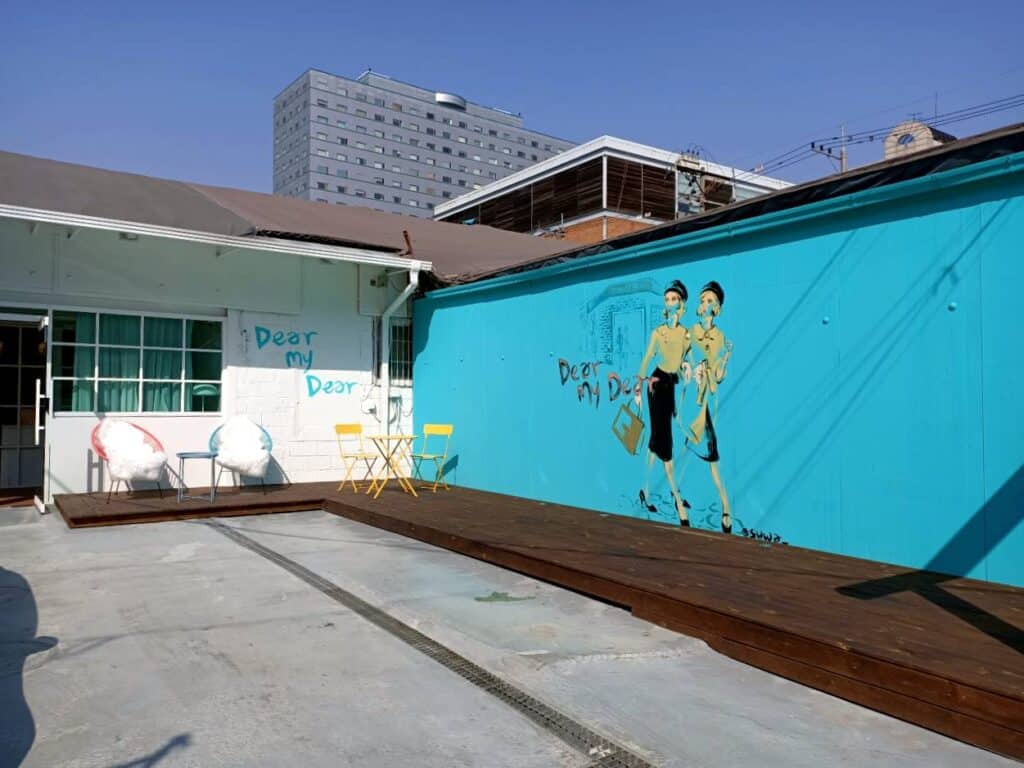
Another neighborhood less explored by tourists, Seongsu is considered by locals one of the most photogenic areas of Seoul.
What was once an industrial area, packed with factories and leather manufacturers, has now been gentrified and transformed into a cool area to explore.
People come here to take pictures with the murals available at every step, but also to enjoy a coffee at one of the many hip cafes around.

Come here if you want to shop for hand-made leather shoes or other goods, but also for the Seongsu Cafe Street.
One of my favorite cafes, Onion , has a branch in Seongsu as well, and I suggest you won’t miss it. You will find it at 8 Achasan-ro, 9-gil, Seongdong-gu.
Also, don’t miss a walk through the coolest clothing store in town – Ader. It is a Korean brand with a unique interior design. You might have to wait in line to get in, but it will be worth it.
Cosmetics lovers should not skip the Amore Seongsu Concept Store – a whole building packed with some of the most popular cosmetic brands. You can try as you like, do your hair and makeup, and also go home with some sample gifts. It is also one of the best places where to buy skincare in Seoul .
How to get to Seongsu-dong
Getting there is much easier than for the previous stop on this list because Seongsu is set on the subway green line. Get off at Seongsu Station and simply allow yourself to get lost on the streets.
Eunpyeong Hanok Village (은평한옥마을)

Forget about the Bukchon Hanok Village (or don’t and come here as well) and head over to the new and picturesque Eunpyeong Hanok Village.
With the mountains in the background, tens of traditional hanok houses are waiting for tourists to admire them. As expected, these are inhabited places so please pay attention and don’t be too noisy.
The ambiance you will discover here is much different than the one in its centrally located “brother”, but that’s what I loved about it.
Read also : Choose the best Hanok Stay in Seoul

Set in the middle of a lush green area, you won’t miss the fancy Korean restaurants or cafes with a view.
The village was founded in late 2014 when houses were built from scratch in an effort to increase the region’s tourist attractions.
If you cannot go to Gyeongju and admire the impressive royal tombs, get lost on the hill behind the hanok houses and you will discover a small shrine with a few tombs.

One of the most popular cafes offering the most stunning views, but also a fancy restaurant on one of its floors is 1인1상 . We were lucky to find a table by the window, and you might as well when you come in early.
How to get there
Once again, this place is a bit further away from the city center than you might expect. However, you can easily get there by subway and bus.
From Seoul Station , there is a direct bus that will take you straight in front of the Eunpyeong Hanok Village. Bus 701 will take you there in roughly 45 minutes.
Seonyudo Island Park

A beautiful park in the western part of the city, set on a small island in the middle of Han River. The place is worth visiting especially during spring , summer , or fall, because of its charming colors.
The place is not big, but once the blooms start you will find it hard to leave without taking millions of pictures. In the middle, there’s a small bamboo corner, and from its edges, you can admire the river and the city views.

Tucked away close to one of the entrances, you will find a small greenhouse, a piano, and a few friendly cats.
During our walk, a lady was playing the piano, the wind was blowing gently, and the cats were playing between the colorful tulips.

How to get to Seonyudo Island Park
Getting to the island is easy no matter which side of the Han River you are coming from.
From Seoul Station , take the subway for 8 stops all the way to Seonyudo Station . Take line 1 for 3 stops, change to line number 9 at Noryangjin , and ride for another 5 short stops.
Ihwa Mural Village (이화동벽화마을)

Ihwa Mural Village was once a popular tourist destination, pretty much like the Gamcheon Village in Busan . However, the area lost part of its attraction and importance during the time we spent living in Seoul, mainly because of the lack of tourists.
The village is only a little bit off the beaten path, only one stop away from Dongdaemun, in the Jogno-gu.
Ihwa is a colorful corner of Seoul and one where you will find many pretty cafes, but also k-drama shooting locations. I must admit I am not a k-drama fan, but it is difficult to miss the most important spots since they are marked for tourists.

Once again, as mentioned for other spots on this list, you should respect the resident’s peace and privacy. Never forget this is a neighborhood where people live their day-to-day lives.
From the top of the hill, you will see a part of the city’s old walls, and get to admire Namsan Tower and the city skyline.

As mentioned before, getting to Ihwa Mural Village is not too difficult, especially by subway from Seoul Station .
Take the direct line number 4 and get off at Hyehwa Station . The whole ride will take less than 15 minutes.
Haneul Park
Since we lived in Mapo-gu, Haneul Park was one of my favorite destinations to go to for a walk, ride a bike along the river, or grab a coffee with a view.
Truly off the beaten path, this park is set on top of a hill in the western part of the city, close to the Digital Media City subway station. You can climb on foot for 20 minutes to the top, or you can take a small train if you don’t feel like exercising.
From the top of the hill, you will be welcomed by stunning city views – the Han River with its many bridges, World Cup Stadium, Namsan Tower, and even Lotte Tower in the distance.
During spring and fall, there are various types of plants that draw people in search of beautiful pictures.
Haneul means sky in Korean so this is the park in the sky.
From Seoul Station, take the Airport Railroad line to Digital Media City Station . From there walk or take line number 6 to World Cup Stadion Station .
Take Exit 1 and you will have to walk a little to get to the park, and most importantly, to the top of the hill.
Hwarangdae Railroad Park

Even though you might have heard of some of the previous places on this list, I am sure this is a hidden gem yet to be discovered.
The old railroad station has now been transformed into a beautiful park where people come to walk and admire nature, especially during spring and fall.
Inside the station’s building, there’s a museum dedicated to trains in South Korea, and one of the old trains has been transformed into a small library for children.

From Seoul Station, take subway line 1 to Seokgye and change to line 6 to Hwarangdae.
If you get all the way here, you shouldn’t miss the beautiful UNESCO World Heritage Site of the Royal Tombs of the Joseon Dynasty.
The Tombs are set in an idyllic park, in between hills and forests, and have been perfectly preserved throughout the years. Even though the area is so important to Korean history, it is still a hidden gem not visited by many tourists.

If you only want to go to the Royal Tombs, you can simply get off at Seokgye Station .
Also in the area, within walking distance, there’s the beautiful cafe street Gongneung-ro . Colorful murals, a park along the old railroad lines, cafes and restaurants, everything waiting to be discovered without the crowds of tourists.

Yangju Nari Park

For every flower lover’s dream destination, Nari Park is only open during the fall. Even though the place is outside of the city, set in the countryside to the north of Seoul, the trip there is worth taking.
You will discover countless types of flowers in various colors, with the beautiful mountain as your background.

Of course, in the area, even though a very residential place, you will find a few nice cafes with delicious food and great coffee.
From Seoul Station take subway line 1 all the way to Yangju Station . From there, take bus number 80 or bus number 77-1 to Haedong Village 해동마을 or Nari Park. You will have to walk a little until you find the actual park, but it won’t be too complicated.
Nijimori Studio
This is a new attraction in town, a filming set turned into a theme park. If you haven’t been to Japan or you want to go back for a few hours, you can do so at the Najimori Studio.
The themed park is set in Dongducheon some 60 kilometers outside of Seoul in its northern part. You can rent a kimono and take pictures in it, enjoy a delicious ramen soup, and take plenty of pictures.
Address : Gyeonggi-do, Dongducheon-si, Cheonbosan-ro, 567-12 KR
Mullae Art Village
Another hidden gem tucked away from the curious eye of normal tourists. A place where old and new collide.
Once a bustling factory, this area saw its workers move away and was taken over by young artists and small ironworks that transformed it into the art village that it is today.
Of course, there can’t be any popular place in Seoul without trendy cafes, and you will find them around this area as well.
From Seoul Station head over to Hongik University, and from there take the green line to Mullae Station. The ride takes roughly 25 minutes and requires one change.
Other useful Travel Resources
Driving in South Korea – a complete guide
Don’t know where to stay in Seoul ? Stay close to Seoul Station , or choose the best hotel in Hongdae , Gangnam , or Myeongdong
Best day trips from Seoul
Plan your Seoul Itinerary: 2 days , 3 days , 4 days in Seoul
By Ingrid & Alex
Ingrid A former financial professional, I have been passionate about photography since an early age. My fascination with Korean culture was one of the reasons Alex accepted a business role in Seoul. Alex A former corporate business executive, I am a historical fiction writer. My business career allowed us to live in Seoul and explore South Korea for one year. We fell in love with the country, its culture, food, and people, and we strongly believe you will love it too! Because we know how difficult planning a trip can be, especially to South Korea, we are here to help you out and ensure you have an awesome time there.
11 comments
- Pingback: Getting from Incheon to Hongdae: fast and easy - Zen Moments in Korea
- Pingback: South Korea Bucket List - the complete list of things worth doing
- Pingback: 5 days in Seoul: the easy-to-follow itinerary
- Pingback: Incheon Airport to Myeongdong: the best transportation option
- Pingback: Where to buy skincare in Seoul | Your complete Seoul skincare shopping guide
- Pingback: South Korea 10 day itinerary - 4 great options - Zen Moments in Korea
- Pingback: Where to stay in Myeongdong - Best hotels in Myeongdong
- Pingback: Where to stay in Hongdae: best hotels in Hongdae - Zen Moments in Korea
- Pingback: 30+ Things to do in Seoul at night - Zen Moments in Korea
- Pingback: Choose the best Hanok Stay in Seoul: 19 great options
- Pingback: Autumn in Seoul and 20 EPIC Fall Foliage Destinations in Seoul
Leave a comment Cancel reply
Your email address will not be published. Required fields are marked *
Save my name, email, and website in this browser for the next time I comment.
- Skip to main content
- Skip to primary sidebar
- Skip to footer
Your Local's Guide
10 Best Non-Touristy Things To Do in Seoul (From a Korean Local!)
December 25, 2023 · In: South Korea
If you’re looking to avoid tourist traps but still want to experience the best of what Seoul has to offer, check out this list of the 10 Best Non-Touristy Things To Do in Seoul ! As a Korean who grew up in Seoul, I’m excited to share a snippet of the best of life in Korea, without the tourist hype!
South Korea has a very distinct culture, from fashion to culinary trends, and we’ll go over the best places and activities where you’ll get to experience the culture firsthand in an authentic way.
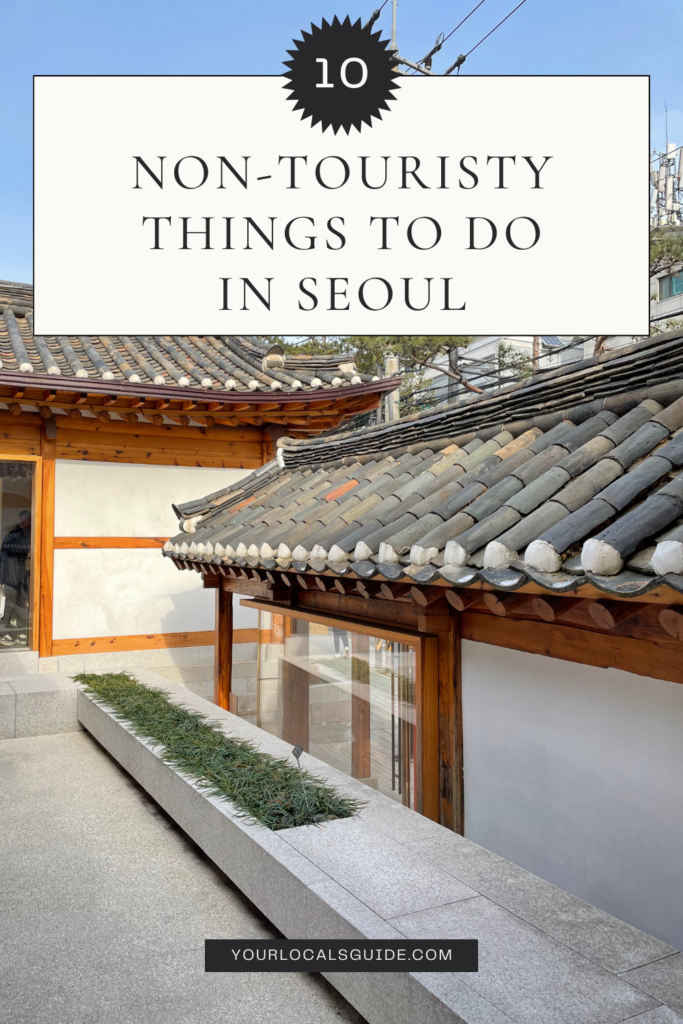
For More: Check out the 5 Best Seoul Neighborhoods list with things to do here!
Best Non-Touristy Things To Do in Seoul
1. check out hip boutiques and restaurants in hannam.
Hannam, especially around Hangangjin, is a low-key, hip neighborhood with a ton of trendy boutique and flagship stores of locally loved Korean and global brands. It’s also home to classy restaurants and unique cafes.
CHECK OUT the 3-story RECTO flagship store in Hannam to get a taste of high-end homegrown Korean fashion.
GETTING THERE Take the subway to Hangangjin Station.
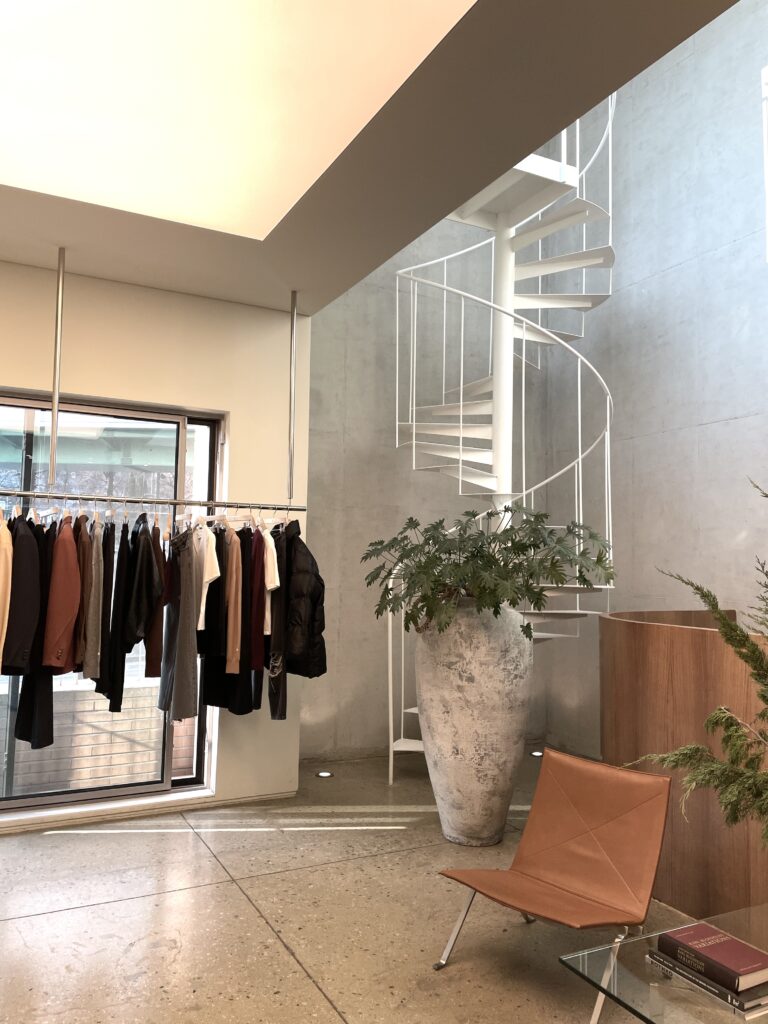
2. Go gallery hopping in Samcheong-dong
Samcheong-dong is known to locals to have some of the best art galleries and museums, in addition to being a hip neighborhood where modern meets Korean traditional hanok houses.
CHECK OUT Kukje Gallery, Gallery Hyundai and the MMCA (National Museum of Modern and Contemporary Art).
GETTING THERE These galleries are accessible from Anguk Station.
View this post on Instagram A post shared by KUKJE GALLERY (@kukjegallery)
3. Explore the Brooklyn of Seoul, Seongsu-dong
Seongsu-dong was historically known for its shoemaking and cobbler businesses, some of which still exist today alongside trendy cafes, galleries and boutiques. Among the many locally popular neighborhoods, Seongsu-dong is still one of the more underrated hip places to hang out.
CHECK OUT Tongue Planet, an eclectic, colorful cafe with a small exhibition at the entrance.
GETTING THERE Take the subway to Seongsu Station.
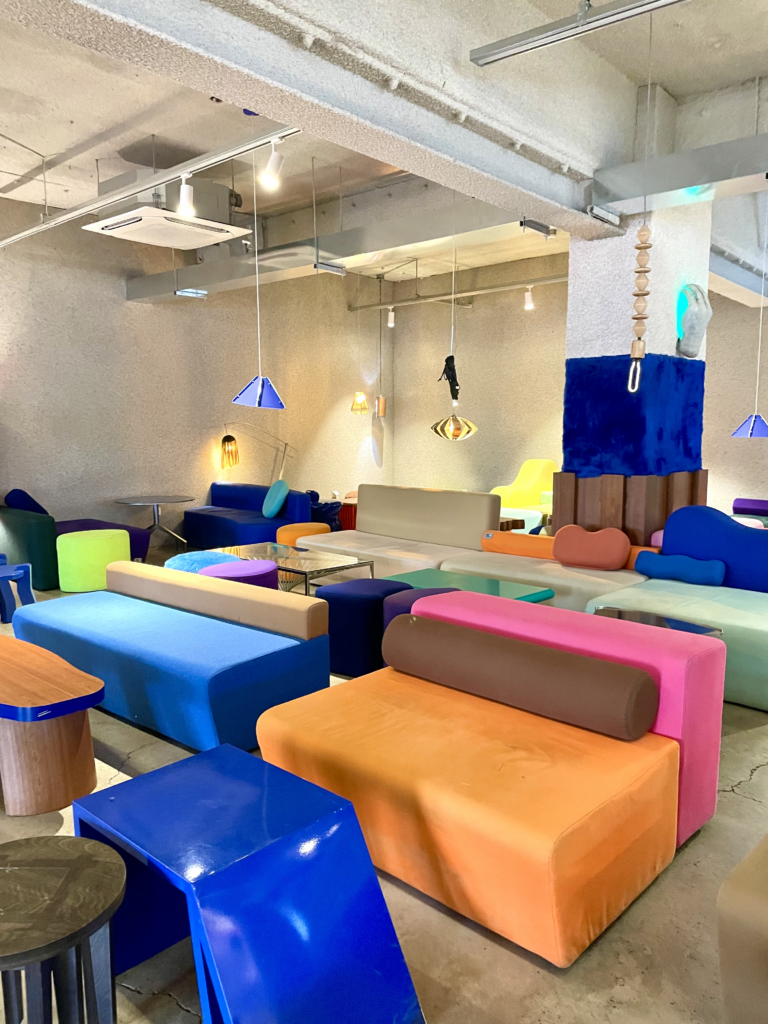
4. Bike along the Han River and grab instant Korean ramen
The Han River is the main river dividing Seoul into Gangnam (north of the river) and Gangbuk (south of the river) and have excellent, well-kept biking and walking pathways. I fondly look back to biking along the river with my family as a kid on the two-person tandem bikes we rented! After your bike ride, end the day like a local by buying instant Korean ramen (I recommend the classic Shin Ramen) and beer at the convenience store and enjoying your meal by the river. The views are especially lovely in the evenings.
CHECK OUT Go to Ichon Hangang Riverside Park for the bike rentals (이촌한강공원자전거대여소) and the CU convenience store (CU 한강르네상스이촌점).
GETTING THERE The park is a 20 minute walk from Ichon Station.
View this post on Instagram A post shared by @vitamin_sso_
5. Hike along Bukhansan Dullegil
Bukhansan is the mountain that forms the northern perimeter of Seoul. An alternative to doing the full hike is trekking along sections of the Bukhansan Dullegil (“round trail”), which divides the 71.5 km (44.4 mi) trail into 21 sections.
CHECK OUT For an easy trek, check out Sections 9-11. For medium intensity, check out sections 19-21.
View this post on Instagram A post shared by 북한산국립공원 (@bukhansan_v)
6. Go back in time at Eunpyeong Hanok Village
Section 9 of Bukhansan Dullegil is actually part of Eunpyeong Hanok Village! This hanok village is a beautiful oasis away from the center of the city. The views at this hanok village, among the several in Seoul, are especially beautiful because you have Bukhansan as the panoramic backdrop. While the hanok villages surrounding Gyeongbokgung Palace are visibly enmeshed with the busy modernity of the city, the structures in Eunpyeong are much more homogenously hanok style.
CHECK OUT 1 In 1 Jan (1인1잔) cafe for top-down views onto the hanok village. The wave of hanok roofs are striking!
GETTING THERE Get off at Yeonsinnae Station and take the 7211 or 701 bus to Hanago, Jingwansa, Samcheonsa Entrance. Alternatively, get off at Gupabal Station and take the 7723 bus to the Hanago, Samcheongsa, Jingwansa Temple Entrance.
View this post on Instagram A post shared by 1인1잔 | 1인1상 (@1in_official)
7. Eat at long-standing Korean restaurants at Yeouido
Yeouido has many long-standing, well-loved Korean restaurants that have been frequented by businesspeople over the years as the neighborhood is Seoul’s finance and investment banking hub. While Yeouido is more frequently known for the brand new department store, The Hyundai Seoul, it is also a neighborhood where you can find amazing local restaurants.
CHECK OUT Head to Yeouido Department Store, an underground food market, and try the delicious soybean noodles at Jinju House!
GETTING THERE Take Line 5 to Yeouido Station and take Exit 5.
View this post on Instagram A post shared by CHIAKI|韓国に行きたい欲を掻き立てるアカウント🇰🇷|韓国ひとり旅|韓国地方旅|韓国系ライター (@camyu.kr)
8. Sing your heart out at a Noraebang
If you haven’t gotten the hint yet from K-Pop…. You guessed it, Koreans love singing! Like many Koreans, I grew up frequenting Korean noraebangs (karaoke rooms) singing my heart out. Singing is half the fun; order food and drinks in true Korean fashion while you’re at it!
CHECK OUT Su Noraebang Hongdae Main Store (수노래연습장 홍대 본점) is a whole multistory complex of noraebangs. Su is a long-standing noraebang where you can reliably get a pleasant experience in a nice private room all at an affordable price!
GETTING THERE Get off Hongdae Station and take Exit 9.
9. Eat authentic Korean fried chicken with beer
While Korean fried chicken shops are opening up in the US and abroad, it’s not the same as the real fried chicken that have become a staple in Korean households. Koreans love having their chicken with beer, so much so that they’ve coined the term “chimaek” to refer to that combo.
CHECK OUT If you’re looking for a more chill night in, I would recommend buying or ordering fried chicken from your nearest BBQ Chicken (BBQ치킨) franchise location.
10. Shop at the Classy Shinsegae Department Store in Gangnam
Korean style has become more known around the globe; in my opinion, Koreans dress pretty well and it’s apparent in the intense shopping culture. Experience the height of Korean consumerism at the classy Shinsegae Department Store in Gangnam. Across the different department stores and malls in Seoul, it’s the best one. You’ll find major Korean brands, along with global luxury brands under the same roof.
DON’T MISS Don’t forget, you can ask for tax-free receipts upon purchasing goods, and then claim your refund at the airport!
View this post on Instagram A post shared by 신세계백화점 공식계정 (@only_shinsegae)
10 Best Non-Touristy Things To Do in Seoul (Summary)
- Check out hip boutiques and restaurants in Hannam
- Go gallery hopping in Samcheong-dong
- Explore the Brooklyn of Seoul, Seongsu-dong
- Bike along the Han River and grab instant noodles
- Hike along Bukhansan Dullegil
- Go back in time at Eunpyeong Hanok Village
- Eat at long-standing Korean restaurants at Yeouido
- Sing your heart out at a noraebang
- Eat authentic Korean fried chicken with beer
- Shop at the Classy Shinsegae Department Store in Gangnam
This post was all about the 10 Best Non-Touristy Things To Do in Seoul !
About Rhaime Kim
My name is pronounced "rhyme" and I love (planned) wandering. Korea, the US and Hong Kong are all home to me :)
you’ll also love
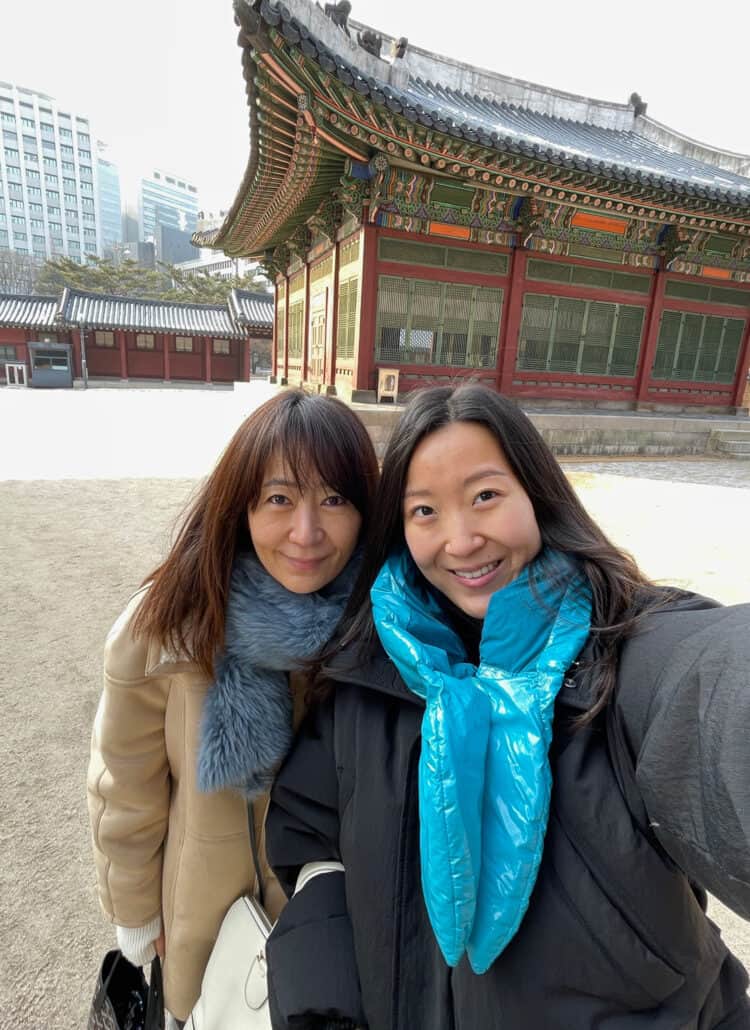
join the list
Stay up to date & receive the latest posts in your inbox.
Reader Interactions
[…] Planning a Seoul trip? Check out the 10 Best Non-Touristy Things To Do in Seoul! […]
[…] Looking for more things to do? Check out the 10 Best Non-Touristy Things To Do in Seoul! […]
[…] Looking for interesting things to do in South Korea? Check out my tips on the 10 Best Non-Touristy Things To Do in Seoul! […]
[…] Looking for more local hidden gems? Check out the 10 Best Non-Touristy Things To do in Seoul! […]
[…] Looking for more interesting things to do? Check out the 10 Best Non-Touristy Things To Do in Seoul! […]
Leave a Reply Cancel reply
Your email address will not be published. Required fields are marked *
Save my name, email, and website in this browser for the next time I comment.

20 Best Coffee Shops in Seoul (From a Korean in 2024!)
On the blog.
- New York City
- South Korea
- Privacy Policy
- Terms and Conditions
stay in the know
Copyright © 2024 · Theme by 17th Avenue
🙌 Awesome, you're subscribed!
Thanks for subscribing! Look out for your first newsletter in your inbox soon!
Get us in your inbox
Sign up to our newsletter for the latest and greatest from your city and beyond
By entering your email address you agree to our Terms of Use and Privacy Policy and consent to receive emails from Time Out about news, events, offers and partner promotions.
Awesome, you're subscribed!
The best of Singapore for free.
Sign up for our email to enjoy Singapore without spending a thing (as well as some options when you’re feeling flush).
Déjà vu! We already have this email. Try another?
Love the mag?
Our newsletter hand-delivers the best bits to your inbox. Sign up to unlock our digital magazines and also receive the latest news, events, offers and partner promotions.
- Things to Do
- Food & Drink
- Shopping & Style
- Weekend Getaways
- Coca-Cola Foodmarks
- Music & Nightlife
- Restaurants & Cafes
- Los Angeles

The best things to do in Seoul that aren’t tourist traps
From abandoned theme parks to overnight temple stays

Based on the number of K-dramas binged and Korean BBQs we’ve devoured recently, many of us consider Seoul as a prime destination. It’s easy to understand why – the food, shopping, and culture are all massive draws. But besides typical tourist attractions like shopping in Myeongdong and visiting Gyeongbokgung Palace, there are certain spots that are popular for good reason. From an abandoned theme park to the world’s largest shipping container mall, these are the top seven things to do in Seoul for your next visit.
RECOMMENDED: How to experience South Korea in Singapore and how to save money when booking a trip during the pandemic
Been there, done that? Think again, my friend.
Fun things to do in Seoul
Explore the brooklyn of seoul.

Seongsu-dong, an old town that was once a hidden gem in Seoul, is now widely known and has transformed into a trendy destination, earning the moniker of the "Brooklyn of Seoul." What makes it deserving of this title? Firstly, it boasts the same charming brick walls that contribute to its aesthetic appeal, reminiscent of Brooklyn. Furthermore, visitors can find a wide range of independent labels that are exclusive to Seoul, boutique shops, renowned Seoul fashion brands, and a multitude of cafes with stunning interiors.
DON’T MISS Make sure to visit the ADER ERROR store, a South Korean fashion label that pushes the boundaries of the retail experience, guaranteed to leave you in awe. And if you're feeling hungry, don't forget to indulge in a delicious meal at the Grandpa Factory Cafe, where you can immerse yourself in its expansive interiors and delicious food offerings.
Getting there It’s only a 5 minutes walk from Seongsu station.
Snap whimsical photos at an abandoned theme park

As thrilling as theme parks are, there's a certain charm to abandoned ones too. While Yongma Land first opened in the 80s, they’ve since been closed for at least a decade – but the whimsical carousels and old-school roller coasters are still around. It’s now more of a photo spot, rather than a theme park for adrenaline seekers. You’ll need to fork out 10,000 won (~$10.70) for entry, but it’s well-worth it for a stroll around these dilapidated amusement park grounds.
DON’T MISS Head over to the carousel once the sun goes down – you’ll see colourful horses, despite needing a new coat of paint, bobbing up and down. While online sources claim that the owner will turn it on during dusk, you might still need to prepare a small fee.
GETTING THERE It’s just a 10-minute walk from Mangu Station, otherwise, you can simply get a taxi.
Try fresh sashimi and live octopus at Noryangjin Fish Market

Tokyo might have Toyosu Fish Market, but Seoul has Noryangjin Fish Market. While a fresh fish market, Noryangjin is housed in a relatively new building – it’s practically a full-fledged multi-level supermarket that has different sections for fresh seafood, live fish, shellfish, and frozen seafood. While the vendors here will want to get the best price for their seafood, they are unlikely to fleece tourists and will roughly stick to fair market pricing.
DON’T MISS It’s unlikely that you’ll be stocking up on a sprawl of live seafood to bring home, so head on up to the second floor – it’s where all the restaurants are. Here, you can try grilled oysters, fresh sashimi, and even live octopus.
GETTING THERE Take the subway to Noryangjin Station (Lines 1 and 9), and follow the signs.
Enjoy a picture-perfect picnic at Seoul Dream Forest

Despite being an urban cityscape, there are hidden pockets of greenery all around South Korea – Seoul Dream Forest is certainly one of them. While not one of the three largest parks in Seoul – that’ll be Seoul Forest, the Olympic Park, and the World Cup Park – Seoul Dream Forest is worth a visit for its scenic landscapes. There’ll be cherry blossoms during spring, and vibrantly red maple trees in autumn. While there are some hidden picnic spots in Singapore , Seoul Dream Forest is where you should be pulling up a checkered rug and some takeaway kimbap rolls.
DON’T MISS The deer enclosure, where you can hand feed 20 or so deer – they’re all friendly and will come right up to you.
GETTING THERE The Seoul Dream Forest spans six different districts, including Gangbuk-gu and Seongbuk-gu. Because of that, you can easily take the subway down to various stations – this includes Wolgye, Mia, Dolgoji, and Hagye Stations.
Cycle through the scenic grounds of Gangchon Rail Park

Those feeling a little outdoorsy during their Seoul holiday will enjoy cycling through the scenic grounds of Gangchon Rail Park. Now, this isn’t your ordinary bike trail so you wouldn’t need to worry if it’s been a while since your last cycling tour – it’s all done on a rail bike that’s fixed to old train tracks. These tracks bring you through a variety of scenic landscapes: stunning mountainscapes and panoramic Bukhan River views. You can choose between a two-seater rail bike (30,000 won, ~$32) or a four-seater rail bike (40,000 won, ~$43).
DON’T MISS Once you’ve completed the railway trail, you would’ve worked up an appetite, so make sure to stop by one of the many chicken restaurants to try the dak galbi (spicy stir-fried chicken).
GETTING THERE It’s about an hour or two by train from Seoul, making it a fuss-free day trip. Simply take the subway or the ITX fast train, and once you reach Gimyujeong Station, the Rail Park is just an easy five-minute walk.
Stay overnight at a 14th century temple in Insadong

Staying overnight at a temple makes for an interesting bucket list entry, to say the least. If you’re looking for a peaceful retreat away from the hustle and bustle of Seoul, Jogyesa Temple provides just that in downtown Seoul. You can choose to stay up to three nights – it’s 50,000 won ($~54) per night, including simple vegetarian meals. There’ll also be lotus flower workshops and Buddhist chanting ceremonies to take part in.
DON’T MISS One of the dawn chanting sessions. It starts before sunrise around 4am, but even if you’re not an early riser, it’s said to entirely recharge you.
GETTING THERE It’s in the middle of Seoul city, within the Insadong district. Take the subway to Anguk Station or a sightseeing bus to Insadong.
Shop at the world's largest shipping container mall

While Common Ground is now known as the world’s largest shipping container mall, made up of more than 200 containers that are stacked upon each other, it first started out as a humble pop-up space. Today, the crowd is mostly made up of university students and the occasional tourist who’s bothered to venture off the beaten path. There’s the occasional flea market and live performance. If you get peckish, there are also food trucks at the central square.
DON’T MISS The Index bookstore on the rooftop. It’s a cafe too, so you can stop by for a coffee break.
GETTING THERE Take the subway to Konkuk Station and leave via Exit 6.
Soak in stunning autumn landscapes at Haneul Park

There’s no park like Haneul Park, known for its sweeping landscapes and lush greenery. It’s the most popular of all five parks of World Cup Park – which was once Seoul’s main landfill waste area. Go during autumn since that’s when the vast fields of pampas grass will be in full bloom. There are even certain areas where you can wander through pink muhly grass, known for its feathery pink flowers.
DON’T MISS Pay a visit to the pumpkins and gourds, a leafy arched space that comes to life during the months of August to September. Vines are draped all around the arch, so pumpkins will be dangling from the roof.
GETTING THERE Take the subway to World Cup Stadium Station and leave through Exit 1.
Travelling overseas
5 useful travel tips for the holidays.

How to save money when booking a trip during the pandemic

The best travel destinations less than five hours away from Singapore

The best alternative destinations to travel to from Singapore

[image] [title]
Discover Time Out original video
An email you'll actually love
- Press office
- Investor relations
- Work for Time Out
- Editorial guidelines
- Privacy notice
- Do not sell my information
- Cookie policy
- Accessibility statement
- Terms of use
- Modern slavery statement
- Manage cookies
- Sign up to newsletter
- Advertising
- Express Advertising
- Time Out Market
Time Out products
- Time Out Worldwide
Time Out magazine
- Print edition
- Digital edition

10 Alternative & Unique Things To Do In Seoul, Korea
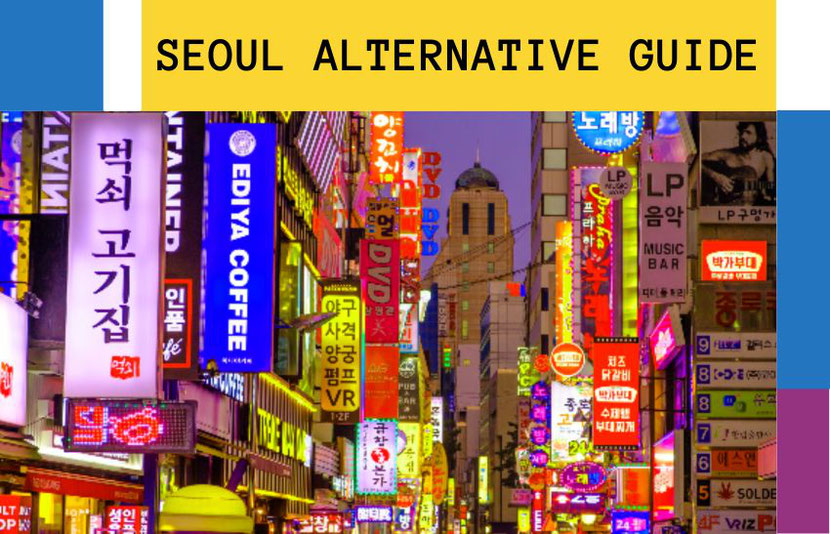
Tired of seeing crowded tourist sites and yet another palace or tower when you travel to Seoul? Then you’ll love these 10 alternative and unique things to do in Seoul. Breathe life into your travel itinerary with these unusual activities, attractions, and locations and cool places in Seoul.
From abandoned theme parks and oil tanks, to ghostly tours, drinking from toilets (hear me out), and a spiritual journey overnight in a temple, there’s so much more to Seoul than the well-trodden must-see spots. If you’re looking to escape the masses, create some unforgettable memories, and find unique photo opportunities, then read on and start exploring Seoul hidden gems.
1: Explore The Abandoned Yongma Land Theme Park
Yongma Land, an abandoned theme park built in the 80s that closed its gates in 2011, offers the chance to explore a theme park without the usual queues and tickets.
For 10,000 KRW (about $9 USD), you can enter and explore the theme park at your leisure. Do you want to discover hidden places in Seoul? Peek into the ticket booths, sit inside the rollercoaster cars, and take pictures of this post-apocalyptic looking attraction. With fading signs, rusty doorways, and overgrown nature, this is the perfect place for a grungy photoshoot or cosplay, and it should definitely be on your list of Unusual things to do in Seoul.
Many K-Pop videos have been shot here, too. If you’re willing to pay a bit extra (30,000 KRW), you can even get the owner to turn on the lights at night and take a ghostly merry-go-round ride. Watch out though, the place may be haunted. Not for the faint of heart. Snacks and balloons are available to complete the theme park experience.
Yongma Land Theme Park Address:
- 118 Mangu-ro 70-gil, Jungnang-gu, Seoul
2: Get Locked Up At Seodaemun Prison History Hall
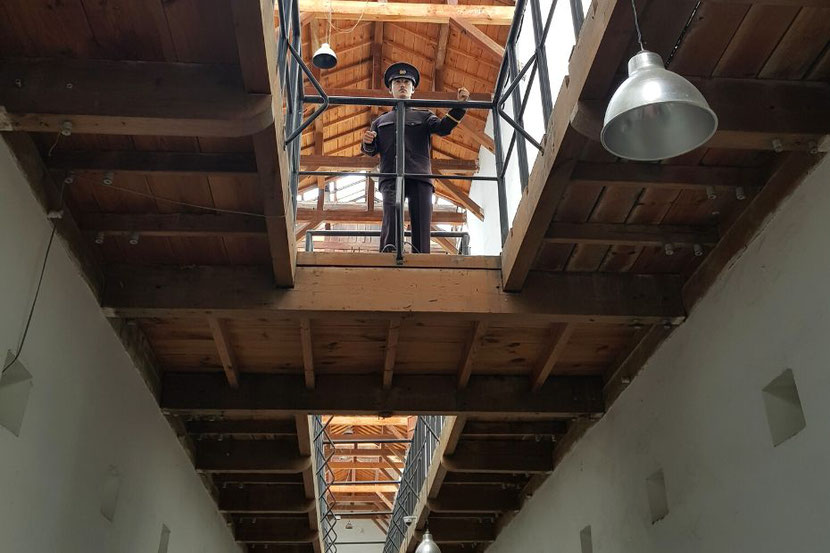
Seodaemun Prison is a poignant reminder of the cruelty of governments against people. Created during the Japanese occupation, freedom fighters were tortured repeatedly (and then executed) in the dark and cramped buildings.
After Korean independence in 1945, the prison kept its purpose and was used to break revolutionaries rebelling against the Korean dictatorship that lasted until the 1980s.
Now, it’s open to the public with graphic displays of the torture methods used, as well as some hands-on experiences like getting locked up in a cell and being confined to a coffin-sized standing box. Experience the hardships that thousands suffered in the name of freedom and see the sights of some of Korea’s worst atrocities. These days the Seodaemun History Hall is an off the beaten path Seoul destination and also popular K-Drama filming site , (including Goblin and Doctor John).
Seodaemun Prison History HallAddress:
- 251 Tongil-ro, Seodaemun-gu, Seoul
3: Drink In Industrial Mullae-Dong’s Craft Breweries
Mullae-Dong was once Seoul’s dirty industrial heartland, full of mills, factories and workshops squashed in together between narrow streets and low rooftops.
Nowadays, Mullae-Dong has turned its creative energies away from industry and found a new home as an innovative mish-mash of artists, craft brewers, and designers. What makes this place so interesting to explore is the blend between art and industry that still exists. Indeed, some of the factories and workshops are still running in between the newer bars, cafes, art residences, and restaurants.
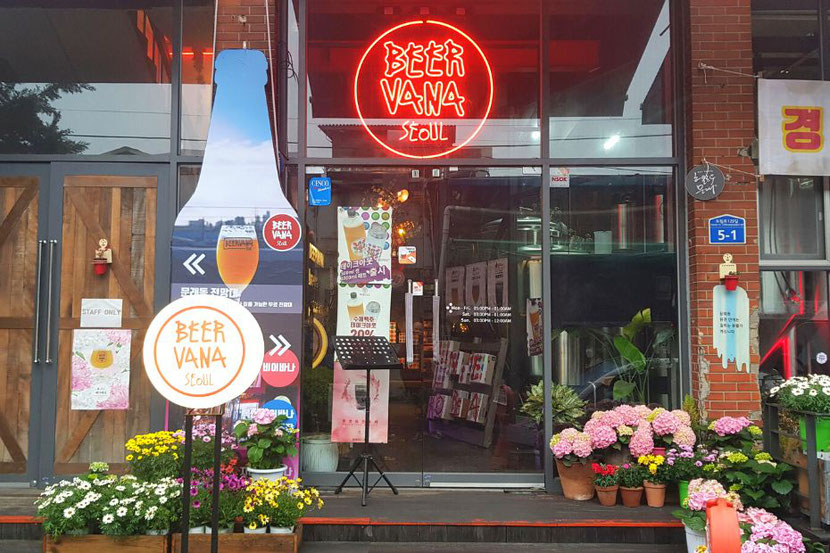
Part of this area is now the Mullae Art Village, where you can see artists at work and their various outputs on display, including wall murals, sculptures, and statues. The best way to enjoy all this off the beaten path Seoul is to visit one of the craft breweries in the area, sit with a beer and look out from the rooftop at the busy streets below.
Beervana Micro Brewery is one of the best in this area and has won several awards for its craft beers. If you want to explore off the beaten path Seoul, add Beervana Micro Brewery and the Mullae Art Village to your Seoul itinerary .
Beervana Address:
- 5-1 Dorim-ro 129-gil, Mullae-dong, Yeongdeungpo-gu, Seoul
4: Dress Up In A Korean School Uniform

Whilst most tourists in South Korea yearn to dress up in traditional Korean handbook , there’s another traditional costume that you can rent that makes for some interesting pictures – Korean school uniforms.
Dressing up in Korean school uniforms is one of the most unique things to do in Seoul.
Fans of K-Pop will no doubt recognize the uniforms as they have been worn by many of their idols, including BTS and TWICE.
You can rent both traditional and modern Korean school uniforms when you visit Seoul and recreate your favorite scenes in iconic locations such as Ihwa Mural Village, Hongdae, and Gangnam.
For traditional school uniforms, Ihwa Mural Village offers the perfect background for a photoshoot as the winding hillside lanes are decorated with brightly-colored murals and, at the top of the hill, there are rooftop cafes and bars that look out over Seoul.
- 49 Naksan 4-gil, Jongno-gu, Seoul
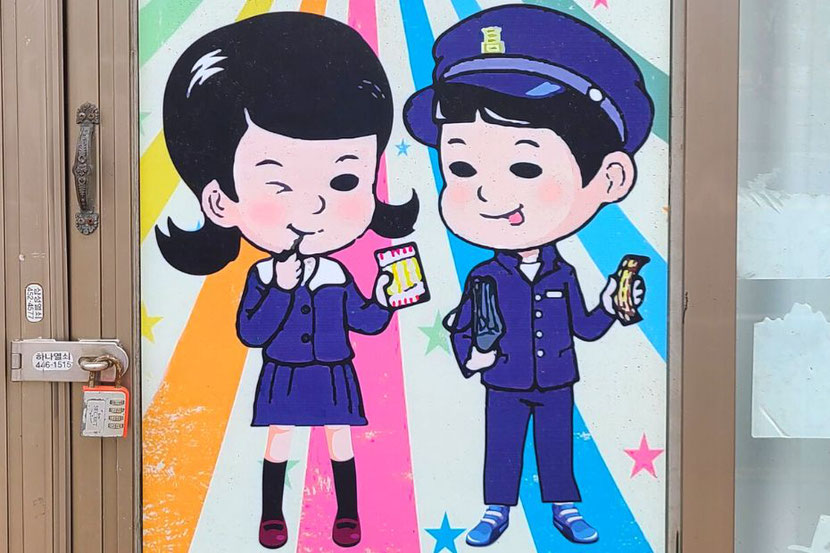
5: Take A Ghost Tour Around Seoul
Another spooky alternative activity in Seoul is a ghost tour where you can explore many hidden places in Seoul. Hosted by the Dark Side of Seoul, the English-language Seoul Ghost Walking Tour takes you around Seoul’s most haunted streets and ghostly hotspots. Learn about infamous local urban legends, royal secrets and massacres, Korean serial killers, and those who haven’t yet passed on to the other side yet and still linger, waiting to scare those foolish enough to find them.
A fascinating opportunity to learn and see more about Seoul’s darker side and share an unforgettable experience with other brave souls, as well as discover unknown parts of Seoul you might never normally visit.
6: Join A 3am Fish Auction & Get A Fresh Breakfast
If you’ve ever felt the urge to wake up incredibly early and see fresh fish flopping around on tarp sheets, or octopuses and crabs trying to crawl out of glass tanks, then you should visit Noryangjin Fish Market, one of the most unique places in Seoul.
Located in a giant warehouse, the fish market is just that – a place where Seoul’s restaurants come to buy the best fresh fish for the day ahead.
The auctions for the best catches start at 3am each day and visitors are allowed to watch the display and even join in if you want some seafood for yourself. If you’re feeling hungry, you can pick up some cheap crabs, squid, shrimps, or many other wriggly sea creatures and (for a small fee) the kitchens in the fish market will make them into a freshly cooked meal for you.
Be warned, this is a messy place and you should expect to get splashed a bit. Bring boots to stop your toes getting covered in fishy seawater.
Noryangjin Fish Market Address:
- 674 Nodeul-ro, Dongjak-gu, 서울특별시
7: Experience Life In A Korean Buddhist Temple
A trip to a Korean Buddhist temple is a great alternative activity in Seoul, offering you the chance to see colorful temple architecture, marvel at golden Buddha statues, and smell the delightful incense that’s burnt in many rituals.
Unfortunately, that’s all most visitors to Seoul experience, and they miss out on the chance to see and learn more about the Korean Buddhist monks and their daily lives. Looking for unique things to do in Seoul? Try Templestay and find your true-self.

The Korean Temple Stay program is the perfect way to do this, showing you life inside the temple through tea ceremonies with Buddhist monks, workshops, prayer meetings, and even overnight stays in certain temples. Sleep on traditional futons, enjoy a vegan-friendly Buddhist breakfast, and take part in ceremonies inside the temple that regular visitors never get to see.
Exploring a big city can be spiritually draining, with lots of busy streets, shops, and other tourists, so why not experience Seoul off the beaten path and escape from the hustle and bustle and reconnect with your spiritual side for a day or two?
Temple Stay Program Website:
https://eng.templestay.com/
8: Drink A Latte From A Toilet Bowl
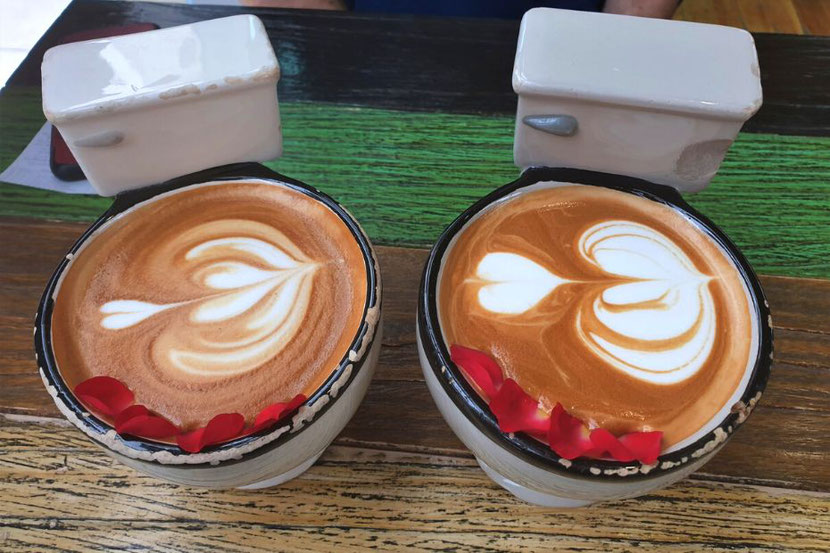
Perhaps one of the most disgusting-sounding cool things to do in Seoul is to take a trip to the Ddong Café in the Ssamziegil Art Mall.
The Poop Café, as it’s known in English, is definitely not for those who are squeamish at the sight of poop, even though the poop-themed decorations are actually quite cute. You can borrow poop-hats and look at the colorful poop-pictures on display (great for weird photos).
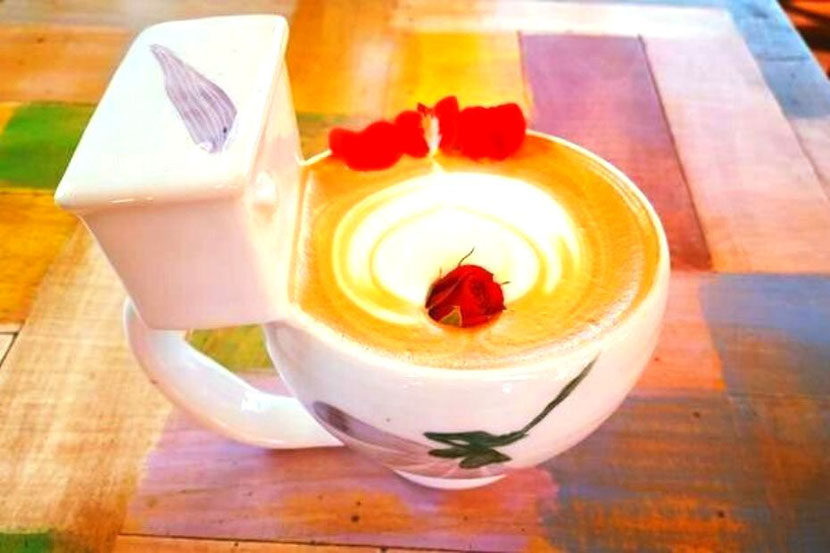
Ddong Café is a star of cool places in Seoul. The best part of this quirky café is the menu.
You can order pretty rose-lattes that come in a toilet-shaped cup, as well as not-so-appealing looking brown curries served in an old-style squat toilet bowl. They sometimes sell poop-bread as well with, you guessed it, chocolate sauce inside.
Ddong Café in the Ssamziegil Art Mall Address:
- 44 Insadong-gil, Jongno-gu, Seoul
9: See Inside Seoul’s Oil Tanks

Once a storage facility for Seoul’s emergency oil supplies, the Oil Tank Culture Park is now a curious collection of different attractions housed inside now-empty metal cylinders. The Oil Tank Culture Park is one of the underrated places in Seoul, but it is worth a visit.
As part of an effort to reclaim abandoned parts of Seoul’s industrial past for nature and culture, these oil tanks have been turned into galleries, performance halls, museums, cafes, and even a gigantic contemplation room. In amongst the rusty round rooms are silvery reeds and newly planted flowers that bring life and color to the area.
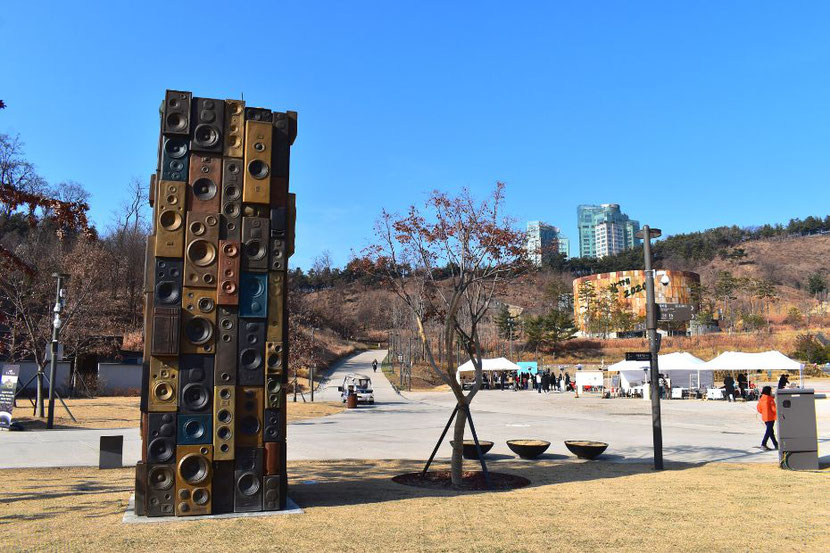
Architecture fans will love the industrial feel to the place, with impressive angles, volumes, shadows and curves that make it a great place for sketching or thinking. If you want to explore alternative Seoul, don't miss the Oil Tank Culture Park.
Seoul Oil Tank Culture Park Address:
- 87 Jeungsan-ro, Mapo-gu, Seoul
10: Buy Unusual Souvenirs From Seoul Folk Flea Market
You never know what hidden treasures await you at the Seoul Folk Flea Market. This sprawling traditional flea market, one of the hidden gems in Seoul, contains various sectors spread over several floors, including clothes, electronics, antiques, and household goods.
When you wander around, you can see Seoul’s history on display, from 1988 Olympic memorabilia, to artifacts from the Japanese occupation and beyond.
Find out what Samsung products looked like before they became the global powerhouse they are now (they used to be known as Sam-suck for their poor quality).

As for cool places to visit in Seoul, the Seoul Folk Flea Market is absolutely worth a visit. Not only can you find lots of traditional goods, such as Korean hanbok, you can also try lots of delicious Korean dishes in the market’s food courts. If you’re looking for an unusual souvenir from Seoul, this is definitely the place to visit.
Seoul Folk Flea Market Address:
- 21 Cheonho-daero 4-gil, Sinseol-dong, Dongdaemun-gu, Seoul
About The Author

Joel is an expat who has lived and worked in South Korea since 2015.
He shares his passion for Korean food, travel, culture, and lifestyle through the Best of Korea .
You can find out more about Korea on this site, including how to travel around, what to see, the latest travel restrictions, and insights into life in Korea and Korean culture.
Images by Joel Marrinan
Cover photo: image by Yu Kato https://unsplash.com/@yukato
- Scroll to top
- Art & Design Resources
- Disclosure Policy
- Work With Me
Passport by Design
A Travel Blog for Design Lovers
Non-tourist Things to Do in Seoul

Are you a non-tourist traveler? Maybe you’ve visited Seoul, South Korea before. Maybe you haven’t. But you want to go to the places tourists don’t go. You want to experience Seoul, South Korea like a local. Then head with me over to Wolgok and the Korea University area. Let’s live like locals.

I chose this area because I wanted to visit a place in Seoul I had never seen. How do regular people spend their day? What would a non-tourist do?

Convenience Stores
The local GS 25s (convenience store like 7-eleven) knew me on a first name basis. Well not really. I was in a convenience store nearly every day, though. Staying in an Airbnb meant access to a full kitchen. But who likes to cook when you’re traveling. So that led to me buying lots of my meals at the local GS 25.

Think rice and chicken wrapped in seaweed (above). I loved their abalone (a type of sea creature) porridge (below) as well. You couldn’t beat the prices. Many snack food items were around $1 USD. But the food never tasted like it. The variety of ice creams and popsicles was amazing as well. I loved this watermelon pop (above).

Non-tourist Transportation
The bus and subway took me where I needed to go. Most of the buses I rode in Seoul announced stops in English as well. Subway signs were also all in English.
Use a T-Money transportation card. Then you can pay for all your transportation with one card. Refill the card at stations and most convenience stores. Also use them to buy items at those convenience stores.

Do you see that complicated subway map below? It’s perfect for an non-tourists. Locals learn how to use it. So can you.

What Non-tourism is All About
Walking down random streets and alleyways was my pastime of choice. I loved chatting with locals in my very limited Korean. That’s what travel means to me. Below is the Wolgok area in Seoul.

Share experiences and learn how people live in other parts of the world. It’s not how the media makes you think they live, but how they actually spend their day.

It’s the little quirky only-in-Korea things that keep bringing me back to Seoul. You won’t see a rotisserie chicken truck in the middle of the street in New York City.

And where else can you find a HomePlus . It’s basically a 5 story-target. I don’t think America is ready for something like that.

Let’s all be non-tourists and try to see the story behind the city. Don’t just visit the tourist areas. Don’t take a photo a million people have taken before. Take the pictures of what no one ever sees.

I love your travel spirit! Thanks for sharing it and re-invigorating mine.
Leave a Reply Cancel
You might also like, visit the many fall art festivals in connecticut, 5 ways to beat the heat with indoor activities in connecticut.
At Passport by Design, a travel blog with creatives in mind. Based in Connecticut, U.S.A. Authored by Kelcy Jenkins.
P.O. Box 2474, Milford, CT 06460 [email protected]
Popular Posts
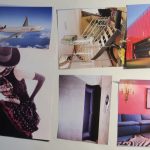
How to Be More Creative At Home

DIY: Crochet Sunglasses Case for Beginners
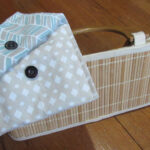
DIY: Multi Purpose Pouch with Magnetic Closure
Recent posts.

How to Book a Long Layover to Travel to a Bonus Country

How to Add Agricultural Tourism to Your Next Trip
- South Korea
100 Fun & Unusual Things to Do in Seoul, South Korea

- 12 Pinterest
With an incredible population of over 9 million people, Seoul, South Korea is known worldwide as a giant metropolis, celebrated for its rich history dating back as early as 18 BC, but most widely understood from its Joseon Dynasty beginnings in 1392.
Today, Seoul is home to 4 UNESCO World Heritage Sites, state-of-the-art ecological parks and buildings, and a globally recognized performance theater presence.
Not to mention home to some of the most delicious street foods to savor, a stylish avant-garde fashion scene, and most recently, the rise of K-Pop fandom reaching global status.
We’ve got an inspiring and informative list ahead, so If you’re planning a trip to Seoul, let’s dive straight into the most fun and unusual things to do in Seoul , South Korea.
Want to dive straight in? Browse our catalog now!
- Seoul tours
1 – Enter the impressive Gyeongbokgung Palace

Built in 1395, the Gyeongbokgung Palace (palace greatly blessed by Heaven) was the residence of the Joseon dynasty, which ruled from 1392 -1897.
The palace also known as Gyeongbokgung Palace or Gyeongbok Palace was abandoned some 300 years after the devastation hit by the Japanese invasion of 1592, the Korean War, and multiple other natural disasters.
After continuous renovations, the palace is open today for visitors to admire and learn from. Enjoy walking around the palace grounds, entering the National Folk Museum of Korea, and the National Palace Museum of Korea.
Walk through the Gwanghwamun Gate, the main entrance of the palace built in 1395, signifying defense against invaders. Check out the changing of the guards every day at 11 am or 1 pm.
Consider booking a bus tour , oftentimes including a stop at the famed Bukchon Hanok Village , a 600-year-old village nearby.
- Gyeongbokgung Palace tours
2 – Go to the top of the N Seoul Tower

Adorning the cityscape of Seoul’s modern city is the N Seoul Tower, reaching an incredible height of 236 meters tall. The height combined with striking modern features marks the N Seoul Tower the second highest point in the city, located in the heart of Seoul.
Additionally recognized as Namsan Tower or Seoul Tower, the N Seoul Tower is known for its entertainment, shopping, communications, and observation tower, which is a must-see for sweeping views of the city and nature, with the admission of 16,000 won.
Just a 5-minute walk away from the tower is Namsan Mountain Park, a picture-perfect park with walking trails and hills to climb up and catch another admirable viewpoint of the city.
Check out Namsan Cable Cars, offering an impeccable bird’s eye view of the city on a 15-minute cable car ride.
- N Seoul Tower tickets
3 – Unlock tremendous history at the National Museum of Korea

Dive deep into Korean history at the National Museum of Korea, walking visitors through the different eras of the country, starting with the fascinating ancient history.
The museum has various permanent exhibits as well as special exhibits to wander through. Check out the Room of Contemplation, housing 2 pensive bodhisattva statues dating between the 6th-7th centuries, inviting visitors to ponder life’s bigger questions in the section of the permanent exhibition.
In the temporary exhibition center, check out an updated calendar with upcoming international exhibits, such as the Aztecs, Mesopotamia, or the Astana Tombs. Step into the massive Korean calligraphy and Buddhist painting gallery.
Known as the largest museum in Korea, collecting an estimated 320,000 artifacts, dispersed over 3 floors, the museum is free entry with the exception of special exhibits and is open between 10 am – 6 pm every day, except Wednesdays and Saturdays when it’s open until 9 pm.
- National Museum of Korea tickets
4 – Discover the number of activities to do inside Dongdaemun Design Plaza

Built to host some of the city’s most emblematic events and housing a myriad of exhibitions and then some, is the stunning Dongdaemun Design Plaza (DDP), which opened its doors in 2014 to the public.
The DDP is known for its remarkably futuristic appearance, drawing crowds of locals and tourists for its markets, incredible shopping, cultural and international events, galleries and exhibitions, museums, and more.
Appreciate the building’s rounded-out curves, modern gray, concrete aspect, aesthetic lighting, and welcoming aura, located in Seoul’s historic district of Jung-gu. DDP is divided into approximately 7 sections, each housing a different purpose, and open for certain events.
The DDP is open all year round and is free to enter and admire, however, if there is a specific activity you’d like to participate in, a fee may be added. Interpretation services for English speakers are available.
5 – Plan a day trip to the naturally abundant Nami Island

Check out a day trip to the river island called Nami Island, located approximately 1.5 hours from downtown Seoul.
Nami Island lures its visitors with its quaint and very picturesque natural sites, from shady tree-lined trails to sparkling calm rivers, that seem to dress the island in a variety of colors no matter which season.
Situated 20 minutes away is Petite France , a stunning French-inspired park adorned with pastel-colored houses near a mountain and mirror-like lake.
Check out one of the most beautiful gardens in Korea, Garden of Morning Calm , known for its plush and colorful display of plants of all sorts, perfectly manicured flowerbeds, peaceful walking trails, and heavenly rivers.
Gangchon Rail Bike is known for its old train tracks turned bike trail, where visitors rent a rail bike and pedal their way on the track, gazing upon the beauty of the mountainous landscapes.
Lastly, check out Mount Seorak , the towering 1,708 meters tall jagged mountain, and its abundant hiking trails. Take in sights like the bronzed statue of Buddha, and temples, or hop on the Seoraksan Cable Car to go to Gwongeumseong Fortress and so much more.
- Nami Island day trips from Seoul
6 – Take a beautiful stroll through the Cheonggyecheon Stream

The Cheonggyecheon Stream is an ecological park and walkway that has replaced a historic, pre-existing stream from the Joseon Dynasty.
Undergoing a variety of transformations over the years, the park was built as an open cultural space with an environmental consciousness that the public could enjoy.
Walk almost 11 kilometers, starting at the Cheonggye Plaza, where visitors are welcome to visit any time of the year, as many different events and exhibits are held throughout the walkway.
Enjoy the Lotus Lantern Festival taking place late April-mid May, the Seoul Lantern Festival in November, or the gorgeous Seoul Christmas Festival in December.
Visit during the evening to watch a beautiful, glowing spectacle of lights featuring synchronized light shows, lit-up waterfalls, and a symbolic wishing well created with 8 different stones representing the 8 provinces of the country.
7 – Calling all couples: book a romantic Candlelight Concert

Imagine entering an intimate venue lit up in the soft glowing light from hundreds of flickering candles set up around the space. Then, adding even more ambiance, a skilled quartet leads the melodies of some of the greatest artists, musicians and composers of the last decades …
Well, seeing is believing when you book a dreamy candlelight concert, an evening you’re sure to remember for years to come.
These special concerts specifically choose a unique venue for the show and are far from the typical showhouse.
For example, Swifties, sing along to all your favorites with a tribute concert to none other than Taylor Swift at PlatformL, or at the same location are Ennio Morricone or The Best of Hans Zimmer candlelight concerts.
Hosted at the St.Franciscan Education Center are performances of Beethoven’s Final Masterpieces or the Best of Joe Hisaishi.
Paying homage to some of the greatest, choose between the Best of Vivaldi, Chopin or The Legend of Zelda at the Jeongdong 1928 Art Center.
- candlelight concerts in Seoul
8 – Relish the local food scene through the markets on a food tour

On a locally crafted food tour, featuring Korea’s main dishes like Japchae (stir-fry noodles), check out Gwangjang Market , a must-stop on any food adventure housing more than 400 shops and food stalls, in the historic center of Seoul.
Known to be one of the city’s oldest markets, dating back to 1905, lose yourself in a symphony of delicious scents enveloping you in a colorful market scene.
Noryangjin Fisheries Wholesale Market is a popular fish market, where all of its fish is mainly still alive, living in large fish tanks until they are purchased, guaranteeing the freshness of the fish, as well as the market.
Step into Tongin Traditional Market , a popular foodie haven, showcasing an abundance of fish stalls and street food options. While you’re scouting your next meal, appreciate the incredibly fresh produce and local ingredients being sold.
- food tours in Seoul
9 – Wander through the serious beauty of Seoul Forest

Free to enter and enjoy a peaceful nature escape is the Seoul Forest , which hosts a variety of different activities that are at an additional cost such as the Eco Forest (deer petting zoo), Insect Garden, Butterfly Garden, and a few more activities.
Though the park is always brimming with over-the-top beauty, some of the best times to witness pure natural splendor are in the spring during the Cherry Blossom season or during the fall when the leaves start to turn bright orange, red, and yellow.
Consider renting a bike to really get the full image and sensation of the season, for the hourly rate of 4,000 won, or walk through the various walking paths, including the fabulous overhead footbridge that connects Seoul Forest to Hangang Waterside Park.
Located in Seongdong-gu, 20 minutes away from Seoul city center on public transportation.
10 – Deep dive into local history and culture at these museums

Learn about Korean ethnography at the National Folk Museum of Korea and the social story of the people of Korea. It’s situated within the emblematic Gyeongbokgung Palace.
Enter the timeline of Seoul’s history via the Seoul Museum of History , with five permanent exhibitions, starting with the Joseon Capital in 1392, all the way to modern-day Seoul.
Gwacheon National Science Museum is a wonderful science museum, prompting visitors to appreciate and learn more about the fascinating world of science in different areas of life.

See and hear all about Korean script at the National Hangeul Museum. Become acquainted with the important cultural heritage — the Korean writing system and alphabet.
The National Museum of Korean Contemporary History aims to be a place where Korean history — the good and the bad — is shared, leading up to the change of the Republic of Korea.
11 – Have some fun on a Han River Cruise

Lending its name to the Han Dynasty and as Korea’s fourth longest river, the Han holds a lot of significance (and importance).
Running through the city of Seoul, today the Han River (also known as Hangang River) is a fab way to sightsee the city from a different perspective.
One of the top ways to do so (and most popular) is with boat tours, ranging from river cruises to yacht sails to evening boating excursions under the stars.
For something a little more hands-on, consider kayaking on the Han (with sunset options available) or test out a new activity like SUPing.
During stand-up paddle sessions, pass by sites like the Bamseom Islets and spot the N Seoul Tower in the distance.
Swimming in the river is not recommended (because of strong currents), but there are seven public swimming pools built on the riverbanks!
- boat tours in Seoul
12 – Get a vast bird’s eye view of Seoul by walking the Seoul City Wall Trail on Inwangsan Mountain

The Seoul City Wall is a historic wall that dates back to 1396 that was built to protect Seoul from invaders during the Joseon Dynasty. It’s a wall that crosses Inwangsan Mountain – up the mountain, through the summit, and descending.
In fact, the only hike available on the emblematic Inwangsan Mountain is guided by the Seoul City Wall Trail, making the trail comfortable for most travelers, and offering incredible views of the mountainside and city.
The Seoul City Wall Trail is very extensive, it even goes beyond the Inwangsan Mountain to a few other mountains. The total length of the Seoul City Wall Trail is approximately 18.6 kilometers.
The Inwagsan Moutain is a perfect mountain to hike to get full city views, as well as catch sight of some interesting natural rock formations throughout the hike.
13 – Spend the day at Seoraksan National Park

Located on the northern side of Korea, Seoraksan National Park is known to be the country’s third highest peak, standing at around 1,708 meters, one of the best day trips from Seoul for adventure seekers.
The park itself takes up 398.539 square kilometers and has a wide array of recognition from being designated the 5th national park in Korea in 1970, to being a very popular nature destination for a lot of locals.
While hiking , make sure to check out one of the 30 different smaller peaks, as well as the Geumganggul Cave perched up some 600 meters above.
Check out the 2 Buddhist temples in the mountains, Baekdamsa and Sinheungsa, as well as take sight of the beautiful natural scenery of flowers, plants, and wildlife such as the Korean musk deer, and the Korean goral.
Take the Seoraksan Cable Car, taking visitors up to the Gwongeumseong Fortress sitting on the top.
- Seoraksan National Park day trips from Seoul
14 – Marvel at the beauty of the bridge fountain called Banpo Bridge

Crossing over the Han River, displaying a scene of cascading water is the iconic Banpo Bridge Fountain, ranging 570 meters in length.
The Banpo Bridge is considered to be the longest bridge fountain in the world, impressively equipped with 380 nozzles.
The bridge is designed to take water from the Han River, and release it back into the river, in a beautifully lit fountain display with music included, all across a 1.14-kilometer stretch of the bridge.
Walk the path underneath the bridge, or visit Some Sevit (floating islands) nearby, and catch the show from a different angle, marveling at the spectacular display of water and light, any time of the day, but especially during sunset or in the evening.
Sponsored placement
Sip and paint in the dark at this unique workshop!

This retro-futuristic experience combines the thrill of painting with a fluorescent twist, offering a brush in one hand and a choice of drink in the other. The musical backdrop adds to the atmosphere, making it a perfect outing for friends. By the end of the night, not only will you have had an unforgettable experience, but you’ll also leave with a personal masterpiece to proudly display at home.
- See price & reviews
15 – Explore the grounds of a well-preserved Changdeokgung Palace

A must-visit is the Changdeokgung Palace, a UNESCO World Heritage Site, and space that was the residence of various Korean royalty as the second royal palace at the time, in 1405.
Admire the beauty of the architecture of this very well-conserved palace, and its perfect mold to the natural landscape of the grounds. It is a perfect representation of architecture and nature intermixing together.
Check out the majestic Donhwamun Gate, which is where you can pick up your ticket, and then proceed to the grounds, where you’ll see the Geumcheongyo, the oldest stone bridge in Seoul.
Stop by the Secret Garden, a perfect slice of greenery galore., boasting calming ponds covered in lilypads, and pavilions near the water, offering a closer look at the natural beauty.
The garden needs previous reservations ahead of time separate from visiting the palace alone.
- Changdeokgung Palace tours
16 – Walk the impressive elevated park called Seoullo 7017

Creative and unique is the Seoullo 7017, an elevated park that was built on a former highway, situated in the Jung-gu district.
Spanning around 983 meters long and housing a multitude of plant life from shrubs, flowers, and trees, the park welcomes visitors to enjoy this unique garden escape in the middle of a bustling city.
Seoullo is translated to “Seoul Street” while 7017 references the year in which the highway was built, in 1970, and when it turned into the park space it is today, in 2017.
Visit during the evening, when the LED lights underneath the benches and around the plants illuminate further the park and reveal its splendor.
Surrounded by tall glass windows on each side, visitors will feel protected by any kind of strong winds that may pass through the elevated park.
17 – Get a 360-degree view of Seoul from the Lotte World Tower

Visit the tallest tower in Seoul and the 5th largest in the world, Lotte World Tower, standing tall with 123 floors, boasting incredible city views unlike anywhere else in the city.
Inside, enjoy the wonderful services and amenities, including cafes, art galleries like the Lotte Museum of Art, and even a luxury hotel.
A must-see inside is the Seoul Sky observation deck showcasing sky-high views of Seoul, truly stunning to witness the city at any hour and any season, but especially during sunset hours.
It is the only site in Seoul where you can get a 360-degree view of the city, the Han River, and nearby mountains from above.
The Lotte World Tower is located in the Songpa district, the tickets to enter the observation deck start at 27,000 won for adults and 24,000 won for children.
18 – Make your way through riddles and obstacles inside the Alive Museum & Dynamic Maze

Enter the world of illusion inside the Alive Museum, where enlarged classic art pieces from Picasso, Van Gogh, Monet, and more make a space for you to join inside, as well as participate in wacky images and scenarios making eyes second guess what they’re seeing.
The Alive Museum & Dynamic Maze is an indoor playground where everything is not what it may seem at first glance. Take fun pictures with yourself inserted in a black and white 2-D coffee shop, and make your way through various puzzles, and riddles, in a fun-house style environment.
Stop by the Dynamic Maze, where visitors navigate through a series of obstacles and mirrors, trying to find their way to the exit.
A fun way to spend a rainy day in Seoul and create fun memories, check out tickets to the museum and maze starting at $8 USD.
- Alive Museum & Dynamic Maze tickets
19 – Learn about the hardships of war inside the War Memorial of Korea

Localized in what used to be the Korean army headquarters is today the War Memorial of Korea, transformed to honor the military work and sacrifices of the soldiers.
Walk through the exhibits, showcasing up to 33,000 war materials and military relics, describing the different wars in which the Korean Military participated.
Enter the 6 halls, each covering a different era/topic in military history, including the Patriotic Memorial Room, War History Museum, and Expeditionary Forces Room.
Get an idea of what the battlefield was like, and view the sculptures honoring those who died for Korea. The museum is located in the Yongsan-gu district, and tickets to the museum are free.
Consider booking a tour of the War Memorial, to dive deeper into the exhibits, ask questions, and understand the sacrifices made to lead Korea to its current independence.
- War Memorial of Korea tours
20 – Step inside the historical National Palace Museum of Korea

Go learn about the Joseon Dynasty, an important era (and last dynasty) in Korean history dating back to 1392-1897.
Inside the National Palace Museum of Korea , visitors are able to step back in time and view over 35,000 pieces of material possessions of the dynasty throughout its halls, starting with the Kings of Joseon, to the Korean Empire, and their royal paintings, calligraphy galleries, sculptures, detailing traditions, and governing practices of the time.
Other than witnessing Joseon Dynasty artifacts, visitors can expect exhibits showcasing pre-historic findings and other early histories.
Although the ticket is free, visitation to the palace requires booking your spot ahead of time. Visitors can check out the National Palace Museum of Korea in the Jongno-gu district.
Artistic Odyssey: Delight Damyang’s Immersive Experience

Step into a world where art and reality converge at Delight Damyang! Explore 11 immersive themes capturing the essence of Damyang’s history and culture. From traditional tales to ecological wonders, experience striking installations and a moonlit bamboo forest photo zone. Enjoy interactive experiences and capture moments with barcodes. Open daily from 10 a.m. to 7 p.m., this enchanting journey awaits all ages. Join us at Delight Damyang for an unforgettable adventure!
21 – Have a picnic lunch at Yeouido Hangang Park

Situated on Yeouido Island, Seoul’s finance and banking center, visitors can stop by Yeouido Hangang Park for a variety of activities, from a quiet picnic to riding a bike or having a quick jog.
A popular park destination for locals, the bike offers wide walking trails, biking paths, and running paths, zig-zagging across the park grounds, crossing through beautiful gardens, along the water, revealing beautiful city views of the financial buildings.
Rent a bike for 3,000 won for the first hour, and if you’re traveling with your child, take them to the water fountains with other local children to jump around and have fun. Take a seat on a bench and contemplate the beauty and quaintness of the park’s surroundings.
Lastly, snap a photo of the famous I·SEOUL·U Sculpture to make it official that you spent the day at Yeouido Hangang Park.
22 – Shop till you drop at the unique Common Ground shopping mall

Step inside this unique mall, housing a variety of clothing brands and lifestyle brands, situated inside Korea’s first and unique mall made out of shipping containers.
The blue, industrial edifice stands out against the backdrop of modern skyscrapers, located in Gwangjin-gu, 25 minutes north of downtown Seoul.
From local Korean brands to global brands like Under Armour and Vans, to book shops, body piercing facilities, and pop-up stores, Common Ground prides itself on innovation, culture, and unique experiences primarily around youth culture.
Divided into 4 sections: Street Market houses 30+ clothing stores for women, Market Display houses 25+ subcultures, and boutique clothing shops, Terrace Market is where all the small brands and eateries are located, and Market Ground is an events venue for rent.
The mall opens every day, 11 am – 10 pm, with a few shops closing at 1 am on weekends.
23 – Hike up Korea’s tallest mountain, Bukhan Mountain (Bukhansan)

Bukhan Mountain is located north of Seoul and is known for its hiking opportunities and stunning views of the urban landscape from above.
Bukhansan in English means “north of the Han river” which historically is an important river that crosses right through the city. The Bukhan National Park is the home of Bukhan Mountain, which has a staggering height of 836 meters and is considered Korea’s tallest mountain.
Many adventurous hikers take on the challenge of the 4-5 hour hike all the way up to the summit of Bukhan Mountain, granting them exquisite views and indescribable peacefulness.
Though you don’t have to be a pro hiker, some physical condition and personal motivation may be required to complete the trek.
Also worth checking out is the Golden Buddha Temple, which takes around 40 minutes to reach the temple from the park entrance.
- hiking in Seoul
24 – Visit Korea’s first Catholic church, Myeongdong Cathedral

Officially marking itself as a Catholic monument in Korea, the Myeongdong Cathedral is considered to be the birthplace of Catholicism in Korea and has been in action since 1898.
Myeondong Cathedral is known to be the first cathedral built in Korea in Gothic fashion and boasts a 45-meter tall bell tower on the exterior, and white high, vaulted ceilings in its interior.
Considered an important Korean monument, the church houses the remains of the 9 saints and martyrs who dedicated their existence to the Catholic religion in Korea.
Visit during lunch to hear the organs play as you step into its interiors, or simply take a stroll and enjoy the gardens outside. The cathedral is located in the Jung-gu area in Seoul and is open every day except for Mondays.
25 – Explore the traditional 600-year-old Hanok Villages

Visit the beautiful traditional villages of Hanok, situated between Gyeongbok Palace, Changdeok Palace, and Jongmyo Royal Shrine, dating back to the Joseon Dynasty, some 600 years ago.
Hanok is the name of the traditional Korean home design of tiled, thatched roofs.
Check out Namsangol Hanok Village, also known as “A Village of Traditional Houses in the Namsan Valley” offering a view of Korean-style houses, narrow streets, a pond, a pavilion, and a town square.
On a city tour , you’ll receive detailed explanations regarding the architectural styles, the village history, and typical day-to-day experiences.
Additionally, check out Ikseondong Hanok Village, offering not only traditional Korean culture and architecture, but also a great variety of picturesque cafes and restaurants, with amazing views of the village.
Bukchon Hanok Village is located in Seoul’s Jongno District. Impressing with 900 preserved hanoks, if it seems familiar, it’s because the neighborhood regularly features on IG feeds.
Make sure to bring your camera to capture incredibly beautiful street photography.
- Hanok Villages tours
26 – Enjoy a day at Everland theme park

Everland is considered to be South Korea’s largest amusement park, hosting around 5.85 million visitors every year, ready to offer adventurous roller coasters, theme park games, and endless other entertainment.
Everland theme park is divided into 5 different sections, each with its own theme, from Global Fair where various cultures are represented through different styled buildings and treats, to American Adventure, Zootopia, European Aventure, and Magic Land.
Enjoy other attractions like Safari World, where animals come alive as your bus takes you alongside them, virtual reality games, splashing water rides, and so much more.
If you have small children, they will love visiting Everland, and if you’re one to enjoy roller coasters, this will be a great place to spend the day and enjoy the various adrenaline-pumping rides.
Tickets to Everland begin at 55,000 won for a full day pass.
- Everland tickets
27 – Relish the views from Hangang Bridge

Crossing the historic Han River is the Hangang Bridge, impressively built to transport 8-lanes of car traffic between Yongsan-gu (north) and Dongjak-gu (south).
The Hangang Bridge dates back to 1917 and was the first bridge created to connect these 2 parts of the city.
However, during the Korean War of 1950 between North and South Korea, the building was destroyed in a bombing, killing around 500 and 1,000 Koreans. It took 4 years to fully restore the bridge back to full use.
Today, the bridge is used mainly for car transportation, as well as for taking a stroll on foot. Many people like to enjoy the city views, especially during sunset hours.
28 – Witness Seoul’s famous Silver Grass at Haneul Park

Previously a landfill and situated inside World Cup Park (a park situated beside the World Cup Stadium) is the stunning Haneul Park, sharing beautiful vistas of tall grass, unique flora and fauna, and expanded views of the city and Han River.
To get to the sweeping nature views, take the 291 steps up to the top, which is not terribly difficult, especially knowing what kinds of views are in store. If you visit Seoul in October, make sure to visit Haneul Park for the annual blooming of the silver grass at the Silver Grass Festival.
Go during sunset, and catch a spectacular show of sunny orange and red colors highlighting and grazing the tall grass. The park is open every day, from sunrise to sunset.
29 – Catch the sight of the iconic Cherry Blossoms

A sight of picture-perfect imagery is the stunning view of cherry blossoms adorning the city every year around springtime, drawing crowds from all over the world.
Typically shifting every year by a few days, experts say that the first week of April seems to be the time when the Cherry Blossoms are in their full brilliance, and when cherry blossom festivals begin, such as the Yeouido Cherry Blossom Festival, housing more than 1,000 Cherry Blossom trees.
A guided Cherry Blossoms tour will take visitors through the best sights and parks in Seoul, ensuring that you get a first-person view of the stunning natural pink phenomena.
Make sure to charge up your phones or bring your best camera to catch the sight of pink cherry blossoms lined walking paths, reflecting off of the still and calming lakes nearby.
- Cherry Blossom tours
30 – Check out the trendiest cafes in Seoul

Seoul is known for many natural sights and modern advancements, but another thing it is known for is its ultra-trendy cafes and strong cafe culture.
Check out Cheongsudang Gallery, a beautiful outdoor garden cafe, offering a whimsical and secret garden feel with its perfectly paved pathways surrounded by lush greenery. Sit outside, or in the modern interiors, and enjoy a matcha latte.
Step inside the picturesque Coffee Nap Roasters coffee shop decked out in all-white interiors and known for its 7,000-brick hill interior inviting guests to literally sit on the hill, inside the cafe. It’s something to see for yourself.
Get trippy inside Greem Cafe , with its 2-D interiors, making the coffee shop look like it was taken straight out of a sketchbook with its black and white drawing scribbles. Rest assured, their delicious coffee and pastries are anything but 2-D.
31 – Choose between relaxation or thrill inside Seoul Grand Park & SeoulLand

The Seoul Grand Park is an impressive park complex with a number of things to do and see, from walking the idyllic paths that cross through the perfect botanical gardens, to the Seoul zoo, and the fun amusement park, Seoul Land.
Seoul Land is a popular amusement park brimming with roller coasters and 35+ rides of all sorts within its park borders. Stay a while for live entertainment, or have a quick bite to refuel in one of the many eateries inside.
Wander into the Healing Place, and enjoy forest bathing through the various leafy walking paths, which can take from 30 minutes to complete or up to 3 hours, depending on the path.
Catch sight of the beautiful rose gardens in the Theme Garden, as well as take your children to the Children’s Zoo, the smaller version of the Seoul zoo.
32 – Have you ever seen a baby alpaca in person? Visit Alpaca World

Just as its name hints, this is literally a world of alpacas, but there are more adorable furry, fluffy and feathered friends to meet inside Alpaca World.
Frequented by families and animal lovers, it’s a wonderful place to escape the metropolitan bustle and hang out with friends giving you unconditional love.
The farm puts on daily animal-friendly performances (but not the circus show kind, thankfully).
Witness herds of alpacas running together through the park’s Alpaca Playground during A Pack of Alpacas; check out the Coati Adventure in the Coati Playground; see stunning Hyacinth Macaws during the Rainbow Flight performance; join the Harris’ Hawk Hunting; witness the Golden Eagle Feeding at Eagle Land; or marvel over the sight of the White Wave as hundreds of white doves take flight.
There are games and events involving the creatures, too, where they show off their skills, such as Kongee the Brilliant Parrot and the Guinea Pig Maze Escape.
- Alpaca World tickets
33 – Dive into Buddhist culture at Jogyesa temple

An important building in Korean Buddhism is the Jogyesa Temple, considered to be the main Buddhist temple in Korea, situated in the Jongno-gu district, and dates back to the 14th century.
Look up at the 500+-year-old white pine tree called Baeksong right beside the temple, considered to be a national, natural monument in Korea.
Enter the religious space, walk through the Daeungjeon Hall, the temple’s main hall, and gaze at the Buddha shrine.
If you’re traveling anytime between April 18th and May 11th, check out the beautiful Lotus Lantern Festival (Yeondeunghoe), a spectacular light festival done to celebrate Buddha’s birthday, and takes place at Jogyesa temple and throughout the city.
The celebration landed a spot on the UNESCO Cultural Heritage list.
A popular spot to stop at on a bike tour , the temple is open all year round, and admission is free.
- Jogyesa Temple tours
34 – Visit the interesting Demilitarized Zone for the day

The Demilitarized Zone (DMZ) sits 1 hour north of Seoul, and it is a 2-kilometer stretch of land that was established in 1953 during the Korean War.
The DMZ takes up territory on both the North and South Korean sides and is considered weapon-free. It is a space on the border to essentially have peace between two territories in this case.
Visitors are able to visit the DMZ following certain instructions on a day tour, specializing in knowing how to safely take visitors to experience this interest-piquing stretch of land. Hop on the DMZ train, dubbed the Peace Train, a train designed to take visitors from Seoul to DMZ.
If you decide to hop on this train, proper identification is required, and most of the time, visitors are only allowed on if they travel with an official tour, with certain restrictions to consider.
- Demilitarized Zone day trips from Seoul
35 – Visit 63 Building, the world’s tallest golden building

63 Building, otherwise known as 63 Square, is a fascinating building that draws in architect lovers and other curious travelers, due to the building’s 249 meters height, and incredible and vast views of Han River, and the city below.
The 63 floors of the building (hence the name) all occupy different purposes, from offices and event venues to an aquarium, IMAX theater, a wax museum, plus a few eateries. Take the elevator to the top floor, and get impressive and ever-expansive views of the city, getting wider the higher you go.
The building itself is identifiable due to its gold-clad appearance, making it stand out against other buildings, especially when the sun begins to set, casting a golden shimmering brightness in its surroundings.
It’s free to enter the building, but come prepared to pay for activities inside.
- 63 Building tickets
36 – Take a hike at Gwanaksan Mountain

Translated into English, Gwanaksan means hat-shaped peak, which describes the appearance of this mountain. Gwanaksan Mountain is located in the southern region of Seoul and covers 5 districts and cities.
Check out the amazing hiking trails and opportunities, from challenging to easy, through jagged rocks, or tree-lined paths, all offering incredible views of the city and Han River from above.
The hikes are nonetheless easy to follow, as there are signs posted everywhere, many with English subtitles, telling you where to go, and which path level to take.
A tip to consider is to download Google Translate and use the Korean to English function offline in case there is something you don’t understand, and no one is in sight to help. Usually, a popular place for locals, come during the weekdays if you want to hike with fewer crowds.
37 – Participate in the many activities at Seokchon Lake

Also known as Songpa Naru Park, Seokchon Lake is a peaceful lake and recreation center situated on the eastern side of Seoul.
Seokchon Lake has various different viewpoints and activities to participate in, from walking and jogging, the park is visited often during 2 main seasons – cherry blossoms in April/May and the vibrant fall leaves in October/ November.
Check out a live performance from the Seoul Nori Madang, an outdoor pavilion, in April-October at 3 pm, where an ensemble of Korean musicians and performers gather to deliver a wonderful show, for free.
Another thing to stick around for is the Floating Art Show, showcasing large multi-media sculptures floating in the river for all to see. Seokchon Lake is a very popular park for many locals, so it’s not odd to catch older men playing a game of Baduk, a Chinese board game.
38 – Have fun at Lotte World Adventure with your children

Showing a very similar appearance to Disney World is Lotte World Adventure, an impressive indoor amusement park situated near Seokchon Lake, and situated inside the complex Lotte World.
The outdoor component called Magic Island is connected to the amusement park and accessible via monorail.
Taken straight out of a princess picture book, this amusement park is perfect if you’re traveling with small children, making them feel excited and free to hop on all the rides and make memories walking through the footbridge to the giant castle.
Enjoy live entertainment shows, 3D films, endless rides, and fun treats. Park admission begins at 36,000 won for a full-day adult pass, 32,000 won for a full-day teen pass, and 29,000 won for a full-day child pass.
Purchasing the Songpa L Pass allows entrance to Lotte World and more attractions for 70,000 won.
- Lotte World Adventure tickets
39 – Learn and grow with your kids at the National Children’s Science Center

Another perfect option to add to your growing list of things to do in Seoul with children is the National Children’s Science Center , located in the Jongno-gu district in Seoul.
Take your children to the science museum, where they will learn about science topics like physics, biology, geology, technology, space sciences, and more. There are also exhibits for adults, featuring interactive collections of life sciences, and technology.
With 2 exhibition floors and one outdoor exhibition space, families are encouraged to take advantage of the collections within to learn together. Families can also take advantage of the fun family cooking classes, as well as the other children-exclusive programs.
Check out the unique 5 Houses and 30 Doors exhibit, encouraging children’s imagination and curiosity by opening doors of interesting houses, and expecting unique experiences.
Entrance fees vary according to age: 2,000 won for ages 20 to 64, 1,000 won for ages 8 to 19, free for children under 7 and adults over 65.
40 – Listen to Seoul’s darkest tales on a ghost walking tour

Enjoy a spooky night tour where the city shows its dark, and creepy past, and the city’s mysterious and cryptic stories come to life on a walking ghost tour.
Stopping by some of the most haunted sites in Seoul such as the Gyeonghuigung Palace, and the Tapgol Park, the birthplace of Korean independence, discover the hidden and terrifying history and stories that occurred throughout the streets of Seoul.
Walk down with confidence along a professional guide through dark alleyways, turning the corner towards a scene of mystery or crime in years past, with a group of spooked, yet eager participants.
Ghost tours in Seoul are a popular staple idea to add to your list of things to do in Seoul at night, as most start at 8 pm, and go for approximately 2 hours. Many tours are available in English as well.
- walking tours in Seoul
41 – Take a walk around Gwanghwamun Square

Gwanghwamun Square is a beautiful square and historical landmark found in the heart of Seoul that has recently been renovated and opened for the public to enjoy once again.
Located near Gyeongbokgung Palace, it is the perfect place to stop by for a stroll, catch a bit of the Seoul vibe, and take in the depth of the 600-year-old square.
Appreciate the bronze statue of King Sejong, one of the most influential figures in Korean history as the monarch of the 15th century, walk through the newly added fountain corridor, or simply bring a picnic and enjoy it on the spacious green lawn.
Stop by the digital wall, located on a sunken wall of the square.
Hop on a bike tour , and cycle your way around the square, as you get a full explanation and quick deep dive into the fascinating history.
42 – Visit the must-see mall in Seoul, Starfield COEX Mall

Starfield COEX Mall is considered to be the biggest underground mall in Asia, and it is located in the Gangnam-gu district of Seoul.
Inside the mall, visitors can expect anything from local Korean and other Asian brands, as well as other international brands, in total may be around 300+ stores.
The mall is a popular venue for a variety of events, as well as housing a cinema, an aquarium (one of the biggest in Seoul), the picturesque Starfield library, and various eateries.
Notice the beautiful and skillful architectural design that made the underground mall receive so much light, and give a feeling of openness as you go from store to store.
Stop by Bongeunsa temple, situated next door to the mall, where visitors will catch a glimpse of the co-existence of modern and ancient, offering some peace after the fabulous mall chaos.
43 – Are we in Canada or Seoul? Wander through magical Wondae-ri

The forestry of (more than 700,000) birch trees inside Wondae-ri is like a setting out of a fairytale. A species with tall, super light skinny branches, when winter rolls in, the entire setting becomes a flurry of white, the trunks blending in with the atmospheric conditions.
Then, as spring arrives, the setting transforms completely, as it does again in autumn. The leaves shed, and the entire forest turns into a palette of deep reds and oranges — an insta-worthy moment, to say the least.
One of the most popular activities inside the nature sanctuary — apart from posing for pics — are its hiking trails, and there are four designated routes.
The shortest is the 0.9-kilometer Birch Forest Course, that’s doable in about 45 minutes. The Healing Course is the longest, clocking in at 2.4 kilometers; it takes roughly 1.5 hours to complete. The Healing Course is 1.5 kilometers and the Exploration Course is 1.1 kilometers (but only takes about 40 minutes to trek).
- Wondae-ri tours
44 – Catch a baseball game at Jamsil Baseball Stadium

Step inside Jamsil Baseball Stadium, Korea’s first baseball stadium, and the home stadium for the LG Twins and the Doosan Bears, South Korea’s major baseball teams.
Jamsil Baseball Stadium is part of a larger sports complex called the Jamsil Sports Complex, which houses the Olympic Main Stadium, Auxiliary Stadium, other major swimming pools, in-line skating rink, gym, and more sports facilities.
Other than serving major international sporting events, it has also been used for cultural and art events from concerts to operas in the past.
Today, visitors can look into the stadium by purchasing tickets to a baseball game or any other event taking place. During baseball season, the stadium is busy with multiple other events, which are accessible on their website. The stadium is located in the Songpa-gu district, south of Seoul.
45 – Walk through the large Deoksugung Palace complex

Visit the large palace complex called Deoksugung, where Korean royalty lived in temporarily during the Japanese invasion.
The Deoksugnung Palace was not a palace until 1611 when it was named Gyeongungung. It would, later on, be renamed Deoksugung, in order to honor Emperor Gojong.
Walk through the impressive Deoksugung Gate, witness the change of the guards, happening every day at 11 am and 2 pm (except Mondays). Walk through the renovated Geumcheongyo Bridge, estimated to have been constructed in 1897, one of the oldest bridges in Seoul.
Step through the Junghwamun Gate, and onto the expansive courtyard, as well as the various halls that served events held by the royals.
Hop on a bus tour to stop here, and multiple other important stops along the way, teaching you about the in-depth history of the palace complex, its purpose, and its use today.
- Deoksugung Palace tours
46 – Spend a good chunk of time exploring the different parks of Seoul

Described as the “center of historic and cultural tourism”, Naksan Park showcases hiking trails that take visitors to some seriously beautiful and vast views of Seoul, as well as checking out Mural Village, a mural exposition open to the public definitely worth seeing.
Dream Forest is Seoul’s third largest park, and offers one of the best natural compositions of cherry blossoms, maple trees, pine trees, leafy, lush forest, ponds, lakes, and so much more.
The park is known to host a variety of performances and events, so make sure to check their website calendar.
Anyang Art Park is a beautiful park located south of Seoul and is known for its open-air art gallery and art installations, swimming pool for children, multiple walking paths, and so much more. Check out the mirror installation in the woods for some pretty awesome photo ops.
47 – Visit the UNESCO World Cultural Heritage Site of Hwaseong Fortress for the day

Visit the impressive Hwaseong Fortress, located 46 minutes south of the city, making for a perfect day trip option. Dating back to 1796, the fortress used to be one of the 4 regional governing centers, throughout the Joseon Dynasty.
It was built by the son of Prince Sado, who moved his father’s grave site to where the fortress sits today and built the fortress in hopes of honoring his father, and changing the capital from Seoul to Suwon.
After walking through the Paldalmun Gate, if you’re visiting around 11 am on any day except for Mondays, then you may catch the martial arts show performance, as well as the changing of the guards.
Check out the Korean Folk Village , situated close to the fortress, which gives a great example of the origins of traditional Korean culture, as well as the Joseon Dynasty.
- Hwaseong Fortress day trips from Seoul
48 – Appreciate Buddhist culture at the Bongeunsa Temple

Located north of the COEX Mall is the Bongeunsa Temple, originally built in 794, undergoing various changes throughout its history from name changes, the Korean War damages, and being named the main Korean Buddhist Temple.
Today, visitors can walk the grounds that have recently been renovated, and stumble across the stone statue of Maitreya, known as the Future Buddha, as well as the tallest sculpture made out of stone in Korea.
Pay a visit either at 4:10 pm or 6:40 pm to witness a percussion ceremony by the temple monks, using only 4 instruments.
If you’re visiting Seoul around the 9th day of the 8th month of the lunar calendar (somewhere between 23 August – 23 September), you can witness Jeongdaebulsa, where the temple monks recite the Buddhist rites while carrying the scriptures on their heads.
Admission is free.
49 – Enjoy a day at the Caribbean Bay water park

Part of the Everland amusement park complex is Caribbean Bay water park, an indoor/outdoor water park that first opened its doors in 1996, and is known as one of the largest water parks in the world.
Caribbean Bay is famous for its tropical beach-inspired water park areas, offering children the best of water activities from water slides to lazy rivers, state-of-the-art water coasters, tube slides, swimming pools of different water levels, and so much more.
The other side of Caribbean Bay offers parents a bit of leisure as well, offering spa-like amenities, and the tranquility that only a Caribbean beach escape can offer, in the middle of Korea.
If you’re planning to visit this amazing water park during the summer, it is recommended that you visit on a weekday, as the weekends tend to get very crowded, very quickly.
- Caribbean Bay tickets
50 – Walk through the oldest hall inside Changgyeonggung Palace

Situated near Changdeokgung Palace is the Changgyeonggung Palace, originally built as Suganggung Palace in 1418 by King Sejong for his abdicated father, King Taejong.
The palace was renovated and renamed to Changgyeonggung Palace in 1483 by King Seongjong, the 9th ruler, to serve three queens of the former rulers.
Though it’s a smaller palace, the interiors display a good representation of Korean traditional architecture, as well as stunning exteriors that mesh perfectly with the nature surrounding it.
Also known as Donggwol the East Palace, the palace is located 30 minutes east of downtown Seoul in the Jongno-gu district.
Check out the main hall of the palace called Myeongjeongjeon, known to be the oldest hallway in any Korean palace, previously used for important meetings and hosting visitors.
Though the palace was destroyed during the Japanese invasion, today it has been renovated to welcome visitors. Walk through the opulent main gate called Honghwa, signifying “promoting harmony”.
Free guided tours are offered, and the admission fee is 1,000 won for those aged between 19 and 64.
51 – Shop and dine at Insadong Street

A visit to Insadong Street is a must-visit site for its local culture, and endless foodie and artistic things to do. Though it is considered in many ways a tourist destination, Insadong Street maintains bits of its local atmosphere with its sprawling markets and local eateries.
Indulge in some shopping, picking up a few souvenirs at Insadong Street, known to house stalls that sell a variety of unique items, art pieces, and perfect gifts to take back home.
Another shopping hot spot to check out is Insadong Samziegil and its 4 floors of clothing, accessories, restaurants, and more. If art is your thing, check out Kyung-in Art Museum, housing a sculpture garden, and 3 gallery halls.
Tea lovers, make a note of the Beautiful Tea Museum, where you’ll learn and experience certain tea rituals, with some of the best-selected tea samples to try.
52 – Thinking of popping the question? Consider a helicopter tour

There are the standard ways to explore Seoul, and then there are alternative ways to sightsee the City of the Future and its landmarks, such as Nami Island, Jamsil, Lotte World Tower and the Gangnam district. Where it seems like anything is possible in the capital, a helicopter tour is one way to do so!
The 10-minute flight takes off from the Seoul Marina Clubhouse (in Yeouido-dong), returning back to base here after the journey. This is the only spot and heli launch pad where helicopter tours are available.
Following a brief introduction, it’s off to the skies, or rather, Seoul’s urban skyline.
The entire activity lasts 45 minutes, but thanks to its positioning at the yacht club, you can get extra fancy and add on a private sailing sunset cruise afterward, launching from the marina. Proposal, anyone?
Helicopters can fit up to two passengers and your pilot.
- helicopter tours in Seoul
53 – Learn about the Korean activists who sacrifice their lives inside Seodaemun Prison History Hall

A prison used by the Japanese during their occupation of Korea where up to 40,000 Korean activists entered, is today a memorial for those who lost their lives in defense of Korea.
The Seodaemun Prison was a functioning prison for 80 decades, from 1908-1987, even after its independence from Japan in 1945. In 1998, the Seodaemun Prison History Hall was opened to the public.
Today, visitors are able to visit the prison cells, as well as the Execution Room, and pass by the Corpse Removal Exit, a 40-meter-long tunnel used to transport the bodies of those executed secretly.
Stop by the Reverence Monument to pay respects to the sculpture dedicated to those activists who lost their lives, where it is estimated that approximately 400 of the inmates died within the walls of the prison.
Admission is 3,000 won for adults.
54 – Shop at one of the largest traditional Korean markets, Namdaemun Market

Step inside one of the best markets in Seoul, Namdaemun Market, known for its incredible variety of authentic street food, and ample amount of souvenir stalls, with its 10,000+ stalls.
A Namdaemun Market will take you through the various stalls, share with you the history behind this market which started in 1964, as well as learn insight directly from a local as far as when to go when it’s less crowded, and other helpful information.
Most of the items that you can buy at the market are everything from clothing, to housewares, mountain climbing gear, and everything in between. The market is located in the Jung-gu district, beside the previous gate to the Old City, “The Great South Gate.”
Bonus tip, credit cards are accepted at the market, but if you can, try to bring cash just in case.
- Namdaemun Market tours
55 – Walk the grounds of the Blue House

Learn about the Blue House, known as the official presidential office and residence for the past 74 years. It has also been known as Cheong Wa Dae and is located in the Jongno-gu district.
As of recently, the Blue House has opened up to the public for the first time in the 74 years that it’s been in use, and that is because the current president has decided to move his residence to a different part of Seoul.
Visitors are welcome to walk the grounds, although the building itself is off-limits. Visitors can walk outside, and see through the windows the different rooms, such as the various dressing rooms, the kitchen, and even a beauty parlor.
Tours are available, offering a great deal of historical insight, and curious facts, worthy of learning, especially as it’s in the midst of transition currently.
- Blue House tours
56 – Take a couple of hours day trip to the ski slopes near Seoul

Yongpyong is one of the largest ski resorts in South Korea and was one of the selected ski resorts for the 2018 PyeongChang 2018 Winter Olympics. Visitors can check out the slopes, and stay the night at the Dragon Valley Hotel built for the Olympics.
Take a 1.5-hour day trip to Daemyung Vivaldi Park , Korea’s largest ski resort as well as one of the most stylish, boasting trendy cafe shops, shopping, and luxury lodging accommodations.
Most famous for being the main slopes of the 2018 Winter Olympics, Pyeongchang ’s slopes go as high as 1,438 meters high. Check out some of the 5 different slopes, including the longest slope in YongPyong Resort.
Elysian Gangchon Ski Resort is 4 hours away from Seoul and offers incredible slopes for seasoned professionals, as well as classes and training for newbies.
57 – Try your hand at Korean cooking inside a cooking class

Enjoy learning about Korean cuisine as you indulge in the scents, quality, and uniqueness of the staple ingredients of Korean food.
Learn how to make some of the traditional Korean foods such as Kimchi (fermented vegetables), Samgyeopsal (fried pork belly), and Jjajangmyeon (Korean noodle dish).
Learn from a local professional as you walk through the markets as a group to buy your ingredients together, grasp how Koreans shop for ingredients and then take them back to the traditional house where you’ll be cooking up a delicious storm.
A cooking class usually lasts around 3 hours, and participants typically make 3 food items, in addition to tea and dessert.
Visitors can choose from lunch or dinner time slots, where a tour and shopping at the market will be included. Cooking classes start at around $45 USD.
- cooking classes in Seoul
58 – Take your children to Seoul Children’s Grand Park

Check out the fun and amazing Seoul Children’s Grand Park, a public park situated in the Gwangjin-gu district, featuring a number of activities for children to take part in, from a zoo to an amusement park, scenic walking trails, a music fountain, and a playground.
Children can watch the animals get fed, or even feed the animals themselves using park-provided snacks, after snapping a photo in front of the SEOUL sign at the entrance.
The park opens from 5 am – 10 pm, and the zoo and botanic garden are open from 10 am – 5 pm.
Don’t miss the Seoul Children’s Museum , located not too far from the park, offering family cooking classes, exhibits showcasing science, sensitivity development nature, and art topics for children’s growth.
Tickets to enter must be purchased ahead of time online.
59 – Check out a popular wedding venue in the historical Unhyeongung Royal Residence

Check out the Unhyeongung Royal Residence , located in Jongno-gu, which was the residence of the prince regent of Korea during the Joseon Dynasty.
Emperor Gojong was married at this palace, and on several occasions, there is a re-enactment of the marriage ceremony between Gojong and his wife, Myeongseong. Today, it’s even a wedding venue that some Korean couples choose, so it’s not a surprising sight to see couples getting married there.
Walk into the courtyard, and admire the different rooms, many of which were used as bedroom chambers, and business. The Exhibition Hall shows visitors the fascinating relics found in the palace, from writing tools, to wedding clothing.
Though the palace was destroyed during the Korean War and Japanese invasion, portions of the palace remain and can be seen any day of the week except for Mondays.
60 – Attend a live performance at a state-of-the-art concert hall

Tune into a live musical performance at Lotte Concert Hall , and admire the two floors of seating, with a capacity of 2,036 people. It’s said that the acoustics inside this concert hall are some of the best in Korea, so make sure to consider attending a live show to listen for yourself.
Olympic Hall is located in Songpa-gu and is another wonderful concert hall that features two concert venues. The large one is fit for 2,452 seats and the small one is fit for 240 seats. Catch a K-Pop show in the large venue, or discover a new indie artist in the smaller venue.
If watching a K-Pop show in all its glory is on your list of things to do in Seoul, then definitely consider going to a K-Pop show at YES 24 Live Hall . This concert hall was built to host mainly pop concert shows, and it’s located in Gwangjin-gu.
61 – Learn about marine animals inside COEX Aquarium

Housing 183 different display tanks of various sizes is the COEX Aquarium, situated inside COEX Mall in the Gangnam-nu district. Browse through the 14 themed exhibitions, showcasing approximately 600 different species, and 40,000 different fishes.
This large-scale aquarium also features immersive-style tunnels where families feel surrounded by all sorts of sea creatures, as they learn about the fascinating world of marine life.
Stick around for the fish feeding hours, and tune into the mermaid performances. Check out the penguin playground, which will surely create memorable moments for the entire family.
Entrance tickets start at $39 USD for adults and $29 USD for children.
- Coex Aquarium tickets
62 – Enter the biggest toilet sculpture turned museum at Haewoojae Museum

By far, one of the most unique things to do in Seoul is the Haewoojae Museum , also known as the Mr. Toilet House.
The museum focuses on the science of toilets and shares with its curious visitor’s toilet culture all over the world, interesting toilet facts and stories, a view of what toilets look like all over the world, and much more.
Originally started by Sim Jae-Duck, whose intention was to create a movement to beautify the city’s toilets, the building that is now Hawwoojae Museum, was built and became the headquarters for the World Toilet Association.
Eventually, he was known as Mr. Toilet, hence the nickname for the museum today.
Mr. Toilet House gained a lot of attention after its construction in 2007, breaking the records for being the biggest toilet sculpture in Korea, and potentially the world.
63 – Stare at the impressive build of Heunginjimun

Make some time to stop by the Heunginjimun historic gate of the Fortress Wall built to protect the town of Hanseongbu, which is current day Seoul. It is one of the 8 gates of Seoul, and this one is located in the east of the city in Jongno-gu.
It’s said that the town of Hanseongbu housed a few important facilities belonging to the government, therefore a wall and gate were built to protect it. The gate is an impressive work of art, boasting a 2-story gate, with multiple compartments.
The meaning of Heunginjimun in English means “Gate of Rising Benevolence”, and the gate dates back to the Joseon Dynasty, in 1398. Though it has recently suffered due to the natural distress of the rain, the gate is open for visitors to stop and stare at the magnitude of the gate.
64 – Browse through Olympic history at the Olympic Park

Visit the wondrous Olympic Park , designed for the 1988 Summer Olympics, located in Bangi-dong, Songpa-gu.
The Seoul Olympic Museum of Art is the perfect place to start your Olympic Park journeys, to recount some of the highlights of the 1988 Summer Olympics, as well as diving into the history of the construction of this park complex, and its purpose today.
Standing tall is the World Peace Gate, reaching 24 meters high into the sky, completed in 1988 by Kim Chung-up to symbolize peace and harmony at the start of the games. Check out the Sculpture Garden within the Olympic Park, showcasing a variety of sculptures created by some of the best Korean sculptures.
Olympic Park Rose Plaza is famously known for its gorgeous display of roses, estimating around 150 varieties, and in many different colors. Love tennis? Olympic Park Tennis Court is the space to go to if there is a tennis tournament occurring in Seoul, located within the Olympic Park and built for the 1988 Summer Olympics.
Visit the Olympic Weightlifting Gymnasium, known to hold up to 4,000 people watching weightlifting matches. Take a dip inside the Olympic Swimming Pool, featuring 2 – 1 meter diving boards, 2 – 3 meter diving boards, and 5m and 10m double-width diving platforms. It is accessible to the public for the price of 6,000 won.
Wander inside the Olympic Gymnastics Arena has a capacity of 15,000 people, and it boasts a first-of-its-kind roof made of a 4-layer fabric coating.
65 – Explore, play, ride and build imaginative worlds at Legoland

So.darn.colorful — and we love it! It’s none other than Legoland! While some cities only have stores dedicated to the colorful plastic blocks, the one in Seoul is an entire theme park centered around the toys, with some rides even made completely out of Lego!
From live shows and meet and greets to 4D movie experiences, shopping and even spending the night in its Legoland-themed hotel (surprise your kids with this one), easily spend the entire day at this playground!
Feel your stomach drop on The Dragon, soar above the kingdom on Merlin’s Flying Machines, build your own Lego seat on the Brick Party carousel, construct a robot made from Lego at the Robotic Play Centre, or try out the Build & Test attraction.
There’s a Driving School, LEGOLAND® Express train, multiple DUPLO® Play areas for young children and even a Miniland where iconic Korean sites and landmarks are recreated in miniature Lego form!
- Legoland tickets
66 – Look around the second residence of royalty at the Gyeonghuigung Palace

Forming part of the 5 grand palaces of Seoul, Gyeonghuigung Palace is considered the western palace because it is located on the western side of the city.
The palace was completed in 1623 and was used as a second residence for a few other kings later on. Enter and gaze at the beautiful architecture of wood in various colors, and imagine the way that royalty must have lived within the walls.
Check out the Seoul Museum of History, documenting the various changes that Seoul has gone through from the earliest dates, to recent history, and today.
The palace has free entry and is open every day except for Mondays.
67 – Take a day trip down to Andong

Andong is steeped in 600 years of traditional, rural Korean culture, known for some of its contributions to Korean tradition such as the famous wooden masks, drinks like soju, traditional Hahoe Folk Village, and much more.
Andong is located a little under 3 hours away from Seoul and can be accessed via bus or a tour with a guide included. Of the many things to do, one of the favorite attractions is to stay in a traditional Choga house in the Hahoe Folk Village.
Additionally, trying the famous alcoholic drink Soju is a must-do in Andong, typically available at restaurants, or even inside souvenir shops. Try it while you’re enjoying the local gastronomy, such as gan godeungeo (salted mackerel) inside the local Andong Market.
Lastly, bask in the stunning view of the city, take a ferry, and marvel at the mountainscape.
- Andong day trips from Seoul
68 – Walk the cool, themed tunnels at Gwangmyeong Cave

Situated 45 minutes southwest of Seoul is the incredible Gwangmyeong Cave, a themed cave that offers visitors various cultural and art activities and events to take part in.
The Gwangmyeong Cave was once a mining cave where gold and silver were found, and today, experts say that more may be hiding within the depths of the cave.
Inside, visitors can choose from various tunnels that connect at the entrance called Wormhole Square. From there, there is the Space of Light the famous tiny LED-lit cave featuring LED-lit figures of animals.
There is also the Cave Arts Center and Media Show, a light show projection of crystal clear figures such as under the sea marine animals, or a space galaxy. With many more themed tunnels, you’ll surely want to dedicate a day to exploring them all.
Adult tickets start at 6,000 won.
- Gwangmyeong Cave tours
69 – Stop to drink some tea in a tea house

Relish incredible tea flavors, quality, and experiences not to miss while in Seoul.
Check out Moonbird Teahouse, known for its exquisite tea and its fully adorned and quirky teahouse, covered in various scribbles, and serving tea in wooden saucers. Enjoy your tea with a little rice cake snack on the side.
If you’re looking for a traditional tea experience, check out Shin Old Teahouse, where guests sit on the floor as they sip on tea, surrounded by colorful tapestries, local art, and other quirky knick-knacks. Try a cup of plum tea with a side of sticky rice.
Gain the health benefits of tea at Tea Therapy Haengrang , where the owner creates their blends of tea leaves to create delicious and healthy tea concoctions. Also on the menu is a foot bath, perfect for those tired visitors walking around the city sightseeing.
70 – Enjoy an icy day trip to the Hwacheon Sancheoneo Ice Festival

If you’re looking for the perfect winter getaway, consider the Hwacheon Sancheoneo Ice Festival perfect for ice fishing, and many other ice activities taking place every January.
Indulge in ice games like bobsledding, and ice sledding, and even catch your own fish to grill right then and there.
Whether you’re a seasoned pro fisher, or you’ve never fished in your life, this is a fun festival to witness, and see how fish is caught and cooked – it can’t get any fresher than that.
Located north of Seoul, 3 hours away, consider booking a tour that will provide you comfortable and warm ground transportation, entrance to the festival, all the fishing equipment you’d need, and the instructions on how to catch the perfect fish.
Organized tours offer all you would need, except for tips, so consider bringing cash.
Tickets start at $90 USD.
- Hwacheon day trips from Seoul
71 – Step into the creepy abandoned theme park, Yongma Land

Step into the abandoned theme park called Yongma Land, a family-owned theme park that closed in 2011, and today remains lonely and slightly creepy. Rusty automatic games, ditched carousel rides with cheery and multi-colored horses, and deserted rides add to the eerie ambiance of the amusement park.
Today, the former amusement park has been featured in various projects, from K-Pop music videos to films. It is even open to visitors wanting to explore the grounds themselves.
Book a guided tour that will take you through the labyrinth that is Yongma Land, giving you details, and a creepy story and legend or two about the place. Take your pictures as you stroll around.
Entrance into the abandoned theme park starts at 10,000 won for adults and 5,000 won for children. The theme park is located in Jungnang-gu.
72 – Listen to the musical stylings of the Seoul Philharmonic Orchestra

Bring music to your ears at the Seoul Philharmonic Orchestra , South Korea’s prestigious orchestra, founded in 1948. This prestigious orchestra ensemble has toured throughout the world, from the U.S. to Japan, European countries, and many other parts of the world.
Check tour schedule online, and even book tickets to see and listen to the glorious musical compositions of the Seoul Philharmonic Orchestra, from concert halls throughout South Korea, to public park venues in Seoul – for free.
Listen to their renditions of classical music, from Beethoven, Mozart, and many more.
If you are looking to catch a free show, check out specifically their public concert calendar on their website. They mostly perform at public venues throughout Seoul, including during national Korean holidays.
73 – Enjoy a day at the aquarium at Aqua Planet

Visit the first-ever aquarium in Korea, Aqua Planet, and enjoy the presence of a variety of marine animals of all sorts, both local and international. Take the family on a journey under the sea to learn about the creatures such as the Australian lungfish, otters, turtles, penguins, eagle rays, and more.
Something not to miss is the awesome show put on by the aqua creatures, including stingrays, sea rays, and many more marine life, taking place every day. Be sure to check the schedule to check times, as well as check out seasonal programs they have for children to enjoy.
Peer inside the expansive fish tanks to catch a glimpse of the mermaid popping in, intermingling with some of the fish inside the fish tanks. Admission tickets start at 27,000 won for adults and 23,000 won for children.
- Aqua Planet tickets
74 – Marvel at the literature beauty inside Starfield Library

Bookworms rejoice and visit Starfield Library , a space collecting an estimated 2,800 books of all sorts of genres, displayed beautifully on a wrap-around, multi-level bookcase.
Let your eyes dart all around the room, and take in the sheer beauty of various book covers adorning every inch of the library, situated within COEX Mall.
Sit in one of the many sitting spaces, designed to complete work, the couched bleacher-style seating for conversing with others, or in the seating in the middle of the library, giving an encompassing view of the grandeur of the library and books above.
Check the library’s website for its various cultural events, taking place frequently, inviting intellectuals, authors, celebrities, and more.
The Starfield Library simply lures in visitors with no straightforward reason, so accept the invitation, and enjoy the literature-filled space inside.
75 – Visit the incredible art museums

Visit the Amorepacific Museum of Art and contemplate some of the modern art pieces found within its collections. Check out its various cultural events and exhibits, highlighting different names in the Korean contemporary art field.
The Hangaram Arts Center Museum is a 3-floored art gallery and venue, continually hosting a myriad of different art galleries via different mediums. Check out anything from calligraphy, design, photography, and more.
Check out Leeum Samsung Museum of Art , where ancient art intermingles with contemporary, offering the best of both worlds to a wider group of art lovers.
Enjoy browsing through the collections of porcelain jugs, gold earrings, wood relief work, wire and plastic works, silver prints, and more.
Most of these museums are located in the heart of downtown Seoul and can be easily accessible via public transportation.
76 – Visit the Seoul Central Mosque to learn about Islam in Korea

Visit the first mosque ever built in South Korea, the Seoul Central Mosque, located in the neighborhood of Itaewon. The Seoul Central Mosque was built via monetary donations from other Islamic countries, on a plot of land donated by Korea.
Today, the mosque holds lectures in English, Korean, and Arabic, and residents and visitors are welcome to enter the mosque and tune into a lecture if they wish to learn not only about the Muslim religion but also about the Muslim religion in Korea.
Around the area, visitors can check out different shops and cafes selling typical dishes enjoyed in Islamic countries, such as Halal foods, baklava, hummus, tabbouleh, and more.
Circle the area, and take note of the architecture that surely stands out against the other architecture in the area. Two towering minarets, a blue-tiled entrance, and stunning geographical textiles.
77 – Take a day trip to Pocheon

Visited annually by 400,000 people, Pocheon is a beautiful nature sight found 1.5 hours away from downtown Seoul.
Take a day trip from Seoul to discover the true beauty and abundance of natural phenomena waiting for you to experience. From the stunning limestone cliffs, dramatically welcoming all visitors, walk down the wooden staircase to see Bidulginang Falls up close, as well as the caves and babbling brooks, adorning the scenery.
Walk across the impressive Hantan River Sky Bridge, a 180-meter-long pedestrian-friendly footbridge that crosses over the Meonguri Gorge.
Consider strolling the pebble path below the Meonguri Gorge to get even closer to nature, or taking a stunning cable car ride through Pocheon Art Valley.
Lastly, have a snack and enjoy the moment at Pyeongggang Land, where children roam free, and visitors can check out the tall pink grass fields.
- Pocheon day trips from Seoul
78 – Check out the wonders in and near Seoul City Hall

Located in the heart of downtown Seoul is the recently renovated Seoul City Hall, which itself is a monument to take in. One of the first things to take in about the city hall is the eco-friendly design, emulating a traditional Korean house.
Stepping closer, visitors can take in the Guinness World Record-breaking vertical garden, or green wall, 1,516 square meters, and hosting over 70,000 different plants that not only make the garden look beautiful but also help filter the air.
Step into the Jeongdong Observatory, found on the 13th floor of the Seoul City Hall, where visitors can take in the spectacular views of the city, including the famed Deoksugung Palace.
Visit across the city hall to find the Seoul Plaza, a beautiful patch of green grass for public use where families and friends gather on sunny days.
79 – Get a breath of fresh air at Gyeongui Line Forest Park

Gyeongui Line Forest Park is a lovely park that sits on the grounds of what used to be a trail line, and today, remnants of its past are still seen, as it’s surrounded by expansive patches of green grass, trees, street vendors, and people enjoying their sweet time taking it all in.
Located 15 minutes northwest of downtown Seoul, the park is conveniently located next to some of Korea’s must-visit neighborhoods known for their trendy and artsy vibes such as Yeonnam-dong and Hongdae.
After taking a rest in the park, stroll over to Yeonnam-dong’s many trendy cafes and restaurants such as CARTA 19, a delicious Italian food restaurant and cafe, and Ci Vediamo, a culinary fusion between Korean and western delicacies.
Check out the local market Dongjin Market located in Yeonnam-dong, known for selling unique, and creative crafts by up-and-coming local designers.
80 – Observe the street art at Ihwa Mural Village

See the stunning murals of Ihwa Mural Village, located 30 minutes north of Seoul, where walls are covered with well-kept wall art and other crafty street designs that are a must-see in this part of the city.
Be aware that the Ihwa Mural Village is a residential neighborhood, so while it’s ok to visit, make sure to be respectful of those who live in the area.
Take photos of the murals without getting other people in the shot, don’t enter gates unless there is a sign indicating to do so, and walk around during normal park hours, while speaking at normal volume.
Visit on Sundays, when the Daehangno Philippines Market takes place, as well as an artisanal art market called Marche At happening twice a month at Maronnier Park.
Indulge in some of the local cafes, and stop by the artisanal shops.
81 – Spend a whole day roaming Gyeonggi

Considered to be the most populous city in Korea as well as the most visited destination for 3 years in a row, Gyeonggi must-visit destination waiting for you to discover it.
Visit the Bukhansan National Park, offering various hikes, historical stop points along the way, and natural granite rocks. Check out Suwon, the UNESCO World Heritage Site. It is known as the only walled city left in Korea, where visitors can check out the Hwaseong Fortress.
Enter the historic and traditional Korean Villages, taking in the details of traditional Korean life, clothing, architecture, and maybe even a wedding.
Petite France, the French-inspired village is also located in Gyeonggi, a picturesque hillside village, near the edge of a quaint river. Many places listed on this post are located in Gyeonggi, so consider that when planning your itinerary.
- Gyeonggi day trips from Seoul
82 – Refresh and rejuvenate inside a Korean bathhouse

Known as jjimjilbang by Koreans, Korean bath houses are communal-type spas with even more commodities, services, and special care.
Enjoy the lavish luxuries inside The Spa in Garden 5, boasting chimney steam rooms, cypress steam rooms, luxurious skin treatments, and in-house theater entertainment.
Situated in the heart of Seoul is the Siloam Sauna, offering Korean body scrubs with special salts, sauna rooms, and a sleeping room. They have a secure luggage-keeping room and lockers, perfect for visitors on the go.
Typical entrance into a bath house ranges between 7,000 and won-20,000 won, and it’s a common practice that appeals to Koreans of all ages.
Not sure where to start your Korean bath house experience? Consider checking out a half-day Korean spa experience with a local guide, while learning about the social ritual of Korean spas and their history.
If you’re not keen on the idea of a bathhouse, enjoy massages in Seoul at a classic spa.
83 – Learn about the Korean home interiors inside the Korea Furniture Museum

A great and unique way to learn more about historical Korean culture is learning it via their furniture at the Korea Furniture Museum .
Located in the Seongbuk-gu district, the unique museum has been showcasing since 1993 the different types of furniture (unique to many visitors) inside a few Hanok-style buildings.
Inside, visitors can engage with the fascinating way in which Korean used to decorate their homes in line with nature, creating beautiful and functional spaces.
Learn about certain furniture, the unique beds, the use of light inside the home, and the organization within.
Wander through the 2,000+ pieces, and the set up of a traditional living room, bedroom, and other spaces within a traditional home in Korea, from a style, organizational, and furniture perspective.
To visit, guests must book their slot on the museum’s website ahead of time.
84 – Eat at the best restaurants in Seoul

Receive an elegant meal with Buddhist origins inside Doore Yoo , where the head Micheline Star Chef wonderfully creates vegetable-based dishes inside a traditional Hanok house.
Enjoy a traditional dish inside Seoul’s oldest officially registered restaurant, Imun Seolnongtang , which is known for its rich soups made with decadent flavors in a tasty broth concoction. Try their beef bone soup, delighting Koreans since the beginning.
For a casual, yet cultural experience, try Hoban, serving rich dishes like Korean blood sausage and braised butterfish with a side of traditional soju to wash it all down. It’s the perfect combination.
Try a Korean beef soup called Gomtang at Hadongkwan, decked out with fresh leeks and kimchi to taste. Tradition and history say that the soup was consumed lukewarm by the king, so don’t be surprised when yours arrives as such.
- dinners in Seoul
85 – Learn about the oldest wooden structure in Seoul at the Sungnyemun Gate

The Sungnyemun Gate comprises part of the famed 8 city walls in Seoul and is located near Seoul Station and Seoul Plaza in the Jung-gu district, making it a great addition to your list of things to do in Seoul
Known traditionally as Namdaemun Gate, the gate was famously the entrance to the city that foreigners would take, as well as protecting the city not only from human invaders but also large animals, dating all the way back to 1398.
Though the gate suffered a fire in 2008, today the gate has been restored and open for visitors to take in the majesty of the 2-floored gate, admiring the wooden structure, said to be the oldest existing wooden building in Seoul.
Check out the gate at night, when it’s beautifully lit, or during the day to appreciate the small garden nearby.
86 – Get the ultimate K-Pop dance class experience with a pro

Break a sweat and learn some new moves inside a K-Pop dance class, offered widely throughout Seoul.
Take a dance class, many times offered by an actual K-Pop or former K-Pop star and choreographer, showing step-by-step moves that send fans on a frenzy globally.
Some tours will also offer K-Pop walking tours, taking dance participants on a stroll to show some of the most important sites and sharing facts related to K-Pop in Korea, and its influence worldwide.
Arrive at the dance studio, and as a group, learn the steps, hype each other up, and collectively gain the dancing skills you can only learn from a professional.
Classes start around $30 for a 1.5 – 2 hour session.
- dance classes in Seoul
87 – View art pieces of all sorts inside Culture Station Seoul 284

Look inside the Culture Station Seoul 284 , a traditional train station dating back to 1925, a Renaissance-style building with red bricks and granite floors, located in the Jung-gu district.
The number 284 comes from the historical number given to this and many of Seoul’s historical sites.
Today, the former train station is a cultural space, where multiple pieces of art are exhibited to visitors, from modern to classic, in various mediums. The beauty of this culture and art space is the meeting point between modern and ancient.
Visitors love viewing a mix of modern, and contemporary art, in the backdrop of stained glass windows and ornate arched hallways.
Check out the Culture Station’s online calendar to catch when the next exhibit moves into the gallery, as well as other potential dance performances and workshops.
Admission to the culture station is free.
88 – Purchase tickets to a performance at Sejong Center

The Sejong Center is the space to visit all things arts and culture, as it is known as the largest arts and cultural complex in Seoul, located in the Jongno-gu district.
Enter the cultural space, and take in the 6-story building, housing everything from the Grand Theater to other smaller theaters, venues, an art museum, the Sejong Art Academy, meeting rooms, and much more.
Don’t forget to check out the Sejong Outdoor Garden, adorning the exteriors of this superior art and culture complex.
It’s free to enter the space, however, if you’d like to attend a performance inside the theaters, you can buy your ticket in person at the ticket booth or via phone.
The latest you can purchase a ticket is 1.5 hours before the performance start time.
89 – Treat yourself to the best of fine dining in Seoul

Delve into the deliciousness of flavors past and present intermixed together, experiencing a journey that describes Korean heritage taste in a single bite at Onjium.
Recognized with 1 Micheline start for high-quality cooking, and for its flavor research activities, rest assured each bite has been crafted with thought and savory intent.
Try a fusion of east meets west at L’Amant Secret , where the head U.S. trained, Korean chef Son Jong-won directs his team of talented cooks to create the perfect dishes blending high-quality Korean ingredients, with cutting-edge techniques and western flavors.
Craving some innovation? Consider Zero Complex, a new dining format where lead chef Lee Chung-hu pushes the envelope in modern cooking, elevating Korean dishes in his way, and only cooking with ingredients grown inside his greenhouse for optimal quality.
90 – Prepare for an evening at the performing arts theaters

The National Theater of Korea was the first arts theater in Asia commissioned by the government, opening back in 1950. Today, the venue houses 4 different theaters, each showing performances of different genres.
If you’re in search of a musical, check out Charlotte Theater, which almost always puts on musical shows, many of which showcase local and international musical performances. The Charlotte Theater is located in the Songpa-gu district.
Offering a mix of theater performances, from dance, theater, and more, check out Blue Square Theater , housing two large theaters, considered to be Korea’s largest performing arts hall, located in the Yongsan-gu district.
For a local, Korean theater experience, check out Jeongdong Theater , identified by many Koreans as one of the most representative of traditional art performances, showcasing national-recognized theatrical performances like “Masters Exhibition,” and “Art Frontier”.
91 – Take a sip or two of soju

Soju is a very popular, typically rice fermented liquor in Korea that has been enjoyed for many years and is globally recognized above many other Korean liquors.
Soju comes in many different forms, and though when visiting Korea, you may find the iconic green bottles with soju inside, they are not the most authentic. Finding the most authentic soju is said, to come down to how to order it rather than where to find it.
That being said, visitors are suggested to check out local bars where they sell traditional liquors. You’ll know that you’ve ordered an authentic soju if the aftertaste has an earthy flavor.
Some street food tents such as pojangmacha or some convenience stores may have better and more authentic soju. For bars that sell the famed drink, check out White Bear Makgeoll or Sanullim 1992.
92 – Have a uniquely fun night at a Nanta Show

Looking for something unique to check out in Seoul? Consider a Nanta Show.
Nanta shows are essentially drama and comedy shows centered around cooking and culinary arts in specific.
Viewers get to watch as a group of 4-5 cooks create comedic sketches, and make music with pots and pans while feverishly trying to meet dish and catering deadlines that their head boss implements on them.
Ever since its opening in 1997, the Nanta shows have broken records in the past as the most visited attraction in Korea, attracting more than 10 million to see them at Myeongdong Theater.
Book your ticket before FOMO really hits, and don’t miss out on the fun. Get the best seat in the house and see what all the fun commotion is all about. Tickets start around $40 USD.
- Nanta Show tickets
93 – See the Changuimun Gate

Changuimun Gate, also known as the Jahamun Gate forms part of the 4-mini gates of the walled city of Seoul, dating back to the Joseon Dynasty.
It is also the only gate that has managed to remain preserved in its original format, not suffering severe destruction over time.
When visiting the Changuimun Gate, check out the designs and reliefs on it. Images of chickens are stamped across the gate because it is said that the chicken was a form of protection from potential enemies.
The gate is located in the district of Jongno-gu, try and visit it during the evening to see it lit up beautifully, and take a moment to bask in its magnificence with the city backdrop.

94 – Go night market hopping

Bamdokkaebi Night Market is a great place to start your night market adventures, where visitors can check out and feast on different types of food, from Korean to other global favorites. Check out the artisan stalls, selling some of the cutest gifts to purchase for friends back home.
Bustling with tangible excitement is the Myeongdong Night Market, where the scent of delicious Korean food will lure just about anyone onto its street, as well as the varied stalls of Korean skincare, accessories, and clothes. A must-try here is the Korean fried chicken – it is to die for.
For a large-scale outdoor night market, check out Dongdaemun Market, serving visitors some of the best variety of Korean street food, from Mandu (dumplings) to Hotteok (filled pancakes).
While visiting the Dongdaemun Market, walk past the beautifully lit Dongdaemun, illuminating the scenery in all its glory.
95 – Prep for an eventful evening enjoying Seoul’s nightlife

Koreans love to make rounds throughout the night, stopping at various places, making for an interesting night of fun. If clubbing is your jam, look no further than Gangnam – Seoul’s high-end club neighborhood.
Looking for a night of R&B and hip-hop music? Check out Cakeshop, recognized as one of the best clubs in 2018 in Seoul. Located in the trendy Itaewon, known for its hipster culture and international scene, it’s a great place to go out in.
Noise Basement 2 (NB2) is a popular place where the blaring music and bright lights keep going into the early morning the next day. Located in Hongdae, a neighborhood typically known for its youthful university student scene, and a great place to go out on the cheap.
96 – Visit the 5 different parks inside the massive World Cup Park

Check out World Cup Park, situated near World Cup Stadium, a beautiful ecological park in Sangamdong-gil, in what used to be a landfill for 15 years. It was built to honor the World Cup Games between Korea-Japan World Cup Games in 2002.
The World Cup Park is more of a park complex, as it houses 5 different parks inside: Pyeonghwa Park, Haneul Park, Noeul Park, Nanjicheon Park, and Nanji Hangang Park. Each park has a theme, from peace to sunset, and sky, noticeable upon entering any of the parks.
Pyeonghwa Park is the park closest to the World Cup Stadium, and is perfect for picnics and contemplating nature. Nanji Hangang Park is great for playing sports like soccer, basketball, and even camping.
Haneul Park is a gardener’s wonderland, boasting an incredible amount of flowers, attracting numerous butterflies, and showcasing impressive views of Seoul.
97 – Sing your heart out inside a Noraebang

Party it up, Korean style, at a Noraebang (a Korean-style karaoke room) with your closest friends, as you belt out songs together or solo. Noraebangs are common throughout South Korea, and chances are that in a city like Seoul, you are likely to find one on almost every corner.
Helicon is a great Noraebang, where quality equipment like audio, microphones, lights, and technology, really make you feel like a singer, elevating the experience and fun. Enjoy snacks and drinks available in between encores.
Awesome Coin Noraebang is awesome for those who may be traveling solo and don’t want to miss out on the singing! Single rooms can be rented, and at a very comfortable price, making it even more impossible to skip out on such a fun traditional Korean activity.
Su Noraebang is open 24 hours a day and is often a place that can be rented out for the day if you’d want to. Brimming with multiple tracks in various languages and unlimited snacks for a small fee, people of all backgrounds find their singing place at Su Noraebang.
EHWA Cono is another great place for those who may be solo traveling, offering private rooms to let yourself sing out everything from your joys to your frustrations, at a very good price point.
98 – Make your Seoul nights memorable on a pub crawl of the best bars

For a fun night out, check out Le Chamber, creating craft cocktails inspired by world flavors. To get in, all you have to do is push the right book in the Le Chamber bookcase, and the hidden door will slide open. Listen as the music of the live music gets louder, as the conversation of people over a few drinks.
Sky Lounge at COEX Intercontinental Seoul is an amazing bar sitting 30 floors above the city of Seoul. This is the perfect bar to visit if you are in the mood for an elegant ambiance, with no loud music and delectable drinks to accompany deep conversation.
Pierre Bar is located in Lotte Hotel, 35 floors up, offering incredible views of the city, N Seoul Tower, and more. Consider ordering one of their signature cocktails, or perhaps dabbling in their extensive collection of 28 types of vodka.
- pub crawls in Seoul
99 – Make time to visit the Seoul Arts Center

Considered one of the top 10 leading art centers in the world, the Seoul Arts Center is an amazing destination for all things performing arts and culture.
The Seoul Arts Center houses the Korea National Opera House , Hangaram Art Museum, Seoul Calligraphy Museum and gallery, and more. Enter the stunning Korea National Opera House, a beautifully arched theater with a red and blue color scheme, and equipped with 5 levels of seating housing 2,283 seats.
Check out the Korean National Ballet , also housed inside the Seoul Arts Center, where visitors are able to catch an unforgettable ballet show completed with live symphonic music. Tickets for the ballet depend on the seating section, but most start at 5,000 won up to 80,000 won.
100 – Watch the city skyline from the best rooftops bars in Seoul

Stand high above the city, and sit in a lofty, elegant rooftop bar at Rooftop KLOUD, ordering and sipping on some of the most delightful cocktails mixed by a knowledgeable mixologist, while soft music plays in the background.
Rooftop Floating offers supreme views of the city and nature with the majestic Namsan Mountain, with spacious seating and an extensive list of craft cocktails, wine, and craft beers. Enjoy watching the day turn into night as the sun sets, and the DJ starts to fill the space with music.
How to get to Seoul?
Although Seoul has two airports, Gimpo and Incheon International Airports, Incheon International Airport is South Korea’s main and largest airport where international fliers typically land.
Though there are multiple ways to arrive at Seoul city center from Incheon airport, airport transfers are available and are the best option if you’re traveling with significant luggage, and if you want to arrive downtown fast, typically under 30 minutes.
If you’d like, you can also take the Airport Railroad Express (AREX), which has 2 trains that transfer visitors to Seoul Station, in a little over 35 minutes.
Where to stay in Seoul?
Nine Tree Premiere Hotel Insadong serves its guest Korean-style breakfast every morning, after a relaxing and restful evening in their rooms boasting incredible sights of the city and mountains. This is a great stay if you’re looking to be near sites like Gyeongbokgung Palace and Jongmyo Shrine.
Allow the morning light to wake you through the floor-to-ceiling windows in each room of the Stanford Hotel Myeongdong , offering incredible hospitality and care. Enjoy the proximity to sites like the Myeongdong Cathedral, Namdaemun Market
Toyoko Inn Seoul Gangnam is an excellent choice to spend your nights, located just 5 minutes away from Lotte World Tower and Lotte World Mall. Enjoy an American-style breakfast, included in the stay.
Check out Four Points by Sheraton , proudly a travel sustainable hotel offering perfect distance to Seoul Station, which connects visitors to sites like Deoksugung Palace, and is only 30 minutes away from Incheon Aiport.
Enjoy an early morning breakfast or late night cocktails on The Terrace at Grand Hyatt Seoul , a stunning dining space with views of the city, and mountains all around, as well as the floor-to-ceiling windows displaying similar views in every room.
Book a night at The Shilla Seoul , the Forbes nominated 5-star hotel, offering modern amenities and decor in every room, in the heart of Seoul. Consider booking your airport transfer services in the hotel for a discounted rate.
Conveniently located near the Gongdeok Subway Station, consider booking your stay with LOTTE City Hotel Mapo , offering top cleanliness, warm hospitality, and an incredibly helpful location, near the Itaewon, Hongdae, and Sinchon neighborhoods full of local activity and authentic Korean food and shops.
- best hotels in Seoul
Visiting Seoul on a budget?
Check out a free walking tour to get you started on your adventures in Seoul.
Free walking tours offer the best introduction to the city, as a local and passionate guide takes you around the city, showing you all the important sites, and sharing important history, while also leaking must-visit food spots and nightlife suggestions to engage in.
If you’re a sightseeing guru, then a Seoul Pass is the way to go! Including entrance fees (at a discounted rate) to most of the attractions and landmarks in Seoul, skip the lines and dive right in. The N Seoul Tower, Lotte World and Folk Museum and a Han River Cruise are a few option examples.
Where to go next?
Consider multi-day trips taking you through some of the most popular destinations in South Korea, such as Busan , known for being the second most populous city in the country.
Gongju is a great destination known for its historical fortresses and national parks, while Yeosu is known for its maritime history, and stunning red camellia gardens.
Wonju is known for multiple art and history museums, as well as Wonju Hanji Theme Park, and Suncheon is known for Suncheon Bay Wetland Reserve, a must-see natural site.
And if you’re planning on exploring other countries nearby, you should visit Japan, with its rich history, a huge diversity of UNESCO World Heritage Sites, delicious gastronomy, and incredible landscapes, you’ll find many things to do in Tokyo , Osaka and Kyoto .
Final thoughts
Seoul’s official name is Seoul Special City, and visitors past and present can definitely see why.
With its vibrant history experienced via the grand palaces, booming ingenuity, and creativity seen with the Seoullo 7017 highway park, delicious gastronomy in every corner, and abundant hiking opportunities, the possibilities are endless in the self-proclaimed “Soul of Asia”.
We hope that you enjoyed this list of 99 fun and unusual things to do in Seoul, South Korea.
Happy travels!
- Meet the Team
- Our Manifesto
- Work with Us
- Budget Travel
- Personal Development
- Work & Travel
- United Kingdom
- More of Europe
- Philippines
- More of Southeast Asia
- More of South America
- More of Central America
- South Korea
- More of Asia
- More of North America
- New Zealand
- Pacific Islands
- More of Oceania
- South Africa
- More of Africa
- More of the Middle East
- Travel Essentials
- Travel Gear
Home » Asia » South Korea » Seoul
34 BEST Places to Visit in Seoul (2024 Attractions Guide)
Seoul is one of those can’t miss cities in Asia. It’s a massive metropolis that combines cyber-punk sights with old-world goodness. I LOVED it and let me start by saying if you’re a foodie, get ready to be in some kind of paradise.
But knowing where to go, and what to visit in Seoul can seem a little intimidating. There are so many options, from eating from street food vendors (highly recommended), to seeing traditional Korean style homes and tea houses visiting and getting a hefty dose of history at the National Folk Museum.
I loved my time in this crazy cool city, and now I’ve put together a hopefully helpful guide on the very best places to visit in Seoul to plan your trip.
No matter what you want your adventure to look like – I know you’ll see something that fits your travel style!
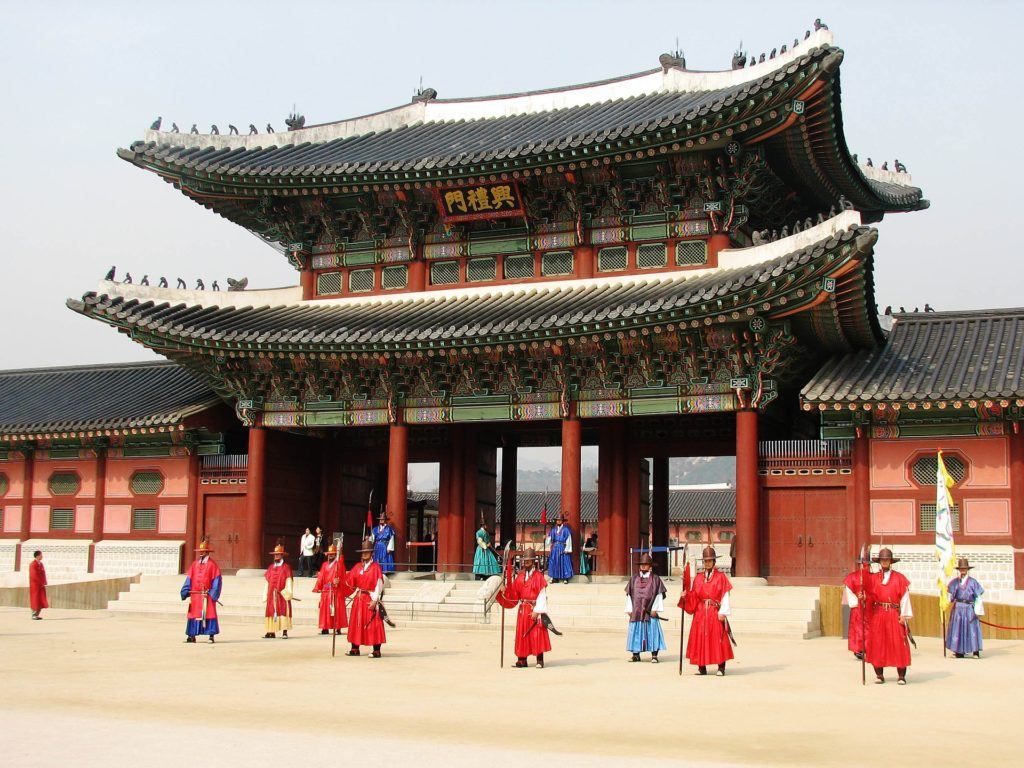
The Broke Backpacker is supported by you . Clicking through our links may earn us a small affiliate commission, and that's what allows us to keep producing free content 🙂 Learn more .
Need a place quick? Here’s the best neighbourhood in Seoul:
The best places to visit in seoul, faqs on the best places to visit in seoul, final thoughts before visiting seoul’s best places.
- Buy Us a Coffee!
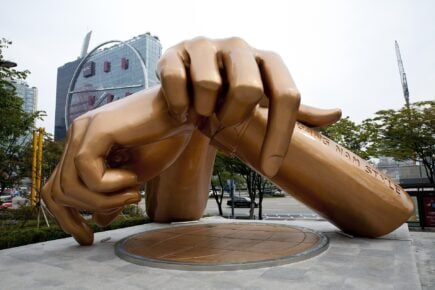
Gangnam translates as ‘south of the river’ and is a district that has blown up in recent years. It was originally an area dedicated to sleepy rice fields – but you’d never believe it when visiting today!
- Check out the K-pop scene and pick up a few CDs at Evan Records.
- Shop for the latest fashion and boutique items (or just window shop) at Galleria department store.
- Eat bibimbap at Tokkijung or a famous Korean barbeque meal at Yang Good.
Where to go while backpacking Seoul South Korea in a HUGE city of 10 million that sits on the Han River? Let’s talk about it!

Unlock Our GREATEST Travel Secrets!
Sign up for our newsletter and get the best travel tips delivered right to your inbox.
#1 – Bukchon Hanok Village – What to Visit in Seoul for Korean Architecture
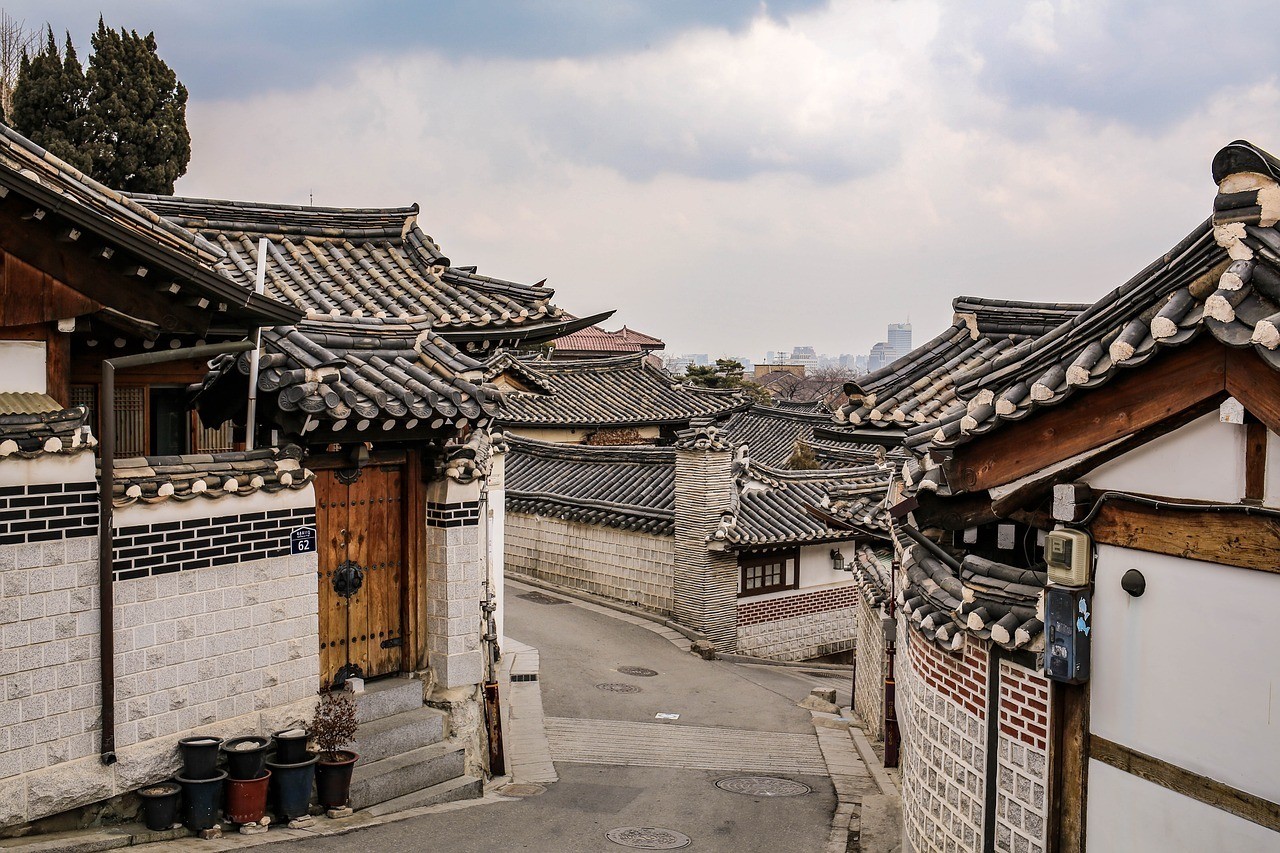
- A great place to experience Seoul’s traditional culture.
- You’ll be able to take some awesome pictures in this area!
- Just be aware that people still live in these houses, so be respectful of their privacy.
Why it’s so awesome: The traditional houses in Seoul are called Hanok and they date back to the Joseon Dynasty between 1392 and 1910. These houses are designed to maintain a balance between the house and the outside world of mountains, rivers, and land contours. If you’re lucky, you may even be able to find a place to stay in Seoul around this area.
What to do there: People actually still live in this residential area, which is located between Gyeongbokgung Palace and Changdeokgung Palace, so be respectful of their spaces and time. If you can, join a guided tour early in the morning to get even more insights. Or take some extra time and explore the area and make sure you get some pictures too. There are some spots where you can see the traditional houses against more modern landmarks, and they make for the most striking photo-ops of all.
#2 – Myeongdong – Where to go in Seoul if you love to shop!
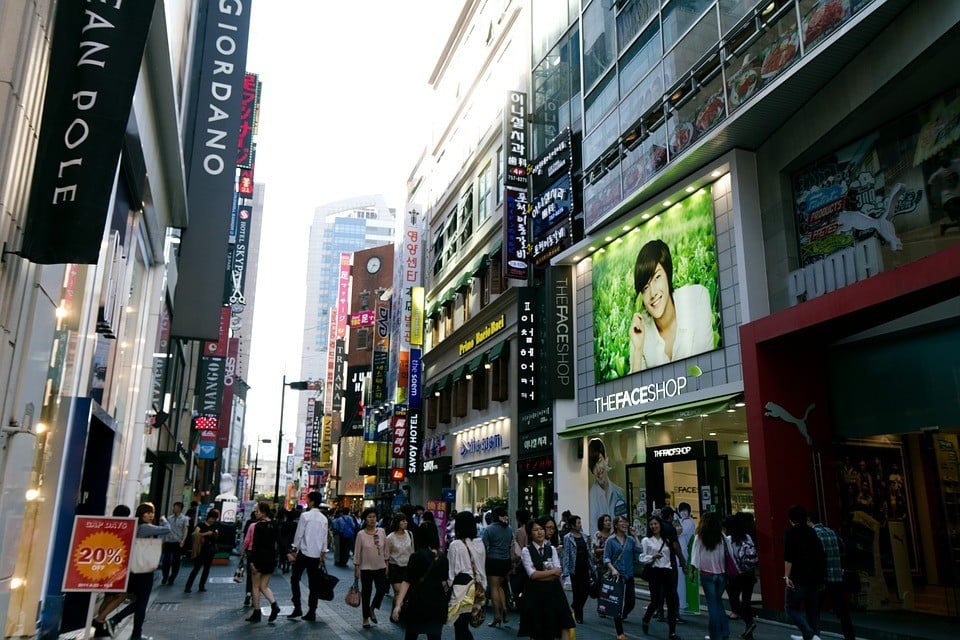
- Literally shopper’s paradise!
- You’ll find amazing deals in this area on every kind of cosmetics you can imagine.
- Make sure you take advantage of the samples and the changing deals and offers.
- If you want to find out more, get a guide to show you around!
Why it’s so awesome: Myeongdong is a whole shopping area dedicated to every cosmetic store and brand you could ever want. So, no matter what type of skin you have or what make-up look you want, you’ll be able to find the right products in this area.
What to do there: This is the most famous place in Seoul for shopping and there are always a lot of special deals and offers in this area so keep your eyes open and take advantage of them. A lot of shops also offer free samples, so don’t be afraid to try a brand you’ve never heard of! This is a trip mostly for the girls, so leave the guys at your Seoul Airbnb and take your best friends along for the ride.
#3 – Lotte World – A must-do in Seoul for families!
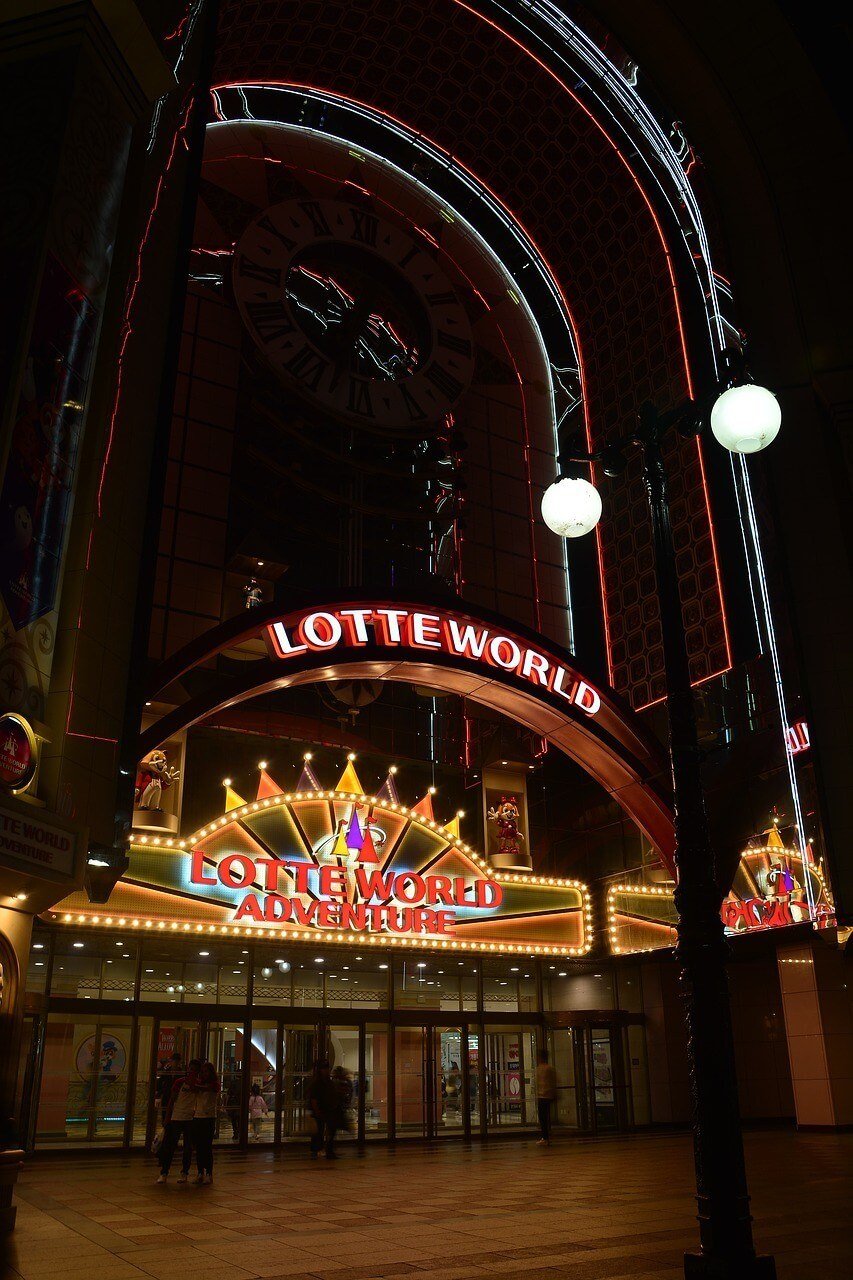
- The world’s largest indoor amusement park.
- If you get tired of the rides, then visit the shopping complex also on-site!
- This is a Seoul must-do and a great place to take the kids.
Why it’s so awesome: Lotte World is huge. It includes both an indoor and outdoor amusement park and there is also a hotel, an aquarium, luxury boutiques, a water park, and a shopping center on-site! So, even if you get tired of the rides, you can always slip out and grab a meal or a bargain before returning to the Lotte fun.
What to do there: Take the kids, or friends, and just enjoy the amusement park – this is one of those things to do in Seoul that everyone can get behind. The rides and attractions are some of the best you’ll ever see at Lotte World and it’s well worth taking an entire day in this park to soak it all in.
Make sure you try the Desperados game, the Dragons Wild Shooting game, and the Comet Express rollercoaster for maximum fun and thrills! It’s easily a must-visit in Seoul if only to feel like a kid again. Buy your tickets before you go, so you won’t end up waiting in line.
#4 – Gyeongbokgung Palace – Possibly one of the most important places to visit in Seoul
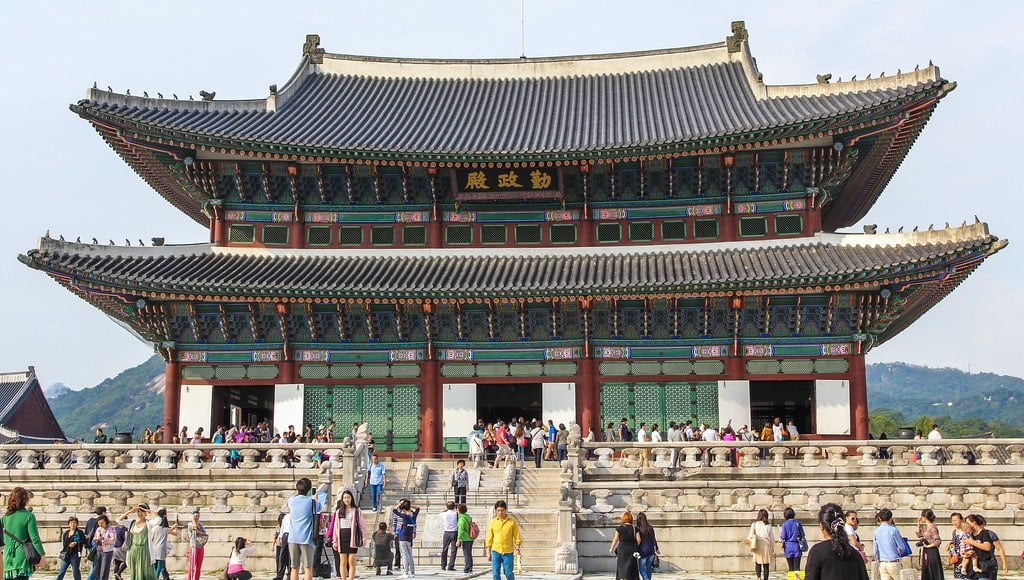
- When you travel to Seoul, you absolutely must not miss this historic building!
- The largest and most important palace in Seoul.
- If you wear a traditional hanbok dress, they’ll let you in for free.
Why it’s so awesome: The Gyeongbokgung Palace is often compared to the Forbidden City in Beijing and is a Seoul itinerary must-see. Built in 1395, it was the main royal palace of the Joseon family, who ruled Korea for hundreds of years.
The palace was mostly destroyed by Imperial Japan during the early 20th century but over the following years, it has been meticulously restored. It is now considered to be one of the most beautiful palaces in the world, which is why it’s one of the best places to visit in Seoul.
What to do there: There are lots of places in the city where you can hire a hanbok – a traditional Korean dress. If you turn up at the palace wearing it, they’ll let you in for free. Aside from that, just explore the site. I’d recommend jumping on a guided tour to get to know all of the details about this stunning palace and the secret garden on site.
Also, make sure you show up to see the changing of the guard or the Gwanghwamun Gate Guard-on-Duty Performance . Either one happens between 10 and 4 pm every hour on every day except Tuesday and it’s a really fun thing to see in Seoul.
Want to save money on accommodation?

We got you. For reals.
#5 – N Seoul Tower – A place to go in Seoul to see the city from a different angle.
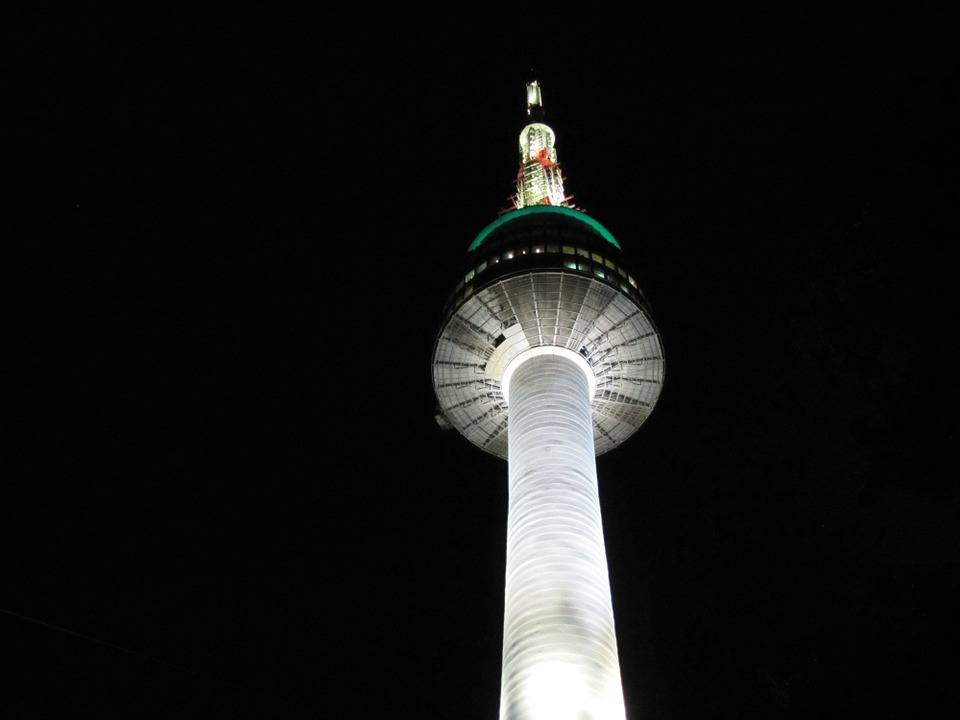
- The best place for panoramic views of the city.
- The building also hosts a variety of cultural and entertainment events as well as restaurants and snack bars.
Why it’s so awesome: If you’re looking for the top place to visit in Seoul while backpacking South Korea , they don’t get much more “top” than this. The N Seoul Tower is located on Mt. Namsan and has been Seoul’s most iconic site since its opening in 1980. It’s actually a communication and observation tower, but over the last few years, it’s become one of the most important and celebrated sites in the city.
What to do there: Go to the top and enjoy the views. Sometimes, the best way to explore a city is to see it high up and at a distance so you can get an idea of the scale, and this tower offers the best place in the city to do just that.
Afterward, go down to see a movie or an exhibition in the cultural space, or just grab a table at the upscale restaurants there and enjoy a fantastic meal. If you are passing through Seoul, then you see this (but not climb) on a Seoul transit tour from the airport.
#6 – The Yun Dong-ju Literature Museum – Where to visit in Seoul if you are alone.
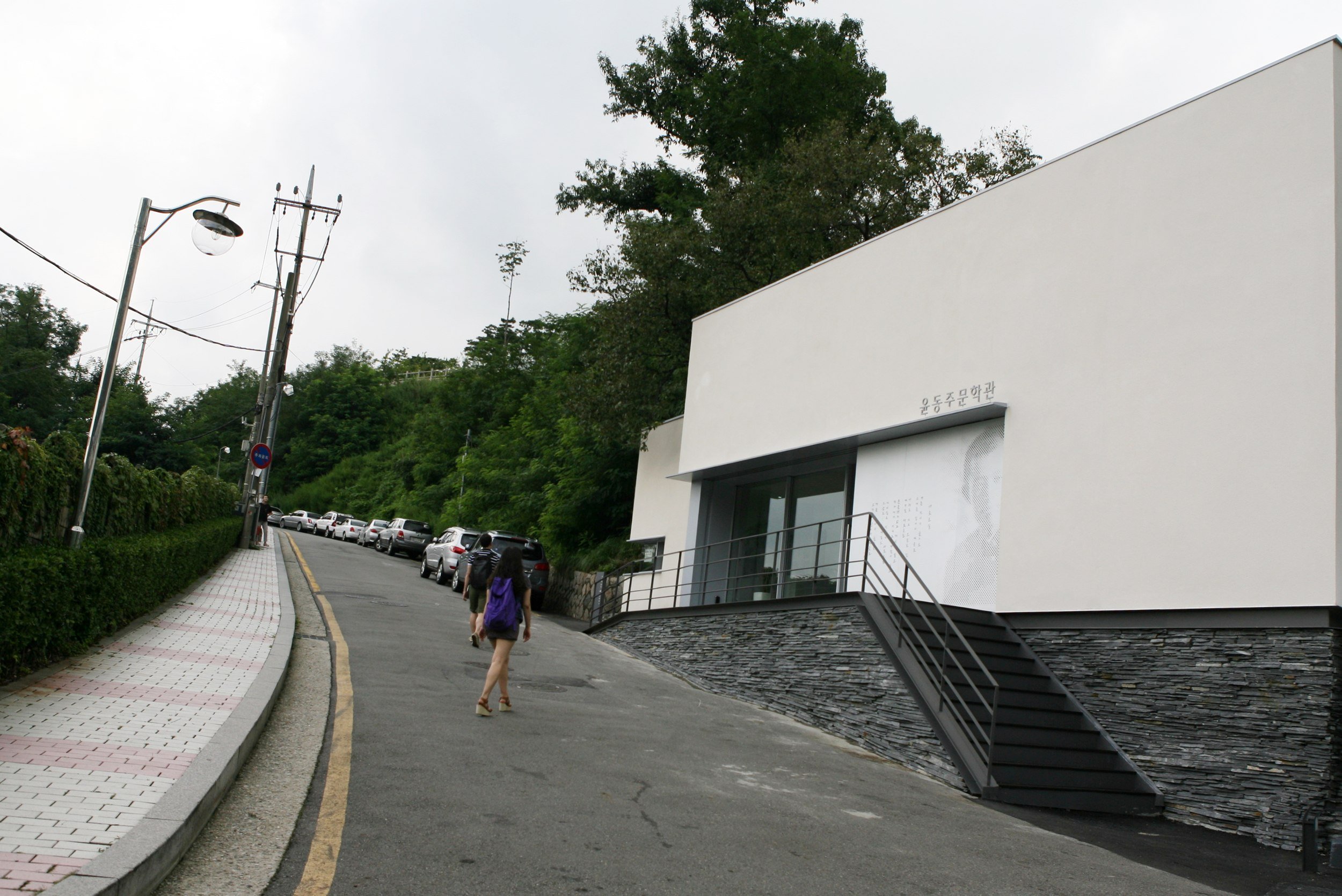
- Reading the books and poetry from another culture is a great way to gain a deeper understanding, and this is a great entry point into South Korean Literature.
- If you love books and history, this is a Seoul must do.
Why it’s so awesome: This is a museum built in honor of the beloved South Korean poet Yun Dong-Ju. It’s a three-room museum where you can explore photos from his life as well as first editions of his poems. The space itself is beautiful as well; the indoor space perfectly captures the contemplative, inspiring mood of the poetry and is a Seoul itinerary must for the contemplative travelers.
What to do there: Spend some time exploring the photos and contemplating this poet’s work before going outside. You can take a wall on Poet’s Hill at the back of the museum and get great views of the city and the N Seoul Tower. After your visit, you might even be inspired to get writing!

A new country, a new contract, a new piece of plastic – booooring. Instead, buy an eSIM!
An eSIM works just like an app: you buy it, you download it, and BOOM! You’re connected the minute you land. It’s that easy.
Is your phone eSIM ready? Read about how e-Sims work or click below to see one of the top eSIM providers on the market and ditch the plastic .
#7 – The Jeoldusan Martyr’s Shrine – An important historical site in Seoul.
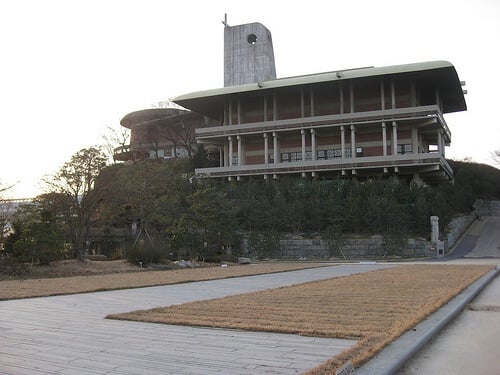
- A sobering but beautiful shrine that remembers a very dark time in history.
- Don’t take the kids to this site as some of the displays may upset them.
- If you want to explore Seoul, going back to its roots is a good way to start.
Why it’s so awesome: This is a Catholic shrine on the Han River and marks the Byeonin Persecution of 1866. At this time, nine French missionaries were martyred which led to the French fleet attempting an invasion into Korea. In retaliation, the Jeoldusan government targets, punished and murdered French and Korean Catholics, leading to this site became known as the ‘beheading mountain’. This obviously isn’t a fun site, but it’s an important part of Korean history and must be seen if you want to understand the present.
What to do there: The shrine is especially beautiful at night when votive candles give it an otherworldly glow, but it’s still beautiful and sobering when you go during the day. Don’t bring your kids with you as the Shrine houses a gallery and museum display torture implements that were used on the captured Catholics.
#8 – The Seoul Museum of Art – The perfect attraction in Seoul if you are on a budget!
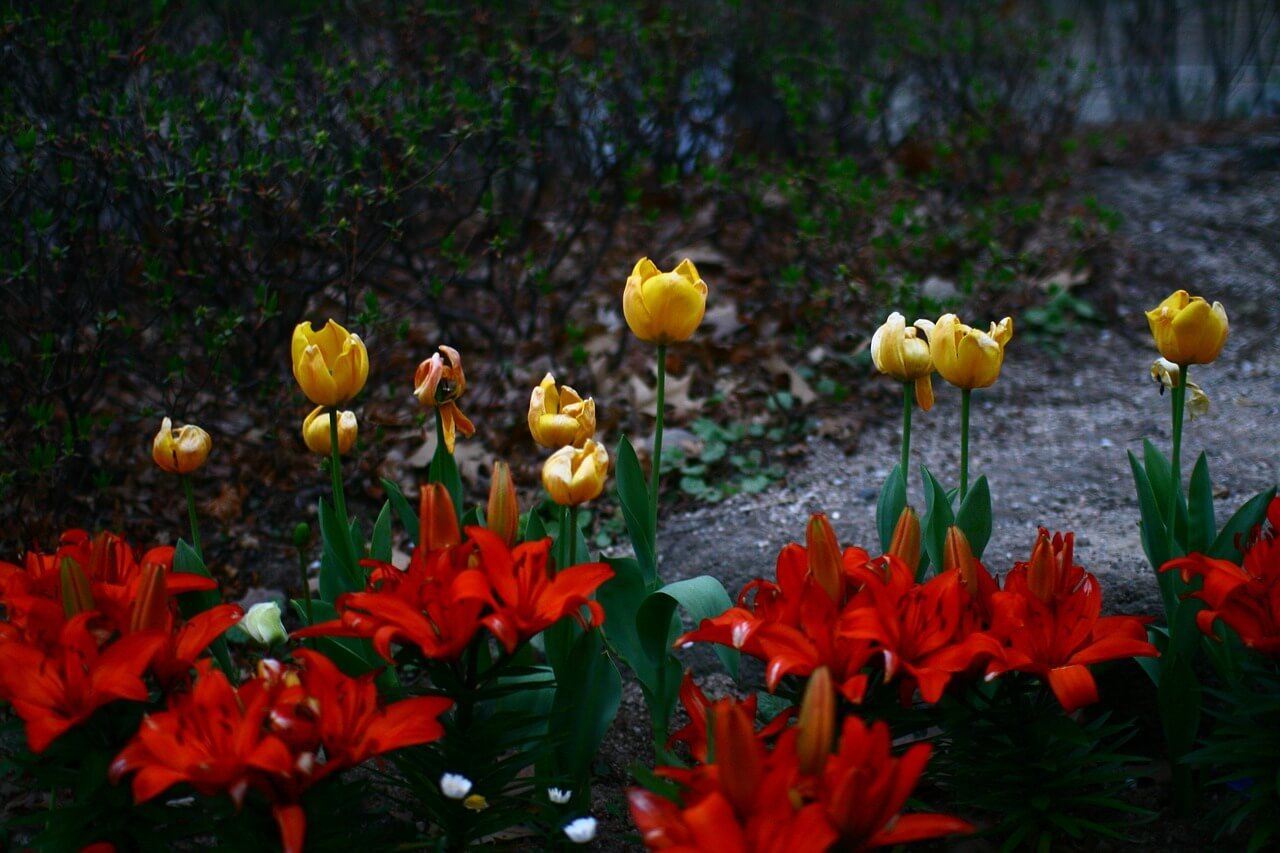
- One of the best points of interest in Seoul that’s also free!
- The museum is housed in a beautiful and historic building which offers great photo opportunities.
Why it’s so awesome: How about a free thing to do in Seoul! This museum plays host to a range of special exhibitions that (like the country itself) can be expensive , but the permanent display is totally free. It highlights the career of the Korean artist Chun Kyung-Ja, who was influenced by African culture and art and is worth the trip to the museum alone.
What to do there: Before you go, check out what special exhibitions they have on during your stay. Korean art is very unique and well worth exploring, so spend some time getting to know their unique style. But make sure you check out the regular display as well because it’s beautiful and soulful.
#9 – The Cheongun Literature Library – Another place in Seoul for the bookworms!
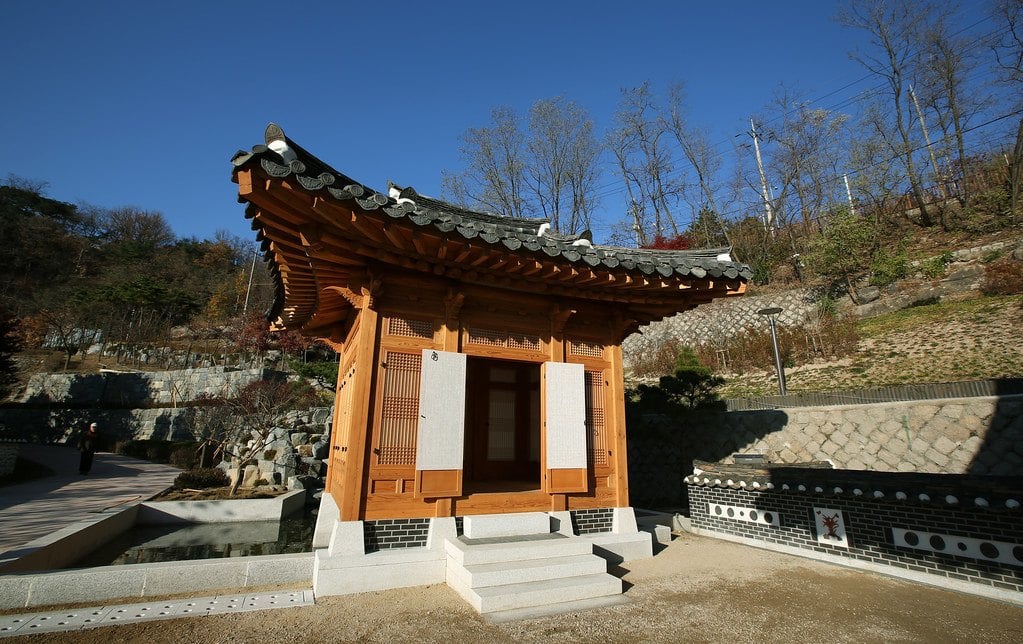
- An amazing place to spend some time if you love books!
- One of the most beautiful museums in Korea.
- If you’re trying to work out what to do in Seoul on a quiet afternoon, this is a site where you can sit back and relax.
Why it’s so awesome: The collection of books at this library is fairly average, but it’s the space that makes it amazing. The reading rooms are located on the second floor of a traditional Korean houses which is spacious, sunny, and welcoming. So, if you love to read , this is a perfect place to settle in and do it!
What to do there: Make sure you spend some time exploring this traditional Korean house. This style of Korean architecture is unique and oddly harmonious with the natural surroundings, so it’s worth taking note of it. And then, get away from the busyness of the city by choosing a book and taking it upstairs to read. There’s nothing like reading a good book in an atmospheric space, so take advantage of the opportunity.
#10 – Everland – A very cool place in Seoul for a day trip
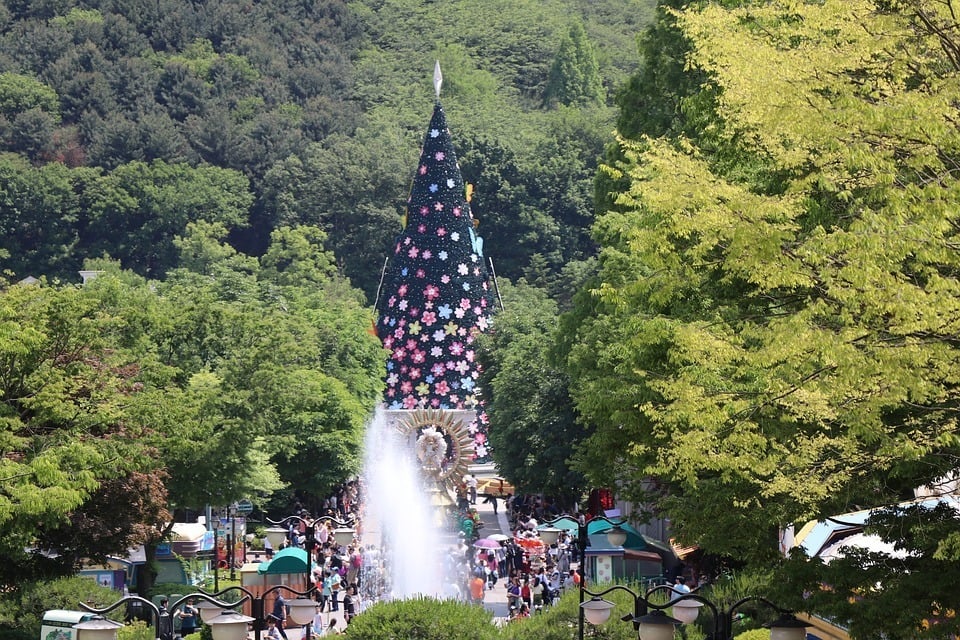
- A great place to take the whole family while you’re visiting Seoul
- This park has the steepest wooden roller coaster in the world.
Why it’s so awesome: Seoul breaks a lot of world records and this affects how they build things and what they enjoy. Everland is the largest outdoor theme park in South Korea and has five zones of rides and attractions. This includes the world’s steepest wooden roller coaster and South Korea’s only safari, so come expecting some thrills.
What to do there: Get there early because there’s a lot to do and you’ll need the whole day to fit it all in. If you love roller coasters, make sure you ride the world’s tallest wooden coaster and be prepared to scream your lungs out along the way!
#11 – The NANTA Theater – Seoul and South Korea’s artistic scene is definitely a must-see.
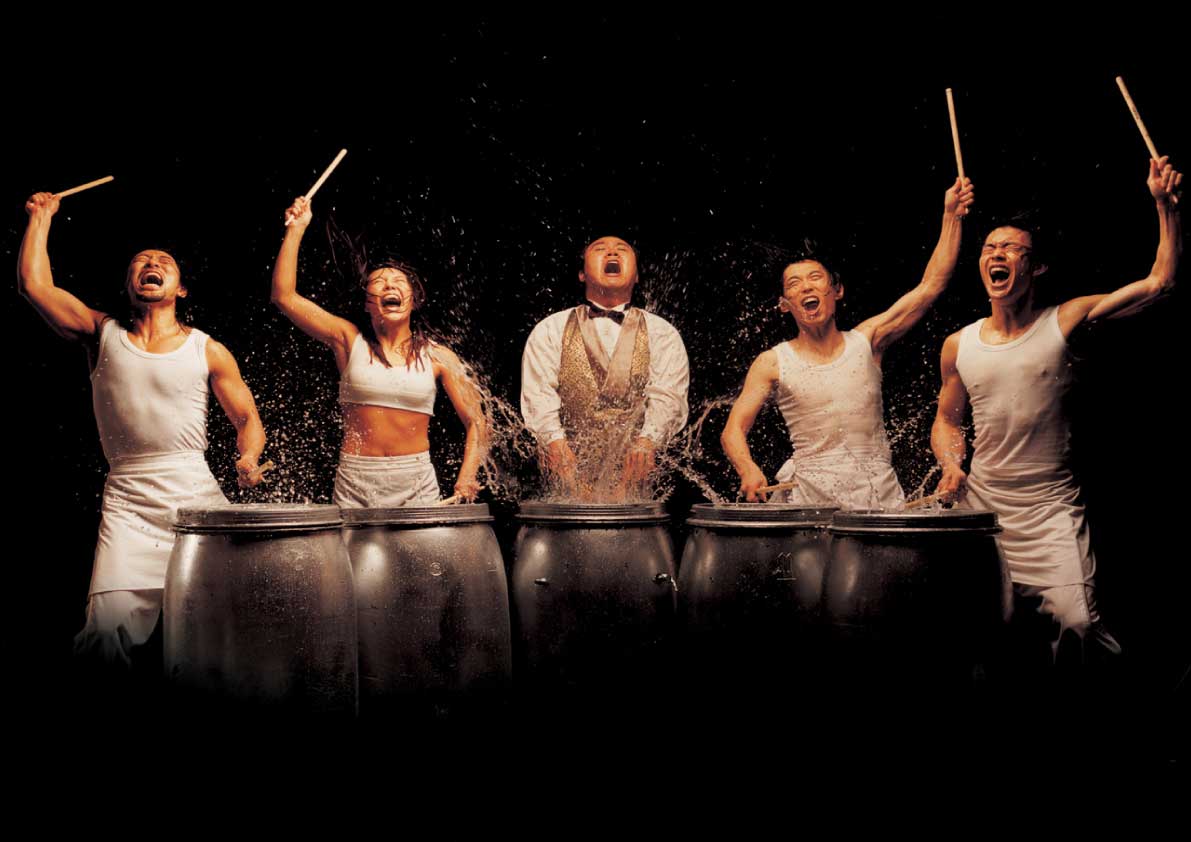
- Another side of Korean culture and one you probably won’t expect!
- The most popular theater performance in the city.
Why it’s awesome: Every culture is different and sometimes it’s great to get a first-hand view of just how different another country can be. The NANTA Theater is the perfect place to get a different view on the modern culture of South Korea. It’s the most popular theatre in the city and has a non-verbal, musical base. Perhaps a little strange, but it’s a terrific window to seeing another side of the city while backpacking – maybe one of your Seoul hostel mates would be down to join?
What to do there: This theatre has shows regularly so check out what’s on before you arrive in the city. And once you’re there, just enjoy the culinary-themed comedy performance with acrobatic moves and rhythmic melodies. Chances are that you’ve never seen anything like it and never will again! The shows sell out fast – they’re incredibly popular – so book early to make sure you don’t miss out.
#12 – The Seoul Alive Illusion Museum – Quite the quirky place in Seoul to visit!
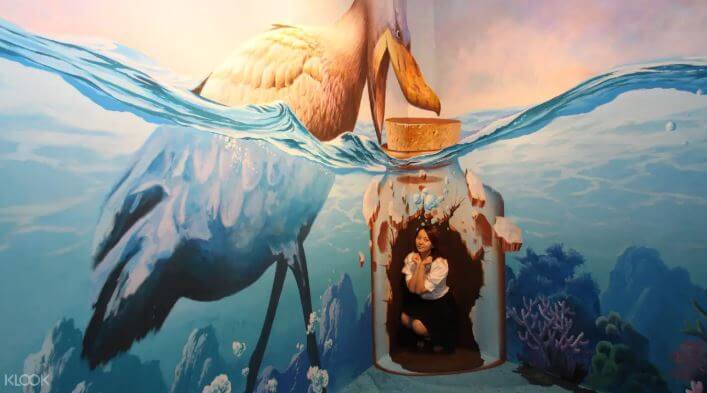
- The first museum of 4D optical illusions in South Korea.
- Includes more than 100, slightly quirky exhibits.
- The perfect place to go with friends or with your family while you’re visiting Seoul.
Why it’s awesome: Even if you’ve been to an optical illusion museum before, you probably haven’t seen one like this. A lot of the exhibits in this museum are slightly quirky and unusual, and you’ll probably spend a lot of your visit to this venue laughing your head off at the displays you can become part of. It’s just a little run-of-the-mill Korean madness.
What to do there: Make sure your phone or camera is fully charged before you spend a few hours at this museum because you’ll need it. Even if you’ve seen optical illusion museums before, this one is unique. Make sure that you check out the Disney displays and become a part of popular movies like Frozen and Cinderella in your own personal works of art. Sort your booking in advance to have an even better experience!

Wanna know how to pack like a pro? Well for a start you need the right gear….
These are packing cubes for the globetrotters and compression sacks for the real adventurers – these babies are a traveller’s best kept secret. They organise yo’ packing and minimise volume too so you can pack MORE.
Or, y’know… you can stick to just chucking it all in your backpack…
#13 – Tosokchon – A must-do in Seoul to delight your tastebuds.
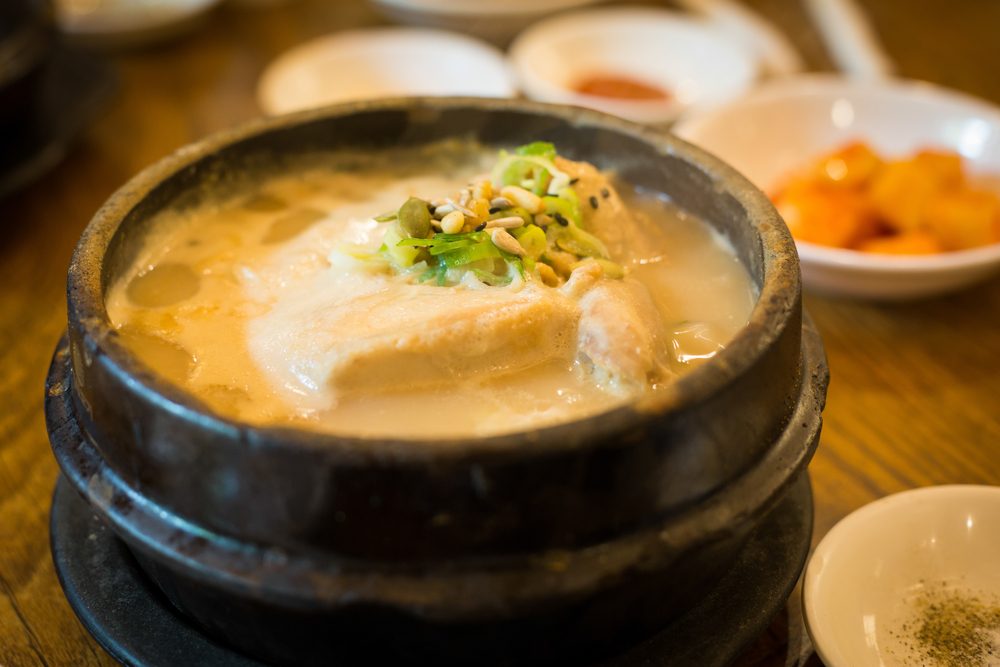
- Home to one of the most famous dishes in the city.
- Expect queues, but the wait is definitely worth it.
- Buy a ticket online if you want to skip the line
Why it’s so awesome: Every city has a dish that they’re famous for and one of Seoul’s most famous dishes is known as Samgyetang. This is ginseng chicken soup, and the best place to buy it is at Tosokchon restaurant on Jahamun-ro 5-gil Road. Once you taste the dish, you’ll understand why people queue up to eat it every day and one of my top South Korea travel tips is to try it!
What to do there: Arrive early if you want to be in the front of the line and just wait patiently. The dish is worth the trouble, as all the locals in line will tell you, so just accept the wait and enjoy your food once it arrives. Make sure you try it though; it’s a must-do when visiting Seoul!
#14 – The Cheonggyecheon Stream – A quiet and romantic place to see in Seoul.
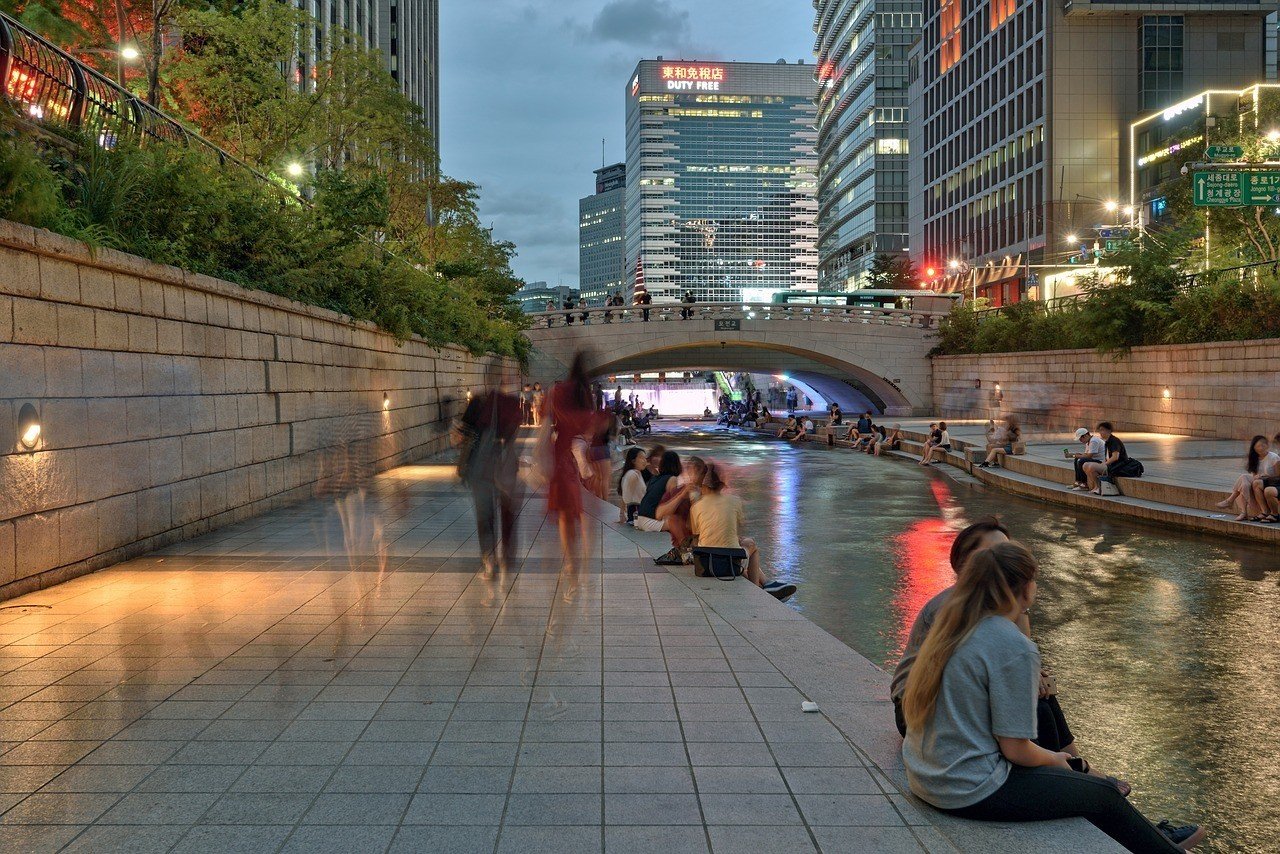
- A chance to take a break from the busy city and enjoy a slice of nature.
- You can also walk the length of the stream, which will take you alongside lots of Seoul’s best tourist attractions.
Why it’s so awesome: Seoul is a busy modern city and sometimes it’s nice to get away from the crowds and pollution and enjoy a bit of nature. And that’s exactly what this stream is for. The locals often visit on hot summer days and spend time sitting in the shade and dipping their feet in the water, and you can do the same when you need a little break.
What to do there: Walk down to the stream and just spend some time relaxing. The stream is like a little oasis in the middle of the city, so take the time to slow down and rest. You can also walk the length of the stream if you’re feeling energetic and stop off at local attractions along the way.
#15 – Bukhansan National Park – The most beautiful nature in Seoul.
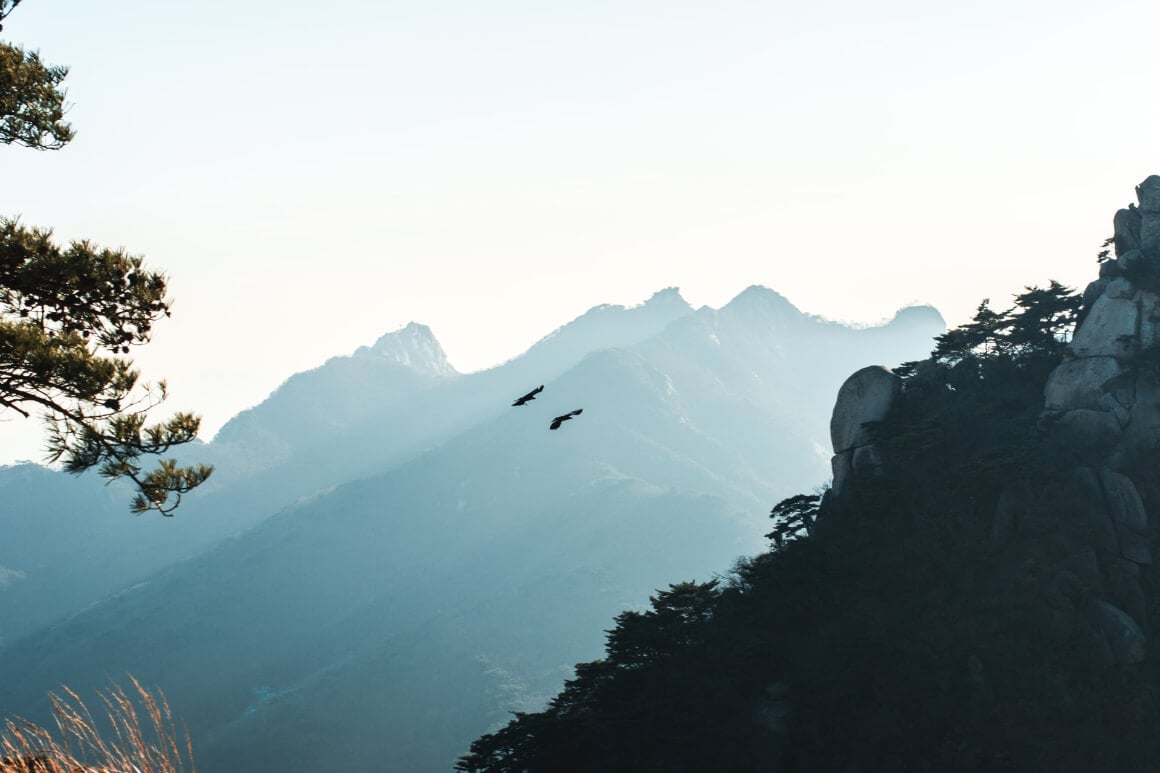
- A traditional market where you can find almost anything you want to buy.
- The prices are extremely good, so make sure you check it out if you want something specific.
Why it’s so awesome: While you’re in Seoul, you might find the city can be overwhelming at times. No matter, because just outside the city centre you’ll find the Bukhansan National Park, which is the best place to go hiking in Seoul. Aside from outdoor recreational activities, the national park boasts impressive mountain views and lush forestry. You might also see some ancient temples and fortresses along the way.
What to do there: The reason most people visit the Bukhansan National Park is to do some hiking. Whether you’re an avid hiker or a beginner level hiker, you’ll find a trail suitable to your ability here.
#16 – Gwangjang Market – Seoul’s street food delights!
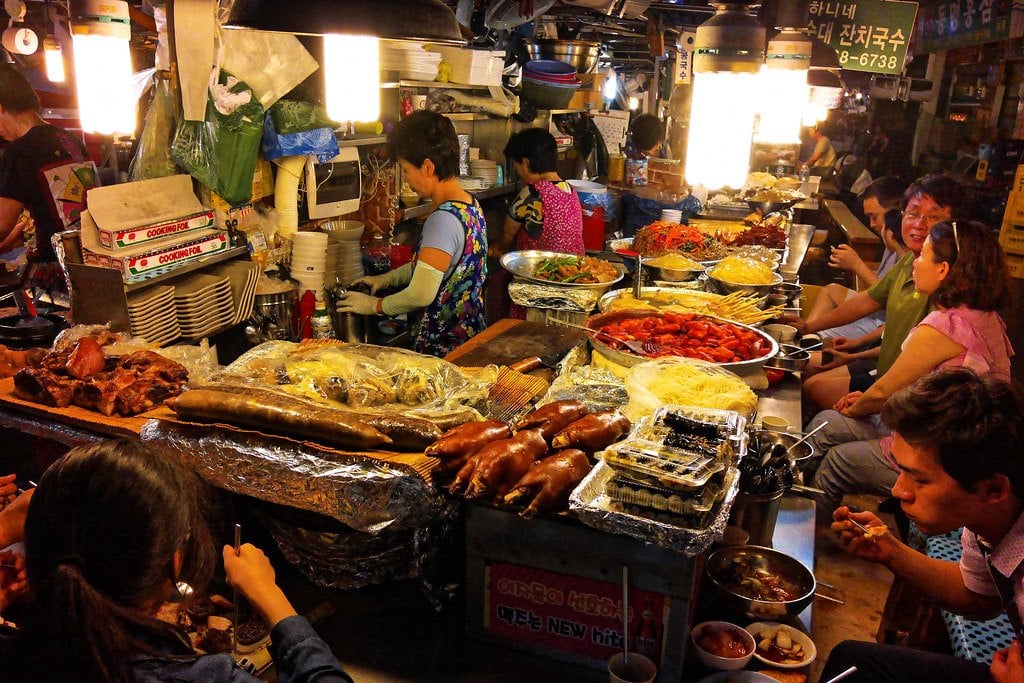
- One of the best places to eat in Seoul.
- This market is popular with tourists and locals.
Why it’s so awesome: If you want good street food when you visit another country, then you need to go where the locals go. And the locals all know to go to Gwangjang Market. This was the first permanent market in Korea selling local delicacies and fine linen and it also contains some of the best stalls in the city if you enjoy trying street food.
What to do there: You can do some shopping while you’re at this market, but mostly you want to try the food. The market’s open Monday to Saturday from 9 am to 10 pm, so bring your appetite and try as much of the street food as you can. Make sure that you try the bindaetteok or mung bean pancake and tteokbokki and noodles for a really unique eating experience.

Our GREATEST Travel Secrets…
Pop your email here & get the original Broke Backpacker Bible for FREE.
#17 – Hongdae – A must-see for foodies!
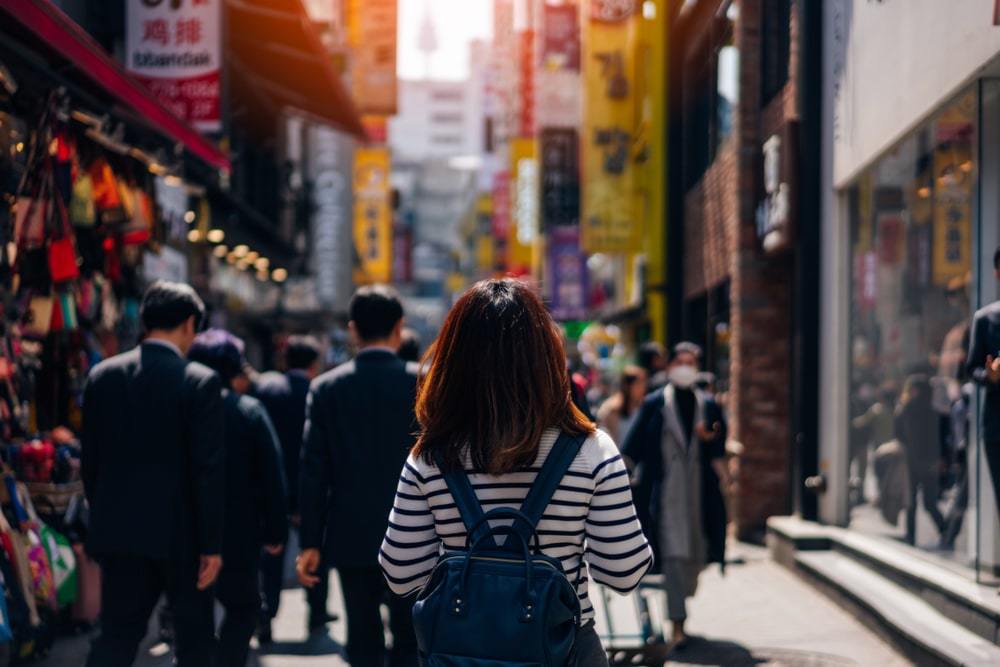
- Seoul’s nightlife center.
- This area is near the university, which is why it’s filled with young people and fashionable places to eat and party.
Why it’s so awesome: The areas around universities in most cities are beacons for popular eateries and wicked nightlife and Seoul is no different. Just moments from Hongik University, one of the most prestigious in the city, this area attracts students, locals, and tourists who enjoy the best and most fashionable shopping and dining in the city. Some of Seoul’s best hostels are in the area too!
What to do there: This is an area that really comes alive at night, so save it for an evening when you don’t have much to do. Get ready to try a whole bunch of delicious Korean food , because this is one of the best places to eat in Seoul, and then go shopping. There is a range of clothing stalls and shops selling vintage goods so take your time and see what’s available. And if you enjoy clubbing, you’ll find lots of different options in this area.
#18 – Ikseon-dong Hanok Village – An unknown (but awesome) place to see in Seoul!
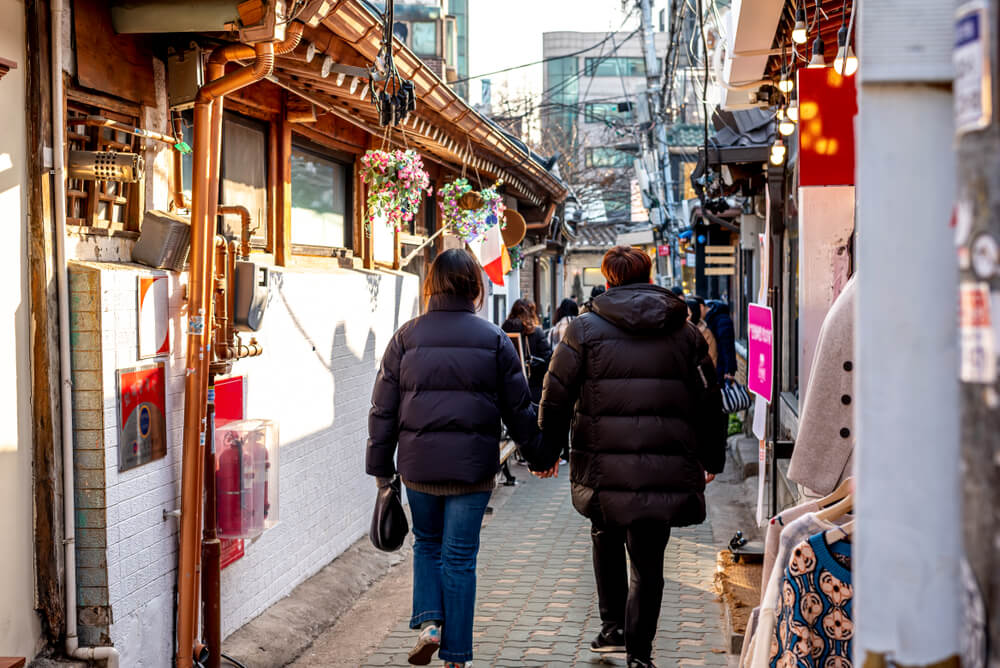
- The best place in the city to experience old Korea.
- There are some amazing cafes and pubs in this area too, so make sure you have a meal during your explorations.
- If you’re trying to decide what to do in Seoul off the tourist trail, this is the perfect place to visit.
Why it’s so awesome: This area isn’t usually listed as one of the best places to visit in Korea, but it’s great if you want to enjoy a mix of history, food, and creative shopping options. The area was first established in 1920 and preserves that time almost perfectly. Wandering the alleys could almost make you believe that you’ve moved back in time, and makes for a great afternoon. And think South Korea is so safe , yes you can just aimlessly wander!
What to do there: Just wander the alleys and enjoy the time away from Seoul’s tourist spots. There’s always something hidden to discover and explore in this area, and it’s well worth spending some time there to get a real feel for the past.
But don’t neglect the present either, because the shops are some of the most interesting in the city too. So, do some shopping and then stop at one of the artisan cafes or gastro pubs for a meal. It’s also worth it to join a pub crawl tour with a local guide to get to know the hidden gems of this cool district.
#19 – Insa-dong
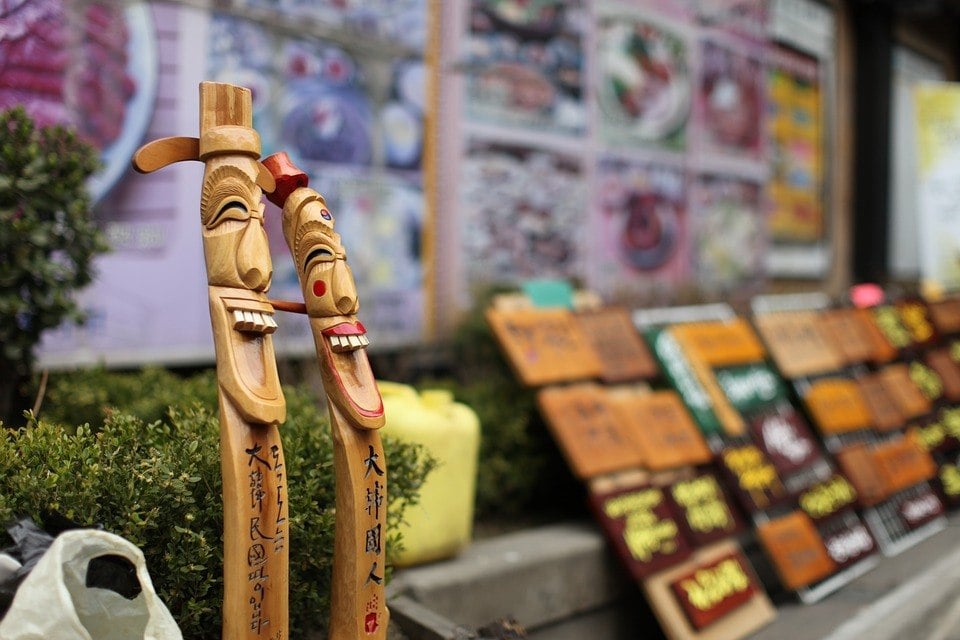
- If you want unique souvenirs, this is one of the hotspots in Seoul for them.
- The center of Korean traditional culture and crafts.
- A great place to explore Seoul and support local craftsmen at the same time.
Why it’s so awesome: If you’re interested in traditional Korean culture and crafts then this is the place where it’s all gathered together so you don’t miss anything. Insa-dong specializes in goods that can only be purchased or enjoyed in Korea, so it’s the perfect place to grab a souvenir for your loved ones back home!
What to do there: There are about a hundred galleries in Insa-dong and they display every type of Korean craft that you can imagine or have ever heard of. Make sure you check out the hanboks, which is a piece of traditional Korean clothing, traditional teas, and folk crafts. Also, try to go on a Sunday as streets are blocked off to allow for stalls and booths as well as traditional performances and exhibits.

Drink water from ANYWHERE. The Grayl Geopress is the worlds leading filtered water bottle protecting you from all manner of waterborne nasties.
Single-use plastic bottles are a MASSIVE threat to marine life. Be a part of the solution and travel with a filter water bottle. Save money and the environment!
We’ve tested the Geopress rigorously from the icy heights of Pakistan to the tropical jungles of Bali, and can confirm: it’s the best water bottle you’ll ever buy!
#20 – Yongma Land Abandoned Theme Park – A haunted place to visit in Seoul… maybe…
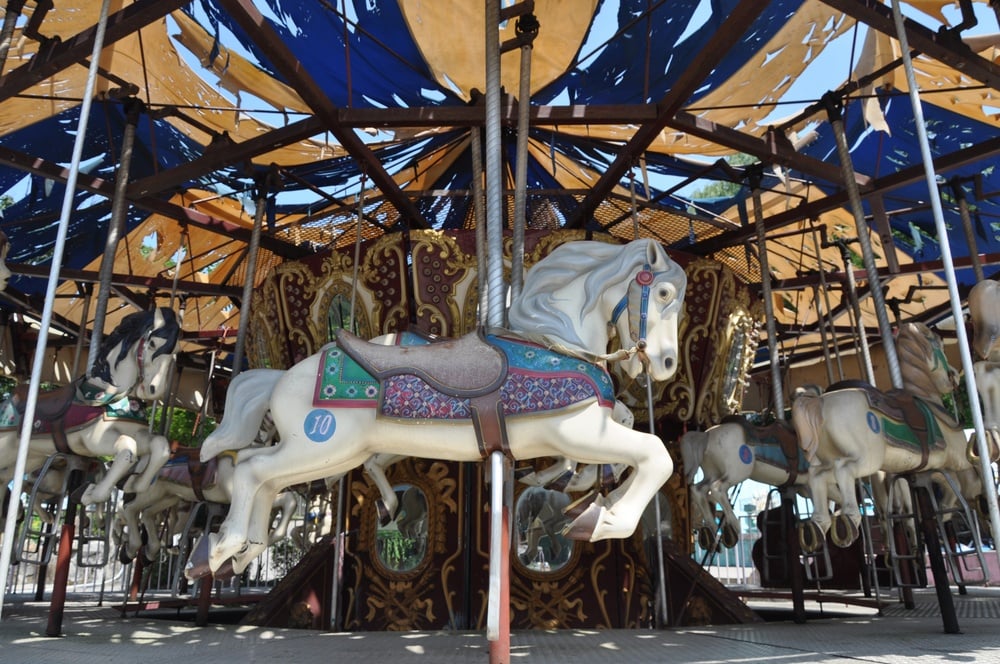
- A slightly creepy look at the other side of entertainment.
- There are stories going around that the park shut down because of a ghost!
- If you want to find unusual things to do in Seoul, this is the perfect place to start.
Why it’s so awesome: Yongma was built in 1980 and was a small, family-run amusement park. It shut down in 2011, allegedly because of ghosts, though it’s far more likely that the owners had economic reasons for closing their doors. But since then, the park was bought by a savvy businessman who invites visitors to become part of the park’s demise.
What to do there: If you’ve ever wanted to explore an abandoned amusement park, this is your chance. You can clamber over old dodgy cars, try out the carousel, and take pictures next to a sad clown roller coaster.
There’s a small charge involved, and if you get there at night you can pay a little extra and ask the owner to turn on the lights of the merry-go-round while you’re there. Set against the declining rides, it’s a ghostly sight that should be savored. Or you can explore Yongma Land Abandoned Theme Park with a guide. You can enjoy the picture at the photo spot for K Drama & K Pop during this Yongma Land Abandoned Theme Park + Strawberry Picking tour
#21 – Seodaemun Prison – Possibly one of the most important historical places to visit in Seoul.
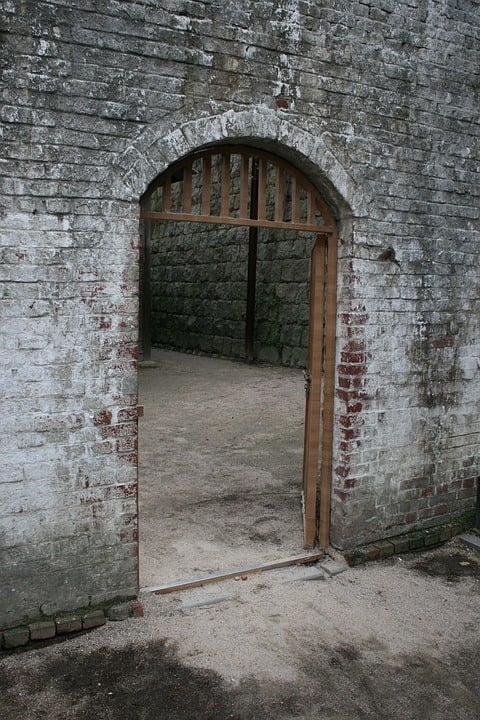
- Not a fun place to visit, but an important one if you want to understand South Korean history.
- This was a prison built for Koreans who rebelled against Japanese forces.
Why it’s so awesome: Built in 1908, this prison held Korean rebels who fought against Japan’s invasion and occupation. Before it was created, the country had virtually no penal system, and this location came to symbolize the determination of the Korean people to win their freedom despite the costs. Many Korean patriots died in custody, were tortured or executed at this location, and it’s a sobering reminder of the darker side of humanity.
What to do there: This isn’t a fun place to visit in Seoul. It was designated as a historic site in 1988 and renovated in 1995 and is a stark and sometimes brutal slice of Seoul’s history. As you walk through the prison-turned-museum, you’ll see torture chambers with terrifyingly realistic mannequins of famous Korean patriots and get an idea what it was like for the people who lived and died within the prison’s walls.
#22 – Coffee Hanyakbang – Seoul’s Must-Visit for the Coffee Connoisseurs
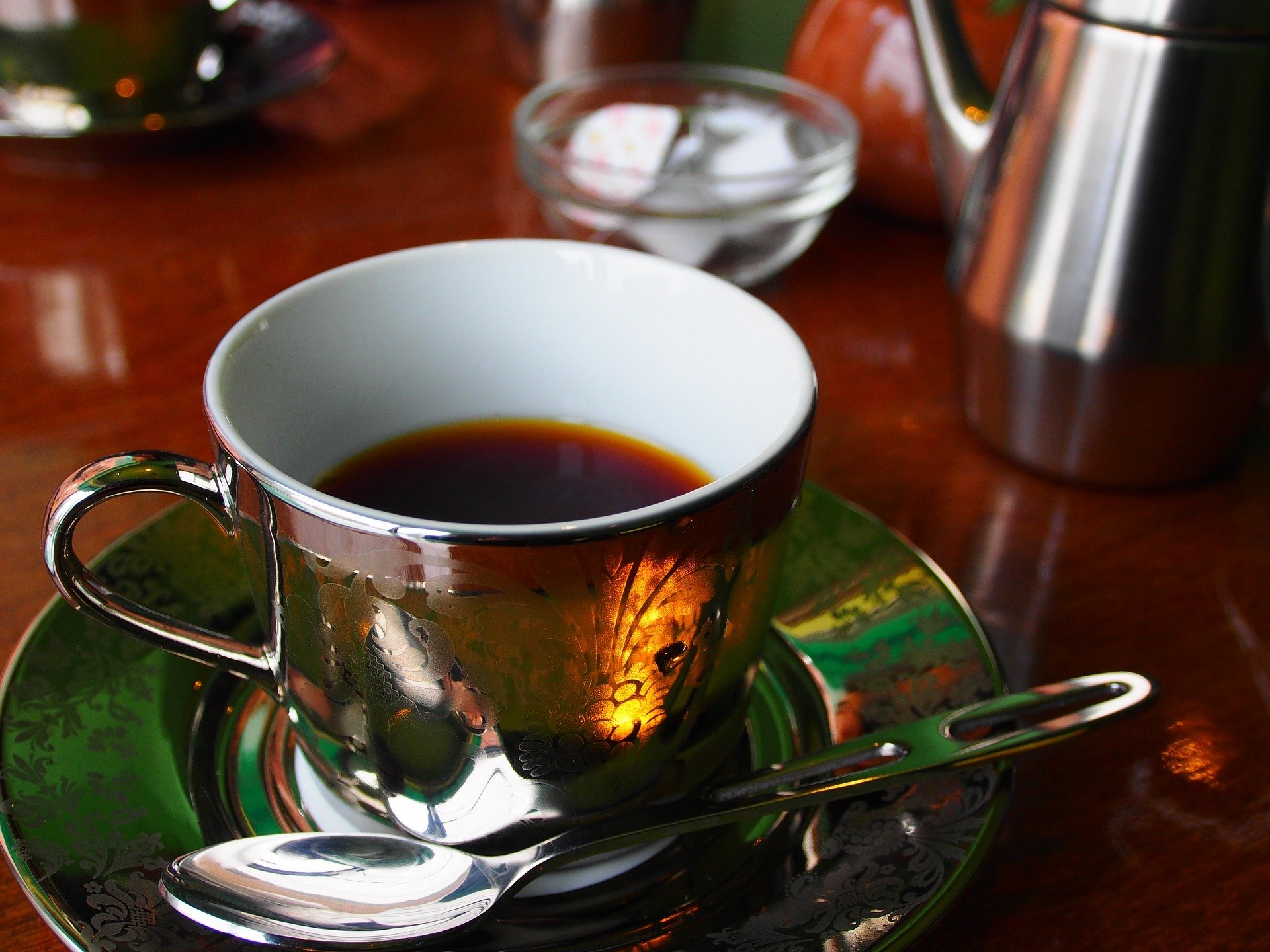
- The perfect place for coffee lovers of all ages.
- A nearly hidden gem that only the locals know about.
- If you live for your morning coffee, you’ll find lots of new coffee tastes at this site.
Why it’s so awesome: Almost everyone loves coffee and this tiny shop allows you to celebrate it in style. It’s almost hidden down a narrow, unmarked alleyway but coffee connoisseurs know that it’s there and turn up in droves to get the perfect coffee experience. The shop is decorated in a mix of Korean and Chinese styles and is determinedly rustic, with lots of wood and exposed pipe. And it sells delicious, hand-drip coffee at decent prices.
What to do there: Drink your morning coffee, of course! The owners roast the beans by hand at the back of the shop and grind them on site, so the whole shop has that rich, tongue-tingling smell of fresh coffee. And the making of each coffee is a science too, with everything precisely calculated to create the perfect cup, every time. So enjoy!
#23 – The Korean War Memorial
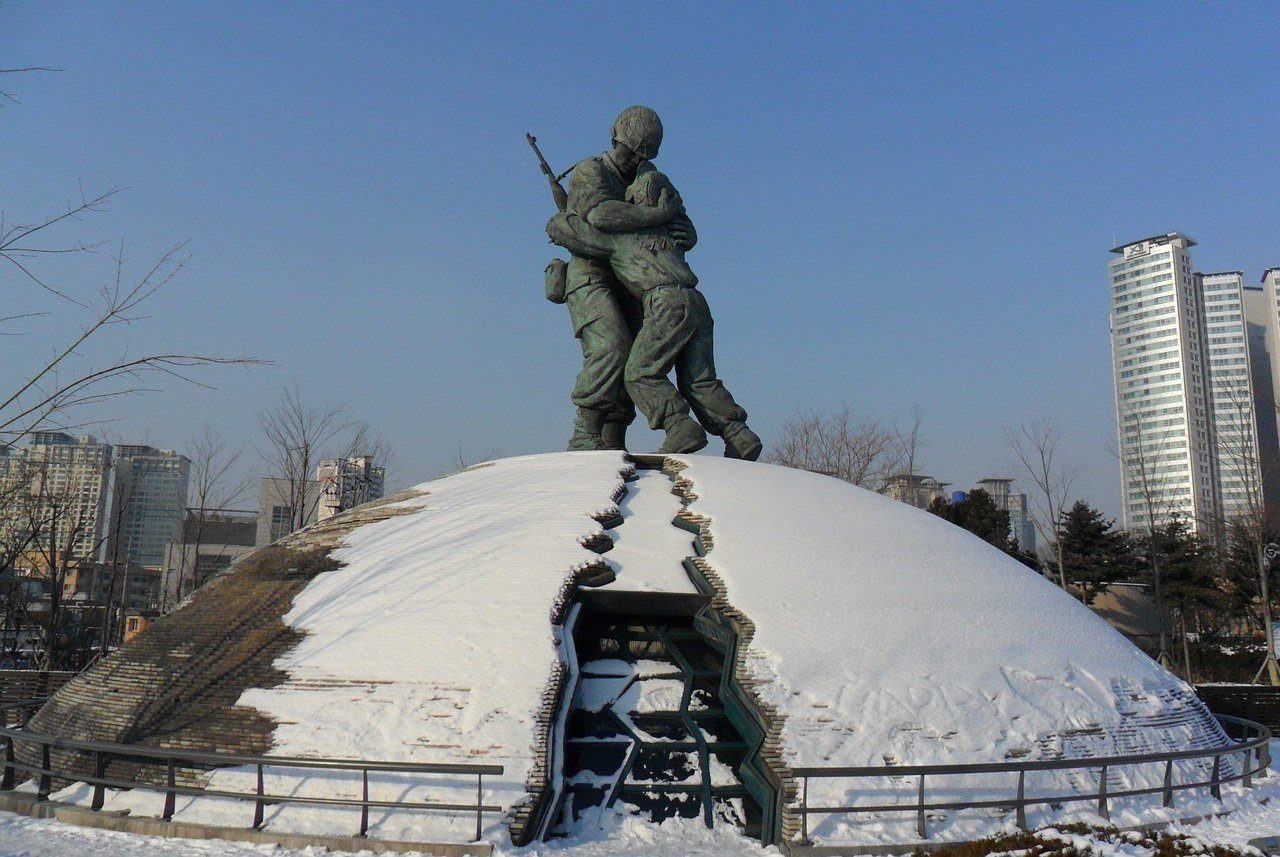
- A strangely lighthearted look at Korean military history.
- Fun and educational, so it’s a great place to take the kids.
Why it’s so awesome: There are 6 exhibition halls and an outdoor space for war machines too big to fit inside at this site and the place is packed. In fact, there are over 13,000 pieces of military equipment and memorabilia at the Korean war memorial , (for the war fought between North and South Korea) placed on the grounds of the former army headquarters of Korea.
The focus is on the Korean and Vietnam war but this isn’t the type of museum where you just stand back and look. The displays are designed to be touched and felt, to give visitors a better idea of what the wars were really like.
What to do there: There’s a lot to see at this memorial so make sure you put aside a few hours. The Combat Experience Room is particularly interesting and uses audiovisual effects to surround you with the sounds, sights and smells of the battlefield. Outback, the lines of tanks and heavy artillery are laid out like a metal petting zoo, and if you’re interested in this type of machinery, you’ll have an amazing time exploring it all.
#24 – Jogyesa Korean Buddhist Temple – For some sacred sightseeing in Seoul.
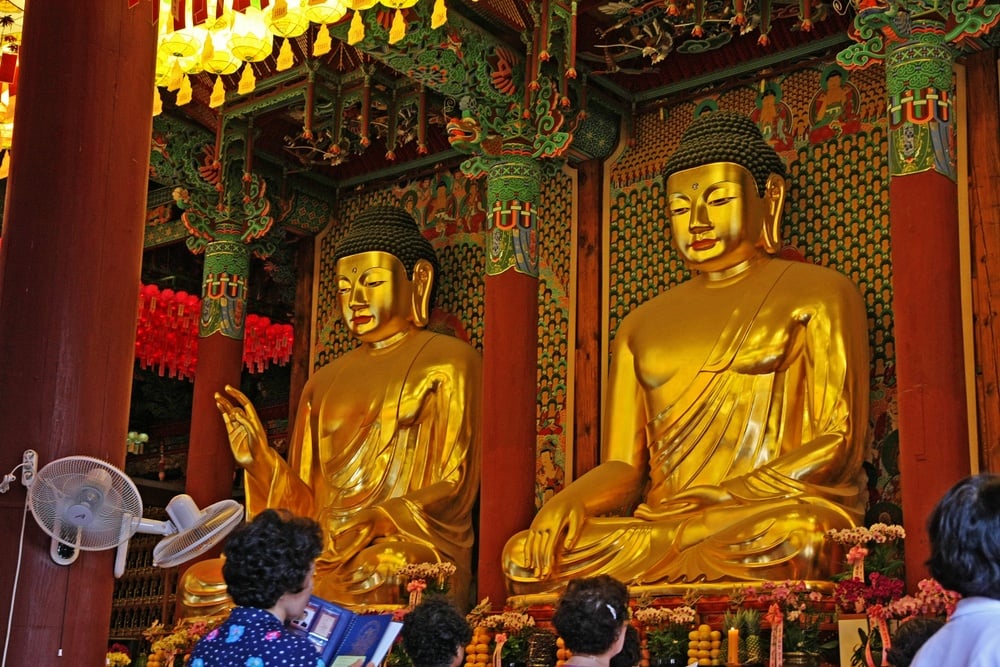
- A Buddhist temple that’s an important part of the locals’ lives.
- The garden surrounding the temple has some ancient trees that are simply amazing.
Why it’s so awesome: Sometimes there’s nothing like exploring a temple that’s still in use in the modern-day if you want to understand a culture better. And this temple in the middle of Seoul’s high-rise district is one of the best places to visit in the city to learn more about Korean Buddhism. This Zen Buddhist temple is always full of locals and tourists, which makes it an exciting, as well as an interesting place to people-watch and spend some quality time.
What to do there: Spend some time just watching the people as they come and go on their everyday business. And when you’re done, explore the compound itself. You could also find yourself a guide that will show you around and explain each statue in detail.
The trees in this area are apparently over 500 years old and they’re strung with banners and streamers in bright colors to make them look even more spectacular! This all combines to make this temple one of the top places to visit in Seoul if only for a quick contemplative meditation.
#25 – Suwon’s Hwaseong Fortress – More of Seoul’s old landmarks!
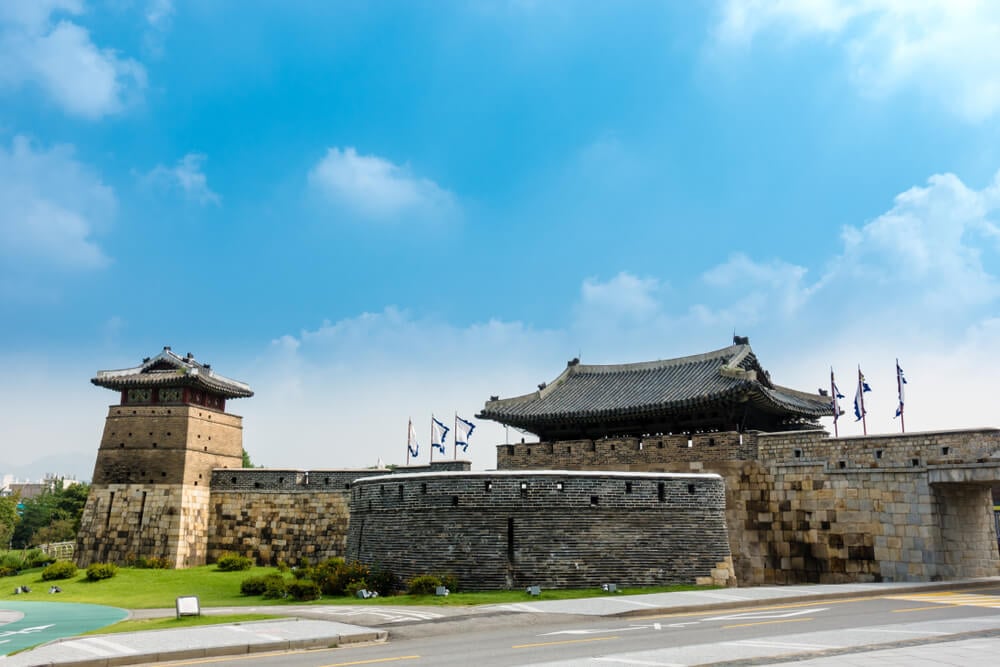
- If you’re looking for a quick day trip from the city, then make it to this UNESCO World Heritage Site.
- Located only an hour and a half from Seoul.
- One of Seoul’s most important historical sites.
Why it’s so awesome: Built between 1794 and 1796, this fortress was created to house the remains of the King’s father, who had been murdered by his own father. It’s an enormous complex that was meant to be the first step in moving the capital from Seoul to the city of Suwon, where the Fortress is located. This obviously never eventuated, but the fortress remains and was declared a UNESCO site in 1997 .
What to do there: It will take you a couple of hours to see the entire castle, so if you have a spare morning or afternoon while you’re in Seoul then make the trip out to see it. There are a lot of different features including the interior and exterior as well as a palace museum, so make sure you take enough time to see it all.
#26 – Seoul’s Children’s Park – A beautiful place to go outdoors in Seoul.
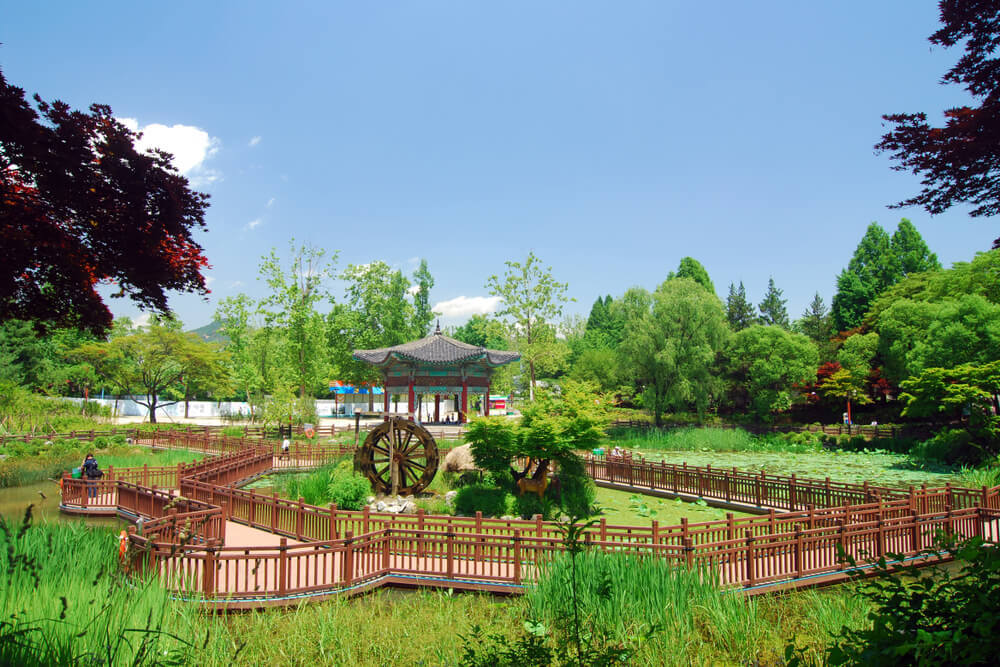
- A great place to take the kids.
- Even if you don’t have children, you’ll enjoy this massive green area in the central Seoul.
Why it’s so awesome: If you’re tired of the skyscrapers and find yourself longing for some greenery, then you can find this park in the middle of the city. Not only does it include a lot of green, open areas, there are also some cool exhibits and attractions in the park that will interest everyone, not just the young.
What to do there: Escape from the city and spend some time in nature. This park also includes amusement rides and playgrounds as well, so if you feel like being a little more active then there are lots of things to try!
#27 – A Lotte Mart – A weird choice of things to see in Seoul but hear me out!
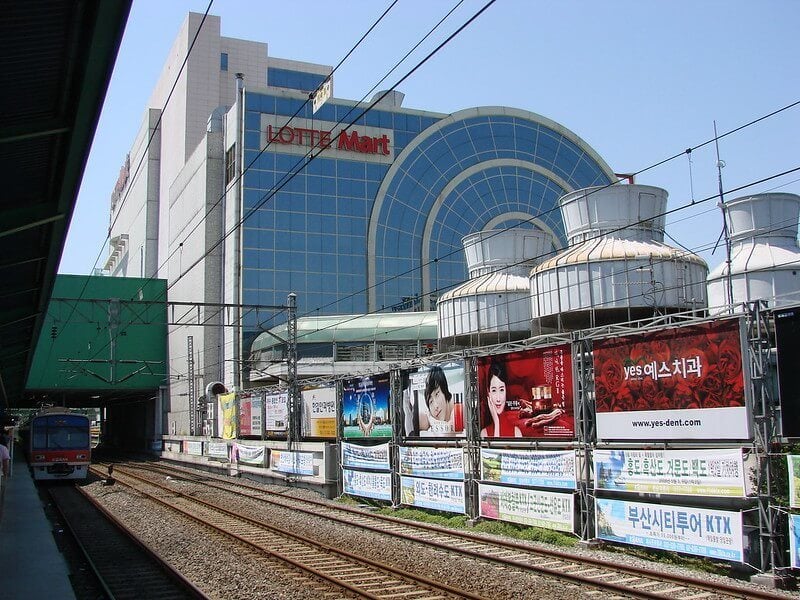
- Lotte Marts in Seoul aren’t like the ones back home, so make sure you stop by for a look and a snack, you’ll be surprised what you’ll find there.
- If you love snacking but want to save some money, you can eat like the locals do with some very unusual meals and snacks from this store.
Why it’s so awesome: It sounds a bit strange to suggest that you go to a supermarket, but this is one experience you really shouldn’t miss because these stores are one of the most famous places in Seoul.
Lotte Marts are iconic in the city and they’re one of the coolest grocery stores in the world. While wandering around you’ll get a much better idea of how important food is in Seoul. And you might also find some new treats to try too!
What to do there: Make sure you take part in the whole experience. Lotte Marts usually have free food samples as well as an incredibly wide range of foods that you’ve probably never seen anywhere else. Just watch your wallet, because it’s too easy to overspend in Lotte Mart, and buy something tasty.
#28 – The Jongmyo Shrine – Another cultural highlight of Seoul.
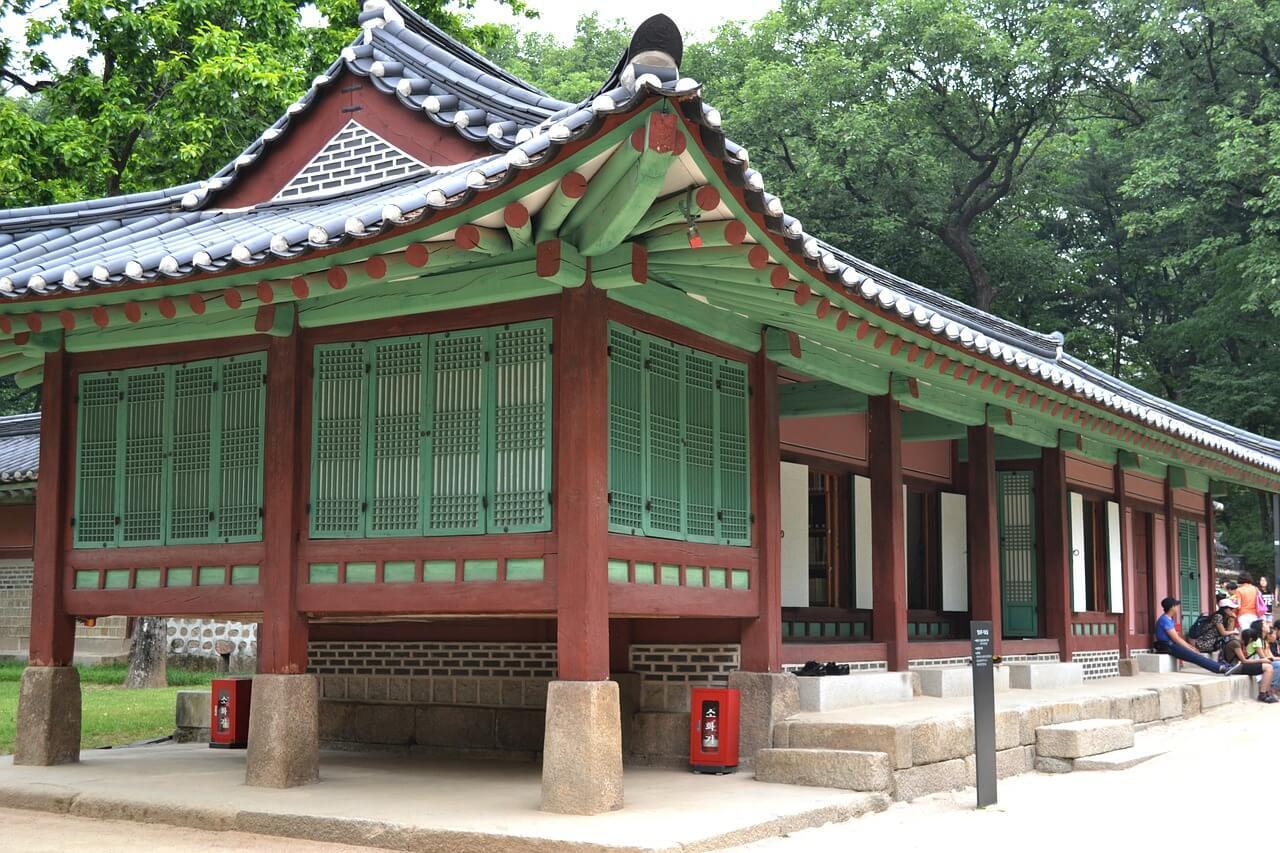
- A UNESCO-listed site and close by the popular suburb or Insadong.
- A Seoul must-see when you’re in the city.
Why it’s so awesome: This is one of the most popular landmarks in Seoul and it’s also one of the best ways to learn about its ancient traditions. This shrine is the most popular attraction in Seoul and it’s a UNESCO Heritage site; the perfect way for you to learn more about the history of the city.
What to do there: If you go to the shrine on Saturday then you can explore on your own. Any other day except Tuesday when the shrine is closed, you will need to join a guided tour. There are tours in English every couple of hours. While you’re there, make sure that you pay attention. You’ll learn about ancient customs, music, and even about memorial services during your visit, so it’s worth paying attention.
#29 – National Museum of Modern and Contemporary Art – More awesome Korean art!
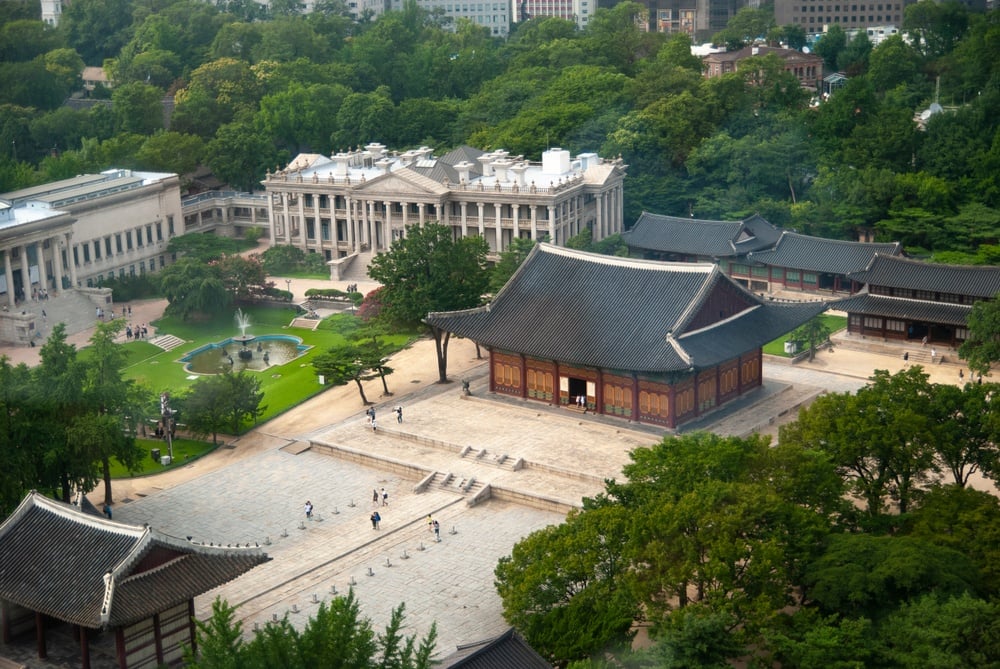
- The National Museum of Modern and Contemporary Art in Seoul is an amazing traditional style building.
- Located on what used to be Seoul’s Defense Security Command.
Why it’s so awesome: This museum is a must-visit on your Seoul itinerary. It’s an enormous museum that’s built on the principles of madang , which encourages people to socialize together by providing a large, communal courtyard just for that purpose. And it works too, which makes it a great place for people watching.
What to do there: The exhibits at this museum change regularly, so find out what’s on while you’re in the city and don’t miss out. Also, spend some time exploring the building while you’re there. Korean architecture is unique and deserves some time and attention.
#30 – Socheon – A nice non-touristy place to visit in Seoul
- If you’re looking for the best food in the city then you need to go to Socheon, which is where the locals go.
- You’ll have some of your best meals in a slightly dingy restaurant in this part of the city.
Why it’s so awesome: Socheon is one of the best places in Seoul for cheap and delicious local food and a good break from the tourist attractions. Located on the west side of Gyeongbokgung, this area caters mostly to locals, so you won’t find as many fancy restaurants and neon lights there. Instead, you’ll find mostly ordinary, slightly run-down restaurants that serve some of the best food you’ve ever tasted.
What to do there: Some restaurants serve great food in this area but they’re a little hard to find. Most of them don’t have a website or even a menu in English, so you’ll have to order your meal from pictures or by what the locals are eating. To get a great meal, walk until you find a place that contains a lot of locals. Figure out what you want and just point – whatever you get, it’ll be delicious!
#31 – Dongdaemun – An awesome neighborhood in Seoul.
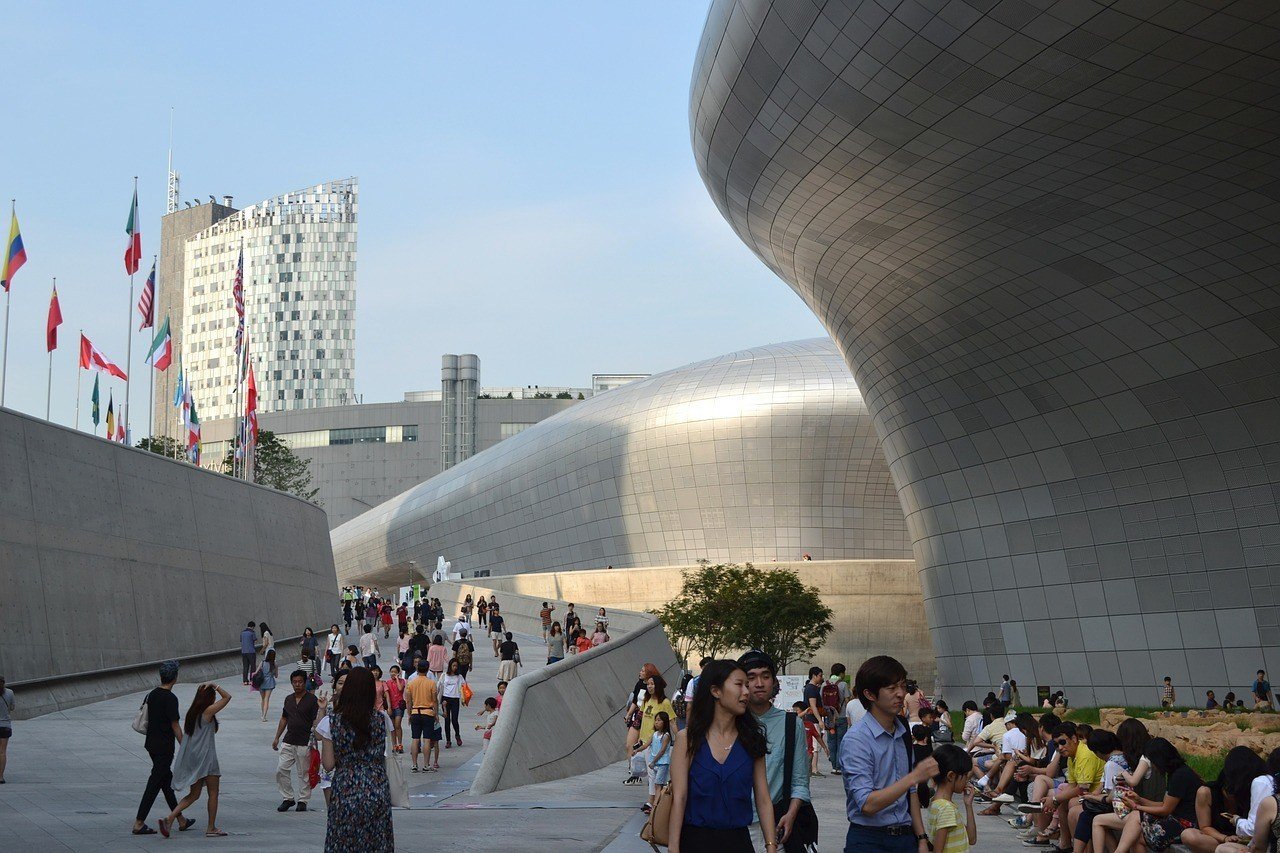
- One of the best places in Seoul for bargain shopping!
- Bring cash so you can haggle down the prices.
Why it’s so awesome: Dongdaemun shopping area is a veritable labyrinth of wholesale and retail shops. You could quite literally get lost in this area looking for something, and the crowds of locals and tourists alike enjoying the bargains are evidence of how good the prices and the variety of goods are.
What to do there: If you’re looking for something specific to buy, chances are that you’ll find it in this area. Take cash with you so you can haggle and find something sweet. But if you just want to wander and people watch, this is the perfect place for it too. Many of the shops are open all night, so there’s always something going on for you to observe.
#32 – Dongdaemun Design Plaza – A famous modern landmark in Seoul.
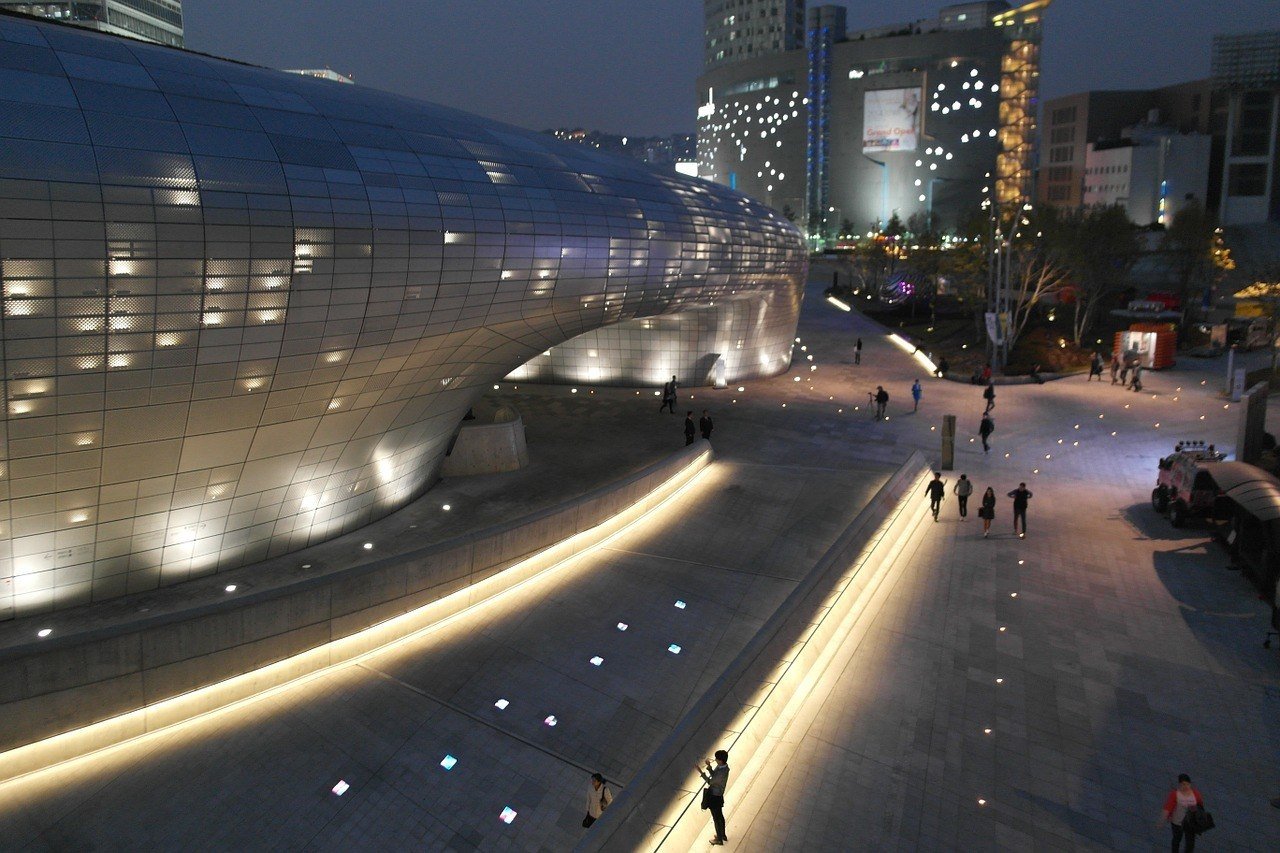
- One of the hotspots in Seoul for shopping and entertainment options.
- The building itself is unusual, stunning, and looks great in photos.
Why it’s so awesome: This building is one of the most eccentric in the city and looks amazing in photographs for you to put on your social media feeds. The long, sinuous curves of the building seem to go on forever and as if that wasn’t enough it also contains countless stores, exhibition spaces, parts of the original Seoul fortress that used to stand on the site, and a design museum.
What to do there: Make sure you take a photo of yourself with this building to show the people back home because the curving lines back for a great background. And then just explore the building. You can shop, explore the history of the site, or just wander the floors looking for anything that looks like fun. It’s the perfect place to go for anyone who’s looking for Seoul vacation ideas.
#33 – Mapo-Gu – A quirky area in Seoul to visit.
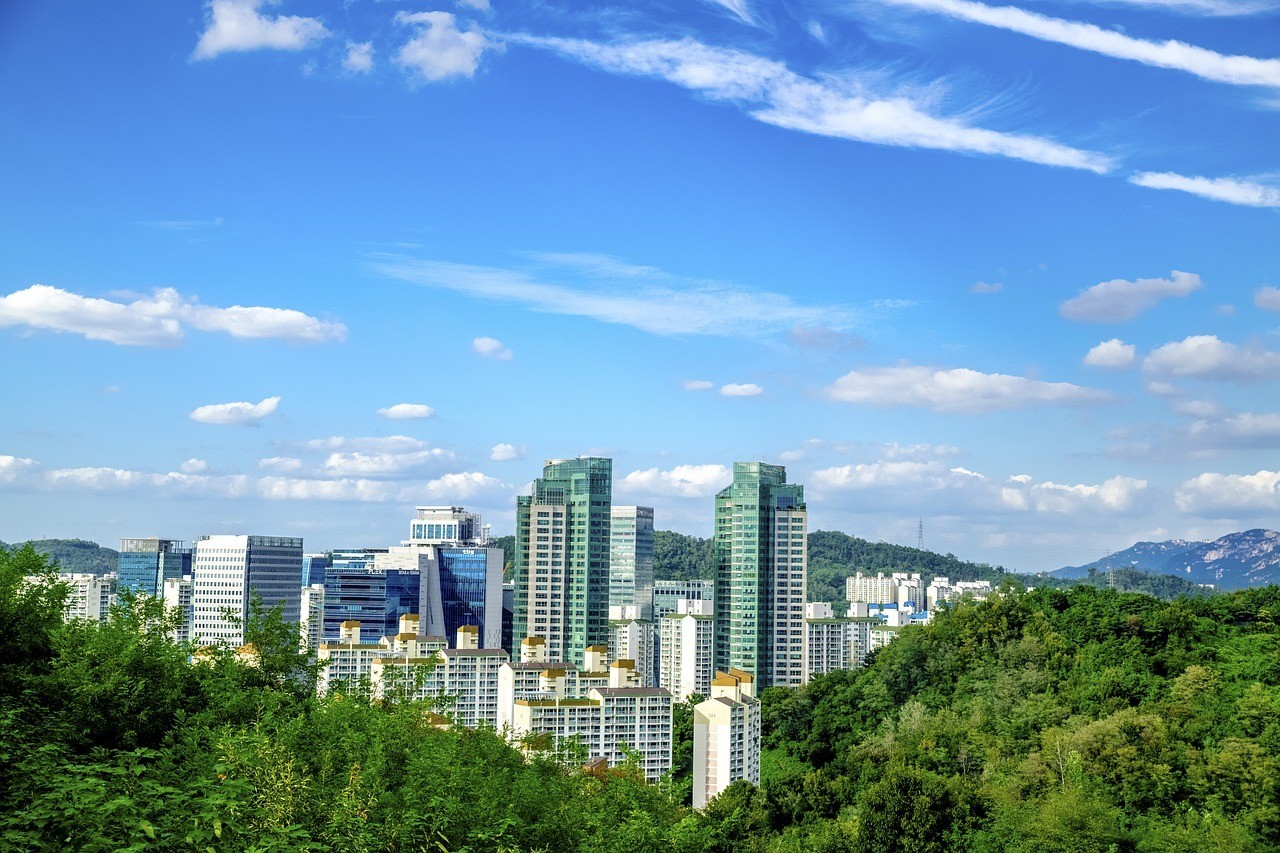
- One of the quirkiest places to go in Seoul.
- If you’re looking for weird and wonderful experiences and cafes, this district will exceed your wildest expectations.
Why it’s so awesome: Mapo district is one of Seoul’s 25 districts and it’s also one of the most unusual. It’s home to a large number of themed cafes, so if you want your cup of coffee with a side of cats, dogs or raccoons, you’ll find all that and more in this district.
What to do there: Korea is constantly innovating and looking for new ways to explore old ideas and you can experience that first hand while you’re in Mapo-Gu. Try the poop café if you’re looking for one of the most unusual places in Seoul, or just wander from one café to another hugging cute animals!
#34 – Nami Island
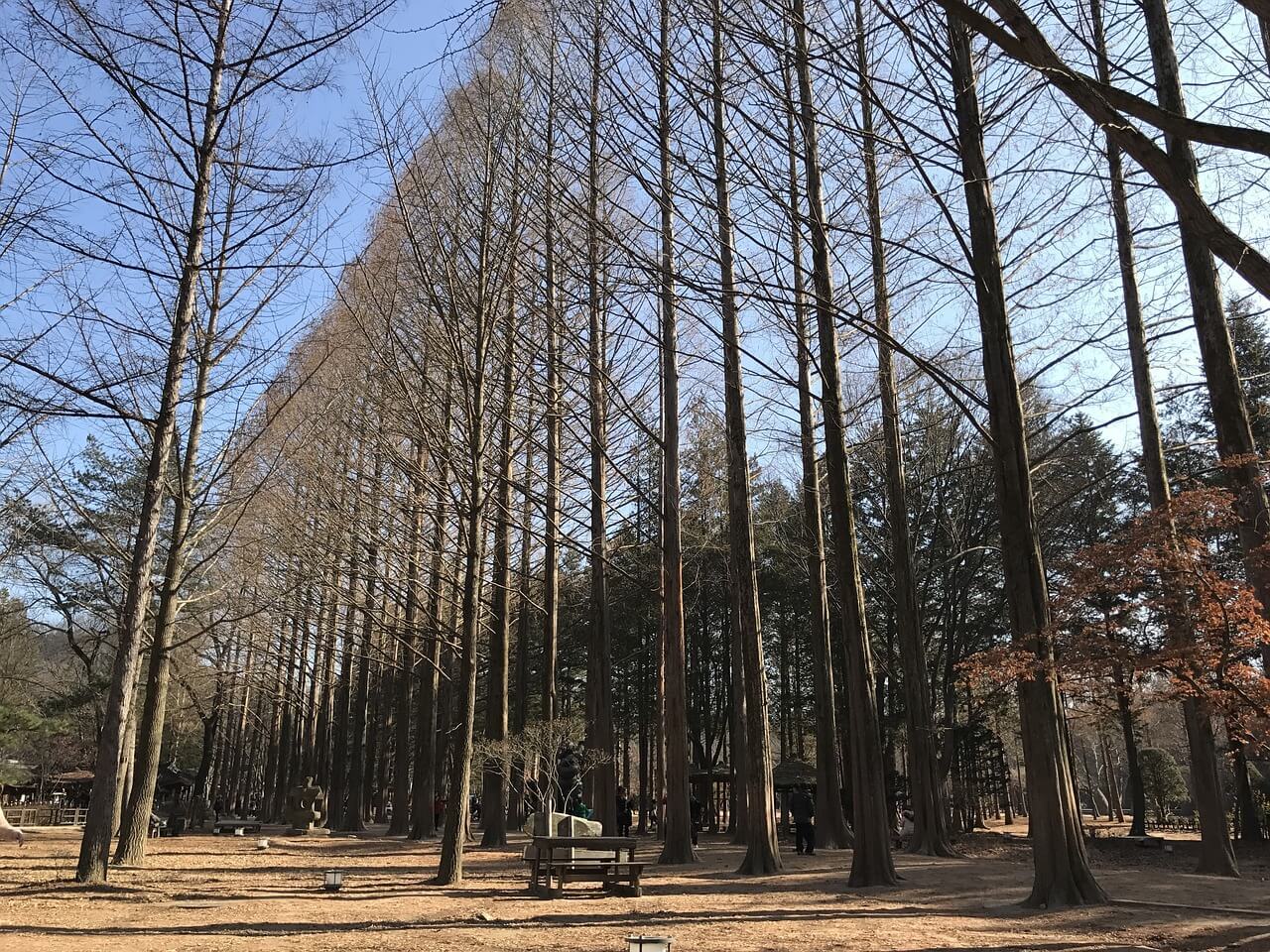
- One of the most popular spots for a holiday break in Seoul.
- It’s usually thronged with tourists so show up early if you want to avoid the lines.
Why it’s so awesome: Nami Island is a lovely nature area close to the city that’s a fantastic place to visit in the winter and summer months. In summer it has rides, zip wires, hiking, and lots of large open spaces to explore. And in the winter, it’s set up for all the winter sports and activities that you’ve ever dreamed of trying.
What to do there: Nami Island is an awesome place to visit in winter as the lake freezes and gives you an amazing view across the lake. It’s also home to a lot of winter sports and activities, which is why tourists and locals alike travel there in throngs to enjoy the colder months. Also, if you like to read, make sure you visit Petite France, which is a village modeled after the famous book The Little Prince.
Get insured for your trip to Seoul!
When you’re travelling to Seoul, having good travel insurance is an absolute essential BEFORE you set off.
ALWAYS sort out your backpacker insurance before your trip. There’s plenty to choose from in that department, but a good place to start is Safety Wing .
They offer month-to-month payments, no lock-in contracts, and require absolutely no itineraries: that’s the exact kind of insurance long-term travellers and digital nomads need.

SafetyWing is cheap, easy, and admin-free: just sign up lickety-split so you can get back to it!
Click the button below to learn more about SafetyWing’s setup or read our insider review for the full tasty scoop.
Find out what people want to know about the where to go in Seoul South Ko.
Is 3 days in Seoul enough?
Three days should be enough to see the main highlights, but there are some gorgeous hikes around the city that are worth staying longer to see.
Is Seoul a safe place to visit?
Yes, Seoul is a safe place to visit and violent crimes are rare.
Is Seoul a cheap place to visit?
No, Seoul isn’t a cheap place to visit, though there are some cheap attractions that will help keep costs down.
What is a free place to visit in Seoul?
The Seoul Museum of Art is a free place to visit in Seoul and a great place for art lovers to explore.
Seoul is a city that never sleeps, with ancient palaces next to skyscrapers and night markets, and it’s the perfect location for anyone looking to experience a different side of Asia.
I know we got into a lot of places to visit in Seoul, but in case you need a few more recs, check out: Itaewon Antique Furniture Street, Seoul Sky, the Seoul City Wall, and of course every foodie establishment of Korean cuisine you can imagine.
And if you use this easy guide to where to go in Seoul, South Korea to visit the most sobering historical sights, you’ll walk away with memories that last a lifetime.
- Devise your ultimate itinerary for Seoul with our in-depth guide.
- Check out our Seoul hostel guide for a vibing place to stay.
- If you’re feeling like splurging, check these epic Airbnbs in Seoul .
- Our ultimate Backpacking in South Korea guide is an essential read before you travel.
- Don’t forget the essentials with our in-depth backpacking packing list .
- Plan an entire Southeast Asia backpacking adventure with our mega-guide!
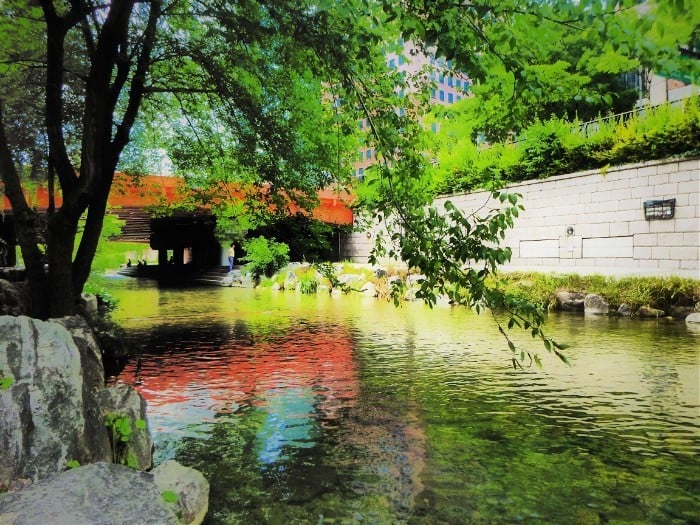
Buy Us a Coffee !
A couple of you lovely readers suggested we set up a tip jar for direct support as an alternative to booking through our links. So we created one!
You can now buy The Broke Backpacker a coffee . If you like and use our content to plan your trips, it’s a much appreciated way to show appreciation 🙂

Share or save this post

Nice list. I am going next week there and this abandoned theme park look like something I will visit
Thanks for the info. Suggestions like “Mapo-Gu” are a bit ridiculous, if you pull it up on google maps that region could take a week or more of 6 hour days walking. I doubt anywhere but a small part of it is of interest, but where? Who knows. Same seems to be the case for Socheon which I don’t know how to pull up. We need like a center point or at least main strip indication please.
Hi Justin. It’s 33 minutes by bus to Mapo-Gu although I suppose you can walk there if you want. We have included this area for it’s general vibe and invite our readers to explore it on their own terms.
Hmm. Sorry what I mean is Mapo-Gu (in English Mapo District) is nearly half the size of Manhattan. Do you get what I mean when I say it wouldn’t make sense to tell someone “you can walk to Manhattan if you want, but once you are there you can experience the vibe and find everything?”
I also explored these fabulous attractions during my last tour and came back with an awesome experience.
Leave a Reply Cancel reply
Your email address will not be published. Required fields are marked *
Save my name, email, and website in this browser for the next time I comment.
Notify me of followup comments via e-mail.

Home » Travel Guides » South Korea » 55 Best Things to Do in Seoul (South Korea)
55 Best Things to Do in Seoul (South Korea)
Close to half the population of South Korea lives in the Seoul Capital Area, the world’s fifth largest conurbation.
Its centre of gravity is a pulsating city cleaved by the Han River and with a skyline punctuated by mountains.
Seoul has burgeoned since the middle of the 20th century and new projects continue to crop up by the year, like the 555-metre Lotte World Tower in 2017 and Zaha Hadid’s sensational Dongdaemun Design Plaza.
But the city has safeguarded its history, even in the face of invasions from Japan.
Set a course for Joseon Dynasty palaces, Buddhist temples and quarters like Bukchon, where there’s a warren of hanoks, which are traditional wooden houses with curled eaves.
And to really feel like Seoulite, dine at an authentic Korean BBQ joint or verse yourself in the city’s street food culture at its frenzied markets.
Let’s explore the best things to do in Seoul :
1. Gyeongbokgung Palace

The first royal palace of the Joseon Dynasty was constructed in 1395 and stood at the heart of the capital, then known as Hanyang.
Gyeongbokgung Palace is the largest of Five Grand Palaces of Seoul and comprises hundreds of edifices.
It was invested with huge symbolism, which has led to its destruction twice by the Japanese, during the Japanese invasions of Korea (1592–1598) and then the occupation of Korea in the 20th century.
The palace is going through a painstaking 40-year restoration project, begun in 1989. Two spectacular elements, the Gyeonghoeru Pavilion and Hyangwonjeong Pond, have come through all this turbulence relatively unscathed, and need to be seen along with the Geunjeongjeon (Throne Hall) Gangnyeongjeon (King’s Quarters), Gyotaejeon (Queen’s Quarters) and Jibokjae, the library of King Gojong (1852-1919). At Gwanghwamun, the main gate to the south of palace complex, you can watch the solemn changing of the guard ceremony at the top of every hour between 10:00 and 15:00. The Folk Museum of Korea and the National Palace Museum are both set on the palace’s massive grounds.
2. N Seoul Tower

When it went up at the turn of the 1970s the N Seoul Tower was South Korea’s first general broadcast tower.
This Space Age building is at the summit of the 243-metre Namsan Mountain, and standing at more than 236 metres, the top of the tower is close to 480 metres above sea level.
There are gift shops and eateries on the plaza below, where young couples show their love by locking padlocks onto the railings at the foot of the tower.
High above the plaza are four floors, with a restaurant (T1), wishing pond, observatory, cafe and photo studio (T2), a “digital observatory” with powerful digital telescopes and 32 LED screens detailing Korea’s history (T3) and a revolving French restaurant making a turn every 48 minutes on T5 (most buildings don’t have fourth floors in Korea as the number is considered unlucky). Make sure to come at night to behold a city of 10 million people in a sea of twinkling lights.
3. Changdeokgung Palace

East of Gyeongbokgung is Changdeokgung Palace (Palace of Prospering Virtue), built a little later, at the start of the 15th century.
The best preserved of Seoul’s surviving Joseon palaces, this was established by King Taejong, fifth son of the first King of the Joseon Dynasty, Taejo.
In the Strife of Princes of the late-1390s, Taejong (then known as Yi Bangwon) killed all of his half-brothers and pretenders to the throne and switched the location of the royal palace for political purposes.
Changdeokgung is the longest-serving royal palace and is less formalist in its layout than Gyeongbokgung, blending instead with its natural environment.
The royal area is set within many layers of governmental offices and buildings for functionaries, to protect this inner sanctum in case of a break in.
Some of the outstanding things to see on a tour are the Throne Hall (Injeongjeon), a National Treasure from 1405 and rebuilt in 1610, Geumcheongyo, the oldest surviving bridge in Seoul, dating to 1411 and Donhwamun, a gate raised in 1412 and also rebuilt in the 17th century.
Huwon, the palace’s private garden is unmissable and we’ll cover it later.
4. National Museum of Korea

The largest museum in the country, and among the largest in Asia, the National Museum of Korea is on three floors enriched with hundreds of thousands of artefacts beginning in prehistory.
There’s invaluable calligraphy, celadon and buncheong ceramics, sculpture and painting, in such quantity that you could never see it all in a single day.
If time is of the essence then there are a few obligatory stops for Korean National Treasures.
The star has to be the Gilt-bronze Maitreya in Meditation (No. 83), a Silla-era treasure from the beginning of the 7th century, with one leg over the other, and a hand drawn to the chin as if in deep contemplation.
Also from the Silla kingdom is the 5th-century Gold Crown (No. 191) recovered from the tomb of Hwangnamdaechong in Gyeongju.
A monumental piece is the 14th-century Gyeongcheonsa Pagoda, ten storeys high and displayed in one of the main halls, while in the Calligraphy and Painting Gallery on the second floor is the Album of Genre Painting by the 18th-century master Donwon.
The museum’s outdoor space is lovely in good weather, scattered with pagodas, gardens of indigenous plants, lanterns, steles, waterfalls and pools.
5. Namsan Park

N Seoul Tower’s mountain roost has much more to hold your attention, whether it’s the scenic trails, fragments of Seoul’s 14th-century walls, the underground Maritime Aquarium, the cable car (from Hoehyeon-dong) or a small village of traditional houses, which we’ll cover in more detail below.
In the reign of Taejo, the first Joseon king at the turn of the 15th century, Namsan Mountain was regarded as a sacred shamanistic site, and its role in the defence of Seoul extended to a smoke beacon, Mongmyeoksan Bongsudae, with five chimneys sending signals to the city from this elevated overlook.
Near the foot of the tower on the beacon mound there’s another stirring view to be had from Namsan Palgakjeong, a dainty octagonal pavilion.
6. Lotte World

At this huge complex in Sincheon-dong is the largest indoor amusement park in the world, linked by monorail to an outdoor amusement park on a man-made island, and all accompanied by a luxury hotel, malls, cinemas, an ice rink and a folk museum charting 5,000 years of Korean history.
The epic indoor park is on four floors under a glass dome, with spaces devoted to a different part of the world (for instance, European-style village, Arabian courtyard, Jungle). There are 22 rides in all, complemented by constant parades, shows and seasonal festivals.
That folk museum is a must-see and can be found at Adventure 3F, while the French Revolution2 VR became the first Korean roller-coaster to use virtual reality technology when it opened after a revamp in 2017. In good weather you can cross the bridge to Magic Island, commanded by a Disney-style fairytale castle and offering rides like the Atlantis Adventure steel roller-coaster and Gyro Drop, an adrenaline-pumping drop ride also using VR.
7. Bukhansan National Park

One of South Korea’s 22 national parks is within the Seoul metropolitan area and a no-brainer for hiking trips.
Encompassing a little over 30 square miles Bukhansan National Park contains granite peaks (three at 800 metres or more), the 300-year-old Bukhansanseong Fortress, more than 100 temples, gorges and deep woodland.
It’s a breeze by subway, at just 25 minutes from Seoul Station: Get off at Gireum Station at the very south of the park and you’ll be on the light Bogukmun Course, a 2.4-kilometre trail that snakes past oaks, waterfalls, crystalline streams and a gorge.
The highest peak, Baegundae (836.5m) can be scaled on the Bukhansanseong Course, a tough hike to the bare granite peak but the panoramas are amazing if you catch a clear day.
The 120-room Bukhansanseong Fortress posted on the ridgeline leading to Baegundae, was a retreat for Joseon kings in times of emergency, encircled by eight kilometres of walls up to seven metres high.
The fortress is free to visit and is stunning in autumn when the leaves change.
8. Dongdaemun Design Plaza (DDP)

Almost defying description, DDP is a spellbinding urban landmark made up of curving, elongated structures that resemble giant blobs of liquid metal, all designed by Zaha Hadid.
This is a cultural hub, futuristic shopping space and linchpin for Dongdaemun, Korea’s largest fashion district, integrated with the Seoul Metro System and with a walkable park on its roof.
A springboard for South Korea’s creative industries, the DDP holds design-oriented exhibitions, forums, K-Pop concerts, fashion shows and conferences, and includes an Art Hall, Museum Hall, Design Market, Design Lab and the Dongdaemun History and Culture Park.
This last portion is set outside and chronicles the history of this plot of land as a military training ground in the Joseon Dynasty, and preserves the remnants of hanoks (traditional Korean houses) and the foundations of Seoul’s Fortress Wall.
Come back at night to see the DDP in lights, and visit the gorgeous LED rose garden.
9. National Folk Museum of Korea

The museum on the Gyeongbokgung Palace grounds deals with three main topics: The history of the Korean people up to the end of the Joseon Dynasty in 1910, village life before modern times, and Korean culture’s ancient links with Confucianism, and how the ideology gave rise to customs that persist today.
There’s a hall for each of these three themes, filled with more than 100,000 artefacts.
You’ll find pits to make kimchi pots, rice storage shelters, musical instruments, and objects related to worship, like spirit posts and cairns.
The building is also noteworthy, in a traditional Korean style on several storeys crested with a pagoda.
The museum arranges guided tours by reservation, and has a programme of short-term exhibitions, seminars, workshops, concerts and performance art.
10. War Memorial of Korea

With indoor and outdoor exhibition spaces, the War Memorial of Korea commemorates the Korean War (1950-1953) from a South Korean perspective and documents the broader military history of Korea.
This was set up in Yongsan-gu in the early 90s at the site of a former military base.
There are some 10,000 artefacts on show, both inside and outside, from a collection of more than 30,000. The six halls inside are the Expeditionary Forces Room, War History Room, Development Hall, Patriotic Memorial Room , 6·25 Korean War Room and Large Machinery Room.
You’ll see weapons and equipment going back to prehistory, aircraft, battlefield paintings and memorials to figures like the Korean independence activist An Jung-geun, who in 1909 assassinated Prince Itō Hirobumi, then President of the Privy Council of Japan.
The lawns around the museum building are reserved for a big line-up of heavy machinery like jets, helicopters, tanks, artillery and missiles.
11. Lotte World Tower

Over the course of the 2010s the fifth-tallest building in the world has sprung up over Lotte World in Songpa-gu.
The tower’s outline is inspired by traditional Korean ceramics and calligraphy brushes, and rises to 555 metres.
This edifice, holding offices, luxury residences and a hotel (floors 76-101), is part of the Lotte World Mall complex brimming with fashion emporia and boasting the largest duty free store in Korea.
There’s also an aquarium here, the largest multiplex cinema in Asia and a concert hall.
Floors 117-123 of the Lotte World Tower belong to Seoul Sky, where you’ll find a lounge bar, cafes and a “Photozone”. At 117 is the head-spinning View Floor, the world’s highest glass floor observatory when the tower was completed in 2017.
12. Seoul Arts Center

Korea’s national performing arts centre is on a sprawling complex in Seocho-gu, and built in time for the Seoul Olympic, hosting performances during the event.
The Seoul Arts Center is the home of respected national ensembles and companies like the Korea National Opera, the Korea National Ballet and the Korean Symphony Orchestra.
If you think the opera house looks like something you’d wear on your head you’re not mistaken, as it was designed to evoke the gat, a traditional Korean bamboo hat.
There are two more auditoriums including this, as well as the Seoul Calligraphy Art Museum, the Hangaram Art Museum, an amphitheatre and the Hangaram Design Museum.
The complex has lots of outdoor space at a Umyeonji (Korean Pond) and Jangteo (Market), which also stages performances in summer.
Come for large-scale opera, Broadway-style musicals, choral performances and recitals, as well as landmark exhibitions at the Hangaram Art Museum.
Cubist artists and the work of Frida Kahlo have appeared in recent years.
And even if you’re just passing through, the complex’s architecture deserves a second glance.
13. Hangang Park

The Seoul streets can get hectic, but whenever the city gets too much you can escape to the banks of the Han River, where’s there’s a continuous chain of parks (12 in total) on both banks, with riverside trails, sports facilities, boat piers and outdoor swimming pools.
This space was opened up in the years before the Olympics, and the best views can be had from the parks on the south bank.
You can rent a bike of course, but a wide choice of water activities is available in summer at Ttukseom Hangang Park, Yeouido Hangang Park and Jamwon Hangang Park, like gentle rowing trips, kayaking and even waterskiing and windsurfing.
As of 2019 Hangang Park is due to be regenerated in a project that will run to 2030 and turn the parks into culture and leisure hotspots mingling with riverside neighbourhoods.
14. Dongdaemun Market

It’s hard to comprehend the size of this commercial district around Heunginjimun, the east gate on Seoul Fortress’s outer wall.
Jostling for space in Dongdaemun Market are 26 malls, more than 30,000 speciality shops and 50,000 manufacturers.
You could visit for an hour or two and leave before it gets too much, but hardened, fashion-forward shoppers could easily pass a whole day hunting for bargains, as many of the outlets are oriented towards the youth market.
Meokja Golmok, Dongdaemun Market’s food alley, is the real deal for food-lovers and a crash course in Korean cuisine.
Fronted by little benches are stalls for mandu (dumplings), gimbap, (Korean sushi rolls), bibimbap (mixed rice dishes), tteokbokki (spicy rice cakes), dak hanmari (whole chicken soup), Dakgangjeong (sticky, crispy fried chicken), kalmandu (broth with noodles) and naengmyeon (North Korean noodles served cold, often with kimchi).
15. Hongdae

It’s no accident that the Hongdae area has turned out to be super trendy.
This spot is right in front of Hongik University, known for its art school, and in the 80s and 90s young graduates set up their studios in what was then an affordable part of the city.
Hongdae has moved on from that first wave, but has kept hold of its creative swagger in its indie music scene, hip shops, cafes, galleries, clubs and fashionable eateries.
There’s an outdoor stage for live music, cool street art on Hongdae Mural Street and a free market every Saturday from March to November in front of the university’s main gate.
Have a go at Noraebang, Korea’s answer to karaoke, in private booths, hit the Zzang Games video arcade, try some of the delectable street food and hang out with sheep (really!) at the Thanks Nature Cafe.
16. Bukchon Hanok Village

For a picturesque walk back in time, Bukchon Hanok Village is a neighbourhood of tight alleys lined with traditional wooden houses, or hanoks.
Ten minutes north of Anguk Station, there are up to 900 of these buildings, with grey “giwa” roof tiles and eaves upturned at the corners.
The village is one of the last enclaves of this building style in Korea and was preserved thanks to efforts by locals during reconstruction in the 1960s.
In the days of the Joseon Dynasty royal families, affluent merchants and government officials resided in many of these houses, now occupied by teahouses, restaurants, specialty shops, studios, cultural centres and guesthouses.
One of the finest of the hanoks, at the top of the hill has been opened to the public as part of the Seoul Museum of History since 2015.
17. Cheonggyecheon Stream

This creek, flowing west to east for over five miles through downtown Seoul was covered in concrete for transport infrastructure during the city’s swift post-war development, known as the Miracle on the Han River.
The Cheonggyecheon Stream finally saw the light of day more than 40 years later during a $900m urban renewal project, completed in 2005, improving air quality, forming a clean natural haven for fish and birdlife and cooling the neighbourhoods beside it by up to 3.6 °C.
You can start your visit at the extraordinary Cheonggye Plaza, which has a design inspired by bojagi, traditional Korean wrapping cloth.
You can also see a model of the stream here, explaining the massive project needed to revive it, and check out plaques describing the 22 bridges that now cross the stream.
Just off the plaza, one of the stream’s most beautiful features is the Candlelight Fountain, a two-tiered waterfall marking the beginning of its course to the Hangang, and fabulous at night for its colourful illuminations.
18. Gwanghwamun Square

Leading off from the Gwanghwamun Gate, once the main gateway to Gyeongbokgung, Gwanghwamun Square is an awe-inspiring open space that was created in the 2000s where there used to be a 16-lane roadway.
Long before this had been the heart of Hanyang, the Joseon Dynasty capital.
The plaza was unveiled in 2009 and is commanded by statues of Admiral Yi Sunshin (1545-1598), a naval commander noted for his victories in the Japanese invasions of Korea (1592-1598) and the most celebrated king of the Joseon Dynasty, Sejong the Great (1397-1450). Below both figures are small underground museums explaining their importance.
The square is fringed by government buildings and has lots of interesting details to pore over like, the Yeoksamulgil (waterway of history), a sculpture of the symbol of Seoul (Haechi) and the 12.23 Fountain behind Yi Sunshin, marking the 23 battles he fought in 12 warships.
19. Namdaemun Gate

Designated the first National Treasure of South Korea, Namdaemun is the south gate of the Fortress Wall of Seoul, erected at the dawn of the Joseon Dynasty in the 14th century.
This monument is built from stone, capped with a two-tiered pagoda and was the main entrance to the city for foreign emissaries.
As with the rest of the fortress system it also helped keep Siberian tigers out, which were a real hazard until they were hunted to extinction during the Japanese occupation in the 20th century.
The pagoda fell victim to an arson attack in 2008, before which it had been the oldest wooden structure in Seoul, and was restored by 2013. The streets around Namdaemun are the scene of the oldest and largest market in Korea, with a story beginning in the early-15th century.
Namdaemun Market is wholesale, with stalls held by the manufacturers themselves, so you can compare prices for a massive variety of items like toys, hanbok attire (traditional Korean dress), stationery, fashion accessories, hiking gear, fishing equipment.
The street food is outstanding, and you’re sure to be tempted by the scent of hotteok (sweet pancakes) and tteokbokki (spicy rice cakes).
20. Insa-dong

Seoul’s antiques trade coalesces around Insa-dong, a main street intersected by chaotic twisting alleys.
Down these you’ll come across up to a hundred galleries, interspersed with cafes, traditional Korean restaurants and teahouses.
There are up to 100 galleries in Insa-dong, specialising in all aspects of Korean fine art, sculpture and ceramics.
The centre for folk art is Hakgojae Gallery, while if you want to check out up-and-coming talent see the Gana Art Gallery and Art Center.
Every Saturday from 14:00 to 22:00 and Sunday from 10:00 to 22:00 the main street becomes a pedestrian zone and a place to explore Korean culture.
You can watch street performances and parades, have your fortune told, try pajeon (green onion pancake) and traditional Korean candy, while stores set up outdoor booths to tout their wares.
21. Leeum, Samsung Museum of Art

Traditional Korean art and contemporary art by Korean and international artists is on the menu at this museum in two parts.
Museum 1, by Mario Botta is for a stupendous assortment of Korea art and antiquities, 36 of which are designated National Treasures.
There’s celadaon and buncheong ceramics, ornamental daggers from the 1300s, crowns, landscape painting and portraits, as well as Buddhist manuscripts, paintings and sculptures.
Sharing the underground lobby, an inverted cone piercing the ground, is Museum 2 designed by Jean Nouvel and with a rich permanent collection counting Yves Klein, Damien Hirst, Rothko and Andy Warhol.
The museum’s master plan is the work of Rem Koolhaas, who also designed the Samsung Child Education & Cultural Center, a space to inspire the next great artists.
22. Jogyesa Temple

An emblem and head temple for Korean Buddhism, the Jogyesa Temple is on Insa-dong, close to Gyeongbokgung.
This is also the main temple for Jogye Order, which can be traced back 1,200 years to Master Doui who brought Zen to Korea from China in the 9th century.
The temple was founded at the end of the 14th century, at the start of the Joseon Dynasty and in the Japanese colonial invasion from 1910 to 1945 became a bulwark for resistance to the suppression of Korean Buddhism.
The Daeungjeon (Main Buddha Hall) was raised in 1938 using pine from Baekdu Mountain and echoes with chanting throughout the year.
In the temple’s main courtyard grow two trees, a white pine and a Chinese scholar tree (Japanese pagoda tree), that are 500 years old.
The temple is free to visit year round, and is one of two anchors, along with Bongeunsa, for Buddha’s Birthday, normally in late-April or May.
At a daily templestay you can sample the traditions of Jogye Order, learning temple etiquette, making a mandala, attending a tea ceremony and taking part in Zen meditation.
23. Namsangol Hanok Village

For anyone enchanted by Bukchon Hanok Village there’s another beautiful ensemble of traditional buildings on the north slope of Namsan Mountain.
Namsangol Hanok Village is smaller, with five Joseon-Dynasty hanoks relocated from other parts of the city and established here in 1998. What’s interesting is that the houses’ give an insight into the lifestyle of people from different social ranks, be they middle class, government officials, noblemen or aristocrats.
These residences belonged to some important people, like the parents of Queen Yun, consort to King Sunjong, the Joeon Dynasty’s 27th King, and Lee Seungeop who oversaw the construction of Gyeongbokgung Palace.
The houses are accompanied by a pavilion, performing arts stage, traditional garden and a plaza where a time capsule is buried to be dug up in 2394.
24. Bongeunsa

This Buddhist temple on the slope of Mount Sudo dates back to the end of the 8th century during the days of the Silla Kingdom.
Buddhism was suppressed during the Joseon Dynasty, and the temple was pulled down.
The ban was lifted by Queen Munjeong (1501-1565) and Bongeunsa became the main temple for the Zen sect from 1551 right through to 1936. This temple holds thousands of Buddhist scriptures, among them the works of the 19th-century scholar Gim Jeong-hui.
Those who want to immerse themselves in Korean Buddhist culture there’s a templestay programme where you can experience and take part in rituals like the dawn service, Korean Zen meditation, a tea ceremony and a traditional Buddhist meal, balwoogongyang.
On every September 9th of the Lunar Calendar a ceremony takes place here called Jeongdaebulsa, in which monks carry scriptures on their heads and recite Buddhist rites.
25. Seoul Grand Park

In the upland environment around Cheonggyesan Mountain, south of Seoul via Line 4 of the Seoul Metro there’s a humungous park complex with a variety of attractions.
Seoul Grand Park boasts the largest zoo and botanical garden in Korea, along with the amusement park Seoul Land, which we’ll talk about later in this list.
The Seoul Grand Park zoo was moved to this spot in 1984 is the tenth largest zoological park in the world, keeping nearly 3,000 animals from 350 worldwide species, among them Asiatic black bears, Siberian tigers, rhinoceroses and lions.
At the foot of Cheonggyesan Mountain is the Botanical Garden, with desert and tropical plants in its greenhouse, together with carnivorous plants and orchids.
And for kids, the Children’s Grand Park has its own zoo, botanical garden, amusements and rides, all in calming greenery.
26. Gwangjang Market

Korea’s first permanent market harks back to the end of the Joseon Dynasty and was founded in 1905. Gwagjang Market, a brief walk west of Dongdaemun Market, has a high reputation for its fabrics, which you’ll find at the second floor’s profusion of stores for silks, satin and linen.
These are sold directly by the producers, and even though they won’t be brand name products the quality is exceptional considering the price.
Gwangjang Maket’s food alley is a big part of the appeal, with rows upon rows of vendors hawking delicious authentic street food treats.
Make sure to try yukhoe (a kind of steak tartare), sashimi, jeon (fried pancakes), bindatteok (mung bean pancakes), bibimbap (mixed rice) and tteokbokki (those spicy rice cakes).
27. Seoul Forest

Served by Subway Line 2, the 300-acre Seoul Forest opened in 2005 on land that had once been used as a hunting forest for Joseon Dynasty kings.
Across five different public parks, Seoul Forest is planted with more than 400,000 trees, and provides clean open space for a dense city.
At the very centre is the Culture and Arts Park, around the Seoul Forest Square, and laid out with flowerbeds, play areas, a visitor centre, a skate park, outdoor stage and a restaurant.
There’s a Riverside Park on the north bank of the Han with 40 rose species, and beautiful natural areas to encounter at the Marsh Plants Garden and the Eco Forest, inhabited by several types of deer, elk, mandarin ducks and spot-billed ducks and set up with an observatory for a better view of this wildlife.
Finally, at the site of a former water treatment park is the Experiential Learning Park, which has an ecological playground, a botanical garden, a wetland flower garden and bird observatory.
28. South Korea Demilitarised Zone Half & Full Day Tour

The no-man’s land between the two Koreas is day-trip distance from Seoul and is an experience not to pass on.
A wide choice of tours is available on GetYourGuide.com , the most popular being the half-day or full-day tour, which includes pick-up from all the major central hotels.
Two and a half miles wide (1.25 on each side of the border) the Demilitarised Zone continues for 155 miles along the 38th Parallel across the Korean Peninsula and was formed at the end of the Korean War in 1953 through an agreement between the People’s Republic of China and United Nations Command.
On your visit you’ll enter the mile-long Third Tunnel, excavated in secret by the north to prepare for a possible invasion.
At the DMZ Theatre And Exhibition Hall you can learn the story of this project and its discovery in 1978 after a tip by a defector from the north.
On top of Mount Dora you can gaze through binoculars across the 38th Parallel to the north from the Dora Observatory, and visit Dorasan Station, intended to link the rail network to the north should the border open in the future.
29. Seoul Metro

The labyrinthine Seoul Metropolitan Subway system, with a whopping 22 lines and 716 stations, is a point of pride, the preferred mode of transport for Seoulites and much easier to navigate than it looks on a map.
It incorporates the wider metropolitan area, out to Incheon, and regional lines serve locations like Suwon, as far as 100 kilometres from the centre of Seoul.
Despite its size the Seoul Metro is praised as one of the most efficient in the world, with Wi-Fi and 4G/5G on cars, screen doors on platforms and an unbelievable degree of cleanliness.
The easiest way to get around with a rechargeable Tmoney or Cashbee, which you can buy at the airport on arrival.
There’s English signage, and an approaching train is heralded by a jaunty fanfare on the platform.
30. Seodaemun Prison

A monument to the Japanese colonial period from 1910 to 1945, Seodaemun Prison can be found at Seodaemun Independence Park.
The prison dates to the very end of the Joseon Dynasty and during the Japanese occupation became a place of infamy, where Korean dissidents were tortured and executed.
Among the important inmates were Kim Koo, who would later be Premier of the Provisional Government of the Republic of Korea, and Ryu Gwansun, key to the March 1st independence movement, who was killed here through torture in 1920. The prison remained a detention centre after independence, through to 1987, after which it was turned into a memorial museum, with lots of thought-provoking exhibits.
You can tour seven prison cells, watchtowers, the execution room, a hospital, a central exhibition hall, a tunnel used to transport corpses and the cell in which Ryu Gwansun died.
31. 63 Building

Easy to pick out among the skyscrapers on Yeouido Island because it’s clad with gold, the 63 Building was the tallest skyscraper outside North America (250 metres) when it was topped out in the mid-1980s.
This structure was designed as a landmark for the 1988 Seoul Olympics and is the headquarters for a handful of important financial companies, one being Korea Life Insurance.
On the lower floors are some 90 stores, an aquarium, banquet hall and convention centre.
You can head in to catch the glass-panelled elevator up to the 60th floor, the Sky Deck, which has recently been reworked as a space for art exhibitions (the highest gallery in the world) and performances like magic shows.
Linger over the views of Seoul’s mountains, the Han River and west to Incheon on the coast when the skies are clear.
32. Huwon Garden

If you have time to spare pre-book a tour of Huwon Garden when you visit Changdeokgung Palace.
In 78 acres, this is only visitable by guided tour and was plotted exclusively for the royal family and gungnyeo (female officers of the royal court). In this sumptuous space there are landscaped lawns, pavilions, a lotus pond and more than 26,000 trees from 100 different species, some more than three centuries old.
Huwon Garden is often known as Buwon (Secret Garden) as even the highest ranking officials were forbidden from entering.
A real delight is the Ongnyucheon (Jade Stream), a u-shaped water channel from the 17th century, complete with a little waterfall and a boulder inscribed with a poem.
33. Seoul Color Park (Yeouido Hangang Park)

Not to be confused with its neighbour Yeouido Park, Seoul Color Park is along the south bank of the Han River, passing under the Mapo Bridge in Yeouido.
This area is Seoul’s financial and political core, and suited office workers join the Seoulite families and tourists on these grassy banks to contemplate the city.
There’s plenty of public art here, like the impressive wave-form sculpture and benches painted in ten different colours, each charged with a certain meaning for the city of Seoul.
For instance, green stands for Namsan Mountain, dark grey represents the traditional giwa roof tiles and red symbolises the dancheong pattern that occurs in traditional architecture.
There are lots of water features at Seoul Color Park, and new installations, like the Water Light Square and Waterfalls of Light, show up by the year.
The park hosts the Yeouido Cherry Blossom Festival in spring, and given its supreme view of the Han is the best place to watch the World Fireworks Festival in the fall.
34. Jongmyo Shrine

A contrast to the splendour of the royal palaces, the UNESCO World Heritage site, Jongmyo Shrine is devoted to the performance of ancestral rites for the deceased kings and queens of the Joseon Dynasty.
The original buildings went up at the end of the 14th century but had to be reconstructed after the Japanese invasions of Korea (1592-1598). The tablets carved with the teachings of members of this former royal family are housed here, and centuries old rituals combining court music and dance continue to take place at the shrine, perpetuating a 600-year-old tradition.
The group of understated buildings here is largely unchanged since the end of the 16th century and consists of the Jeongjeon (main hall), Yeongnyeongjeon (hall of eternal peace), and a variety of auxiliary structures.
Jeongjeon is a sensational piece of architecture, and believed to be the world’s longest freestanding wooden structure at 109 metres.
35. Sejong Center for the Performing Arts

The largest performing arts venue in Seoul is on the grand Sejongno street in Jongno-gu.
As with the street, the Sejong Center is named for Sejong the Great (1397-1450), the fourth king of the Joseon Dynasty.
The building was constructed over four years to 1978, and blends Modernist architecture with traditional Korean flourishes, as you’ll see from the enlarged eaves.
The center houses a large main auditorium seating 3,000, the smaller Minor Hall for 442, four galleries and the Sejong Convention Center.
A host of prestigious companies and ensembles are based at the Sejong Center, like the Seoul Philharmonic, the Seoul Metropolitan Theater Company, the Seoul Metropolitan Opera and the Seoul Metropolitan Chorus.
There’s always something interesting on the programme, from recitals by classical soloists to full-scale operas, international festivals, ballet, film concerts, musicals and performances of traditional Korean dance.
Something to note about the main auditorium, the Grand Theater, is that it holds the largest pipe organ in Asia, with 8,098 pipes and a case designed like a geomungo, a traditional Korean string instrument.
36. Itaewon

In Yongsan-gu you’ll stumble into a neighbourhood where the shops and people look nothing like the city around it.
Itaewon is an international enclave just east of the U.S. Army’s Yongsan Garrison and as well as being extremely diverse is heaving with shops, restaurants and nightclubs.
There are more than 20,000 expats living here, and when people need to find non-Korean cuisines and ingredients, from all over Europe, India, Southeast Asia, Mexico and the United States, Itaewon is the place to come.
You could call it a Chinatown but for every nation of the world, and like many Chinatowns the concentration of shops is startling.
People come especially for the clothes and fashion accessories; leather products are a real forte of Itaewon.
Antique Furniture Street is an eye-opener for its 100+ stores and harks back to the 1960s when American soldiers would sell off their furnishings before heading home.
37. Ihwa Mural Village

There’s a corner of Ihwa-dong, at the foot of Naksan Park, that was revitalised in the mid-2000s with imaginative and whimsical street art.
This was an initiative by the Ministry of Culture, Sports and Tourism, commissioning some 70 artists to create murals and installations, and setting up communal gardens.
Traditionally working class, the low-rise Ihwa-dong, on steep ground and bounded by Seoul’s old fortress walls, had been settled by refugees at the end of the Korean War in the 1950s.
The neighbourhood fell into decline in the 80s and 90s as people departed for more prosperous parts of the city, and public art helped to make it more desirable and build a sense of community.
The project wasn’t without its problems, as the influx of tourists has led to complaints about a loss of privacy, and many pieces from 2006 have been removed.
Since the 2010s local residents have been consulted on new designs, and apart from tracking down murals you may have a fun time navigating the stairways and alleys of this quirky part of the city.
38. MMCA Seoul

The fourth branch of South Korea’s National Museum of Modern and Contemporary Art opened in Seoul in 2013, right beside Gyeongbokgung.
The museum is on and around the military Defence Security Command complex, and is dedicated to international contemporary art.
Something worth mentioning about the layout is that the museum incorporates the concept of “madang”, a large convivial courtyard for gatherings.
There’s a mixed use hall for performances and interdisciplinary art, and a 122-seat theatre screening experimental films and hosting festivals.
To give you a taste of what’s in store, when we compiled this list in summer 2019 there was a retrospective for Park Seo-bo , who emerged in the 1950s as South Korea’s first Informalist artist, as well as the first exhibition in Asia for the CoBrA founder-member Asger Jorn (1914-1973).
39. Olympic Park

The vast site of the 1988 Seoul Olympics in Songpa-gu to the south-east of the city, has kept many of its facilities intact, from the velodrome to the tennis courts, gymnastics arena, swimming pool and fencing gymnasium (now used for handball). These venues are on a site with a far more distant history, harking back to the Baekje kingdom (between 1,500 and 2000) years ago.
The earthen rampart of Mongchontoseong Fortress was on the course of the running even for the modern pentathlon, and artefacts found excavations before the Olympics ended up at the Baekje Museum.
At 1.45 million square metres there’s a lot of ground to cover.
You rent a bike or pedal car to get around, and there are individual parks to visit, like an Environmental Eco-Park inhabited by spot-billed ducks, chipmunks, white herons, cuckoos and pheasants.
The Leisure Sports Park is packed with facilities, while the Cultural Art park puts on live performances and is the setting for the musical fountain and the Seoul Olympics Museum of Art, famed for its sculpture.
40. Noryangjin Fisheries Wholesale Market

Some 300 tons of fish is traded every day at this epic market in Noryangjin-dong on the south bank of the Han.
Nighthawks can visit as early as 01:00 and the fish auction kicks off at 03:00. Before you set off you can check the website for auction prices, which tend to be driven by quantity.
For reference, retail prices are up to 20% higher than the auction price.
One of the Seoul’s great culinary experiences is buying ocean-fresh shrimp, king crab, lobster, clams, salmon (sashimi), flounder, octopus, scallops and whatever else you fancy, and carrying it upstairs to a restaurant for a seafood feast.
41. Gyeongui Line Forest Park

The century-old Gyeongui railway line has recently moved underground, and its trackbed has gradually been turned into a linear park with lawns, streams, ponds and a path edged with ginkgo trees.
The section starting in trendy Hongdae begins opposite exit three of Hongik University Station and will eventually belong to more than six kilometres of parkland from Yeonnam-dong to Munbae-dong in Yongsan.
There’s a slew of restaurants and cafes close by at the south-east end and in summer evenings the lawns fill with groups out picnicking, and street performers with guitars bring even more colour to the park.
42. Myeong-dong

A dense grid of streets and alleys illuminated by a panoply of neon signs, Myeong-dong is up there with Seoul’s most beloved shopping areas.
This honeypot for Chinese and Japanese tourists can be crammed with as many as two million people in a single day.
The two main arteries, departing from Myeong-dong Subway Station and Lotte Department Store, meet in the middle of the grid.
In terms of stores, Myeong-dong is dominated by midmarket and upmarket international brands like Zara, H&M, Lacoste, Louis Vuitton and Polo Ralph Lauren.
From late-March to mid-April and then for the whole month of September the Myeong-dong festival brings parades, special sales, live music and dance performances.
Food-wise, if you’re up for kalguksu (noodle soup) or dongaseu (pork cutlet), Myeong-dong is a go-to and abounds in street food carts.
43. Myeongdong Nanta Theatre

An international hit that made waves at the Edinburgh Fringe Festival and was the first Korean show to have an extended stint on Broadway, Nanta is a non-verbal comedy show using traditional samulnori percussion.
The plot entails three cooks racing to prepare a wedding banquet and coping with a manager’s incompetent nephew among the kitchen staff.
There’s no dialogue, so Nanta is instantly accessible, and families will enjoy the mix of music (using kitchen utensils), pantomime, physical comedy, magic tricks and audience engagement.
The show, at Myeongdong Nanta Theatre, lasts for just over an hour and you can get 20% off the official ticket price by booking through GetYourGuide.com .
44. Seoul City Hall

Right on the central Seoul Plaza is the city’s main administrative building, set just behind its predecessor.
The original Seoul City Hall, now home to the Seoul Metropolitan Library is an Imperial Crown style monument from the Japanese occupation and dating to 1925. The futuristic new city hall was ready in 2012 and looks like a big breaking wave, but is also a nod to the past, evoking the curled eaves of Hanoks.
You can head in for a free 70-minute guided tour, and English tours are at 14:00 on Tuesday and 10:30 and 15:00 on Saturday.
Highlights inside are the Vertical Garden moderating air-flow, temperature and humidity, and a collection of weapons from the Joseon Dynasty.
The plaza in front is a gathering spot for demonstrations and protests, and has an ice rink each winter from the middle of December to February.
45. Changgyeonggung Palace

This palace was first constructed in the mid-15th century by King Sejong, the forth ruler of the Joseon Dynasty, as a residence for his father.
Later that century Changgyeonggung Palace was enlarged by King Seongjong, and this layout is the one that greets you today.
The complex has twice been damaged by the Japanese, during their invasions of Korea in the late-16th century and then during their 20th-century occupation when many of the buildings were dismantled and the site turned into a park.
The palace was rebuilt to its 15th-century appearance in the 1980s.
One element that has survived from the rebuild in the early-17th century is the Myeongjeongjeon (main hall), the oldest of all the main halls at Seoul’s royal palaces and inscribed as a National Treasure.
In front is the arched Okcheongyo (bridge) crossing a pond, a hallmark of Joseon dynasty palaces.
This ushers you onto the courtyard in front of the main hall, bisected by three parallel paths, the central one to be trodden only by the king.
46. Samcheongdong-gil Road

Not to be missed if you want to continue exploring old Seoul, the romantic Samcheongdong-gil Road, beside Bukchon Hanok Village, is flanked with yet more hanoks.
In these historic buildings are fashion boutiques, design shops, antique shops, galleries, restaurants and cafes.
Despite the traditional exteriors, they are all remarkably modern inside.
Samcheongdong-gil Road has long been a popular spot for first dates.
The best time for a stroll is spring, when everything’s in bloom, or fall when the foliage is beautiful.
47. National Hangeul Museum

Not just for linguists, the National Hangeul Museum studies the intriguing history of the Korean character system.
With lots of information signs in English the museum goes into depth on Hangeul’s linguistic structure and development over hundreds of years, while adding political and cultural context.
You’ll find out how this alphabet has become a cultural asset and how it complements the Korean language so neatly.
For kids there’s the Hangeul Playground, with slyly educational hands-on activities, and if you’re serious about improving your Korean, the Hangeul Learning Center is an invaluable resource.
48. Han River: Night Cruise

At the height summer Seoul can be stifling, so for a little respite in the evening you can step aboard a cruise boat and feel the breeze on a 40-minute sightseeing cruise.
With new skyscrapers like the record-breaking Lotte World Tower cropping up on the Seoul skyline each year, it’s an eye-opening experience.
One of the high points of the trip is Banpo Bridge, which has the world’s longest bridge fountain, at 1,140 metres.
Water jets shoot from 380 nozzles and are lit in rainbow colours by more than 10,000 LEDs.
On Saturdays and public holidays there’s a fireworks display behind the bridge, which you’ll get to watch on the cruise.
This experience is available through GetYourGuide.com .
49. Seoul City Wall

The wall (Hangyangdoseong) defending the centre of Seoul forms an 18.6-km ring traversing the four main mountains around the heart of the city: Bugaksan, Naksan, Namsan and Ingwangsan.
This defence, eight metres high in places, dates from the end of the 14th century, at the very beginning of the Joseon dynasty and took three decades to build.
As the city expanded sections were torn down, especially to make way for tram lines in the early 20th century.
But long pieces remain to their original height, while two of the original four main gates, Namdaemun (South Gate) and Heunginjimun (East Gate), are still standing in their original form and protected as National Treasures.
Of the four main gates and four auxiliary gates only two have been lost altogether.
The most popular and best-preserved stretch of wall runs for 2.3 kilometres over Mount Bukaksan via Sukjeongmun to Changuimun.
50. Seoul in 1 Day: Best City Highlights Tour

Coming to terms with a hectic metropolis the size of Seoul it can be difficult to know where to begin.
Going through GetYourGuide.com you could tick off all the essentials in a single day by air-conditioned bus with this highlights tour, extra convenient in summer, when temperatures hit the 30s and air pollution can be a problem.
You’ll visit the Jogyesa Temple, and move onto the Gyeongbokgung Palace to the see the changing of the guard and pose for a photo dressed up in hanbok attire.
You’ll get to poke around Insa-dong’s alleys and pick up a bite from the many street food carts.
In the afternoon the tour takes you to Bukchon Hanok Village, before ending the day with a roam around the Myeong-dong shopping area, sampling street entertainment and trying some more Korean street food delicacies.
51. Seoullo 7017

Seoul’s answer to the Coulée verte René-Dumont or the High Line is a park on what used to be the Seoul Station overpass.
Opened in May 2017, Seoullo 7017 has some 24,000 plants, flowers and trees from 230 species (the hydrangeas, magnolias and roses are lovely in spring and summer) along its 17 pedestrian paths.
The name 7017 stands for the date the overpass was built (1970), the number of paths and the year the park opened.
There’s an information centre, a gift shop and a range of cafes and kiosks for Korean snacks.
For extra background, the Seoul tourist board includes Seoullo 7017 on three free walking tours: From Hanyang to Seoul, Exploration of Modern and Contemporary Architecture at Seoullo and Night Tour of Seoullo.
52. Trickeye Museum

A tourist favourite, the Trickeye Museum in Hongdae features mind-bending works that mostly using an augmented reality developed by the gallery’s owners, and some with more conventional 3D illusions.
You can get a taste of what’s inside at a free section with ten pieces, before the paid entrance giving access to another 55. The Trickeye Camera app lets you to interact with the AR paintings, becoming absorbed into these little worlds for photos and videos, riding a dragon or a pair of sharks, dancing in Jack Vettriano’s The Singing Butler, sitting on horseback in John Collier’s Lady Godiva or relaxing in Provence, in Vincent van Gogh’s the Starry Night.
Also part of the attraction is the Ice Museum, filled with expert ice sculptures, including an entire furnished living room with chairs, a piano and TV, all rendered from ice.
53. Starfield COEX Mall

Directly opposite Samsung Station in the heart of Seoul is the largest underground mall in Asia.
Starfield COEX Mall is more than 150,000 square metres in size, almost all of which is on a single floor and with a quite spectacular atrium and five open plazas.
The mall is also joined to the COEX Convention Center, which has staged events like Seoul Motor Show and the G20 Summit in 2010. For fashionistas there are hundreds of domestic and international brands in this shopper’s paradise, among them ÅLAND, an affordable champion of Seoul’s now famous street-style scene for several years, and recently exported to the United States.
There’s also an aquarium, a museum devoted entirely to kimchi and a Megabox Cineplex with 17 screens.
Keen K-Poppers need to check out SMTOWN Coex Artium, run by the SM Entertainment label.
Fans can tour rehearsal and recording rooms, experience hologram performances and by merch for acts like Kangta, S.E.S., Red Velvet, TraxX and many more.
54. Seoul Land

In 1987, not long before the Olympics, the first theme park in Korea opened south of Seoul proper in Gwacheon, on the slopes Cheonggyesan Mountain.
Seoul Land is dwarfed by the Everland, South Korea’s largest theme park, but is much more convenient from downtown Seoul at half the distance.
There are more than 50 rides and attractions, from white-knuckle rollercoasters like the Double Loop Coaster and Black Hole 2000 to theatre experiences with 3D and motion technology.
Any child obsessed with dinosaurs will adore Jurassic Land.
Seoul Land also stands out for its seasonal festivals, like a Tulip Festival in April-May, a Starlight Rose Festival in July and August, a Chrysanthemum Festival in July and August and the Snow Light Festival between December and February.
After sunset in summer stick around for the nightly Laser Show.
55. Dream Concert

This annual one-day K-Pop festival at the Seoul World Cup Stadium celebrated its 25th anniversary in 2019. Every May Dream Concert pulls together an ensemble of 24 of the biggest K-pop artists around.
In 2019 Red Velvet, Seventeen, NCT and Taemin were all on the bill.
Tickets go on sale just a month before, so you’ll have to be quick.
If you’re an avid K-Popper and visit outside of May you can catch free live performances by heading to one of the big TV studios, watching a taping of famous showcases like Music Bank and Yoo Hee Yeol’s Sketchbook (KBS), Show! Music Core (MBC), Inkikyao (SBS) and M Countdown (Mnet Studio).
55 Best Things to Do in Seoul (South Korea):
- Gyeongbokgung Palace
- N Seoul Tower
- Changdeokgung Palace
- National Museum of Korea
- Namsan Park
- Lotte World
- Bukhansan National Park
- Dongdaemun Design Plaza (DDP)
- National Folk Museum of Korea
- War Memorial of Korea
- Lotte World Tower
- Seoul Arts Center
- Hangang Park
- Dongdaemun Market
- Bukchon Hanok Village
- Cheonggyecheon Stream
- Gwanghwamun Square
- Namdaemun Gate
- Leeum, Samsung Museum of Art
- Jogyesa Temple
- Namsangol Hanok Village
- Seoul Grand Park
- Gwangjang Market
- Seoul Forest
- South Korea Demilitarised Zone Half & Full Day Tour
- Seoul Metro
- Seodaemun Prison
- 63 Building
- Huwon Garden
- Seoul Color Park (Yeouido Hangang Park)
- Jongmyo Shrine
- Sejong Center for the Performing Arts
- Ihwa Mural Village
- Olympic Park
- Noryangjin Fisheries Wholesale Market
- Gyeongui Line Forest Park
- Myeong-dong
- Myeongdong Nanta Theatre
- Seoul City Hall
- Changgyeonggung Palace
- Samcheongdong-gil Road
- National Hangeul Museum
- Han River: Night Cruise
- Seoul City Wall
- Seoul in 1 Day: Best City Highlights Tour
- Seoullo 7017
- Trickeye Museum
- Starfield COEX Mall
- Dream Concert
Living and traveling in Korea
26 FREE Things To Do In Seoul
Korea can be a rather expensive place to visit or live but once you know how to have fun for free, it doesn’t have to be. Whether you’re living on a tight budget to pay off those loans back home, or taking a trip to Seoul and blew your cash on the plane ticket, you’ll still have plenty to do for fun in Seoul.
There are a ton of places you can go in Seoul with cool events and exhibitions, awesome parks, and historical buildings that you can walk into for free. Don’t miss out on these budget friendly fun spots in Seoul, Korea.
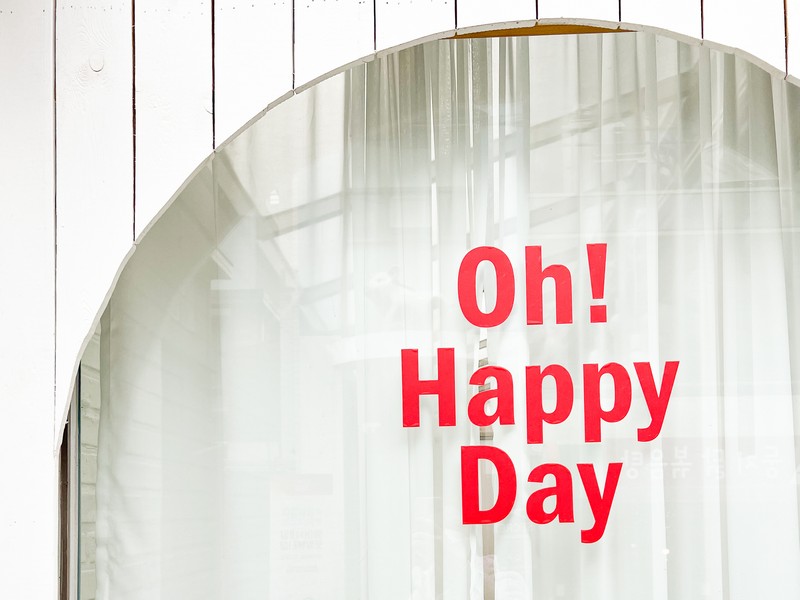
Here is a list of completely free things to do in Seoul:
Planning a trip to Seoul, here’s where to start…
Is traveling in seoul cheap.
- Culture Station Seoul 284 (문화역서울284)
- Seoul Museum of Craft Art (서울공예박물관)
- Oil Tank Culture Park (문화비축기지)
- War Memorial Of Korea (전쟁기념관)
- National Museum of Korea (국립중앙박물관)
- National Hangeul Museum (국립한글박물관)
- National Folk Museum of Korea (국립민속박물관)
- Seoul Museum of History (서울역사박물관)
- Seoul Baekje Museum (한성백제박물관)
- Jeongdong Observatory
- Seoul Fortress Wall
- Ihwa Mural Village (이화동벽화마을)
- Seoul Walking Tours
- Cheonggyecheon Stream (청계천)
- Seoullo 7017
- Bukchon Hanok Village (북촌한옥마을)
- Eunpyeong Hanok Village (은평한옥마을)
- Han River Parks (한강공원)
- Rainbow Lights at Banpo Bridge (반포대교 무지개 분수)
- All of the Korean Buddhist Temples
- Dongdaemun Design Plaza (동대문디자인플라자(DDP))
- Seosomun Shrine History Museum (서소문성지역사박물관)
- Seoul City Hall (서울특별시청)
- National Palace Museum of Korea (국립고궁박물관)
- HiKR Ground (하이커 그라운드)
- The Story of King Sejong (세종이야기)
(This post contains affiliate links, which means I receive a certain percentage of a sale if you purchase after clicking at no cost to you. Thank you for your support.)
- An epic guide to Seoul for the first timer
- Travel to Korea: Where To Start
- For some more budget friendly tips, check out 13 Ways to Save Money on Travel In Korea too
Well, the answer really depends on you and how you travel. If you plan on clubbing and cafe hopping, you’re likely to spend a pretty penny. Restaurants that cater to foreigners cost more and taxis which are more comfortable add up quickly. If you travel more like a local though, opting for subways and buses and eat local food, you can definitely have a pretty budget-friendly trip to Seoul.
Most major historical or cultural attractions in Korea are either free or cost less than W5,000 to visit. Of course, amusement parks and tickets to K-pop concerts can again be expensive in Korea. It’s all about balance if you ask me. If you want to splurge on something, then visit some of these free places in Seoul to make up for it.
24 Free Things To Do In Seoul
I can’t mention all of the amazing parks in Seoul that are free. I’ve mentioned the Han River Parkside, but except for the Seoul Botanic Park, every other park is free to enter from my knowledge. I’ve tried to mention the museums that are completely free to enter and the main tourist attractions that you don’t have to pay to get into. Let the free fun begin!

1 Culture Station Seoul 284 (문화역서울284)
The old Seoul Station which sits just outside of the new huge Seoul Station was converted into an arts and culture space and opened to the public after restorations in 2011. Whether you’ve just arrived at Seoul Station, or are headed somewhere for the weekend, you should absolutely plan to stop in the arts and culture space known as Culture Station Seoul 284 .
They host FREE exhibitions throughout the year and they do a really good job of curating them. A lot of people walk right by this building and don’t realize the beauty that is held within. You will be able to enjoy an artistic or cultural exhibition while simultaneously taking a tour of the old station that was built in 1925.
- Address: Seoul Station(Headquarter)1, Tongil-ro, Jung-gu, Seoul (서울특별시 중구 봉래동2가 통일로 1)
- Hours: Tuesday – Sunday: 10:00am ~ 7:00pm* (Note it is closed if they are between exhibitions and setting up.)
- Website: Culture Station Seoul 284
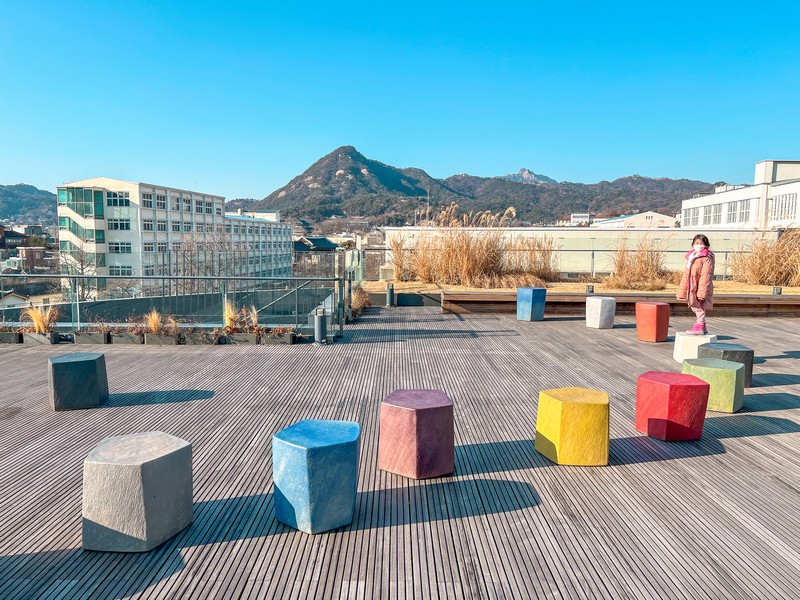
2 Seoul Museum of Craft Art (서울공예박물관)
SeMoCA is the first national museum in Seoul created to showcase Korean crafts. There are seven buildings in the complex and so much to learn about. Learn more about Korean mother of pearl lacquerware, bojagi, or Korean embroidery and folding, and more. There are some beautiful works to see. On top of that, there’s a children’s museum in the complex that is also completely free and has some fantastic experiences for children to learn more about craft culture. Learn in this guide to the Seoul Museum of Craft Art .
- Address: 4 Yulgok-ro 3-gil, Jongno-gu, Seoul (서울시 종로구 율곡로 3길 4)
- By Public Transportation: Go to Anguk Subway Station, and go out of Exit 1 to find the museum just 50 meters away.
- Days: Closed Mondays and January 1st
- Hours: 10:00am ~ 6:00pm
- Website: Seoul Museum of Craft Art
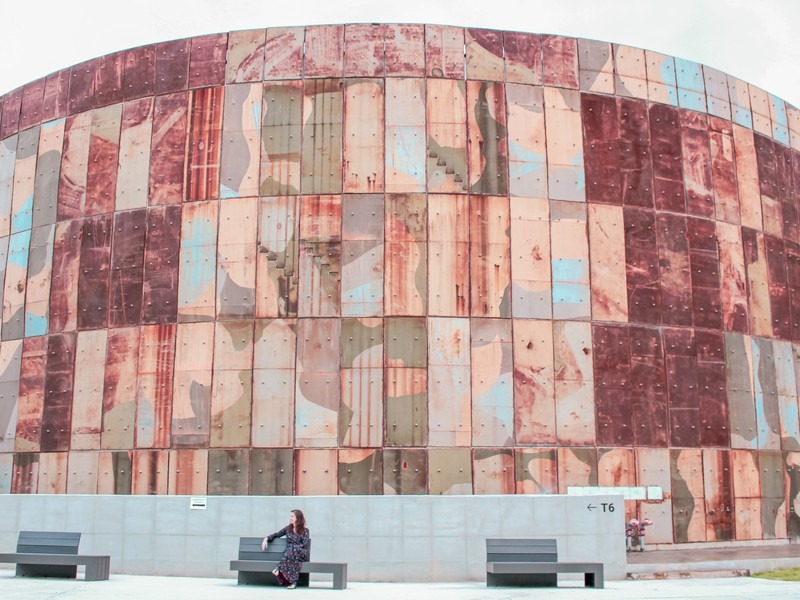
3 Oil Tank Culture Park (문화비축기지)
Five transformed oil tanks are now a cultural and events space. You can enter the reformed oil tanks and find some really cool things inside. The outdoor space is also often host to events. Walk around the entire place and feel free to open doors. Every time we’ve been, the whole place seems a bit weirdly quiet but the doors are unlocked when it’s working hours. Later in the day, staff will come and lock up but until then, you’ve got the run of the place. Find out more about the Oil Tank Culture Park.
- Address: 661 Seongsan-dong Mapo-gu, Seoul, Korea (서울특별시 마포구 성산동 661)
- Hours: The park is open 24 hours a day but the buildings are open from 10:00am ~ 6:00pm
- Website: Oil Tank Culture Park

4 War Memorial Of Korea (전쟁기념관)
The War Memorial is massive and and a must visit for anyone that wants to learn more about the history of the country specifically in regards to the war. It’s centrally located in Seoul and there is a ton of information to learn as well as docents that speak multiple languages that can assist you when you go as well. there are more than 13,000 pieces of war memorabilia and military equipment on the grounds of the War Memorial.
- Address: Yongsan-gu Itaewon-ro 29 (서울특별시 용산구 이태원로 29 )
- Hours: 9:30am ~ 6:00pm
- Days: Open every day except Mondays. If Monday is a holiday, the museum will be closed Tuesday.
- Website: War Memorial of Korea

5 National Museum of Korea (국립중앙박물관)
One of our favorite free museums in Seoul to check out again and again, the National Museum of Korea is massive and has 220,000 relics so be prepared to have a really good and long look around. You could really spend days here. We sure have.
The main museum really delves into Korean history and culture and there are some fantastic exhibitions. The museums is also home to a great children’s museum that we’ve visited multiple times as well. Don’t miss this amazing free museum in Seoul.
- Address: 137 Seobinggo-ro Yongsan-gu, Seoul, Korea (서울특별시 용산구 서빙고로 137)
- Hours: Monday, Tuesday, Thursday, Friday: 10:00am ~ 6:00pm; Wednesday, Saturday: 10:00am ~ 9:00pm; Sunday, National Holidays: 10:00am ~ 7:00pm
- Closed: New Year’s Day (January 1), Seollal (Lunar New Year’s Day), Chuseok (Korean Thanksgiving Day) / Permanent Exhibition Hall closed: First Monday of every April and November annually
- Website: National Museum of Korea
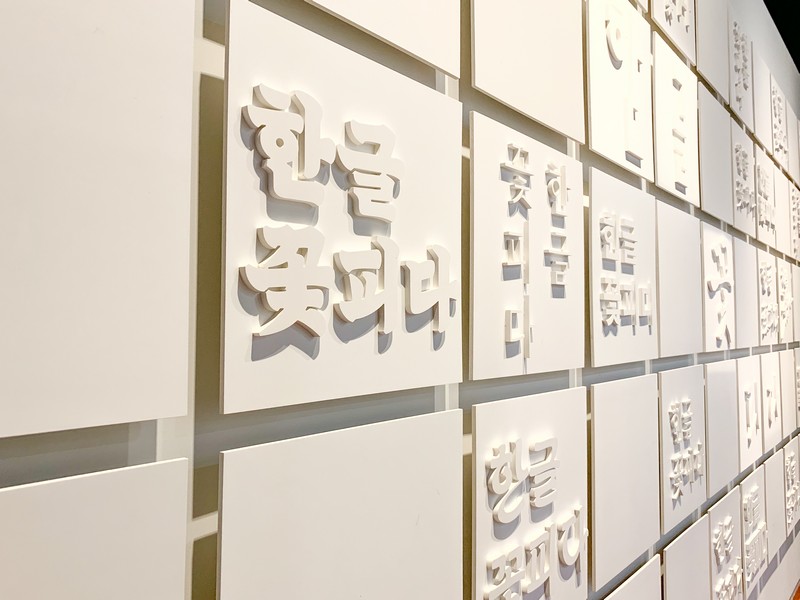
6 National Hangeul Museum (국립한글박물관)
A great museum to check out if you’re interested in learning Hangeul or more about Hangeul , the Korean language system created by King Sejong. Devoted to spreading more information about Hangul and how impressive the system is, this museum is a very interesting spot a lot of tourists overlook.
This museum is on the grounds of the National Museum of Korea so you can visit them at the same time if you like. There’s also a great park around the two museums so you can plan to have a picnic outside after.
- Address: 139 Seobinggo-ro Yongsan-gu, Seoul, Korea (서울특별시 용산구 서빙고로 139)
- Hours: Monday – Friday, Sunday: 10:00am ~ 6:00pm; Saturday: 10:00am ~ 9:00pm
- Days: Closed on January 1, Lunar New Years, Chuseok, and August 15th on the Lunar calendar.
- Website: National Hangeul Museum

7 National Folk Museum of Korea (국립민속박물관)
On the grounds of Gyeongbokgung Palace and easily visited in conjunction with it, the National Folk Museum of Korea showcases 122,500 artifacts that were used in the daily lives of Korean people in the past. There is a traditional culture learning space, exhibition halls and a children’s museum area as well.
- Address: 37 Samcheong-ro, Jongno-gu, Seoul (서울특별시 종로구 삼청로 37)
- Hours: March – May, September – October: 9:00am ~ 6:00pm; June – August: 9:00am ~ 6:30pm; November – February: 9:00am ~ 5:00pm
- Days: Closed New Year’s Day, the day after the Lunar New Year, and Chuseok
- Website: National Folk Museum of Korea
8 Seoul Museum of History (서울역사박물관)
Apart of the Gyeonghuigung Palace site, the Seoul Museum of History focuses on Seoul’s history from the pre-historic era until now with a large focus on the Joseon Dynasty as you would expect. There are free audio guides in multiple languages to make sure you really understand everything you’re viewing. Learn about the history of the city of Seoul through times of war and times of peace and learn about how the kings ruled the country from here.
- Address: 55 Saemunan-ro, Jongno-gu, Seoul (서울특별시 종로구 새문안로 55)
- Days: Closed Mondays, January 1st, and other public holidays
- Website: Seoul Museum of History
9 Seoul Baekje Museum (한성백제박물관)
Established in Olympic Park on the pre-historic site of Baekje ruins in Songpa-gu, this museum has an extensive collection of artifacts and relics that is free to the public. You can find gilt bronze caps, replicas of Pungnaptoseong Fortress and Mongchontoseong Fortress and some other great exhibits. If you’re headed to the park for the cosmos in the autumn perhaps, be sure to stop in and see what else you can learn in this great museum.
- Address: 71 Wiryeseong-daero, Songpa-gu, Seoul (서울특별시 송파구 위례성대로 71)
- Hours: Weekdays: 9:00am ~ 7:00pm; Weekends and holidays: 9:00am ~ 9:00pm
- Days: Closed Mondays, New Year’s Day, and public holidays
- Website: Seoul Baekje Museum
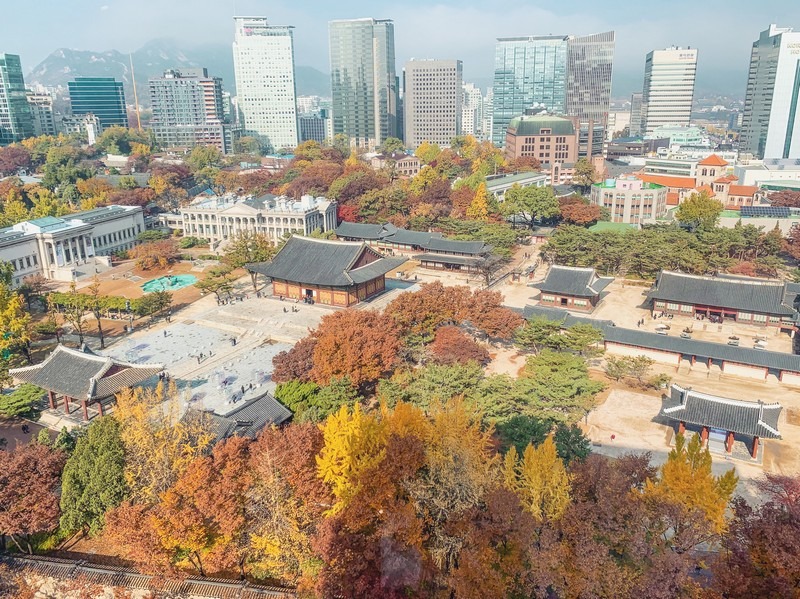
10 Jeongdong Observatory
Most observatories and spots with great views cost a bit of money, but this one is free and you can get an amazing view out over Deoksugung Palace . This is an especially popular spot in the autumn when the foliage is colorful. The building is an office and when you go in, you’ll see a lot of turnstiles for where the workers enter. Just let them know you want to see the observatory and they’ll let you head in to the proper elevator.
- Jeongdong Observatory: 13th floor, 15 Deoksugung-gil, Jung-gu, Seoul (서울특별시 중구 덕수궁길 15 (서소문동) 서울시 서소문청사 1동 13층)
- Cafe Hours: 9:00am ~ 6:00pm
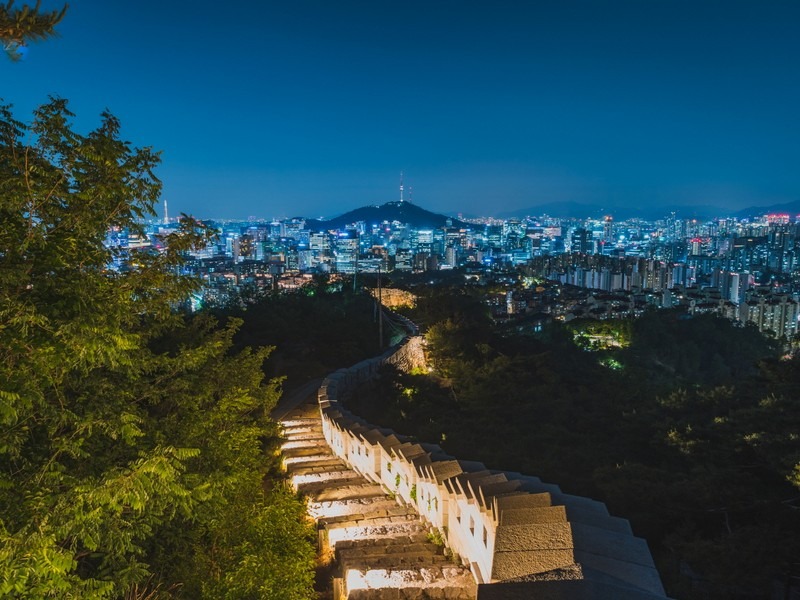
11 Seoul Fortress Wall
The Seoul Fortress Wall is full of history and culture and signboards to tell you all about it. You can see historical gates and more along the wall that is more than 600 years old. I always recommend walking, sometimes hiking, along the Seoul Fortress Wall to new residents to Seoul and tourists especially.
If you’re nervous about getting lost on the mountain trails, do this walk. You can’t get lost just following the wall and the wall circles the central area of Seoul so you can always walk right down to cafes, restaurants, and more. The Seoul Fortress Wall paths are also cleaned off in the winter making it an ideal place to hike in the winter too.

12 Ihwa Mural Village (이화동벽화마을)
Somewhat connected to the above spot, the Ihwa Mural Village sits just inside the Seoul Fortress Wall as well. You could see both at the same time if you want! The Ihwa Mural Village is a fun mountainside village with colorful facades and art to see along the way. Start at Hyehwa Station and make your way up to the colorful area. Remember that it is a residential area so be respectful of the locals. Learn more about the Ihwa Mural Village before you go.

13 Seoul Walking Tours
If you want to learn more about Seoul whether you want to learn more about the history or just want to see more of different districts, there are 40 free walking tours offered by the Seoul City Government. Go out with a volunteer guide and visit markets, learn about Korean culture, history, and ask questions. The tour and guide are free , but some of the tours do stop in places that require you to pay a small admission fee to get in, so look closely at the options if you want ta completely free tour.
Also, since these are volunteer guides, they can be great or just good depending on the person. I’ve been on a few and one was alright and two were fantastic.
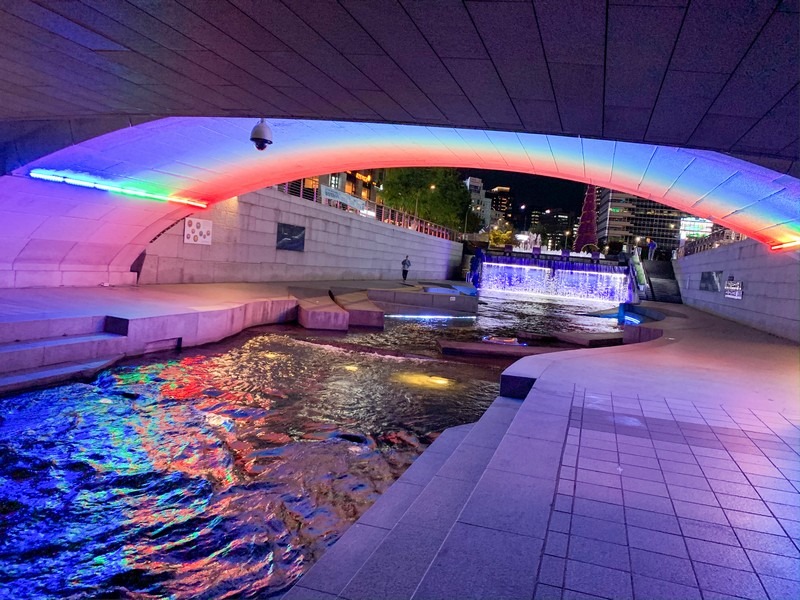
14 Cheonggyecheon Stream (청계천)
The Cheonggyecheon Stream is one of our favorite places to take a walk and you can count on seeing something fun. Home to lantern festivals and exhibitions throughout the year, you can walk along the stream, see what you can see, and stop off in some great spots for lunch like the Gwangjang Market . We walked along the entire length of the Cheonggyecheon Stream so you know what to expect along the way. Find out more in this guide to the Cheonggyecheon Stream .

15 Seoullo 7017
Right outside of Seoul Station, subway and train, Seoullo 7017 is an awesome place to take a walk, take a seat, watch the people, the lights, the shows, and have fun. My favorite place to check out is the Malli-dong plaza (pictured above)… which is something almost everyone misses. It’s a hidden gem right outside of Seoul Station. Take your kids, let them jump on the trampolines, smell the flowers, or stay into the evening and see the colorful light shows on the surrounding buildings. Learn more about Seoullo 7017.
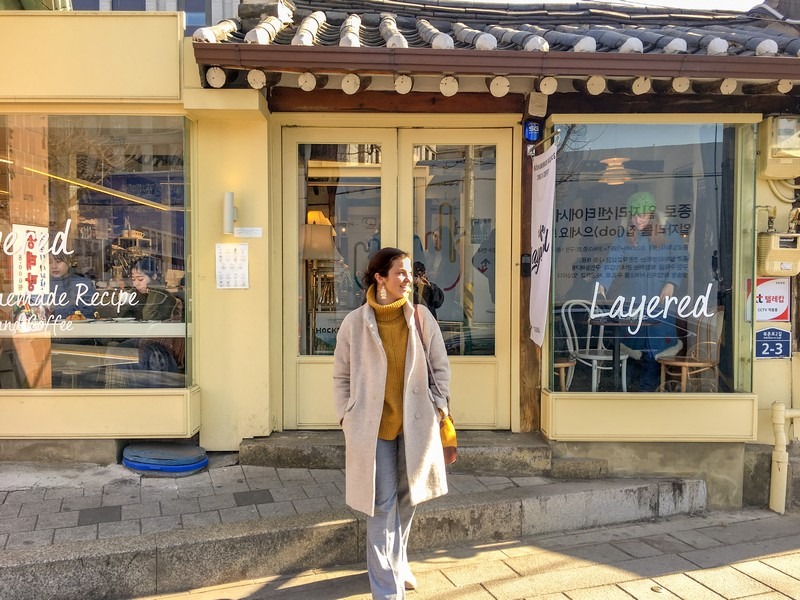
16 Bukchon Hanok Village (북촌한옥마을)
If you want to walk along the traditional Korean buildings in central Seoul, Bukchon Hanok Village is beautiful. There are almost 900 preserved Hanoks, traditional Korean houses, in the area and you could spend hours weaving in and out of the beautiful streets. You can even find a number of Hanoks that are no completely open to the public for free as well.
Start off your time in the area in the Bukchon Culture Center . You can walk through the Hanok and learn more about Hanok architecture and get a free map for the area as well. The map will point out the must-see alleys and best spots to take a photo of the surrounding area. Find out more about what I recommend doing in the Bukchon Hanok Village if you do want to spend a bit of money on tea houses and Hanbok rental.
- Address: 37 Gyedong-gil, Jongno-gu, Seoul
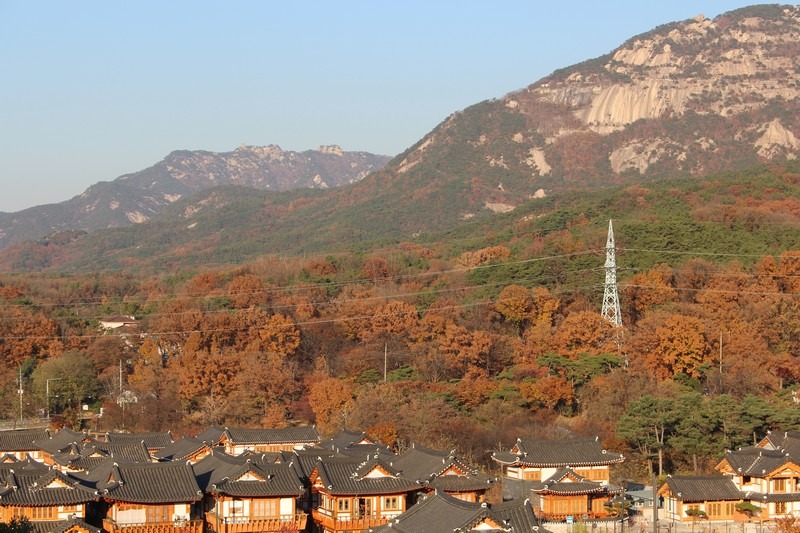
17 Eunpyeong Hanok Village (은평한옥마을)
The “other” Hanok village in the city but the quieter hidden gem version. The Eunpyeong Hanok Village was built over the last decade to be for tourists. The Bukchon Hanok Village still has residents who get in the news for complaining from time to time about all of the tourists, but you won’t find that here.
The alleyways are beautiful and often quite empty here and you can easily take a stroll into the nearby Bukhansan Mountainside and visit a Korean temple on the same trip. Found out more about the Eunpyeong Hanok Village.
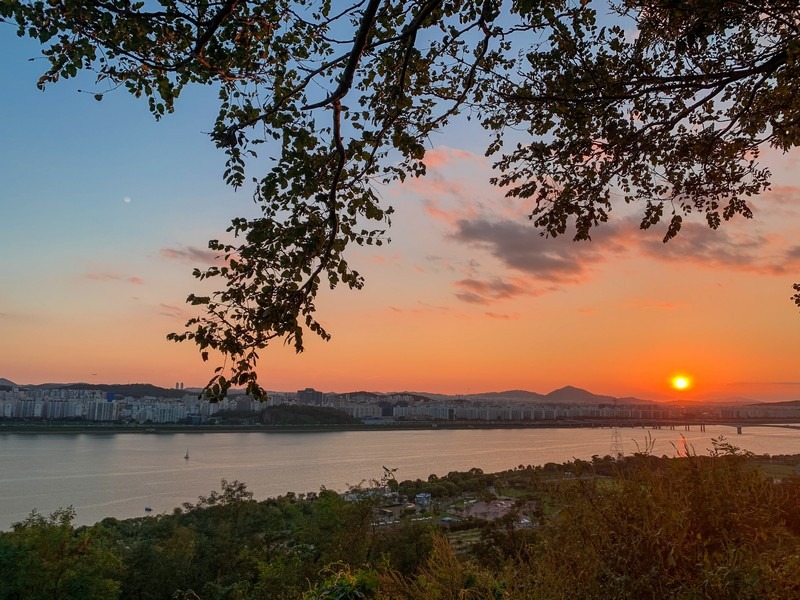
18 Han River Parks (한강공원)
The Han River is a must-visit when you’re in Seoul. You can take long beautiful walks, see shows, and just chill out a bit from the hustle and bustle in the city. There are 11 Han River parks to choose from when you want to go. In the summers there are free water pads to get wet in or let the kids splash in and concerts and festivals you can listen to for free as well.
The parks are all so different as well offering a variety of things to see and do for free so check out that guide to the 11 Han River parks linked above. There is sure to be an area that suits you.

19 Rainbow Lights at Banpo Bridge ( 반포대교 무지개 분수)
If you head to the Banpo Bridge, you can chill out and also see the world’s longest bridge fountain. There are 380 jets that shoot out water and colorful lights make it look like a gushing rainbow at night. Be prepared for crowds. This light and water show does get popular.
The Moonlight Rainbow Fountain operates daily from April to October and there are multiple performances a day with each performance lasting almost 20 minutes. Learn more about how to get there and what to expect in this guide to the Banpo Bridge Moonlight Rainbow Show .
The schedule for the rainbow and water show at Banpo Bridge:
- April 1 – June 30, September 1 – October 31: Weekdays: 12:00pm; 8:00pm; 8:30pm; 9:00pm; Weekends: 12:00pm; 7:30pm; 8:00pm: 8:30pm; 9:00pm
- July 1 – August 31: Weekdays: 12:00pm; then every half hour from 7:30pm to 9:30pm; Weekends: 12:00pm; every half from 7:30pm to 10:00pm
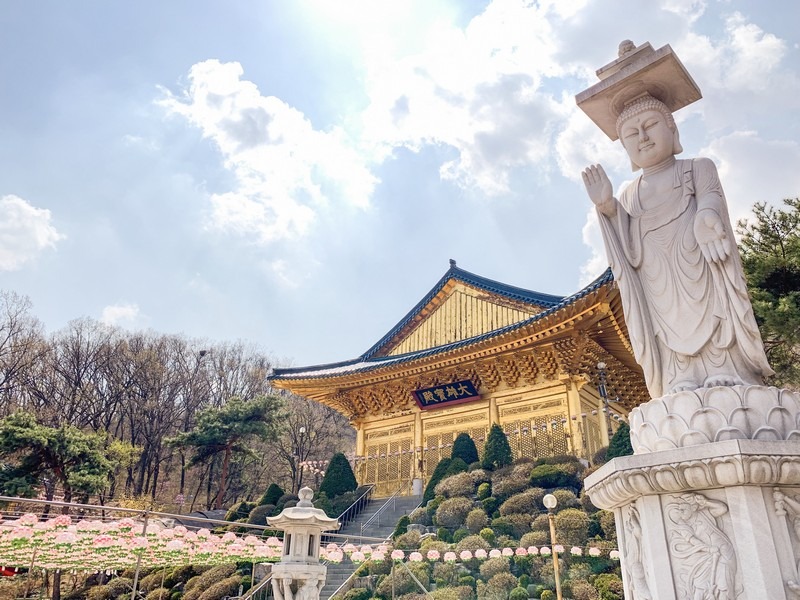
20 All of the Korean Buddhist Temples
Something I thought was obvious, but I’ve realized when traveling the world, isn’t always and requires a mention, the Buddhist temples in Korea are open to visitors and there are some just beautiful ones to see in Seoul. Of course always be respectful, wear appropriate clothing for a religious site, and only visit during daylight hours as these are working temples with monks.
In Korea, you can also stay at a temple if you do want to spend a bit of money and get a full experience. If not, you can still visit, learn more about Korean Buddhism, and learn about the culture through the beautiful paintings and temple decoration.
Some temples in Seoul I recommend:
- Jogyesa Temple
- Bongeunsa Temple
- Bongwonsa Temple
- Suguksa Temple
- Jingwansa Temple

21 Dongdaemun Design Plaza (동대문디자인플라자 (DDP))
Host to major events in Seoul like fashion shows and more, the DDP is actually open and free for you to walk around and in except for the exhibition spaces if they’re hosting and event. You can learn more about everything you can do at the Dongdaemun Design plaza here .
- Address: 281 Eulji-ro, Jung-gu, Seoul (서울특별시 중구 을지로 281 (을지로7가))
- Hours: You can walk around and through the exterior of the building 24 hours a day, but should you want to go inside here are the hours.
- Museum: Tuesday – Sunday: 10:00am ~ 7:00pm
- Design Shop: Weekdays: 10:00am ~ 9:00pm; Weekends & Holidays: 10:00am ~ 10:00pm

22 Seosomun Shrine History Museum (서소문성지역사박물관)
Regarded as a sacred place for Korean Catholics, the Seosomun Shrine History Museum is a very interesting museum and architectural find in Seoul. The path in the museum takes you around and down to a variety of unique spaces and museum halls before spitting you back out again. Learn more about the Seosomun Shrine History Museum and some other great architectural spaces in Seoul here .
- Address: 5 Chilpae-ro, Jung-gu, Seoul (서울특별시 중구 칠패로 5 (의주로2가))
- Hours: Tuesday, Thursday – Sunday: 9:30am ~ 5:30pm; Wednesday: 9:30am ~ 8:30pm
- Days: Closed Mondays
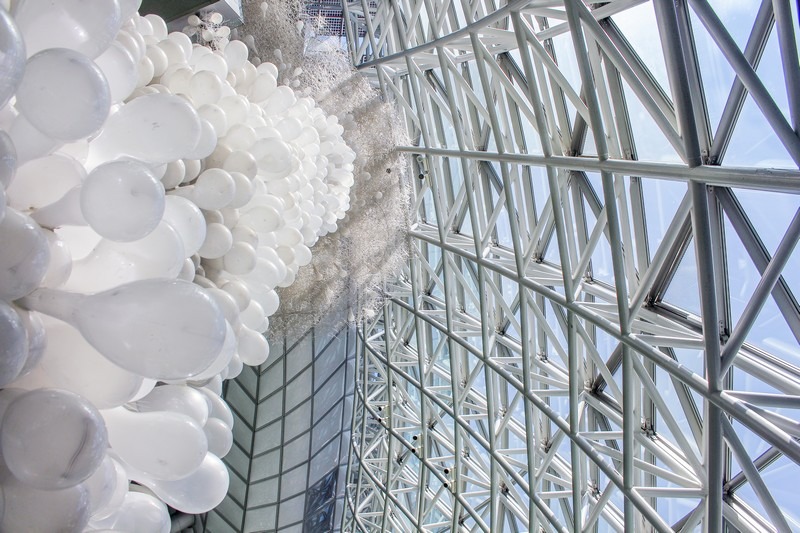
23 Seoul City Hall (서울특별시청)
This might sound like an odd one, but hear me out. The Seoul City Hall just across the street from Deoksugung Palace is really eye catching. A ton of people stop on the lawn in front of this large glass ‘wave’ like structure and don’t even realize they can go inside and should!
Designed by Yoo Kerl of iArc, this building is climate responsive and angled to maximize the amount of diffused light. 62% of the building is for government offices but 38% of the building was kept for public use. Inside, you can see the an enormous living wall which holds the Guinness World Record for being the largest vertical garden in the world as well as the “Meta Epic: SeoBeol” a beautiful artwork that looks like balloons and a tornado. From there, make your way up or down to find the other spaces for public use.
- Address: 110 Sejongdae-ro Jung-gu, Seoul (서울특별시 중구 세종대로 110 서울특별시청)
- Hours: Every day 9:00am ~ 6:00pm; Saturdays: 9:00am ~ 3:00pm

24 National Palace Museum of Korea (국립고궁박물관)
A museum also on the grounds of Gyeongbokgung Palace which never gets listed even though the National Folk Museum is always listed, the National Palace Museum of Korea is also completely free to enter and even connected to the subway station so really easy to find.
Just go out of Gyeongbokgung Station exit 5 and you’re there. There are some great pieces held here and exhibitions. Also, definitely go down to the basement level where there are some cool experiences. We did one and got free Hanji notebooks the last time we visited.
- Address: 12 Hyojaro, Jongno-gu, Seoul ( 서울 종로구 효자로 12 )
- Hours: Every day: 10:00am ~ 6:00pm
- Days: Closed January 1st, February 1st, September 10th
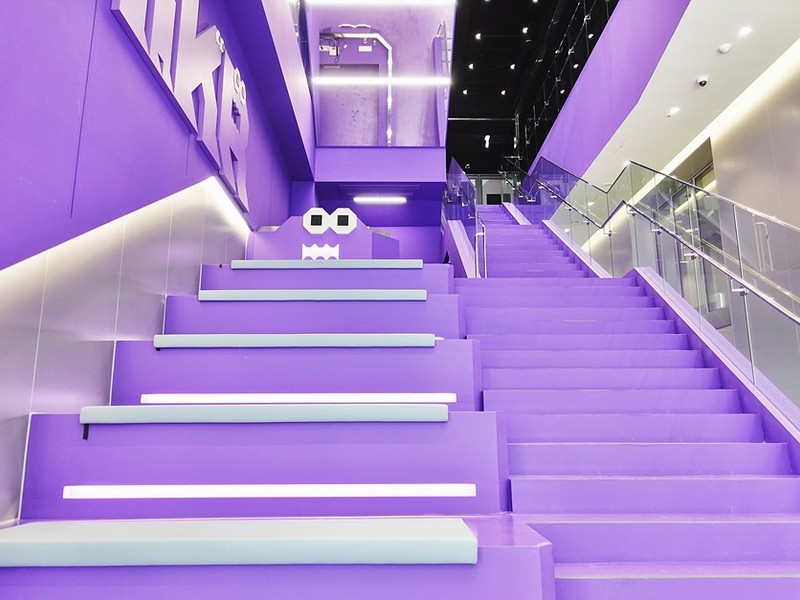
25 HiKR Ground (하이커 그라운드)
The ultimate Hallyu playground. HiKR Ground is an immersive tourism space opened by the Korea Tourism Organization and brings together floors of fun. Create your own K-Pop video in the with a BTS or AESPA background. Learn more about Korean wellness tourism and find out what the best Korean tea is for you. It’s a great space that’s completely free!
- Address : 40 Cheonggyecheon-ro, Jung-gu, Seoul (서울특별시 중구 청계천로 40 한국관광공사 서울센터)
- Hours: 1F, 5F: 09:00-20:00; 2F – 4F: Tuesday – Sunday 10:00-19:00 ( Last admission 20 minutes before closing )
- Website : hikr.visitkorea.or.kr

26 The Story of King Sejong (세종이야기)
While a lot of people visit Gwanghwamun Square, a lot of people completely miss the fact that there is a free museum beneath that tells the story of both King Sejong and Admiral Yi Sun-sin . It’s not only educational and will amp up any visit to downtown Seoul, but in the winter or summer, it’s a great break from the weather and there are bathrooms there too.
- Wondering how to get inside? There’s a door on the backside of the very popular King Sejong statue that everyone takes photos of.
- Hours: Tuesday – Sunday: 10:00am ~ 6:30pm
Did you like this post? Pin IT!
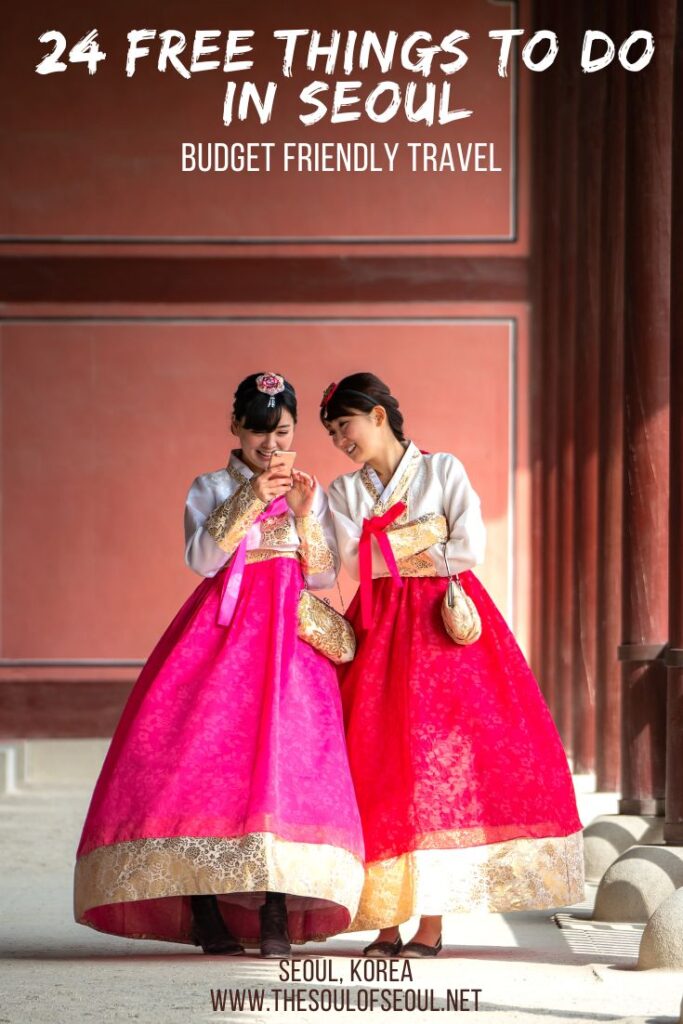
You May Also Like

Hongdae… After The Party Is Over
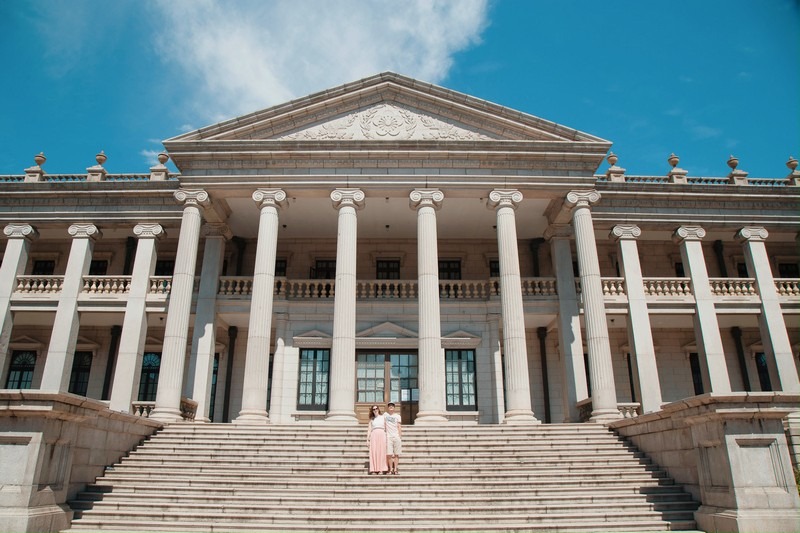
Deoksugung Palace: The Most Unique Palace In Seoul
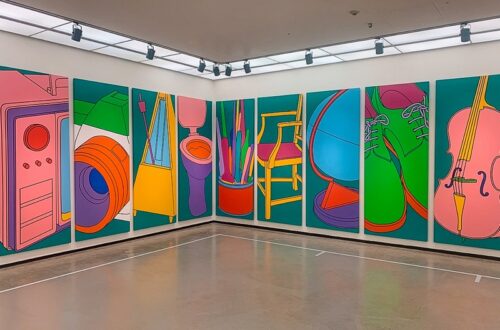
The Seoul Arts Center: Enjoy Art, Musicals, and Performances
One comment.
Thank you for this very informative posting!
Leave a Reply Cancel reply
Your email address will not be published. Required fields are marked *
Sign me up for the weekly updates newsletter!
This site uses Akismet to reduce spam. Learn how your comment data is processed .
13 of the best things to do in Seoul, South Korea

Feb 4, 2024 • 8 min read

From bustling street food markets to peaceful temple life, experience the best of Seoul with this guide © Plan Shooting 2 / Imazins / Getty Images
For an ultra-modern city filled with sleek high-rises and time-tested palaces, tempting street food, vibrant shopping districts and much more, head to Seoul .
Whether you want to see the latest K-Pop sensation, take a late-night food and drink tour, or find serenity in a spa or temple, the city has something to offer 24/7. Here are the best things to do in South Korea ’s capital.
1. Taste the street food at Gwangjang Market
Street food in Seoul is beloved for its spice, variety and affordability, and there’s no better place to try it than Gwangjang Market . Dating from the early 20th century, this covered market has gained a reputation among foodies for having some of the country’s best street snacks.
Planning tip: Start with an order of tteokbokki (stir-fried rice cakes in a bright orange spicy sauce), followed by a couple of mandu (Korean dumplings) and a pajeon (savory green onion pancake). For dessert, try hotteok (a pancake filled with brown sugar and cinnamon) or bungeoppang (a fish-shaped pastry filled with sweet red bean paste). Then do it all over again.

2. Step back in time at Gyeongbokgung Palace
If you only have time to see one sight in Seoul, make it the splendid architecture, serene pagodas and maze-like grounds of Gyeongbokgung Palace . Originally built during the reign of the powerful Joseon Dynasty in the 14th century, the palace was destroyed during the 16th-century Imjin War and rebuilt in the 18th century. Gyeongbokgung is the largest and most elegant of Seoul’s five royal palaces.
Planning tip: Take in the ceremonial changing of the Royal Guard in front of the massive Gwanghwamun Gate before strolling the grounds to admire striking hip-and-gable buildings, tranquil ponds and delicate cherry trees. Wrap up your visit with a stop at the National Folk Museum of Korea , which sits on the palace grounds and features exhibits on traditional Korean culture.
3. Stroll along the Cheong-gye-cheon Stream
In the heat of summer , nothing beats a walk along Cheong-gye-cheon Stream . A dazzling oasis that unfurls for nearly 11km (7 miles) through the towers of central Seoul, this picturesque waterway is lined with walking paths, trees and bridges. The original stream was covered with an elevated highway after the Korean War, but in 2005, the city undertook an urban renewal project to refresh the area and reintroduce the stream better than ever. Since then, it’s been a popular spot for locals and tourists looking to cool off or take a leisurely break from the city’s hustle and bustle.
4. Shop for the latest trends in Myeong-dong
You’ll want to break out the credit card for an afternoon of spending in Seoul’s most famous shopping district. Myeong-dong is renowned for trendy fashion labels, deluxe department stores and cosmetic boutiques packed with famed K-beauty products. Once you’ve sufficiently stocked up on mask sheets and moisturizer at Olive Young , innisfree and Etude House , check out the Myeong-dong Night Market for quirky souvenirs and traditional street food.
The area is also home to some of Seoul’s cutest cafes, with the Pink Pool Cafe at the Stylenanda Pink Hotel flagship store being the ultimate eye candy. This confectionery-colored spot has an ice-cream-parlor vibe, indoor ornamental pool and sweet-as-sugar art decor, making it a popular place for photo shoots.
5. Go for a dip in a jjimjilbang
More than just a way to get clean, bathing in Seoul is a full-fledged social activity. Koreans gather at bathhouses (jjimjilbang) with friends and family typically once a week. Jjimjilbang can range from an establishment with just a couple of small dipping pools to massive aquatic palaces with multiple pools, water features, cafes, saunas, relaxation rooms, gyms, spas and arcades.
First-timers should know that bathhouse etiquette requires bathing in the nude, and some bathhouses don’t allow patrons with tattoos. Once you’ve bared all, take a dip in the hot and cold pools, followed by a stretch in the sauna, then opt for a traditional full-body scrub to emerge baby-soft from your bathhouse experience.
Planning tip: The female-only Spa Lei draws patrons for its elegant atmosphere and invigorating massages.

6. Take a hike in Bukhansan National Park
Bukhansan National Park is listed in the Guinness Book of World Records as “the most visited national park per unit area” – which is easy to understand since it’s set within the city limits and easily reachable by public transportation . You’ll often see athletic Koreans in colorful hiking gear riding the subways on weekends.
Bukhansan covers 80 sq km (31 sq miles) and features jagged peaks, hiking trails, dozens of storied temples and 1300 species of plants and animals. The 5-hour round-trip hike to the 836m (2744ft) summit of Bukhansan is well worth it to see Seoul spread out before you in all directions.
7. Go singing in a noraebang
Walk down any busy street in the university districts on a Friday or Saturday night, and you’re likely to hear distant singing wafting through the air. Chances are it’s not an errant K-Pop band but the raucous merriment of karaoke at a noraebang (singing room). This popular late-night activity involves private rooms with big-screen TVs, phone-book-sized lists of songs and even disco balls or musical instruments to accompany the singalong. Top it off with room service bringing snacks and cocktails, and it’s a recipe for a great night out.
8. Sip on Korean drinks: soju and makgeolli
The traditional Korean beverages soju and makgeolli have been respectively distilled and brewed since the 13th century and are the most beloved drinks in this thirsty nation. Soju also has the surprising distinction of being the world’s best-selling spirit, perhaps helped out by the fact that a standard bottle often costs less than a bottle of water.
While such upmarket small-batch distilleries as Samhae Soju and Hangang Brewery create artisanal varieties, the most common labels, such as Jinro and Seoul Makgeolli, can be happily imbibed at the picnic tables dotting sidewalks outside convenience stores across the city.
Planning tip: Those new to the Korean alcohol scene should check out the Sool Company , which offers tasting tours, brewing classes and special events.

9. Star-search on K-Star Road
You’re probably familiar with Hollywood’s Walk of Fame, but did you know Seoul’s glamorous Gangnam district has its own boulevard dedicated entirely to K-Pop artists? Instead of stars on the sidewalk, K-Star Road features 3m-tall (10ft) statues of cartoon bears called GangnamDols, each decorated to represent a different K-Pop singer or band, including Super Junior, Girls’ Generation and BTS.
Planning tip: After taking a few selfies with your favorite bears, pop into the GangnamDol Haus near the Apgujeong Rodeo subway station to pick up a few mini bears as souvenirs.
10. Stay at a temple and take part in life with the monks
The iconic image of a colossal Buddha statue looking over sleek high-rises can be seen at the 8th-century Bongeun-sa Temple in Gangnam . Although most tourists come just to snap a photo or two, you can actually participate in temple life with the monks. Over a weekend, join in vegetarian meals, morning chanting, meditation and even the 108 daily prostrations, all meant to clear the mind and bring you closer to achieving inner peace.
Planning tip: Temple-stay programs are offered not only at Bongeun-sa but also at various temples throughout Seoul.
11. Spend the night in Bukchon Hanok Village
Graceful sloping roofs, ornate tiles and colorful dancheong (intricate paintwork under the eaves of traditional Korean palaces) come together to create the Korean traditional house, called hanok . Tucked between the Gyeongbokgung and Changdeokgung palace complexes lies Bukchon Hanok Village , a historic district filled with hundreds of charming hanok that’s often used as a backdrop for period movies and television shows.
Planning tip: While the village has cafes, teahouses, museums and boutiques, it’s also home to a handful of hanoks -turned-guesthouses where visitors can sleep on traditional ondol heated floors, walk through kimchi pot–filled courtyards and generally get a taste what life was like in old Seoul.
12. Get a bird’s-eye view at N Seoul Tower
At the top of Nam Mountain sits N Seoul Tower , a broadcasting structure dating from 1969 and rising 239m (784ft) into the sky above the city. The tower still has active transmission antennas, though today it’s better known for an observation deck that offers 360-degree views of the capital. The top of the tower also offers a few dining options, including a swanky rotating restaurant serving French fare.
Planning tip: To reach the tower itself, you can ride the Namsan Cable Car aerial tramway or hike the meandering trails to the top through Namsan Park .
13. Take a day trip to the DMZ
One of the top day trips from Seoul , a visit to the northern border may well be the most unusual 24 hours you’ll spend on the Korean peninsula. The 250km (160-mile) border between North and South known as the Demilitarized Zone (DMZ) is one of the world’s most closely guarded borders.
Various outfits, such as the popular DMZ Tours company, take curious onlookers from central Seoul to the border area to catch a glimpse into North Korea from Dora Observatory , explore the Third Infiltration Tunnel (originally dug by North Korean soldiers) and even step into North Korea in the Joint Security Area . There’s also the touristy DMZ Peace Train operated by KORAIL, which whisks passengers from Seoul Station to Dorasan Station, the last stop to the north before crossing into the Hermit Kingdom.
This article was first published Mar 4, 2020 and updated Feb 4, 2024.
Explore related stories

Jun 18, 2024 • 8 min read
South Korea has an incredible mix of attractions that will keep you coming back for more. These are 11 of our favorites.

Feb 27, 2024 • 6 min read

Jan 2, 2023 • 12 min read

Jun 9, 2022 • 6 min read

Jan 19, 2022 • 9 min read

Oct 12, 2020 • 7 min read

Sep 2, 2019 • 5 min read

Oct 26, 2018 • 6 min read

Jun 14, 2018 • 7 min read

Aug 9, 2017 • 5 min read

- ESL Teaching
- Hotel Reviews
- Media & Advertising

Discover Hidden Gems in Seoul: A 4-Day Offbeat Itinerary
Whether you’re visiting Seoul for the first time or you’re an expat looking to explore hidden gems in Seoul , there’s always something fresh to discover beyond the touristy hotspots. Skip the packed palaces and crowded streets—this 4-day itinerary is all about uncovering hidden gems in Seoul , cool hidden spots, and those neighborhoods where the locals hang out. Ready to experience the Seoul that doesn’t make it into the guidebooks? Let’s dive in!
… and if you’re looking for a Seoul itinerary that covers all the must-see attractions like Gyeongbokgung Palace and Bukchon Hanok Village, check out my 3-day Seoul itinerary for first-timers!
Day 1: Quirky Neighborhoods & Cozy Cafes – Hidden Gems in Seoul
Morning: wander through ikseon-dong hanok village.
Forget the crowds at Bukchon and head to Ikseon-dong , one of Seoul’s coolest hidden gems . It’s like a time capsule in the middle of the city—a place where ancient Korea meets hip, Instagrammable cafes. The narrow alleyways are brimming with charm, filled with quaint shops, vintage boutiques, and photogenic streets that seem frozen in time.
Kick off your day with a cup of coffee at Dongbaek Yanggwajeom , a retro bakery that feels like you’ve stepped back into the 70s. The ambiance is just as delightful as the baked goods. Pro tip: come early to snag the best seats and enjoy the peaceful morning vibes before the neighborhood fills up. Ikseon-dong is not only a visual treat but also offers plenty of hidden corners where you can quietly observe local life, away from the typical tourist scenes.

Afternoon: Seochon Village – Seoul’s Hidden Artistic Heart
Next up, keep the artsy vibes going by heading to Seochon Village , one of the best kept hidden gems in Seoul. Tucked away near Gyeongbokgung Palace, this area is rich with history and culture but remains blissfully under the radar compared to the palace’s main entrance. As you wander through the charming streets, you’ll discover tiny art studios, quirky galleries, and eateries that offer a more authentic, local experience.
Make sure to stop by the Baek In-je House Museum , a beautifully preserved Hanok that offers a rare glimpse into life during Korea’s colonial period in the early 20th century. Unlike some of the more famous palaces and museums, the Baek In-je House feels intimate and tranquil, providing a peaceful respite from the bustling city.

Evening: Dinner at Tongin Market – The Ultimate Street Food Adventure
Ready to satisfy your hunger? Head to Tongin Market , a hidden gem in Seoul’s food scene. The market offers a unique dining experience through its Dosirak Café system , where you exchange old-school coins for bites of Korean street food. From tteokbokki to crispy dumplings and kimchi pancakes , you can fill your tray with a variety of delicious snacks. It’s the perfect way to immerse yourself in Korean street food culture while exploring a lesser-known market.
Tongin Market is a fantastic place to sample local flavors without the crowds you’d find at places like Gwangjang Market. Make sure to stroll through the stalls to find unique dishes and engage with the friendly vendors.
Day 2: Nature Walks & Industrial Chic – Hidden Gems in Seoul
Morning: chill at seonyudo park – an island escape.
Start your day with a visit to one the green hidden gems in Seoul: Seonyudo Park . This park was once an industrial water plant but has since been transformed into a tranquil green space on an island in the Han River. Seonyudo Park offers lush gardens, modern art installations, and unbeatable views of the river.
What makes Seonyudo a hidden gem is the sense of calm it offers—despite being located in the middle of the city, it feels like a world apart. Bring a coffee, find a quiet bench, and enjoy the morning serenity as you take in the sights and sounds of nature.
Afternoon: Explore Oil Tank Culture Park & Mangwon-dong Eats
After your peaceful morning, continue your exploration with a visit to the Oil Tank Culture Park , a repurposed oil reserve turned into a cultural hub. The park’s industrial aesthetic, with its massive tanks now serving as art spaces and performance venues, makes it one of the most unique hidden gems in Seoul. You might catch an art exhibition or a live performance, adding an unexpected twist to your day.
Once you’ve worked up an appetite, head to the nearby Mangwon-dong neighborhood for lunch. Often overlooked by tourists, Mangwon is a favorite among locals for its indie cafés, small restaurants, and cool shops. Stop by BBuri Kitchen , a cozy eatery that serves up fresh, seasonal Korean dishes using farm-to-table ingredients. It’s a true hidden gem for foodies looking to experience authentic, sustainable Korean cuisine.

Evening: Night Hike Along Seoul’s City Wall
Cap off your day with a magical night hike along the Seoul City Wall , starting at Naksan Park . The hike offers breathtaking views of Seoul’s skyline as the ancient walls are illuminated against the night sky. The experience feels intimate and off-the-beaten-path, providing a peaceful way to see Seoul from a new perspective. This night hike is one of those hidden gems in Seoul that even locals may not fully appreciate.

Day 3: Traditional Vibes & Local Markets – Hidden Gems in Seoul
Morning: discover korean herbal medicine at seoul yangnyeongsi herb medicine museum.
Dive deeper into Korean culture by visiting the Seoul Yangnyeongsi Herb Medicine Museum , another of Seoul’s hidden gems for anyone interested in traditional Korean medicine. The museum offers a fascinating look at the herbs and remedies that have been used in Korea for centuries. You’ll see everything from ginseng roots to dried mushrooms and even have the chance to sample some herbal tea or try a natural remedy.
Exploring the world of traditional medicine offers a unique glimpse into a part of Korean culture that is often overshadowed by more mainstream attractions.
Afternoon: Gwangjang Market – Skip the Tourist Traps, Hit the Fabric Alley
While Gwangjang Market is well-known for its food stalls, it’s also home to one of Seoul’s best-kept secrets: the fabric and hanbok alleys. Skip the crowded food sections and explore the market’s lesser-known areas, where you’ll find an incredible array of traditional Korean fabrics, handmade clothing, and vintage fashion items.
If you’re into crafts or fashion, this is a great place to hunt for unique souvenirs. And when hunger strikes, look for a small, hidden vendor serving mandu or bindaetteok —you’ll find some of the best food off the beaten path here.
Evening: Craft Beer & Industrial Alleyways in Euljiro
End your day in Euljiro , Seoul’s industrial-turned-hipster district. By night, this area comes alive with indie bars, craft beer joints, and an eclectic nightlife scene. For a truly local experience, head to The Booth or Eulji OB Bear , where you can enjoy a cold craft beer paired with some of the best Korean fried chicken in the city. This neighborhood is a hidden gem in Seoul’s nightlife scene, perfect for those who want to avoid the usual tourist hotspots.

Day 4: Art, Antiques & Epic Views – Hidden Gems in Seoul
Morning: leeum, samsung museum of art – the best of both worlds.
Start your final day with a visit to the Leeum, Samsung Museum of Art , a must-see for art lovers. This museum combines traditional Korean art with contemporary works, offering a unique balance between the old and new. It’s one of Seoul’s hidden gems, often overlooked by tourists but highly regarded for its diverse collection.
Afternoon: Itaewon’s Hidden Antique Street & Vegan Eats
While Itaewon is known as a bustling tourist hub, Itaewon Antique Street remains one of the area’s best-kept secrets. Filled with vintage shops and quirky stores selling antiques from around the world, this street is perfect for browsing and finding unique souvenirs. Afterward, head to Plant Café , a vegan hotspot serving up dishes so delicious that even non-vegans rave about them.
Evening: Jeongdong Observatory – The Perfect Goodbye
End your Seoul adventure with a visit to the Jeongdong Observatory , a quiet spot offering panoramic views of Deoksugung Palace and its surroundings. This hidden gem provides a serene way to enjoy your last night in Seoul. As you stroll down the nearby Jeongdong-gil , a tree-lined street illuminated at night, you’ll feel like you’ve truly experienced the hidden side of Seoul.

By the end of these four days, you’ll have explored fabulous hidden gems in Seoul—the non-touristy neighborhoods , local cafes , and unique experiences that make the city truly special. Whether you’re a first-time visitor or a long-time expat, this off the beaten path Seoul itinerary offers an unforgettable journey through the city’s lesser-known wonders.
Want more customization? Check out my personalized Korea travel itinerary!
Is it your first time visiting Korea and you’re not quite sure where to start with your travel planning? Let me create a tailor-made itinerary just for you.
For only $35 USD, you’ll get a custom Korea travel itinerary based on your preferences, filled with day-by-day travel tips, hotel recommendations, transportation tips & more! The best part is, one free revision is included to make it just right.
Ready for your unique Korea journey? Order now and let’s make it happen!

Customized Korea Travel Itinerary
Embark on a journey crafted exclusively for you – your way, your pace. Uncover the beauty of Korea with my Customized Korea Travel Itinerary Package.
Get your Free Seoul City Check List
This downloadable check list for Seoul contains insider information on what to see, do, eat and where to shop and party in Seoul , South Korea.

Pin it and save it for later!

Check out more Korea content:

Leave a Reply Cancel reply
This site uses Akismet to reduce spam. Learn how your comment data is processed .

안녕, I'm linda :)
Happy to have you here!
Explore Korea through my eyes as I share a decade of Korean adventures.
Enjoy the journey and visit often!
Where I am now

Linda Goes East Shop
Shop Korea-inspired home decor prints. Unique. Affordable. Korea.

Map of Seoul Round High Quality Digital Print

Uri Jib Home Sweet Home High Quality Print

Korean Alphabet Hangul Print High Quality Digital Print
Privacy overview.

35 Unique Things To Do In Seoul For First Time Visitors
by Mark and Kristen Morgan
Published: August 14, 2023
Updated: August 5, 2024
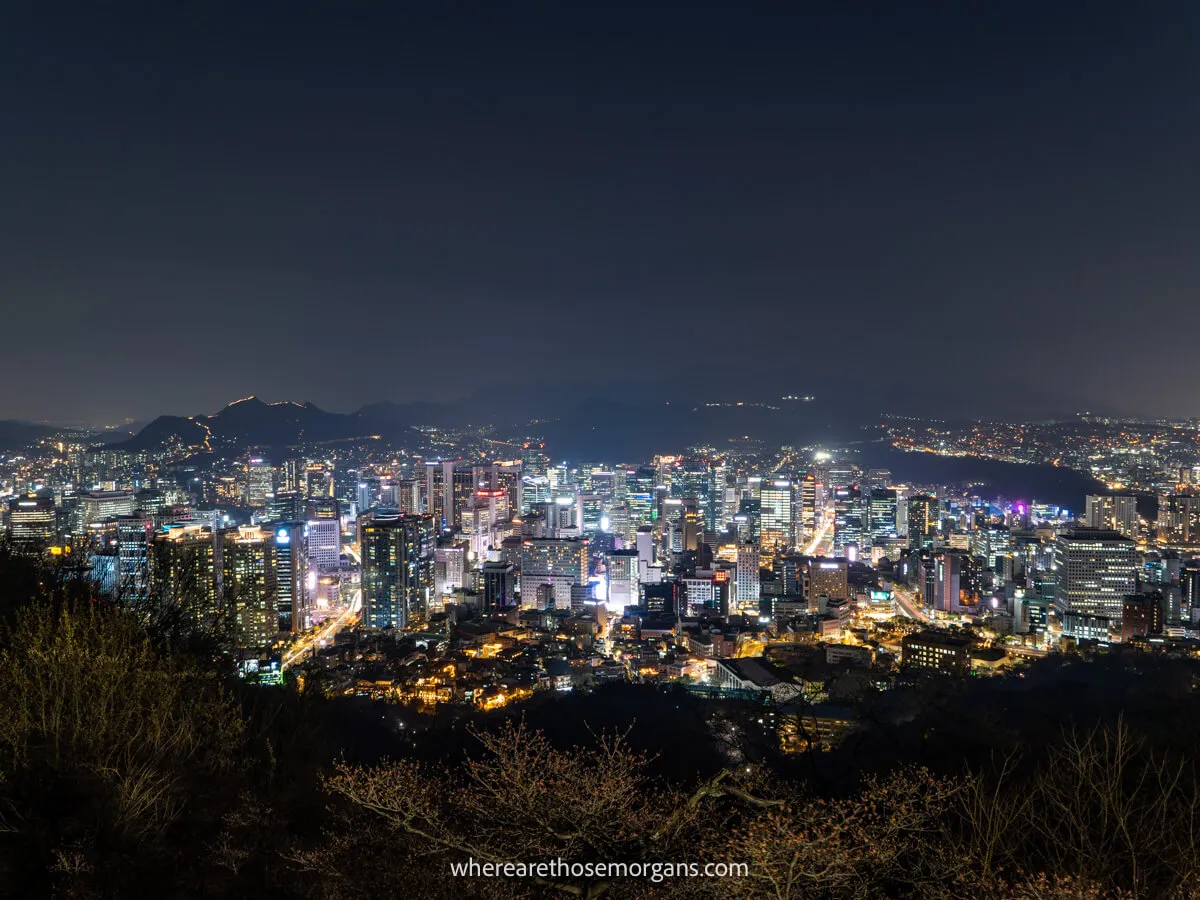
Seoul has so many fun things to do for the whole family, including royal palaces, museums, hiking trails, parks and observation decks. The Seoul Sky Tower, Gyeongbokgung Palace, Namsan Peak and the War Memorial of Korea are some of the most popular attractions in the city.
In this guide we show you the best things to do in Seoul, South Korea including hidden gems we think you shouldn’t miss.
Our Seoul Experience
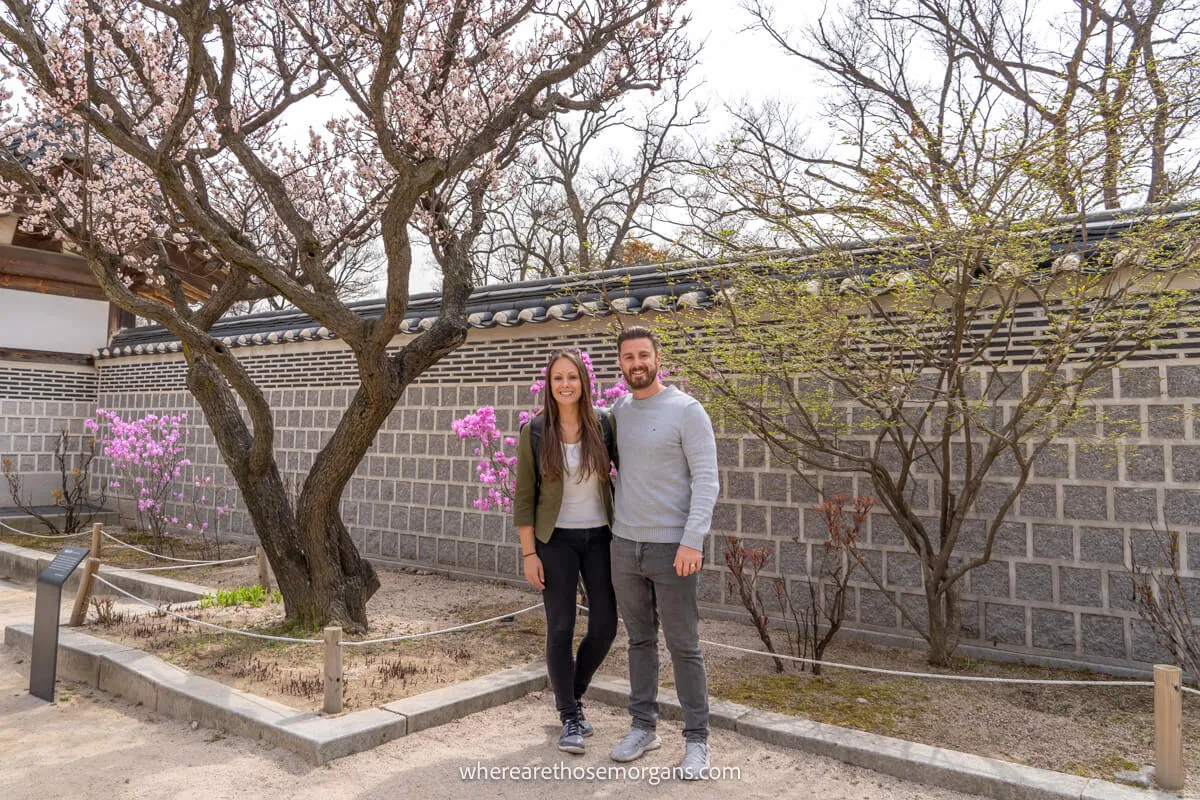
We spent 14 memorable days exploring Seoul in March 2023 . Our days were filled with museums, hikes, palaces and Korean BBQ. But even with two weeks, we still couldn’t accomplish everything on our Seoul bucket list because there’s just so much to do in this amazing city.
Our favorite Seoul attractions were the Lotte World Tower, touring the DMZ and Seodaemun Prison. But the popular sites are spread out throughout the entire city so we organized activities by specific area to see as much as possible . Read more about us .
This guide will show you popular attractions you should consider adding to your Seoul itinerary along with money saving tips. Click the heart on the bottom of this page so you can easily return as you plan your trip. But before we get into our list, there are a few important transportation options you need to consider.
How To Get From Incheon Airport (ICN) To Seoul
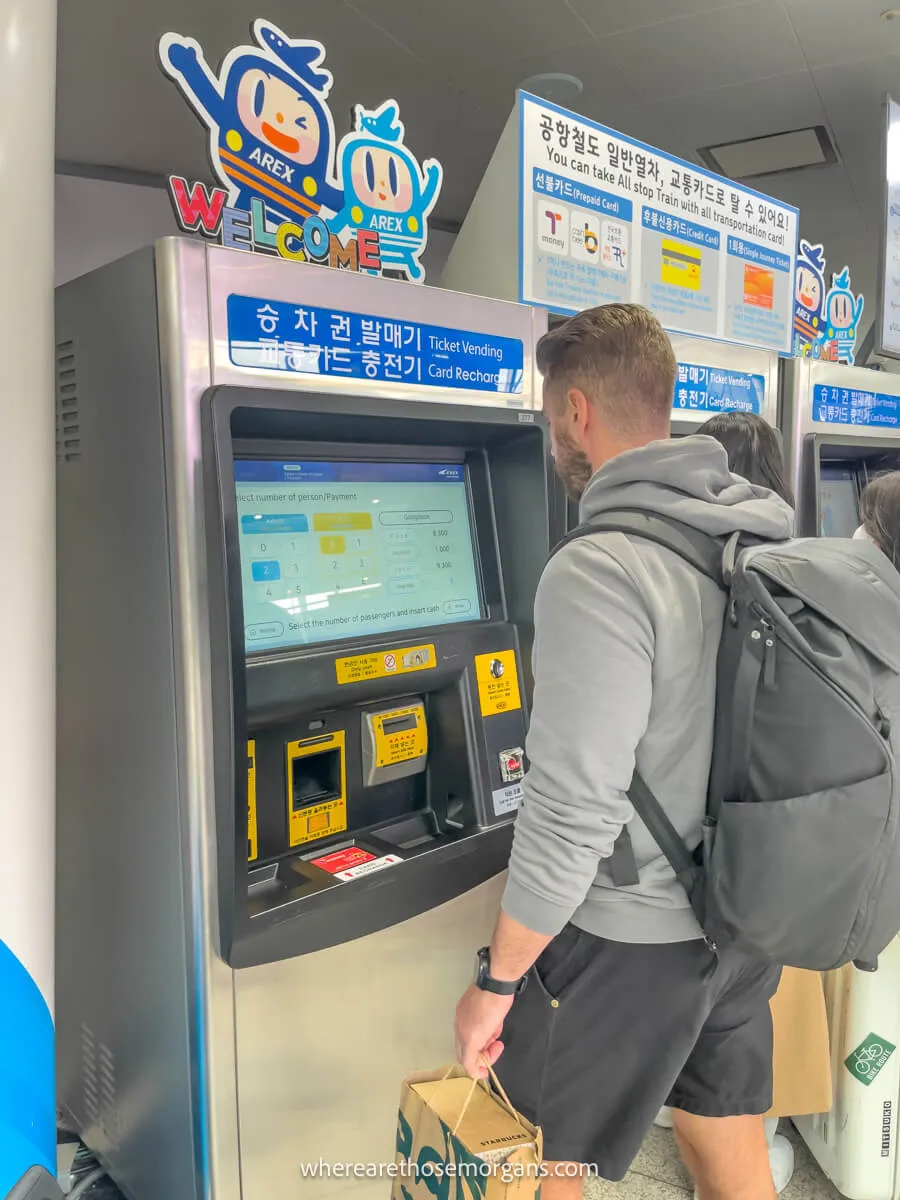
Most visitors will arrive into Seoul from Inceheon International Airport (ICN). But this airport is located about an hour from the city so you’ll need to take a train, bus, taxi or car to your hotel. We think the easiest way to get from Incheon to Seoul is the AREX Airport Express Train . This is what we used and it takes about 43 minutes traveling nonstop between the airport and the city.
You can book tickets for the train online or at the airport like we did, but make sure you book the express train . There is another All Stop Train that runs from Inceheon, but it makes 10 stops and takes 53 minutes so it will be slower than the express option. Tickets cost 9,500 KRW (US$ 7.11) for adults or 7,500 KRW (US$ 5.61) for children.
>> Book tickets for AREX Airport Express here
If you don’t feel comfortable with public transportation or you want a little luxury during your trip, you can also book a private transfer to the neighborhood of your choice.
Travel Tip : The ticket machines at the airport do not accept credit or debit cards so you’ll need cash in South Korean Won to purchase train tickets.
How To Get Around Seoul
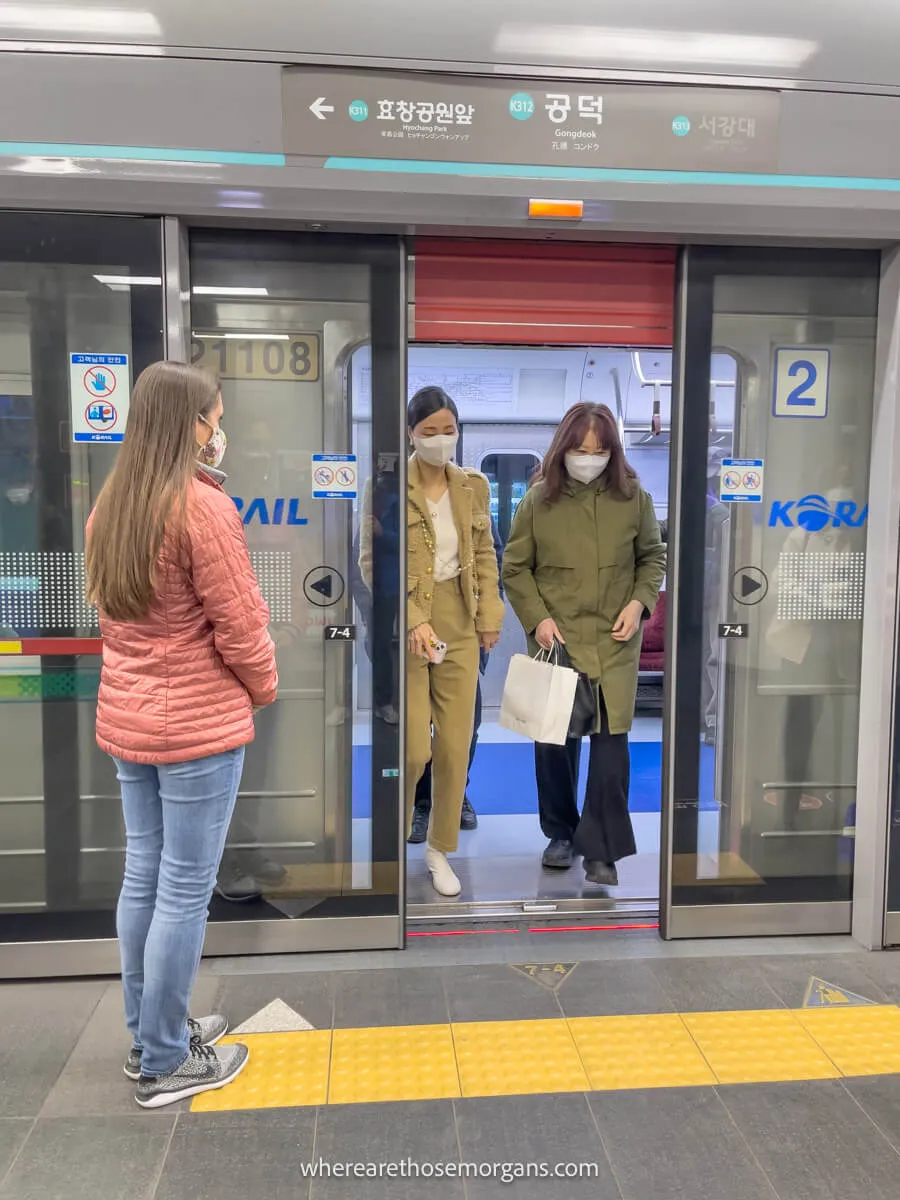
The easiest way to get around Seoul is by subway because the city has an extensive system with over 20 lines. We like the subway because it’s environmentally friendly and extremely cost effective. You can use cash or a T-Money card to pay for your subway tickets.
The express train will arrive into the 2nd floor basement of Seoul Station and from here, you’ll need to make it your hotel. We used the subway because it’s cheap and we saw a decent amount of traffic so wanted to avoid sitting in a taxi after a long flight.
If you’re planning to use the subway for the majority of your trip, we recommend you purchase a T-Money card . You can set the amount of money on the card and it will be scanned every time you get on and off the subway. A single use ticket costs 1,500 KRW (US$ 1.12) for adults and 500 KRW (US$0.37) for children.
Visitors can purchase a T-Money card at select convenience stores or online prior to visiting . But if you’re just arriving into Seoul with your suitcase, you can pay with cash for your first trip on the subway then purchase your T-money card once you get acclimated. We’ve included the best subway stop and exit for all attractions listed in this guide.
Travel Tip : For those visitors planning to see more than just Seoul, you should look into the Korea Rail Pass because it will give you unlimited train rides on almost all trains operated by KORAIL.
Now, let’s take a look at the best places to visit in Seoul!
1. Visit The Royal Palaces
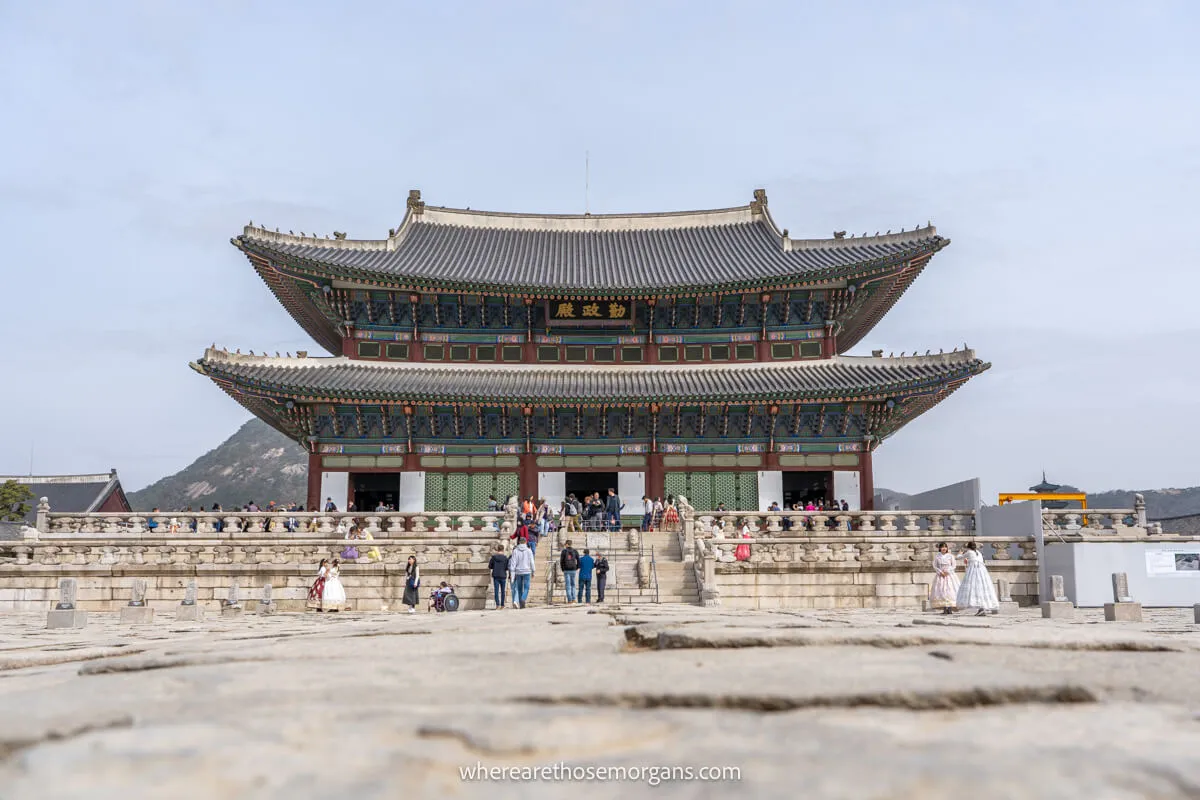
The 5 royal palaces in Seoul were built during the Joseon Dynasty (1392-1910). They showcase beautiful architecture and centuries of important Korean history. The most popular palace is Gyeongbokgung followed by Changdeokgung, Changgyeonggung, Deoksugung and Gyeonghuigung respectively.
Most palaces offer free guided tours which we highly recommend if this is your first time in Seoul . We’ve personally visited each palace ourselves and wrote an extensive guide with pros and cons if you don’t have enough time to visit all of them. So start with our comparison of Seoul’s royal palaces to see which one you want to visit.
If you’re not sure which palace to see, check out each one individually:
- Gyeongbokgung Palace (most popular)
- Changdeokgung Palace (has a secret garden)
- Changgyeonggung Palace (our favorite)
- Deoksugung Palace (two museums inside)
- Gyeonghuigung Palace (least visited)
Many visitors dress up in a hanbok to visit the royal palaces. A hanbok is the traditional clothing of Korea and it was used to signify an individual’s gender, class, marital status or age. Any visitor waring a hanbok will receive free entry into Seoul’s palaces . It’s very common for visitors to have their hair and make up done so they can take photos during their visit. You can rent a hanbok here .
2. Jongmyo Shrine
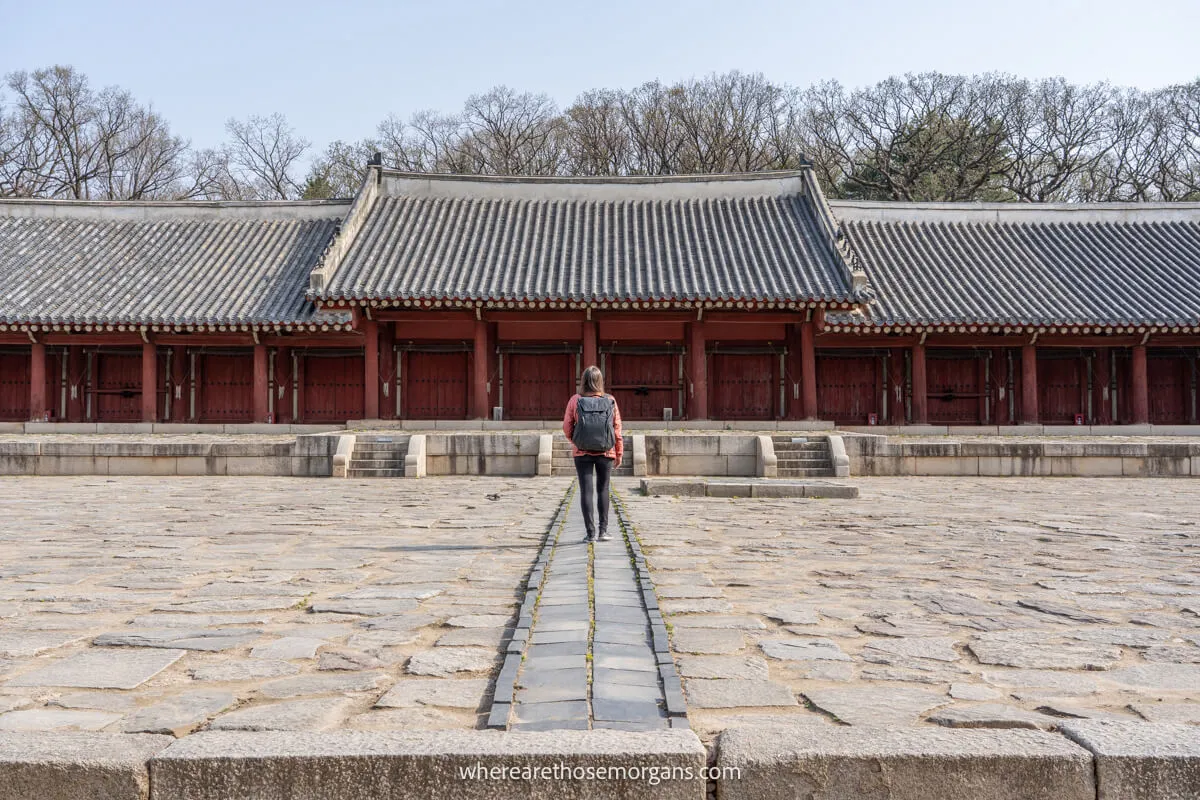
The Jongmyo Shrine contains the spirit tables of the deceased kings and queens from the Joseon Dynasty. Based on Confucian principles, these sacrificial rites symbolize the legitimacy of the royal family.
- Address : 157 Jong-ro, Jongno-gu
- Location : Google Maps
- Subway stop : Jungno 3-ga Station (line 1, exit 11), (line 3, exit 8), (line 5, exit 8)
In 1995, Jongmyo was listed on UNESCO’s list of Intangible Cultural Heritage of Humanity and this unique shrine is definitely a must do thing in Seoul. We couldn’t visit during the free guided tour, but we used the informational brochure to explore the stunning complex.
READ : How to visit the Jongmyo Shrine
3. Bukchon Hankok Village
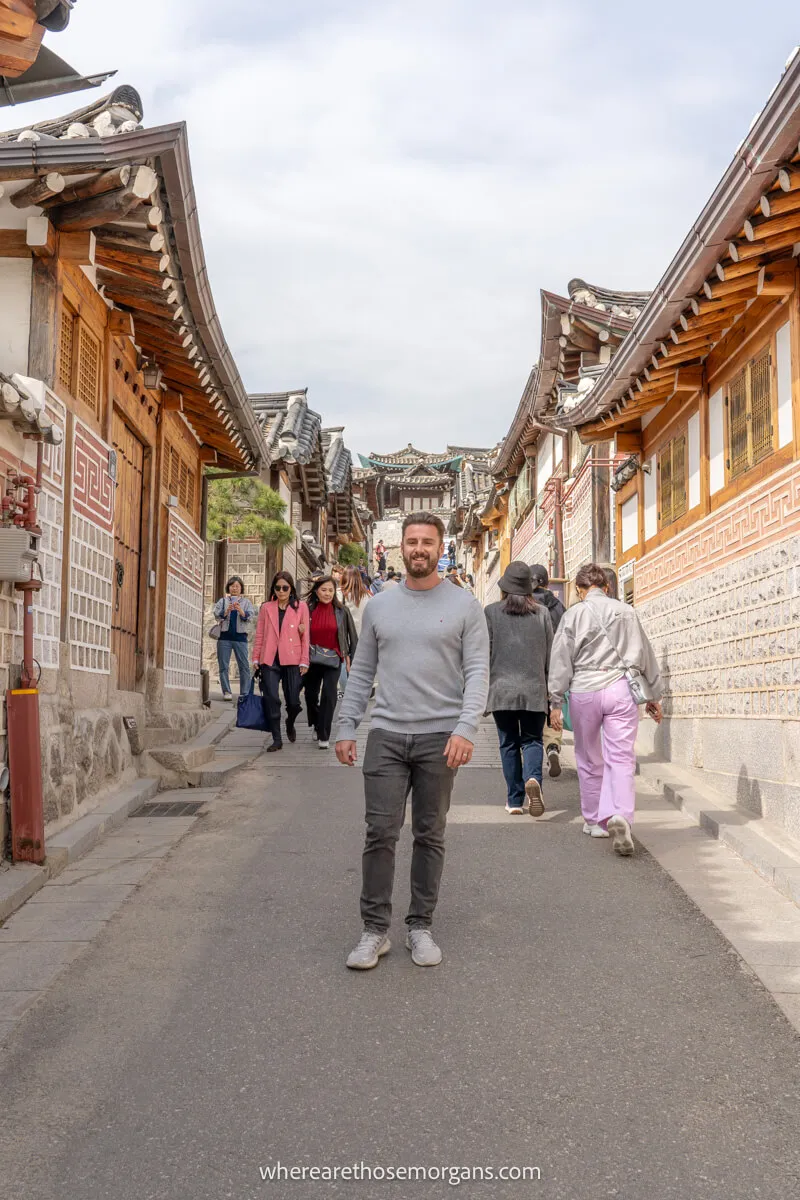
One of the must see things is Bukchon Hankok Village because this stunning town features 1,000 traditional homes that date back to the Joseon Dynasty. The beauty of the village makes it one of the most instagrammable places in Seoul and it can be very crowded.
- Region : Gyedong-gil, Jongno-gu
- Subway stop : Anguk Station (Line 3, exit 2)
We included the main photo spot on our interactive Seoul map you’ll find later in this guide, but we recommend you wander around the village to enjoy the scenery and possibly find a quieter section in town. This experience by Klook is a great option for hanbok rentals if you want to take fun photos.
4. Namsan Seoul Tower
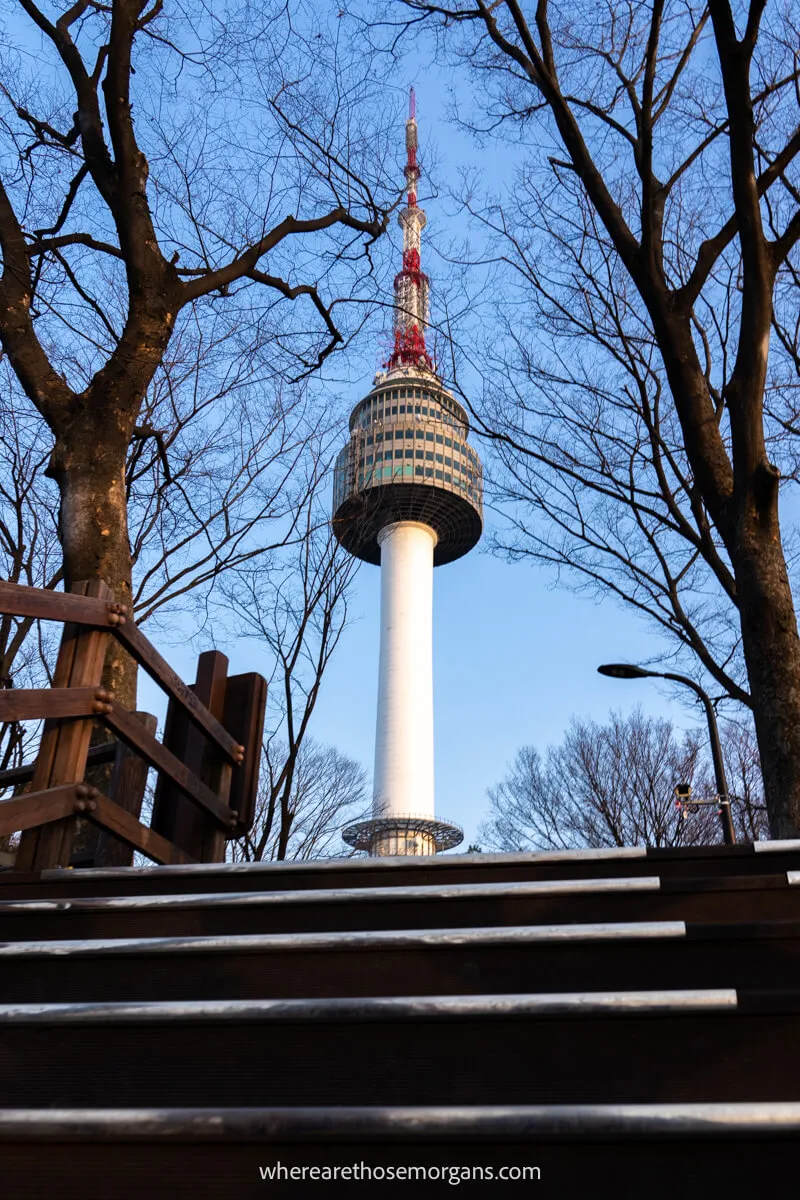
The Namsan Seoul Tower is one of the two observation decks that instantly grab your attention when looking at the city skyline. We think the N Seoul Tower is one of the fun things to do in Seoul because you can take a cable car up to Namsan Park , where you’ll find an entrance to the observation deck.
- Address : 105 Namsangongwon-gil, Yongsan-gu
- Subway stop : Myeongdong Station (line 4, exit 3)
If you plan to visit, consider booking this combo ticket for the cable car and observation deck because Klook typically offers the best price. But make sure you give yourself enough time at Namsan Park as there’s so much to see in the area and the views are incredible.
READ : Tips for visiting Namsan Seoul Tower
5. Book A DMZ Tour
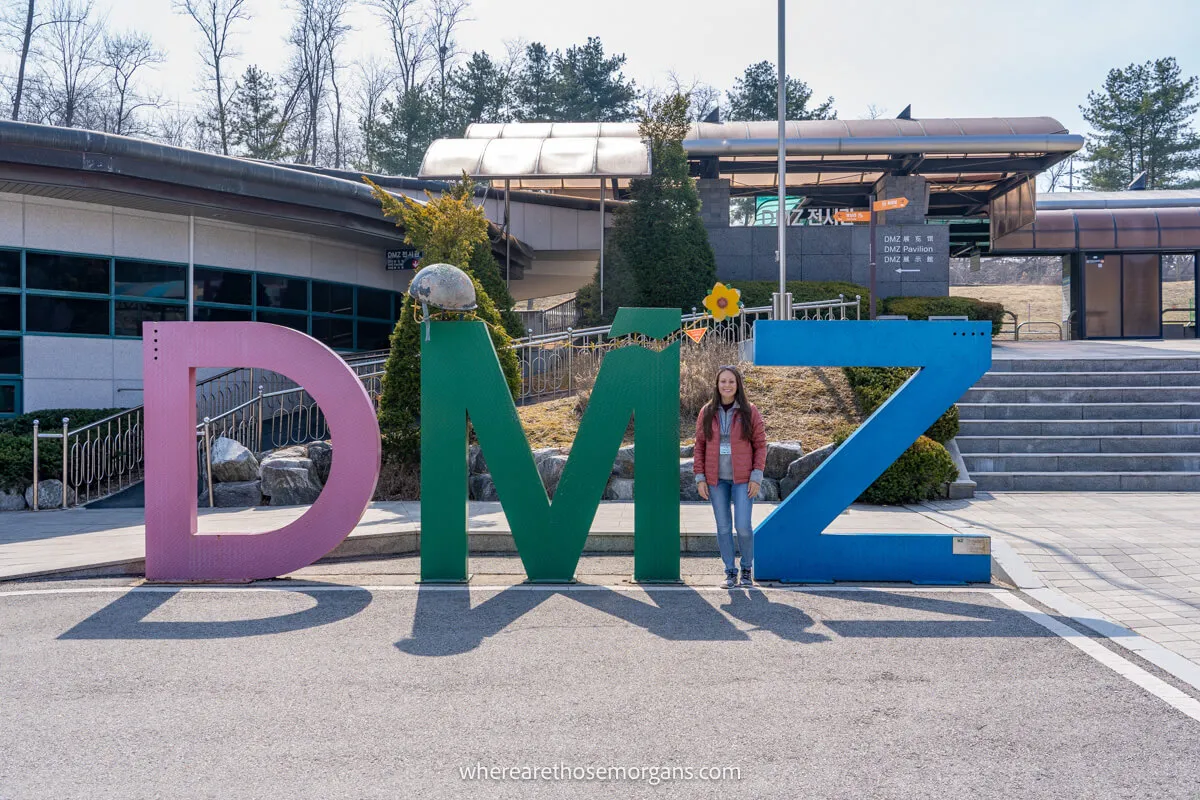
One of the top things to do in Seoul is visit the DMZ. While this tour is technically not in the city, most tours originate in Seoul so we’ve included it on our list. The DMZ is one of the most notorious and heavily fortified strips of land in the world running between North and South Korea with tensions still existing today.
From Seoul, most tours begin at Imjingak Park where visitors can explore the park on their own. However, Imjingak Park is the last point you can visit without a tour . You must have a tour guide to explore other locations along the DMZ such as the 3rd Infiltration Tunnel , the Dora Observatory and the Joint Security Area .
Tourists can visit both the DMZ and the JSA, but you must be part of a guided tour . Before booking, we recommend you read our DMZ Tour Review to see which tour would be best for you. But if you already know what you want to do, here are the most popular DMZ Tours:
- Get Your Guide – South Korea DMZ half or full day option
- Klook – Demilitarized Zone Tour (we booked this tour)
- Viator – DMZ Tour with expert guide
- JSA Tour – Paju JSA + DMZ one day bus tour
READ : What to see at Imjingak Park
6. Jogyesa Temple
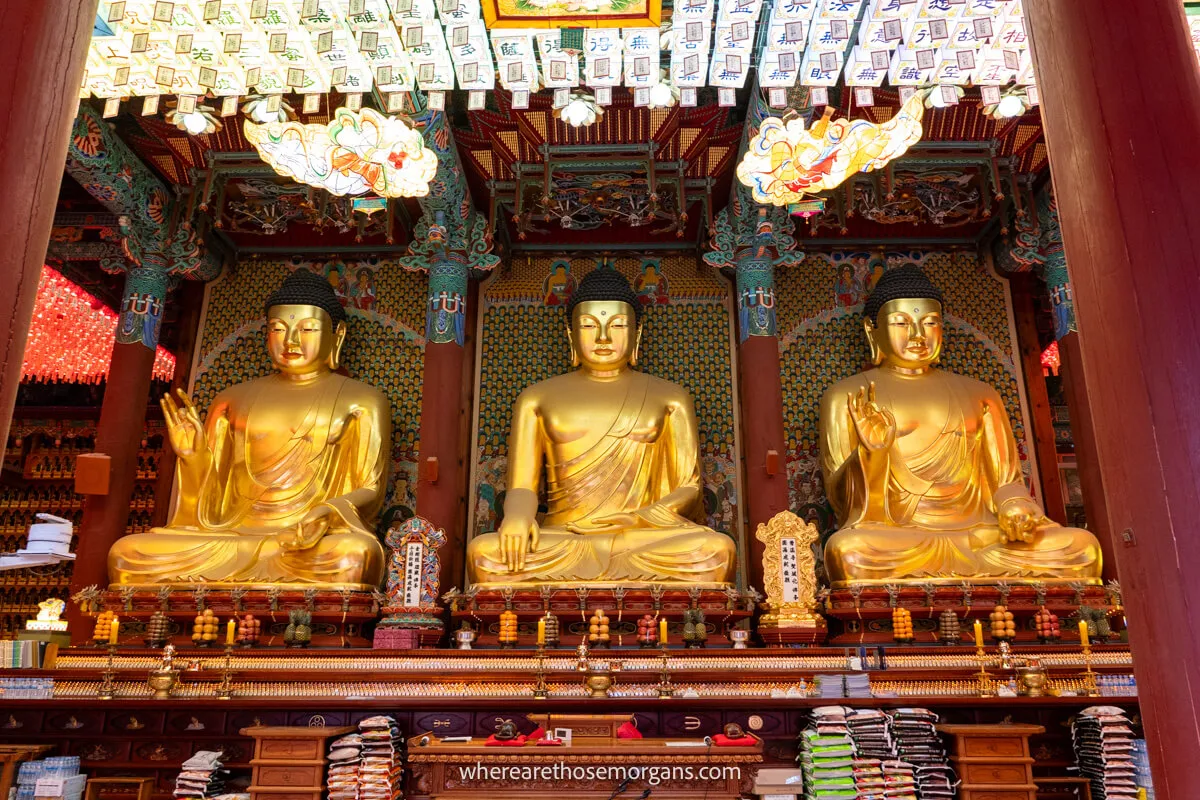
Located near Insa-dong, Jogyesa Temple is one of the most important Buddhist temples in Korea . It’s one of the best places to go in Seoul because the temple symbolizes modern day Korean Buddhism. Constructed in 1395, Jogyesa Temple was originally built in a different location, but it was moved in 1938 and reconstructed in its current location.
- Address : 55 Ujeongguk-ro, Jongno-gu
- Subway stop : Anguk Station (line 3, exit 6)
We like Daeungjeon Hall because it features three large golden statues of Amitabha Buddha, Shakyamuni Buddha and Bhaisaiya Buddha measuring 4.8m (16 ft) in height. When you visit the temple, you can also see Baeksong (a 500 year old lacebark pine tree), Brahma Bell Pavilion, Paradise Hall, the One Pillar Gate and a Chinese Scholar Tree.
7. Gwangjang Market
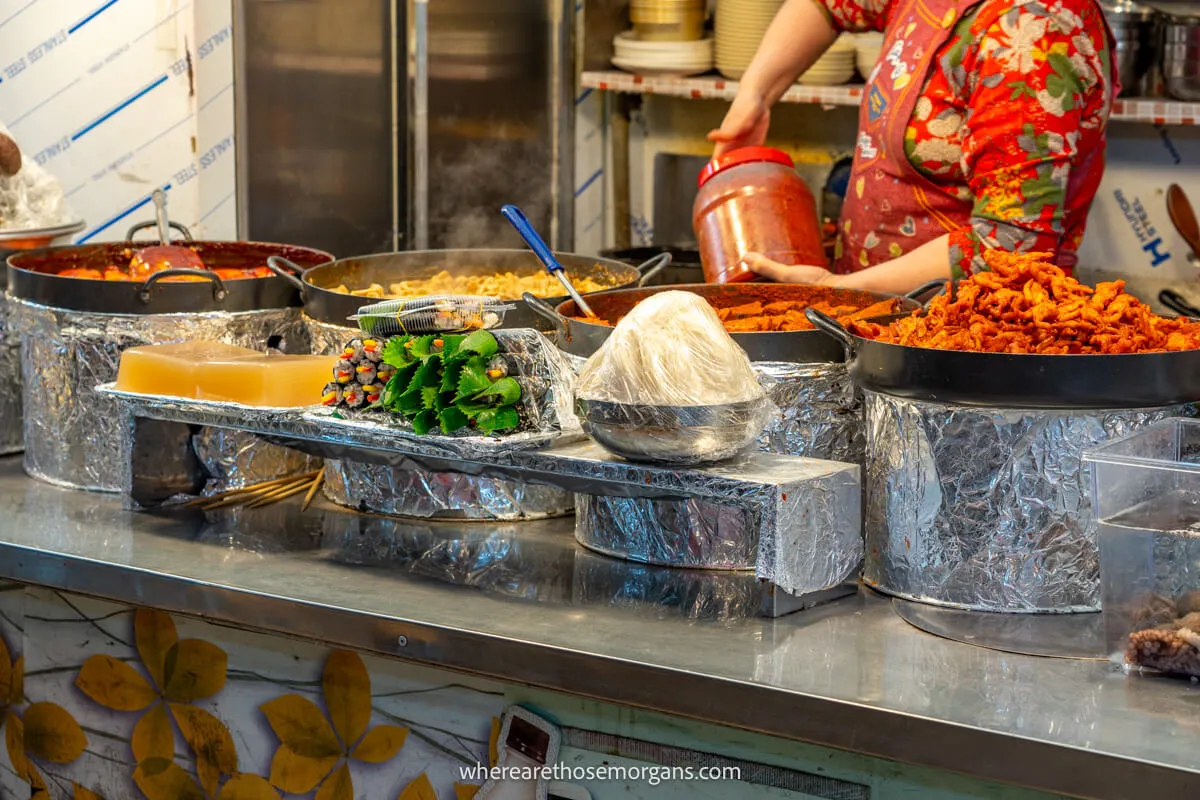
If you’re a foodie, the Gwangjang Market is a must do activity in Seoul . Not only can you try many unique foods, but it was Seoul’s first permanent market made popular by Running Man .
- Address : 88 Changgyeonggung-ro, Jongno-gu
- Subway stop : Jongno 5-ga Station (line 1, exit 7) or Euljiro 4-ga Station (line 2/5, exit 4)
The food is located on the first level of Gwangjang Market while the second floor showcases silk, satin or linen goods. Popular foods include:
- Bindaetteok (mung bean pancakes)
- Tteokbokki (spicy rice cakes)
- Sannakji (live octopus)
- Bibimbap (rice and meat)
If looking for these foods seems overwhelming, try this Gwangjang market food tour to help you find the best Korean street foods.
8. Dongdaemun Market
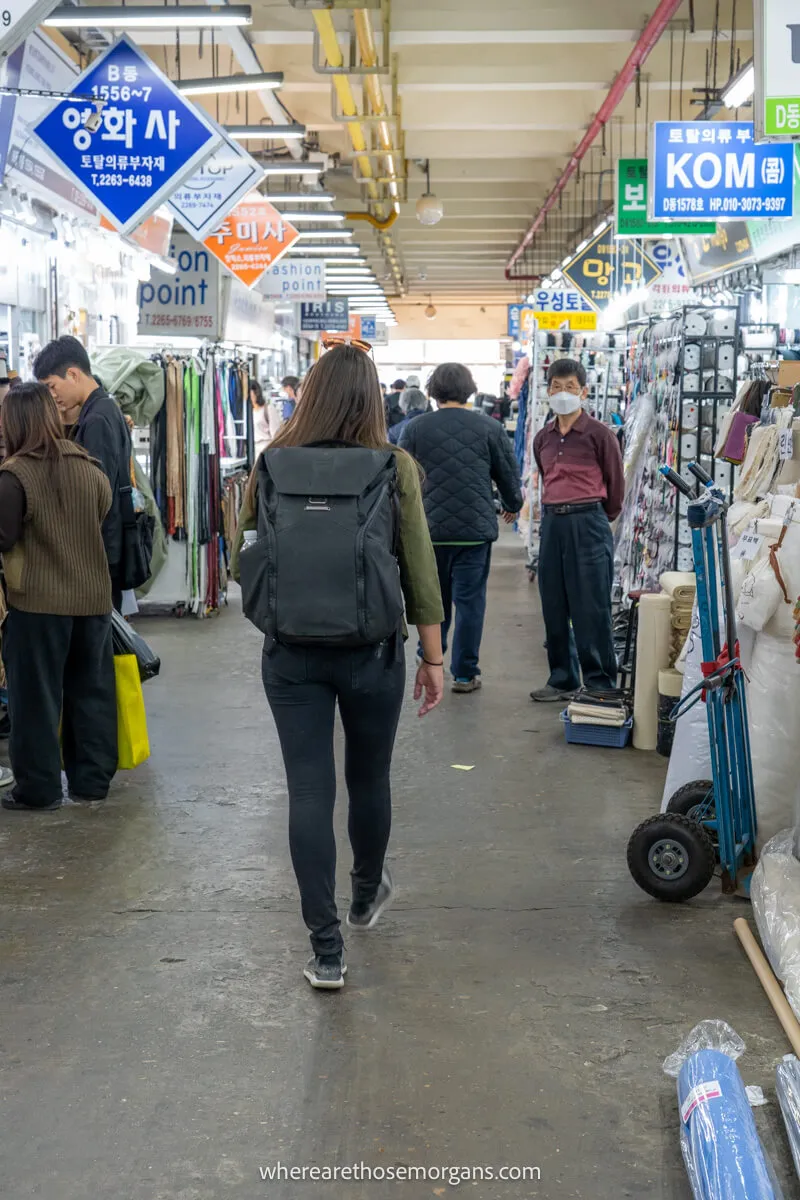
Another popular Seoul activity is the Dongdaemun Market. This is Korea’s largest wholesale and retail shopping district with a whopping 26 malls and 30,000 speciality shops.
- Address : 272 Jong-ro, Jongno-gu
- Subway stop : Dongdaemun Station (line 4, exit 8) or Dongdaemun History & Culture Park Station (line 4, exits 1/14)
You’ll find many types of products ranging from silks, fabrics, shoes, accessories, leather, electronics, office supplies and so much more. We had very limited space in our suitcases so we couldn’t buy anything, but it was fun to walk around the market .
9. Bukhansan National Park
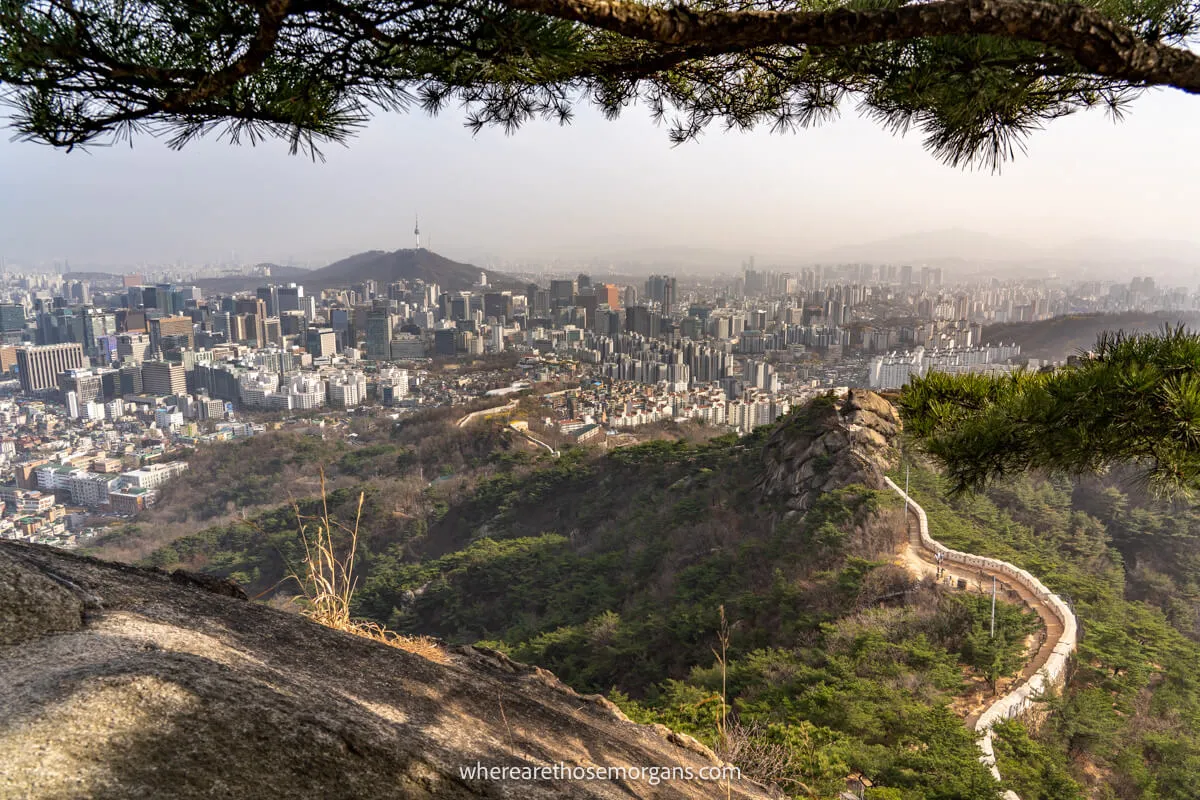
Those looking for adventurous things to do in Seoul should look no further than Bukhansan National Park . Designated as the 15th national park of Korea in 1983, Bukhansan offers visitors gorgeous stretches of mountain peaks and crystal clear streams stretching between Seoul and Gyeonggi-do.
The park is divided into two main sections with Bukhansan Mountain to the south and Dobongsan Mountain to the north with Uiryeong Pass in the middle. It’s an extremely popular park with over 20 million residents living within the vicinity.
We think the best part about Bukhansan is the accessibility from just about anywhere . If you want to hike, but would feel more comfortable with a guide, check out these popular tours on Viator .
10. Inwangsan Peak
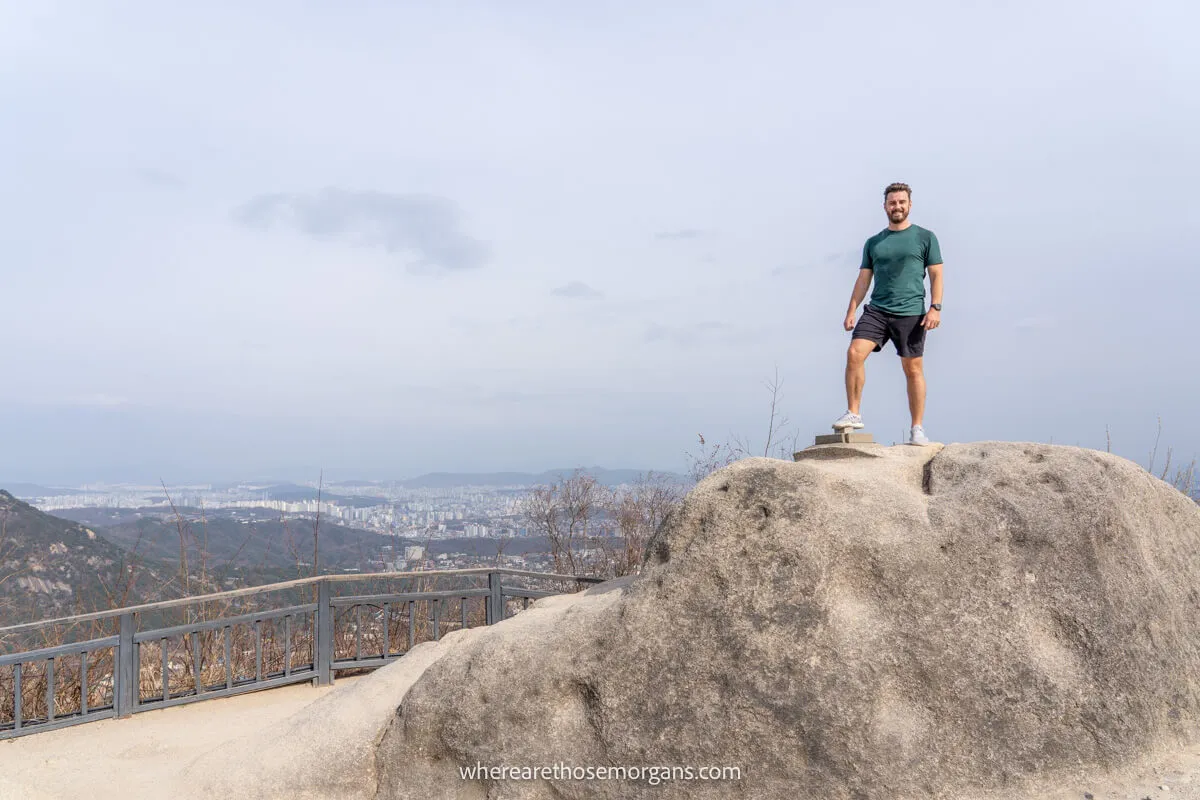
Another outdoorsy thing to do in Seoul is climb Inwangsan Peak. This is Seoul’s main hiking trail which follows the Seoul City Wall and passes through the summit at 338m. Built in 1396 to defend the capital during the Joseon Dynasty, the Hanyangdoseong or the Seoul City Wall is 18,600m long. This barrier passes through Inwangsan, Bugaksan, Naksan and Namsan peak.
There are numerous ways to access this trail and we highly recommend this hike if it’s your first visit to Seoul. Even with two weeks, we were limited with time and we didn’t want to lose an entire day hiking in Bukhansan National Park so we opted for Inwangsan Peak .
READ : Top rated hiking apps
11. Lotte World Amusement Park
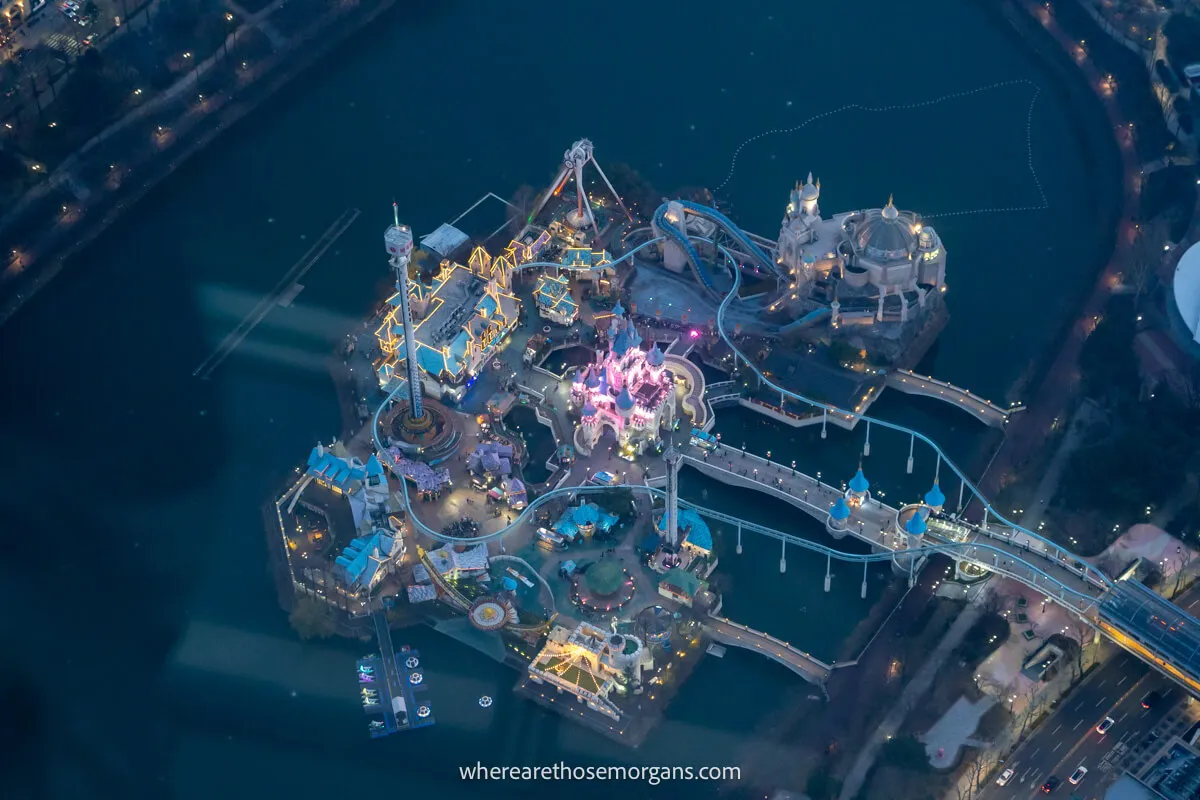
Lotte World is an extremely popular entertainment complex located in the middle of the city. Here you’ll find an enormous indoor theme park, a luxury hotel, an observation tower and Magic Island , an outdoor amusement park.
- Address : 240 Olympic-ro, Songpa-gu
- Subway stop : Jamsil Station (line 2/8, exit 4)
We think Lotte World is one of the best things to do in Seoul with kids , but there a few different tickets and pass options so make sure to purchase the correct one for your visit. Here are popular ticket options for Lotte World:
- Lotte World One Day Ticket
- Lotte World Aquarium
- Lotte World Tower
Travel Tip : Lotte World Amusement Park is included on the Klook Seoul Pass or you can visit the Busan Lotte World to compare parks.
12. Seoul Sky Observatory
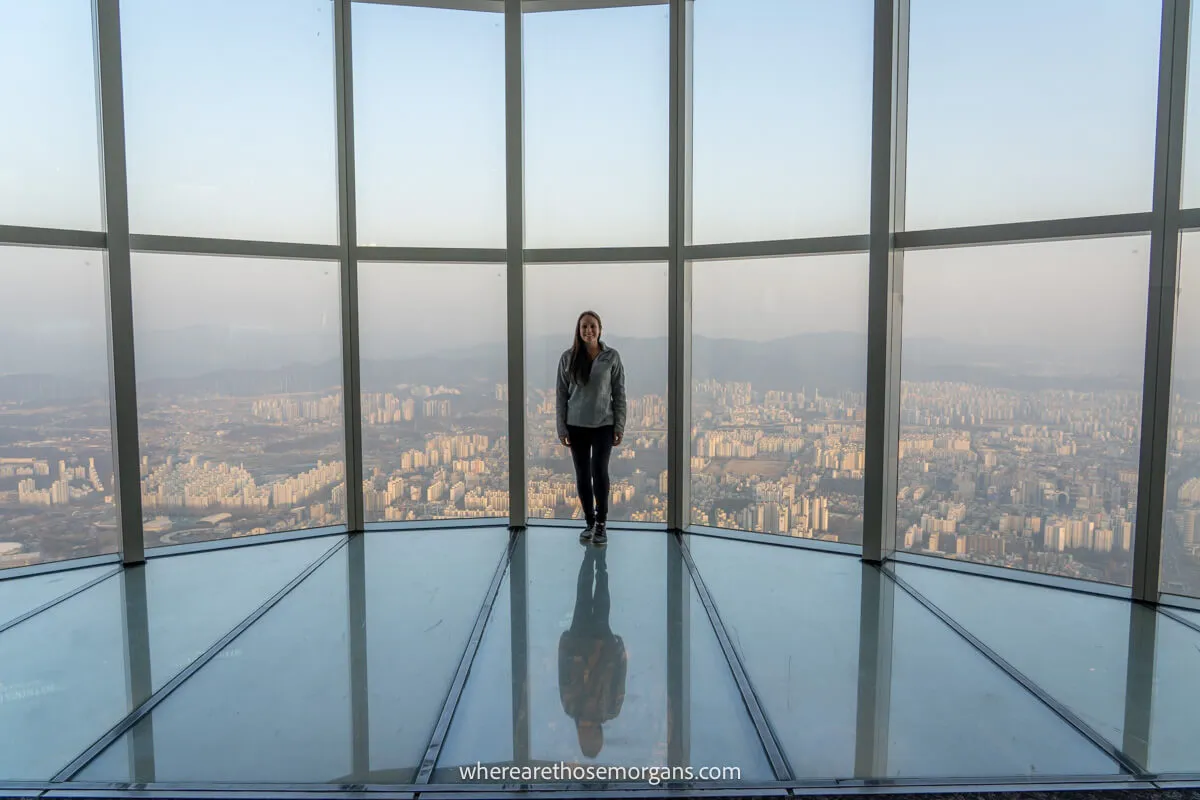
The Seoul Sky Observatory is located in Lotte World Tower. This is the tallest building in South Korea and it’s one of the cool things to do in Seoul. Interestingly, the Lotte World Tower currently holds the record as the world’s 6th tallest building standing at 1,819 ft (554m) only just passing the One World Trade Center in NYC.
- Address : 300 Olympic-ro, Songpa-gu
- Subway stop : Jamsil Station (line 2/8, exit 2/11)
If you’ve visited the Namsan Seoul Tower, we still recommend you climb this observatory because it’s very different. Klook offers a great deal on tickets here .
READ : How to visit the Seoul Sky Observatory
13. Nanta Show
A unique thing to do in Seoul is attend the Nanta Show. This is currently the longest running show in Korean history and features four hilarious chefs as they cook under pressure. Sadly, we didn’t have enough time for a show when we visited, but it’s on our bucket list for next time.
Shows last about 90 minutes and Nanta combines Korean folk songs with modern day music. It’s a nonverbal performance so there is no language barrier and anyone can enjoy the performance . Here are tickets for the popular Nanta Show:
- Get Your Guide
Compare prices before booking your Nanta Show to secure the best price.
Travel Tip : There is a NANTA Theater in Myeongdong and Hongdae so make sure you chose the correct theater when booking tickets.
14. Dongdaemun Design Plaza (DDP)
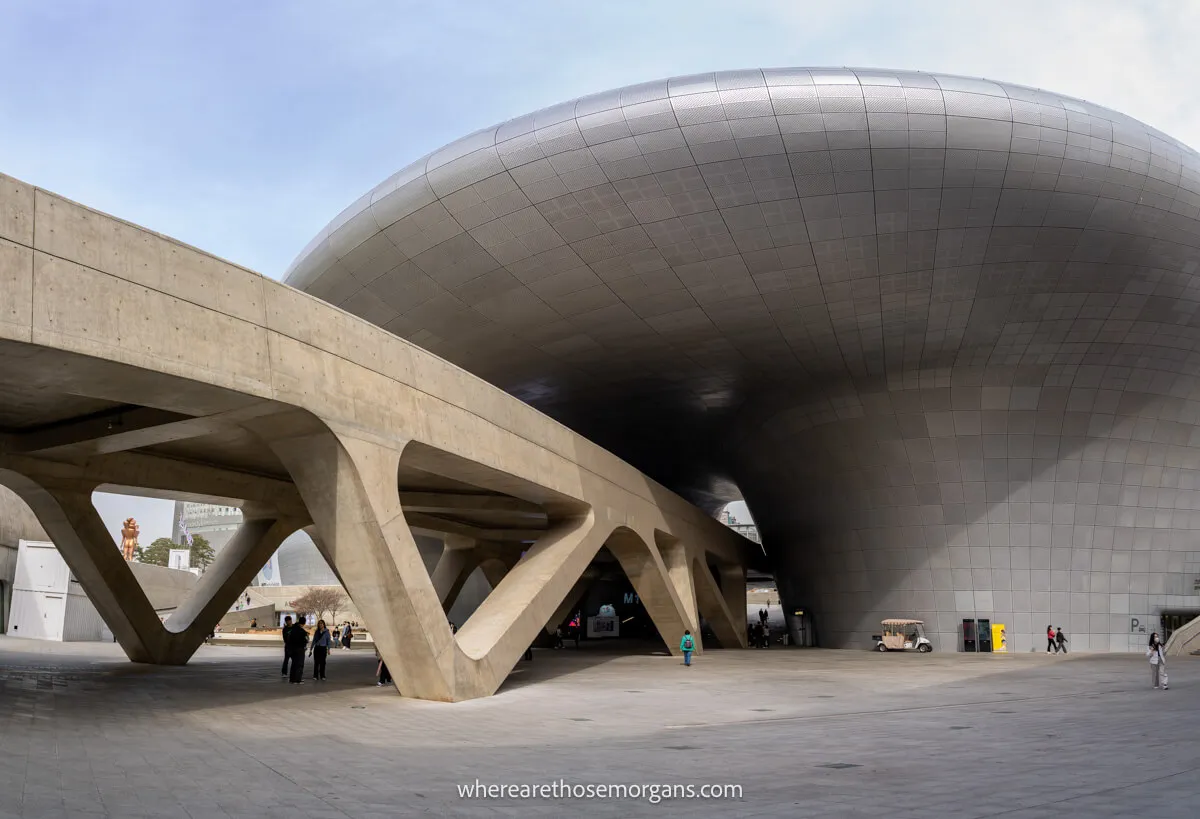
Dongdaemun Design Plaza (DDP) stands for Dream, Design, and Play . This stunning complex holds various exhibitions, fashion shows, conferences, forums and international events. Designed by Zaha Hadid , the stunning curves and bold shapes of the DDP complex attract photographers and influencers alike so you can expect it to by busy.
- Address : 281 Eulji-ro, Jung-gu
- Subway stop : Dongdaemun History and Culture Park Station (line 2/4/5, exit 1) or Dongdaemun Station (line 1/4, exit 7)
Travel Tip : We loved the Magis Spun Chairs in the Designers Lounge so see if you can find them!
15. Cheonggyecheon Stream
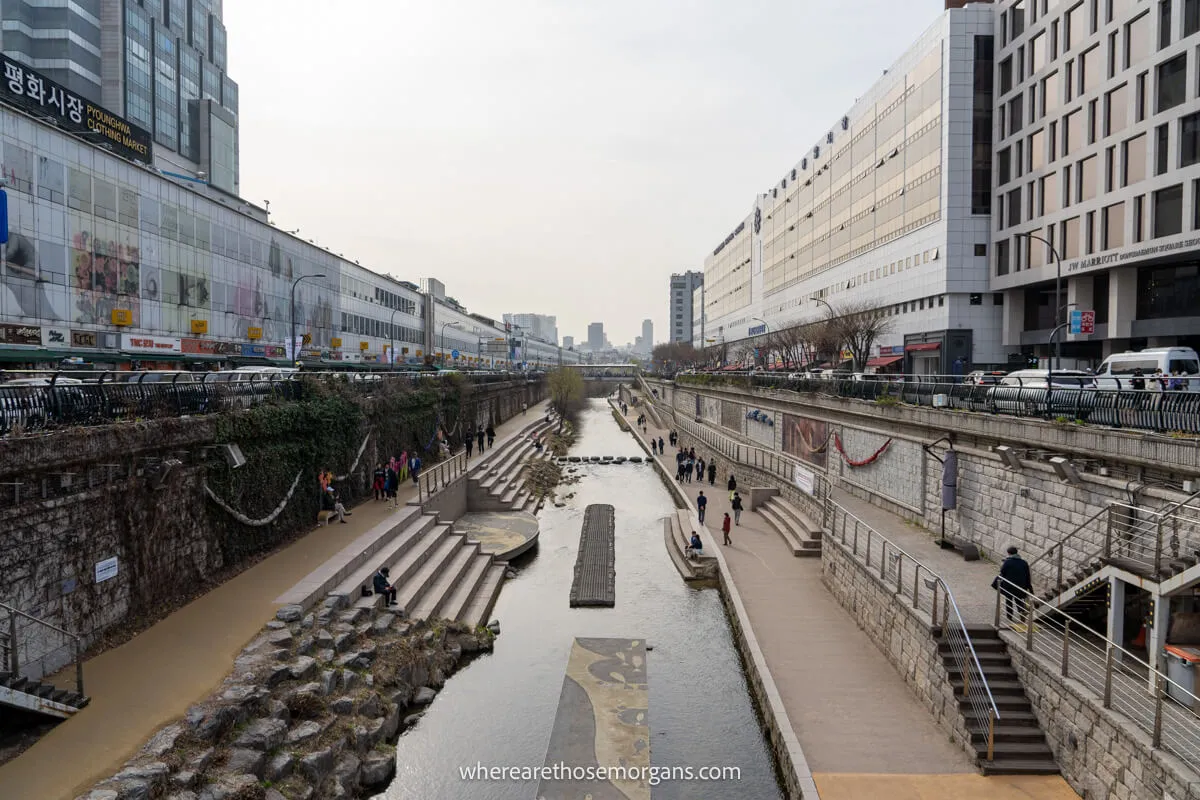
As part of an urban renewal project, the Cheonggyecheon Stream runs straight through downtown Seoul . It mimics a stream that was present during the Joseon Dynasty (1392-1910). You’ll find numerous informational plaques which tell some very interesting tales along the route.
- Region : Jongno-gu
- Subway stop : City Hall Station (line 1, exits 4/5), Euljiro 1-ga Station (line 2, exits 2/3) or Dongdaemun Station (line 4, exits 6/8)
The Cheonggyecheon Stream begins in the Cheonggye Plaza and passes under 22 bridges before eventually flowing into the Hangang River . You can also visit the Cheonggyecheon Museum for a non-touristy thing to do in Seoul if you want to know more about the project and this area.
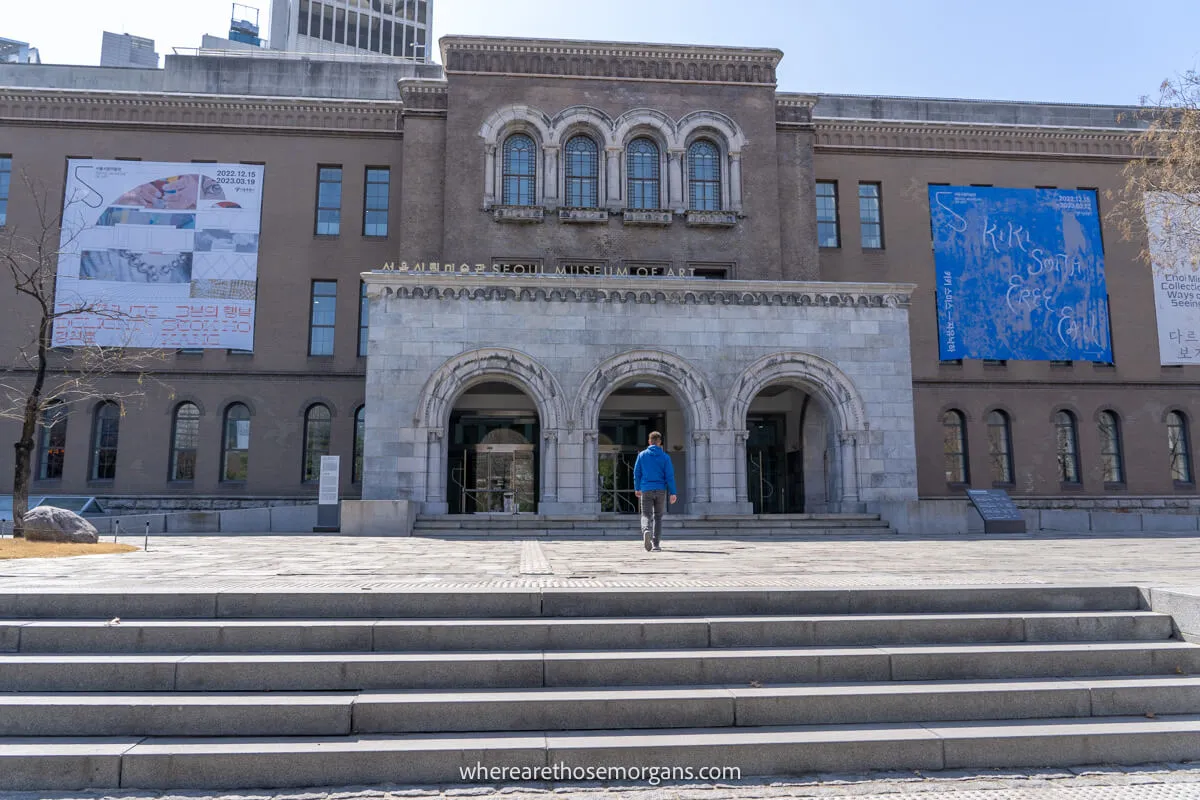
The Seoul Museum of Art (SeMA) is a modern art museum featuring 6 exhibition halls, a lecture hall, a library and visual reference materials.
- Address : 61 Deoksugung-gil, Jung-gu
- Subway stop : City Hall Station (line 1/2, exit 10) or Seodaemun Station (line 5, exit 6)
Opened in 1988, this three story building holds internationally renowned exhibitions twice a year. We like SeMA because the permanent exhibitions are free to visit , but you’ll have to pay for special exhibits.
17. War Memorial Of Korea
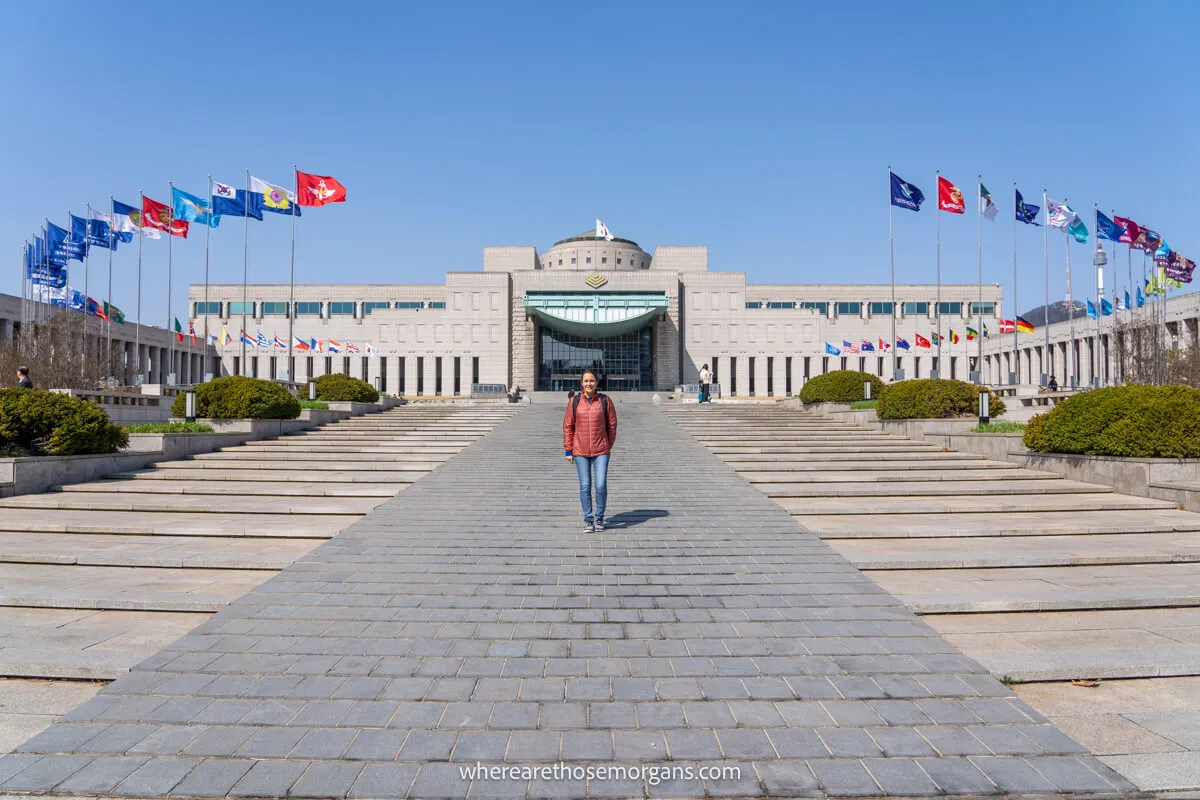
One of the top things to do in Seoul is visit the War Memorial of Korea . Not only is the War Memorial a free activity, but it’s one of the best memorials we have ever seen . The main hall pays tribute to both Korean and international allies showcasing the names of soldiers who gave their life to protect Korea.
- Address : 29 Itaewon-ro, Yongsan-gu
- Subway stop : Samgakji Station (line 4, exit 1), (line 6, exit 12) or Namyeong Station (line 1, exit 1)
In addition to the memorial, you can visit the War History Room, Korean War Room, an open air exhibition area and a children’s museum. We knew this would be a large complex so we gave ourselves almost an entire day to visit the memorial and we still couldn’t see everything . So if you’re interested in Korean history, you should plan to spend several hours if not a whole day here.
Travel Tip : We found a cheap and cheerful restaurant near the memorial called Hangang Burger , if you need a quick bite.
18. Starfield COEX Mall
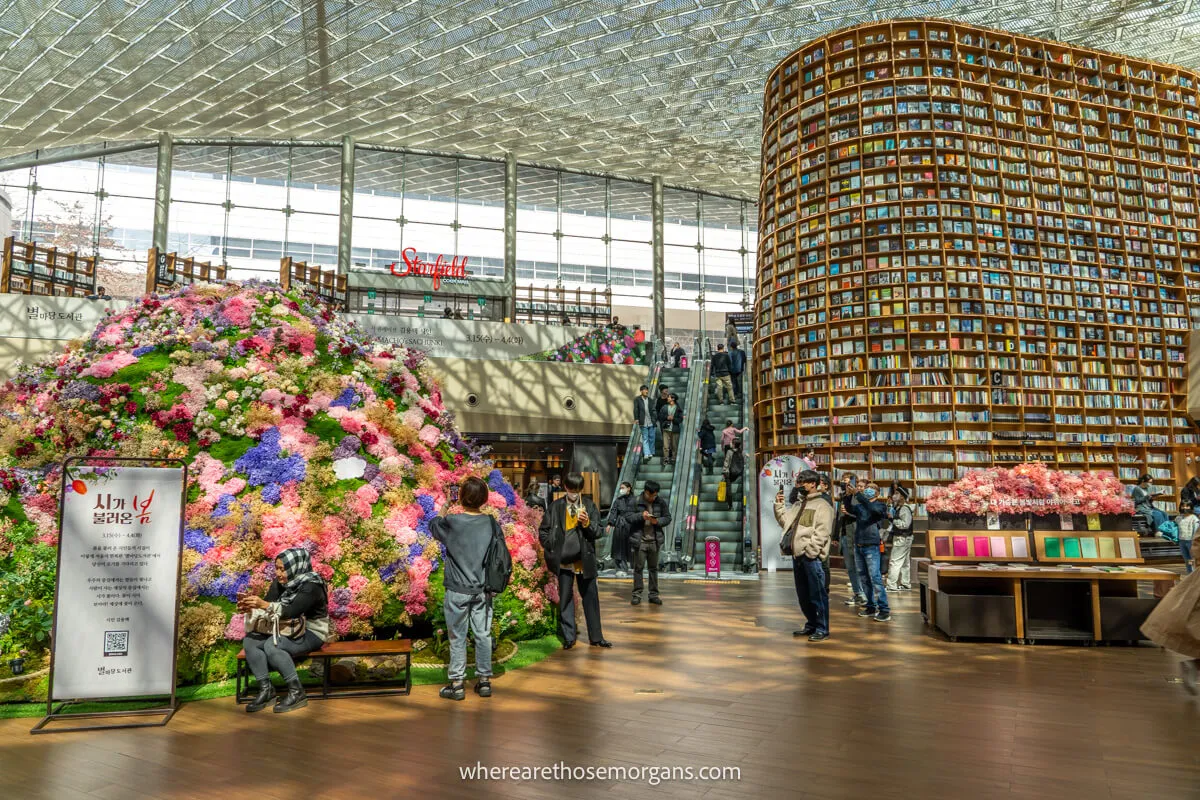
One of the best things to do in Seoul for young adults is visit the Starfield COEX Mall because it’s the largest underground mall in Asia with hundreds of stores. Here you’ll find both domestic and international brands, numerous dining options, the Kimchi Museum, the COEX Aquarium , and a Megabox Cineplex with 17 screens.
- Address : 513 Yeongdong-daero, Gangnam-gu
- Subway stop : Samseong Station (Subway Line 2, exit 5/6) or Bongeunsa Station (line 9, exit 7)
A popular place to visit for tourists is the Starfield Library with two stories of floor to ceiling bookshelves. We also loved the running track spanning throughout the bottom of the mall.
19. Bongeunsa Temple
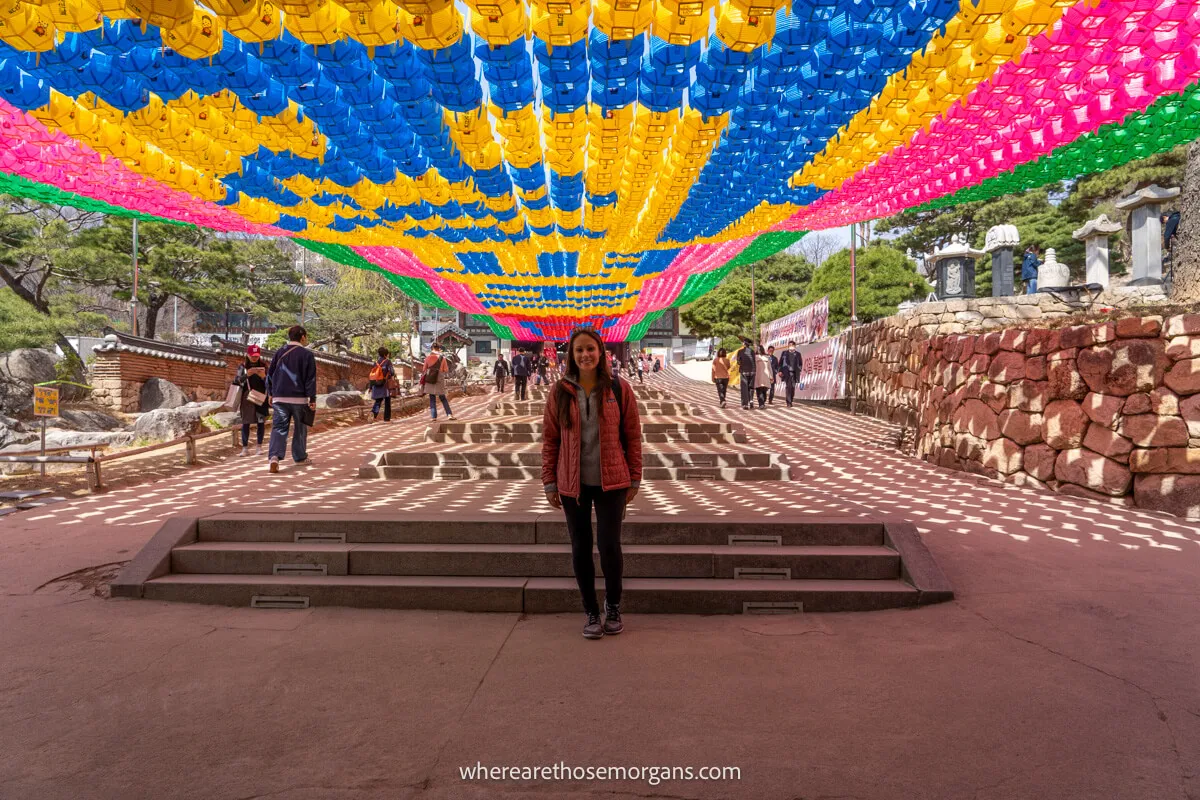
Located very close to Starfield COEX Mall, Bongeunsa is a Buddhist temple with a long history dating back more than 1,200 years ago. It’s well known for Templestays which helps to spread the culture worldwide.
- Address : 531 Bongeunsa-ro, Gangnam-gu
- Subway stop : Samsung (line 2, exit 6), Chungdam (line 7, exit 2) or Bongeunsa (Line 9, exit 1)
A highlight of Bongeunsa is the 28m (91 ft) stone statue of Maitreya known as the Future Buddha. This is one of the tallest stone statues in Korea so it’s certainly worth a visit. You’ll find the statue towards the back of the temple complex.
20. Seoul Olympic Park
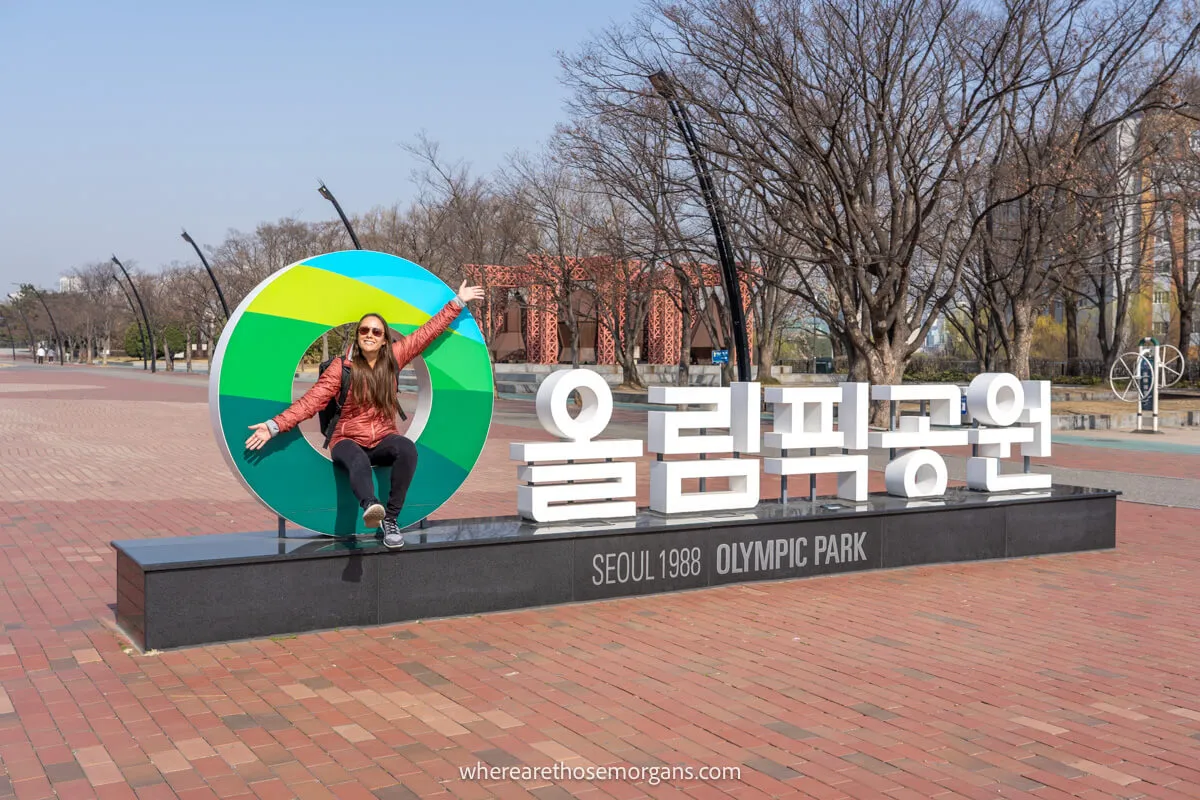
Built for the 1988 games, the Olympic Park is a must do in Seoul because it’s now divided into several fun zones . Locals and tourists alike can visit the beautiful green space filled with sculptures and sports venues.
- Address : 424 Olympic-ro, Songpa-gu
- SubwaysStop : Olympic Park Station (line 5, exit 3) or Mongchontoseong Station (line 8, exit 1)
This space also houses Korea’s largest sports arena and beautiful flowers bloom throughout the entire park depending on the time of year. Additional highlights include the Mongchon Fortress walking paths, the World Peace Gate, numerous dialogue sculptures, 88 Lake and an ice skating rink in winter. Popular places in Olympic Park for photos include:
- Wild flower garden
- Gourd tunnel
- Pink muhly Ggrass
- Golden ginkgo tree road
Travel Tip : If you don’t want to walk around the entire park, you can rent a two wheeled or four-wheeled bicycle near the SK Olympic Handball Gymnasium.
21. Visit A Themed Cafe
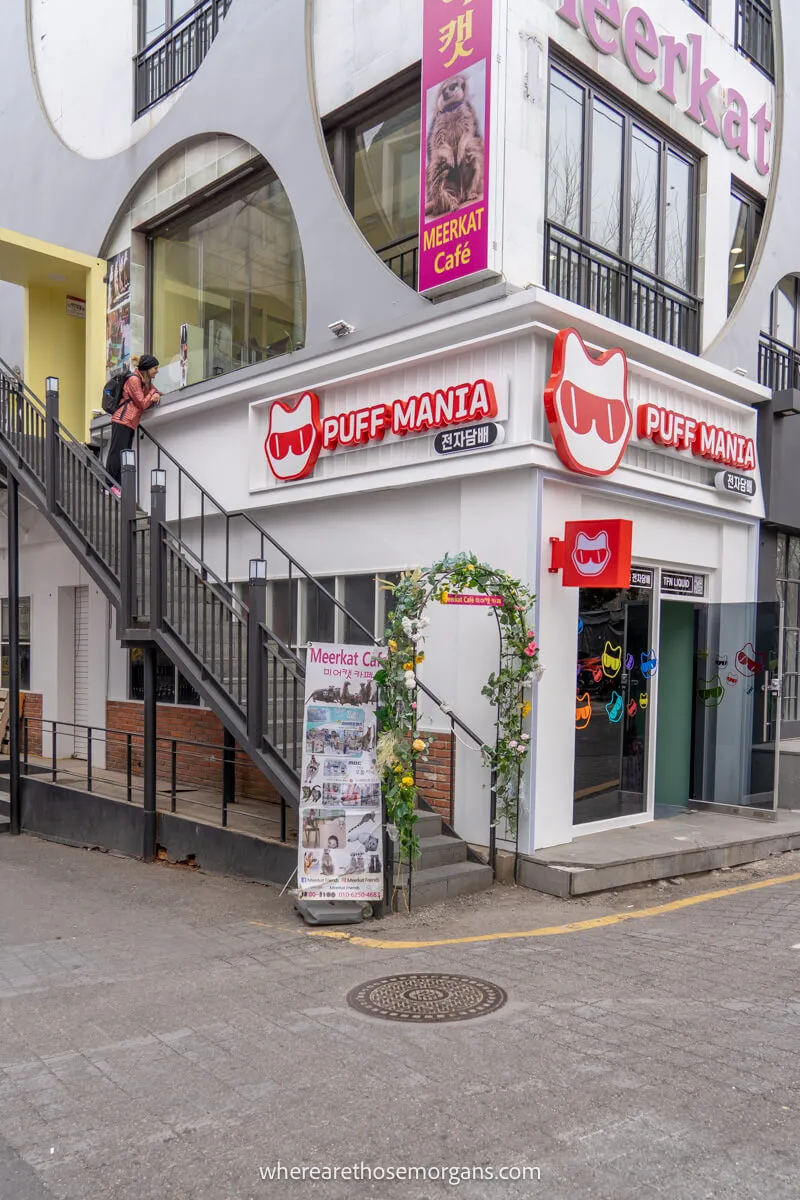
Themed cafes are one of the unique things to do in Seoul because you can find a cafe for just about anything. Below are some of the most popular themed cafes:
- 943 King’s Cross – Harry Potter cafe (Hongdae)
- Ddong Café – Poop cafe (Insadong)
- StyleNanda Pink Pool Cafe – Pink everything cafe (Hongdae)
- Greem Cafe – 2D cafe (Hongdae)
Before visiting any type of animal cafe, we highly recommend you do a little research to ensure you are supporting a cafe with ethical business practices. This is our responsibility as travelers .
Here are important things to consider before visiting an animal cafe:
- Reviews – Always read reviews and if you see animal neglect, it’s important to leave a negative review to warn others
- Type of pet – Wild or undomesticated pets should not be in a cafe
- Understand where the animals came from – For example, rescued strays loving their new life in a cafe is okay
- The cafe doesn’t limit people – This could induce stress on animals
- Animals don’t have a private space – Even animals need a break now and then
That being said, we have visited amazing animal cafes around the world run by incredible people who are making a huge difference . Just please do your homework prior to visiting!
22. National Folk Museum Of Korea
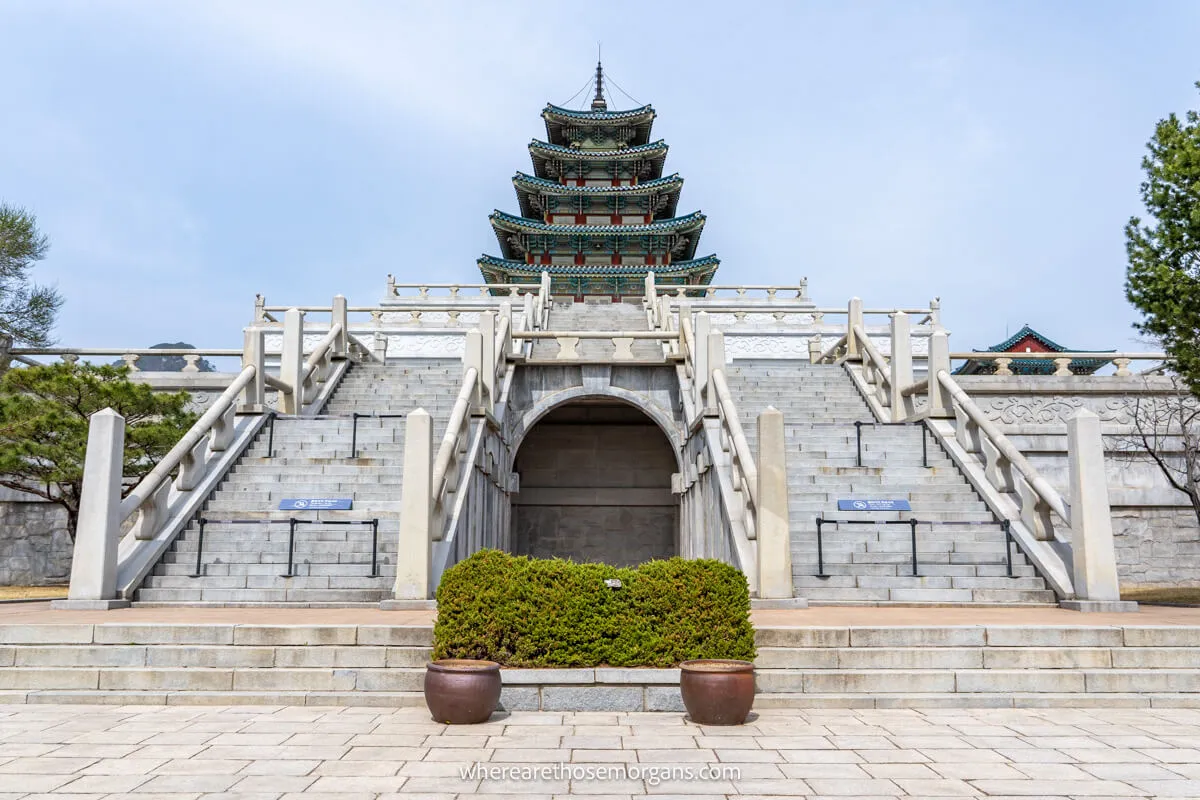
Located near Gyeongbokgung Palace, the National Folk Museum of Korea features over 4,000 artifacts showcasing lifestyles, traditions and history of Korean culture. The entire complex includes three permanent exhibits along with two special exhibits, an open air space and a children’s museum.
- Address : 37 Samcheong-ro, Jongno-gu
- Subway stop : Auguk Station (line 3, exit 1), Gyeongbokgung (line 3, exit 5) or Gwanghwamun Station (line 5, exit 2)
Admission to the National Folk Museum is free with a Gyeongbokgung Palace ticket . You can also join a free guided tour at 10:30 and 14:30 in front of Exhibition Hall 1.
23. Noryangjin Fisheries Wholesale Market
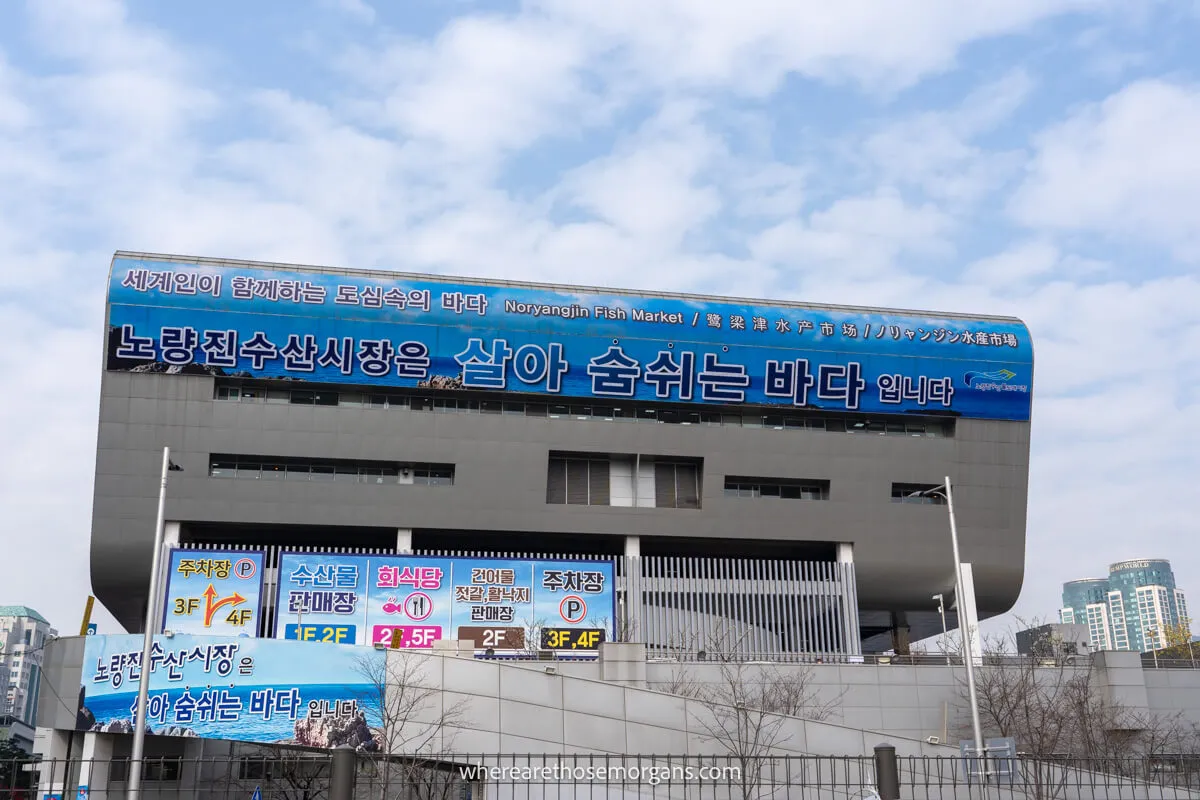
The Noryangjin Fish Market is the largest and oldest seafood market in Korea with a massive floor space and 700 vendors. It’s open 24 hours a day, but if you want to see the bustling market in full glory, come in the morning during the auction or during the day before the stalls close.
- Address : 674 Nodeul-ro, Dongjak-gu
- Subway Stop : Noryangjin Station (line 1, exit 1)
For one of the freshest meals of your life , you can purchase live seafood at numerous stalls and then have it prepared at a restaurant right upstairs. Or you can try this Noryangjin Fish Market Guided Tour to learn about the local food culture and try fresh seafood.
Travel Tip : If you want to get a good deal here, you’ll have to bargain. Make sure you also check the cooking charges before ordering because visitors often complain about being overcharged.
24. Seodaemun Prison
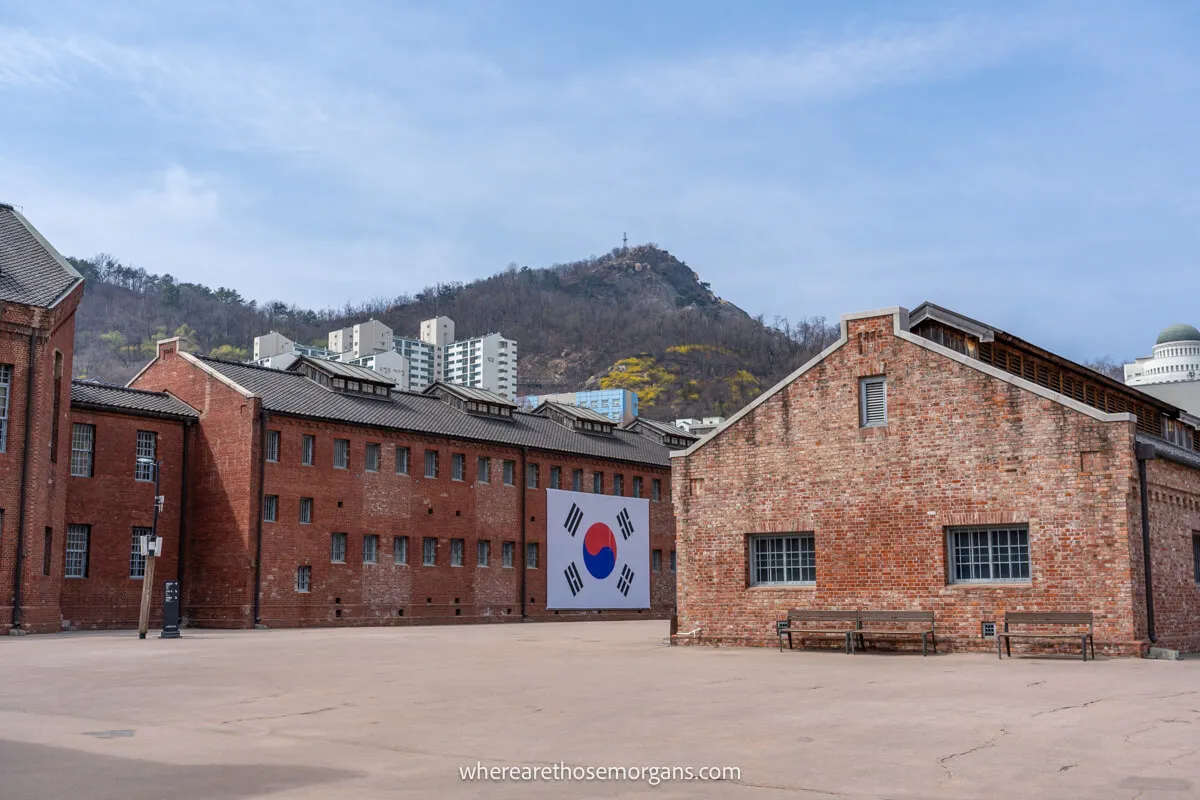
Opened in 1908 as Gyeongseong Prison, the Seodaemun Prison was used to imprison independence activists during the Japanese occupation until the liberation of Korea in 1945. While the Seodaemun Prison is not often one of the top attractions in Seoul, it’s definitely worth visiting because it commemorates the ideals of peace and freedom in Korea.
- Address : 251 Tongil-ro, Seodaemun-gu
- Subway stop : Dongnimmum Station (line 3, exit 5)
Visitors can walk through numerous exhibition halls, prison buildings, labor buildings and many other sites used during these hard times. We almost didn’t visit this museum because it’s not often included on rounds ups, but we were happy we did because we learned so much about Korea.
READ : What to see inside Seodaemun Prison
25. National Museum of Korea
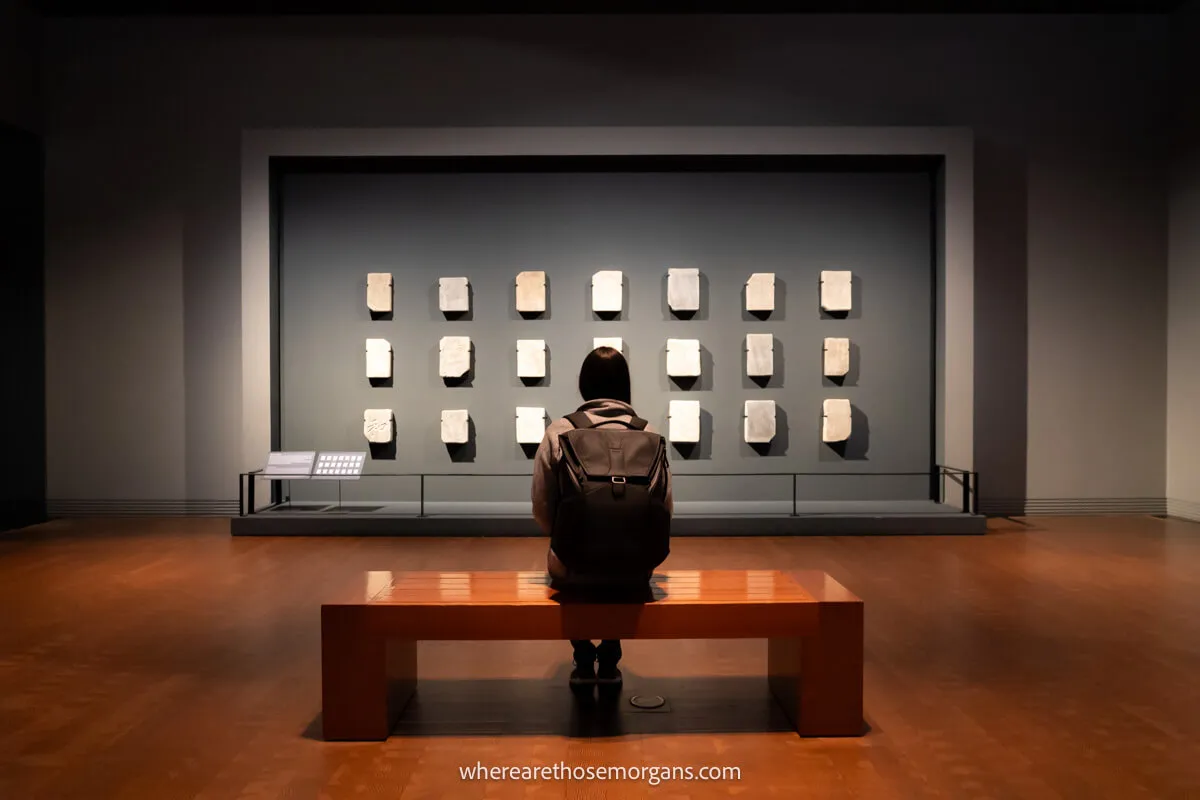
Established in 1945, the National Museum of Korea should be at the top of your bucket list for Seoul because it’s the most extensive museum in the Republic of Korea . The museum has 6 large galleries showcasing prehistoric history, medieval works, calligraphy, painting, Asian art, sculpture and crafts.
- Address : 137 Seobinggo-ro, Yongsan-gu
- Subway stop : Ichon Station (line 4, exit 2)
Not only do we like this museum because there’s so much to see, but it’s also free to visit . We highly recommend you give yourself several hours to explore this incredible museum.
Travel Tip : Guided tours are available almost every day in Korean, English, Chinese, and Japanese beginning on the first floor near the Korean Empire Gallery. French is available on Saturdays.
26. Hongdae
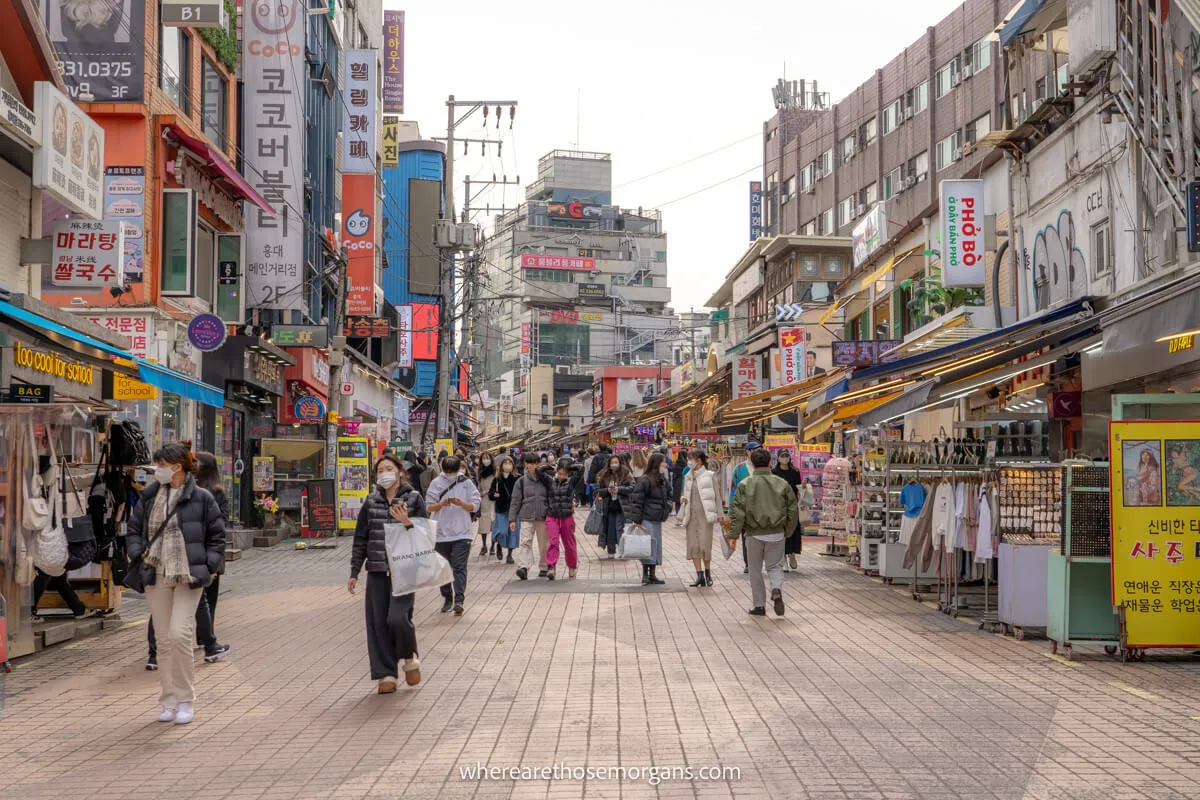
Hongdae is a popular neighborhood located near Hongik University which is very well known for its fine arts program. So it should come as no surprise that Hongdae has an extremely creative vibe . The intricate alleys are also filled with restaurants, shops, clubs or pubs and sometimes you can see various street performers.
We like Hongdae because there are amazing street food options everywhere . If you’re visiting Seoul for the first time, be sure to check out the Kakao Friends Hongdae flagship store or take a walk down Hongdae Mural Street .
READ : Best hotels in Hongdae
27. Myeongdong’s Walking Street
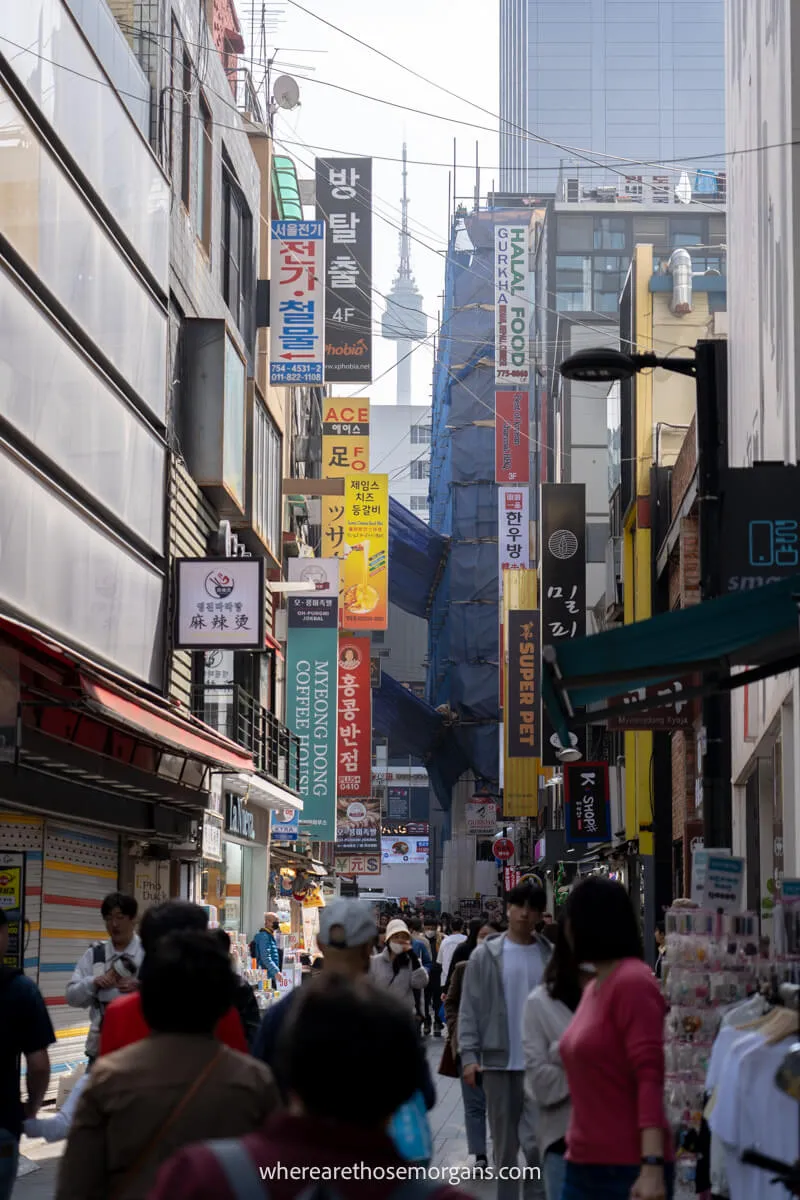
Another great thing to do in Seoul is take a stroll through the epicenter of the fashion world along Myeongdong’s walking street. It can be compared to Orchard Road in Singapore or Bukit Bintang in Kuala Lumpur. There are hundreds of shops, bars and restaurants hidden within the labyrinthine alleyways.
Visitors can shop for everything from high end boutiques to international brands. We love this famous shopping district because many streets are pedestrian friendly and you won’t have to contend with cars so you can shop without a worry.
Every night, the Myeongdong Night Market begins around 3pm and lasts until 11pm. But we recommend you arrive on an empty stomach to make the most of your visit!
READ : Best hotels in Myeongdong
28. Visit Gangnam
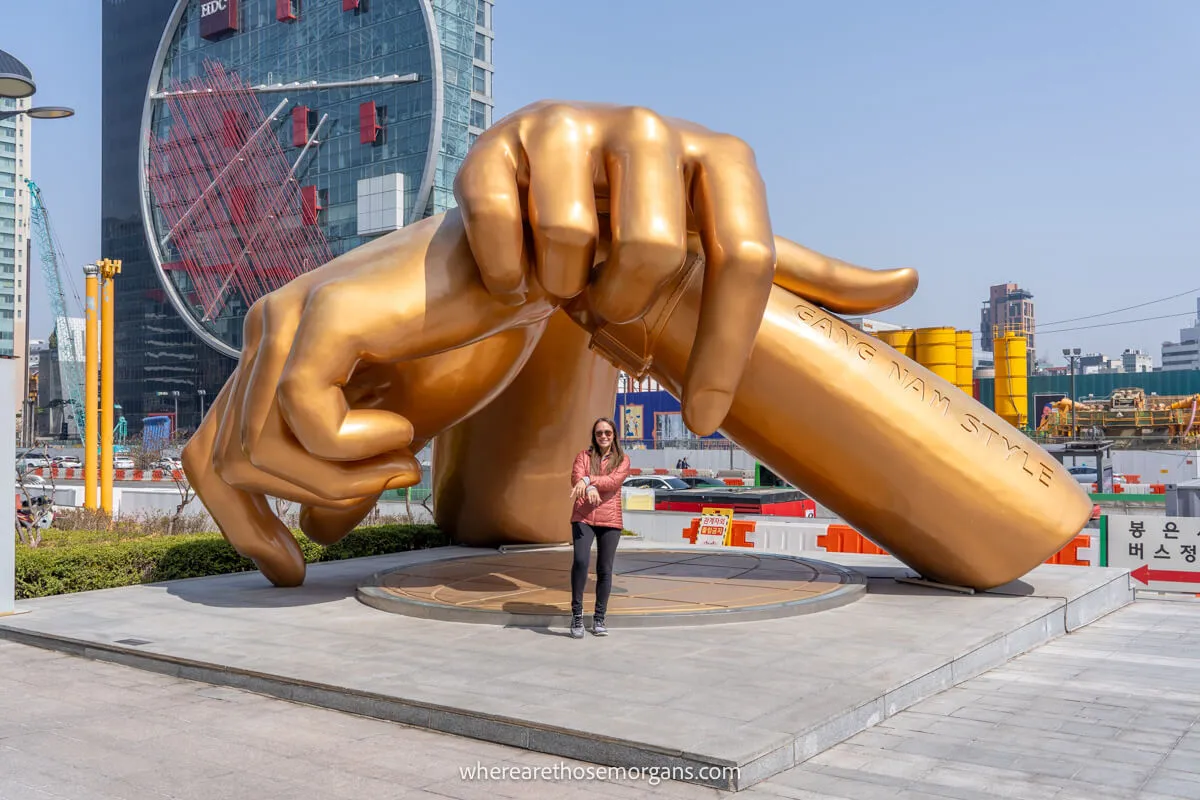
Made popular by the song Gangnam Style in 2012, this is the hip and trendy neighborhood in Seoul. It’s well-known for luxury department stores featuring Chanel, Louis Vuitton, Dior and Gucci. But there are more things to do in Gangnam than just shopping. Visitors can stroll down K-Pop Avenue to see the colorful teddy bears or stop by the Bongeunsa Temple . Gangnam has something for everyone.
READ : Best hotels in Gangnam
29. Seolleung and Jeongneung
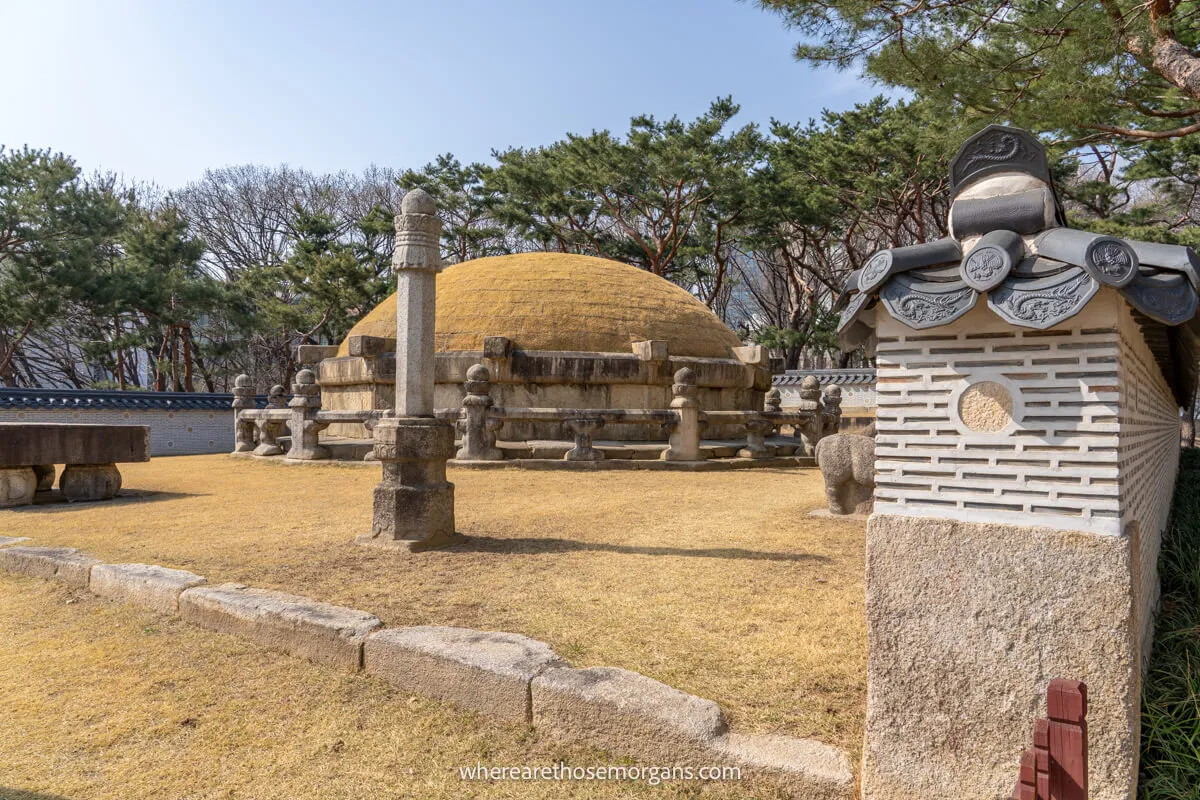
Now part of a UNESCO World Heritage Site, the royal tombs are a must visit when in Seoul because the complex is a resting place for the rulers of the Joseon Dynasty . These royal tombs include a collection of 40 tombs scattered over 18 locations , but you won’t need to visit all of them because the Seolleung and Jeongneung Royal Tombs can be found right in the city.
- Address : 1 Seolleung-ro 100-gil, Gangnam-gu
- Subway stop : Seolleung Station (line 2, exit 10) or Seonjeongneung Station (line 9, exit 3)
The Seolleung Royal Tomb belongs to King Seongjong , the 9th ruler of Joseon and his third consort, Queen Jeonghyeon . Here you can also visit the Jeongneung Royal Tomb which belongs to King Jungjong , the 11th ruler of Joseon. These were one of the most interesting things we visited in Seoul during our trip.
30. Seoul Museum Of History
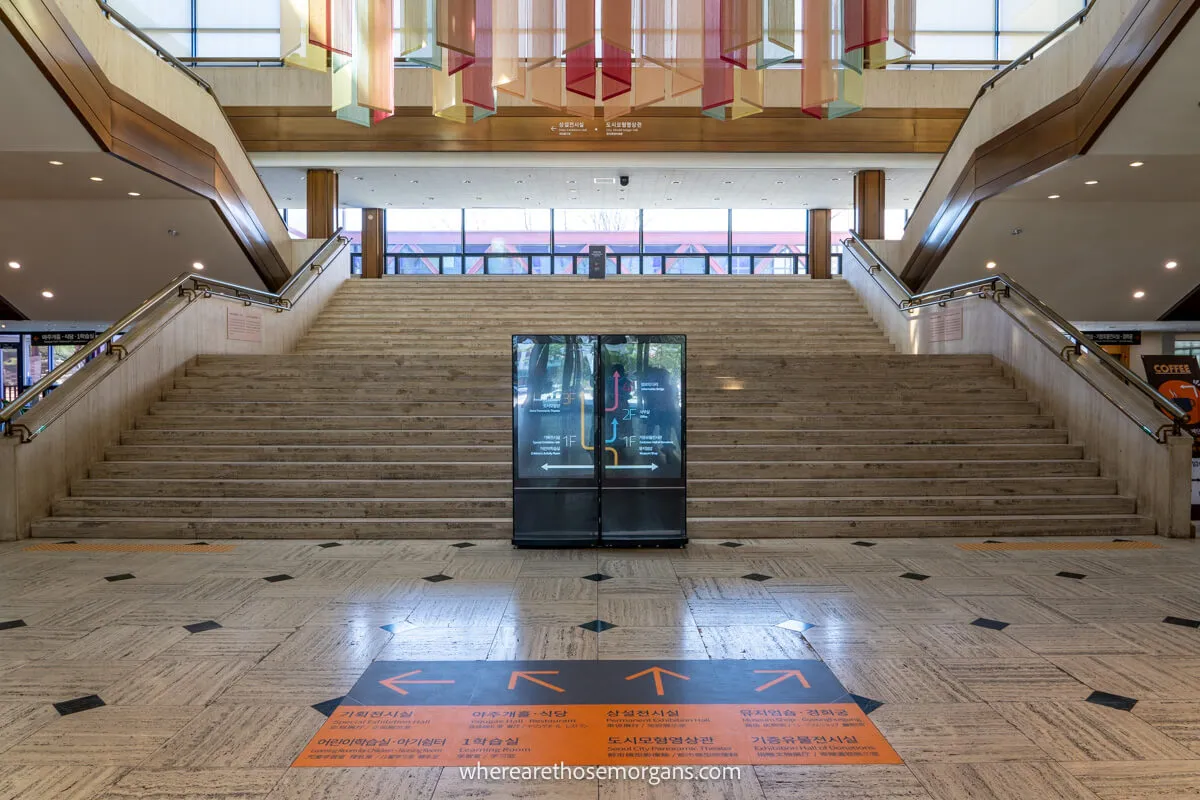
Another museum to add to your list is the Seoul Museum of History . Opened in 1985, this museum showcases the history and culture of Seoul from the Joseon Dynasty to present day. It’s located right next to Gyeonghuigung Palace so it can be easily visited in tandem with the royal palace .
- Address : 55 Saemunan-ro, Jongno-gu
- Subway stop : Gwanghwamun Station (line 5, exit 7)
We think this museum is a hidden gem because it’s free to visit and filled with incredible information spanning 600 years of history. During our visit, it was not busy so it was very peaceful.
31. Bank Of Korea Money Museum
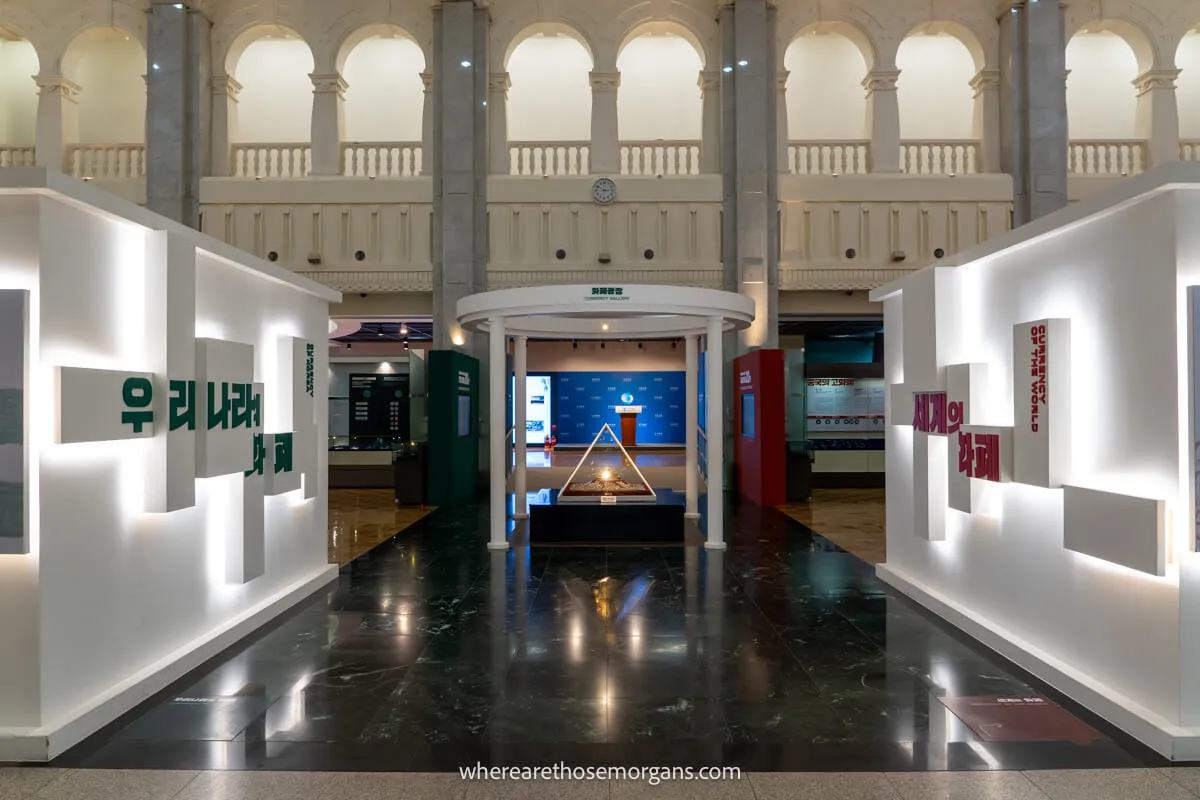
The Bank of Korea Money Museum is one of the cool things to do in Seoul because this free museum demonstrates the history of currency throughout the years . Guided tours are free, but must be booked. Audio guides are also available in Korean, English, Japanese and Chinese.
- Address : 39 Namdaemun-ro, Jung-gu
- Subway stop : City Hall Station (line 1/2, exit 7), Euljiro1-ga (line 2, exit 7) or Hoehyeon Station (line 4, exit 7)
We love how this museum not only focused on Korean currency, but on how money has changed over time. As travel bloggers, we thought the currency from around the world exhibit was a must see !
Travel Tip : Find the replica vault and play with the interactive exhibits to experience how heavy money can be. Think you could carry a lot of money out of the vault?!
32. Find A Cocktail Bar
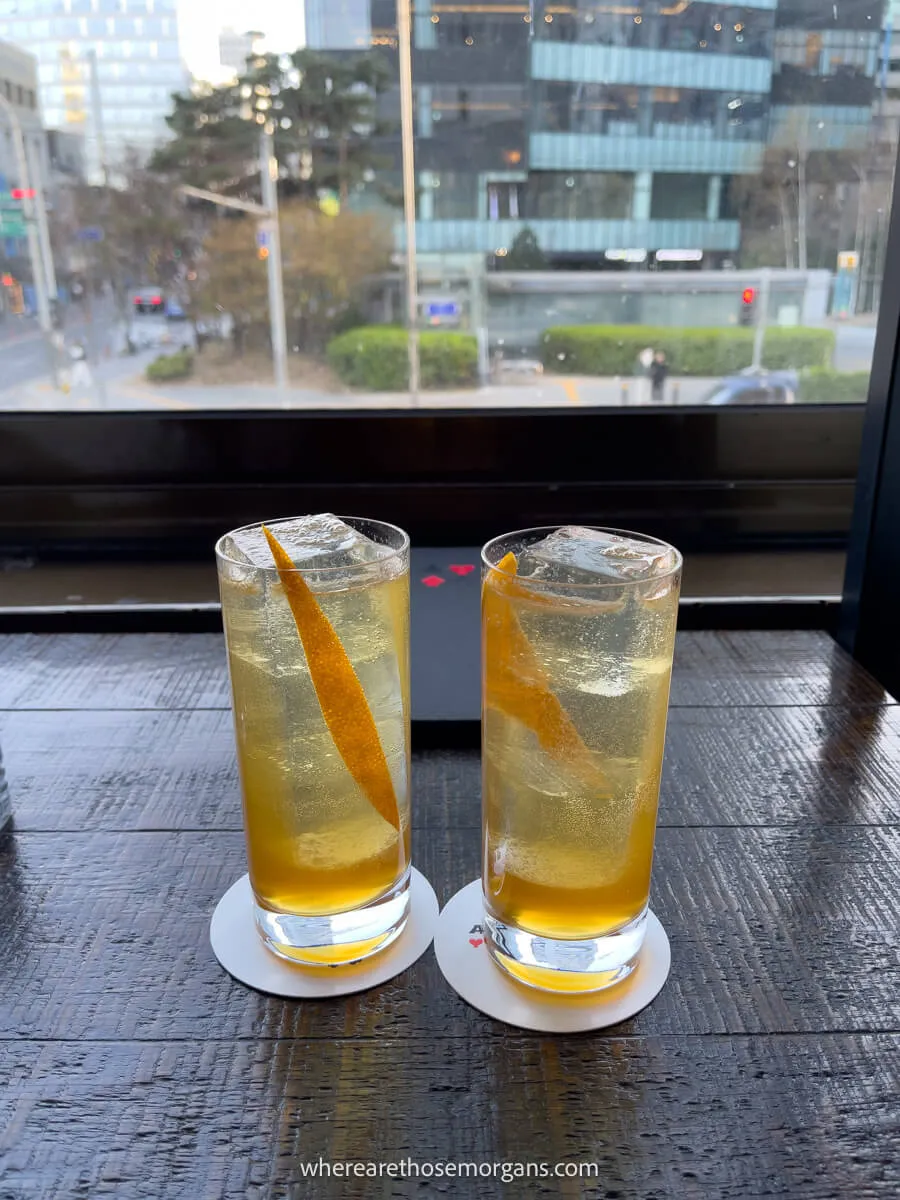
Seoul’s nightlife is known for being one of the best in Asia . You’ll find numerous clubs, bars and cocktail bars in every neighborhood. We think visiting the numerous cocktail bars is one of the fun things you can do in Seoul with friends and we couldn’t help slipping into a few ourselves in between sightseeing.
Here are some popular cocktail bars:
- Alice Cheongdam – Gangnam
- Charles H . – Jongno
- Bar Cham – Jongno
- The Griffin Bar – Jongno
- Southside Parlor – Yongsan
You won’t have to travel far to find a cocktail bar so just ask the locals or check out this popular pub crawl .
33. Try Korean BBQ
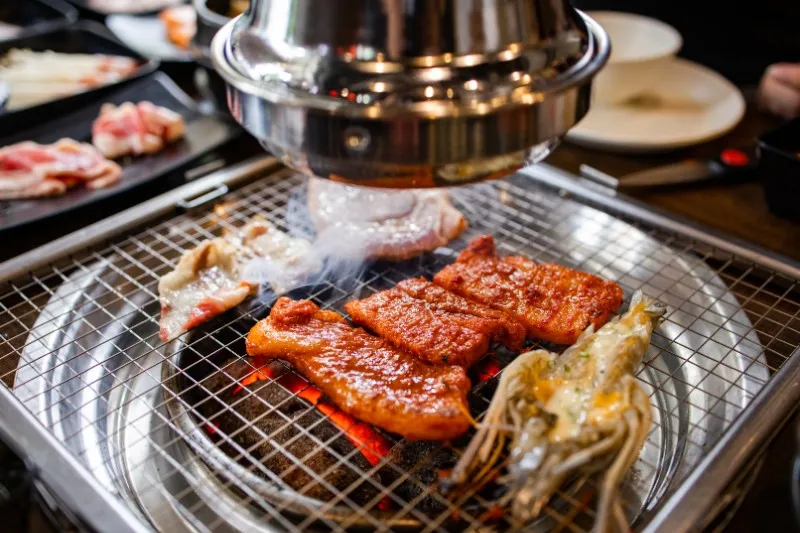
One of the best things to do in Seoul is experience a Korean BBQ. The meal involves marinated meat cooked over a hot bbq in the middle of a table . Typical meat cuts include very tender pork or beef belly, brisket, prime rib and short ribs. These cuts are then marinated in soy sauce and toasted in sesame oil or gochujang prior to grilling.
Cooking the meat right at the table is part of the entire experience and it’s meant to be enjoyed with many people . So grab your friends, travel partners or family and sit down for a Korean BBQ. Check out this Korean BBQ in Hongdae or a Secret Pub Experience if you don’t want to do all the planning yourself.
34. Cruise The Han River
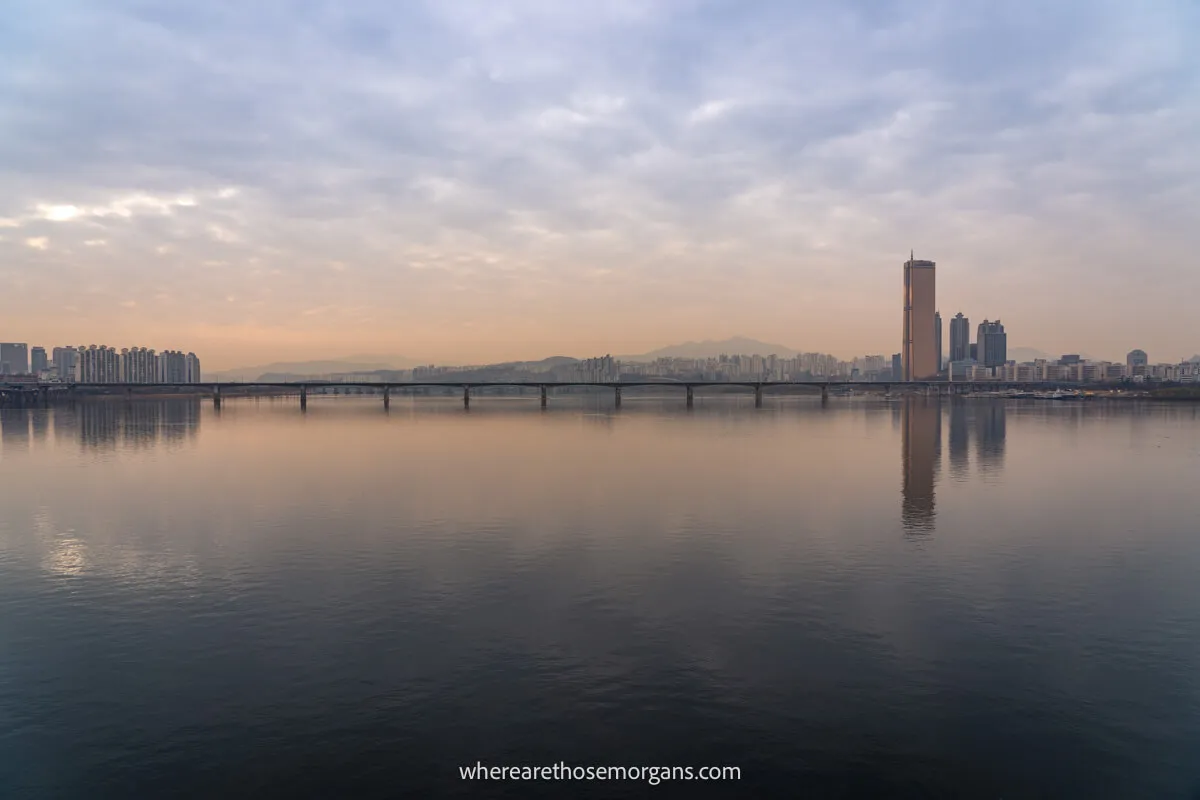
A cruise along the Han River is one of the best activities in Seoul , especially for first time visitors. E-Land Cruises have been operating since 1986. Visitors can choose between a moonlight, starlight, sunset or a Han River cruise package. If you’re looking for a romantic thing to do with your partner , surprise them with a cruise.
>> Book a Han River experience : Get Your Guide | Klook | Viator
35. Seoullo 7017
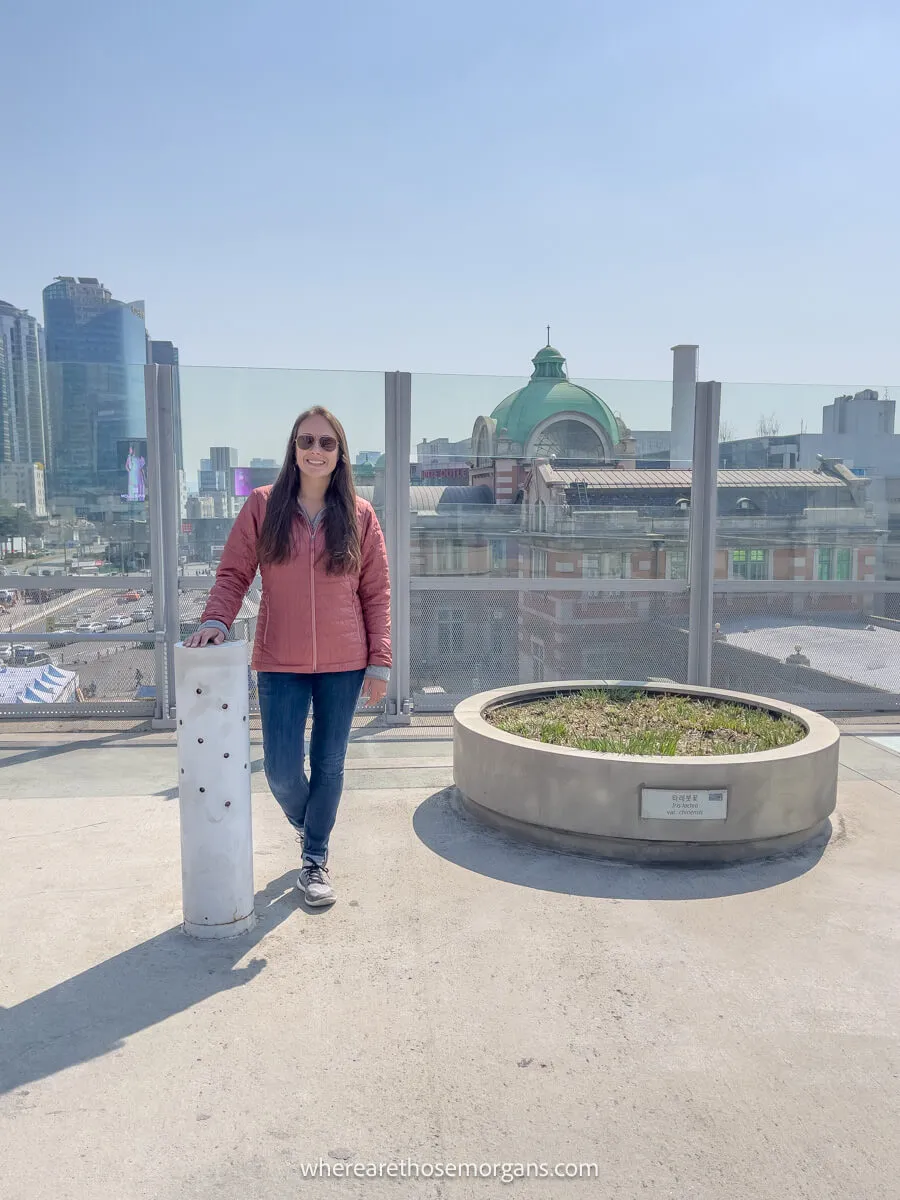
Opened to the public in May 2017, the Seoullo 7017 was once an overpass for cars. But now it has been transformed in a gorgeous sky garden elevated high above the busy streets . The green space can be compared to the High Line in NYC , offering a walking path for both tourists and locals to visit attractions in the area.
- Address : 432 Cheongpa-ro, Jung-gu
We like visiting Seoullo 7017 after the sun sets because the sky garden is illuminated with blue lights. But it’s not the best area around the train station so be aware of your surroundings if you plan to visit at night .
Best Seoul Tours
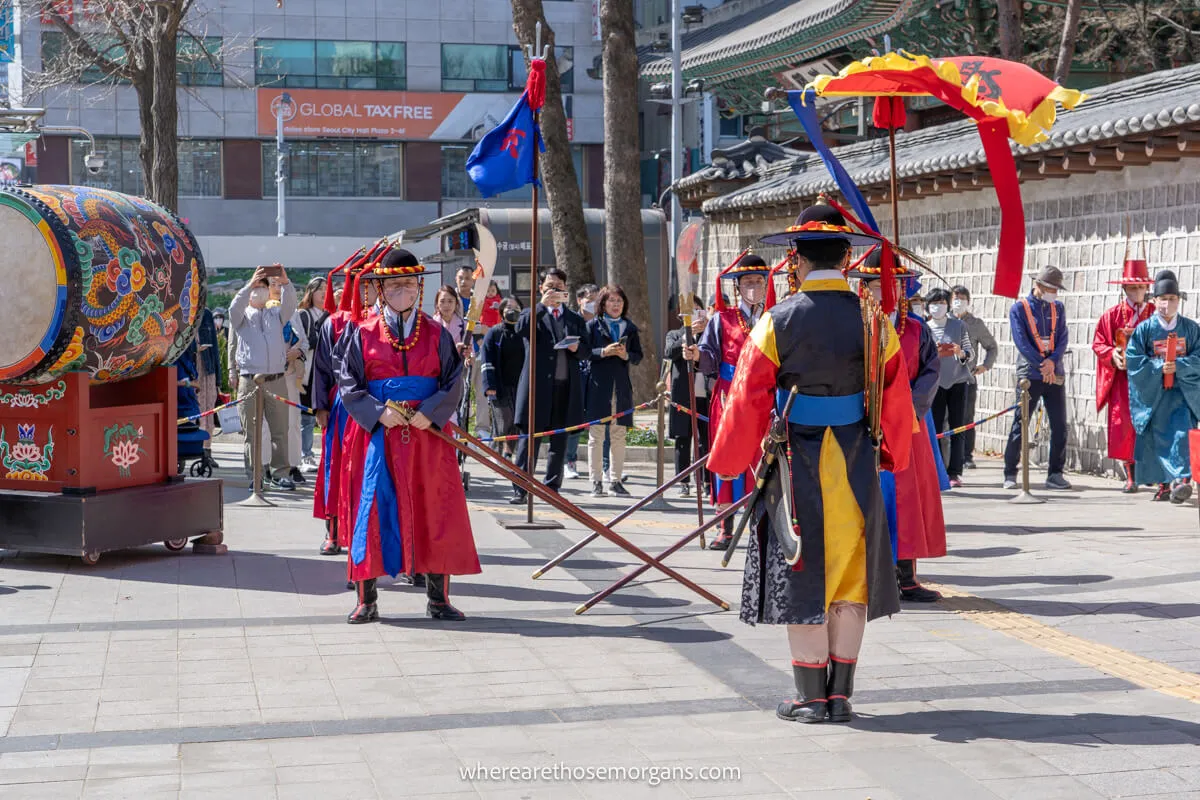
At the beginning of this guide, we mentioned the importance of grouping the must do Seoul attractions in the same area. So now that you know the popular activities, do you know which ones you want to visit? Here are some highly rated tour options that include various highlights:
- Travel SIM + T-Money Card – Unlimited 4G data and a public transport card
- Dark Side of the City – A ghost stories walking tour
- Viator DMZ Tour – With option to visit the red suspension bridge
- Seoul City Full Day Tour – See the best of the city in one day
- Day Trip to Nami Island – A hassle free day option with a tour guide
Food Tours And Cooking Classes
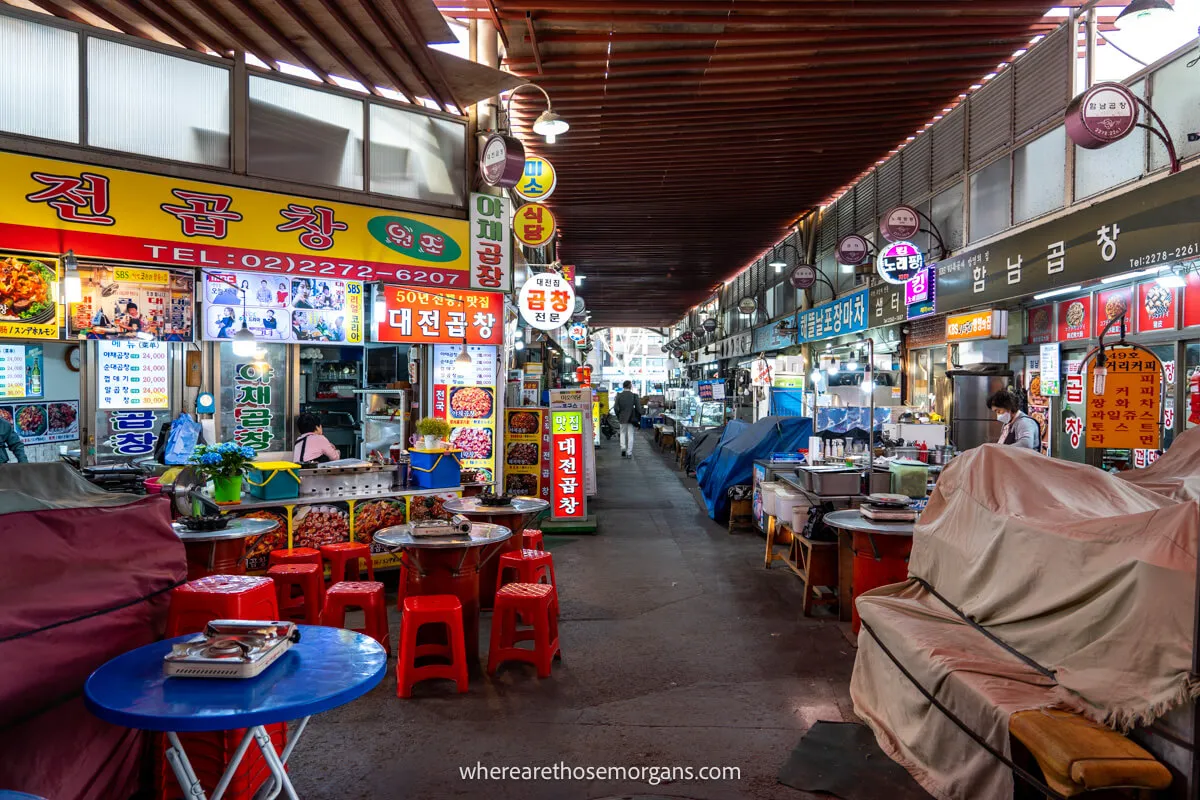
Seoul is a foodies paradise between mouth watering street food, Korean BBQ, the Noryangjin fish market, hidden speakeasies and bustling markets. So where do you start?
This was something we struggled with too. There is so much to eat and drink in this amazing city, it can be very overwhelming. Booking a food tour or taking a cooking class is one of the best ways to learn about culinary traditions from locals . Here are popular food experiences:
- Drinking and Eating through the Alleys – A 5 hour tour featuring places you won’t find on Google
- Secret Food Tours Seoul – A half day option to iconic neighborhoods and off the beaten track gastronomy gems
- Korean Cooking Class – Learn how to cook authentic Korean dishes with an experienced chef
- Kimchi Experience – Instructed by professional Korean chefs, you’ll learn how to make kimchi
- Night Market Food Tour – Learn about Korean history while trying authentic dishes and playing drinking games
Seoul Interactive Map
Above you’ll find our interactive map featuring all of the best things to do in Seoul we mentioned in this guide. You can also access our interactive map via this link here .
However, Google maps can be unreliable in South Korea because Google does not have access to geographical data in the country . This is due to conflicts between the Korean government and security concerns.
We recommend you download KakaoMap ( apple and android ) so you can navigate your way through Seoul. During our visit, we could load our Google Map, but it would never show us our exact location. Use our interactive map to figure out where you need to go then use the KakaoMap to navigate.
How To Save Money
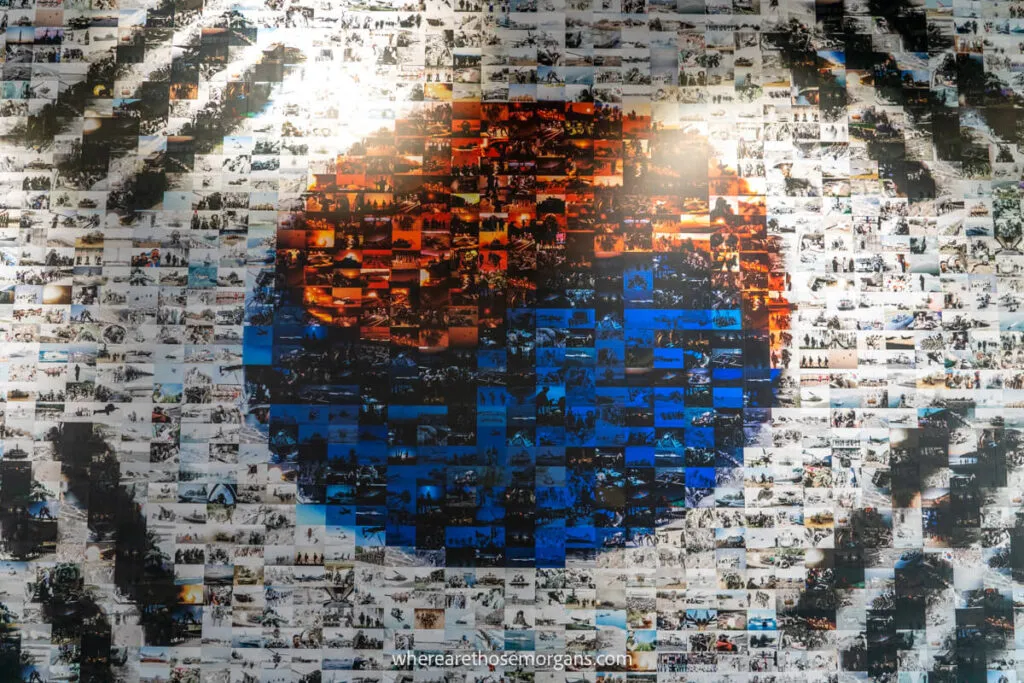
If you want to visit several attractions in Seoul, you should consider purchasing a pass to help you save money. We like to compare attraction passes to buying in bulk because the more attractions you visit, the more money you’ll save.
There are two popular passes including the Klook Seoul Pass or the Go City Seoul Pass . Depending on what you plan to see, one pass may work better for you so we’ll briefly touch on each one.
Klook Pass Seoul
The Klook Pass Seoul is a very popular option that can help you save 52% on attractions and there are 10 attractions included:
- Lotte World
- N Seoul tower
- Nami Island + Petite France tour
- Hanbok experience with Korean hairstyling
- Coex Aquarium
- Alive Museum + Dynamic Maze
- Ehwa Korean school uniform rental
- Lotte World Aquarium
- 63 Building Observatory + Aqua Planet 63
You can choose 2-4 activities from this list for one amazing price. We like this pass because it’s valid for 30 days . This means you don’t have to rush around visiting attractions by a certain time period and you can take your time.
>> Buy the Klook Seoul pass here
Go City Seoul Pass
The Go City Seoul Pass is different compared to the Klook Pass because you can choose from 29 attractions with many of these activities featured in this guide. Go City offers an attraction based all-inclusive pass or a day based explorer pass . Popular attractions include:
- N Seoul Tower
- Nanta Cooking Show
- Han River Cruise
- 14-day Korean Sim
- Incheon Airport express train
- Dark Side of Seoul Ghost Tour
>> Buy a Go City Seoul pass here
Having used these passes ourselves in London, Paris and Rome, we can tell you from experience they will save you money, especially if you plan to see many things during your trip.
Royal Palace Pass
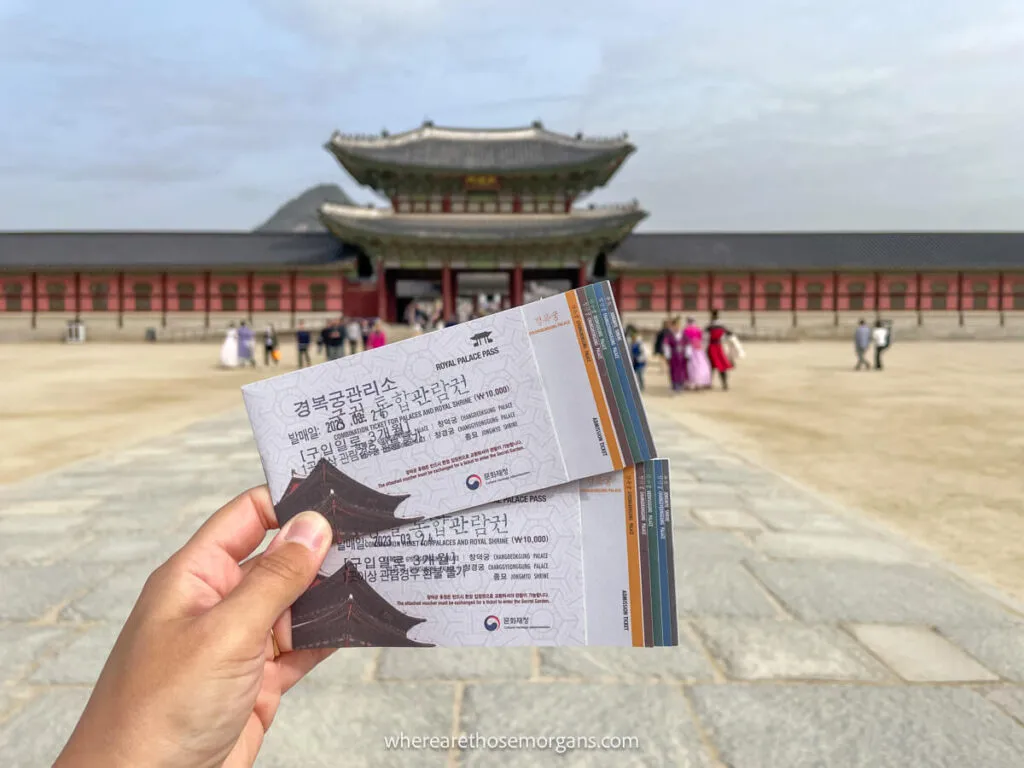
The last option is a Royal Palace Pass . But it’s not a traditional pass like the two options we mentioned above because it only works for the palaces in Seoul. We used this pass in the city and thought it was worth it.
The pass costs 10,000 KRW (US $7.53) and it’s valid for three months from the date of purchase . Here are current prices for the palaces:
- Gyeongbokgung (3,000 KRW)
- Changdeokgung (3,000 KRW) with Huwon Secret Garden (5,000 KRW)
- Changgyeonggung (1,000 KRW)
- Deoksugung (1,000 KRW)
- Jongmyo Shrine (1,000 KRW)
If you visited all of the sites above individually, it would cost you 14,000 KRW. This pass would save you a 4,000 KRW . You can’t purchase the royal palace pass online and it can only be purchased on site when you visit your first Seoul palace. However, if you want to visit more attractions than just the palaces, you should buy a Klook Pass Seoul or a Go City Seoul Pass .
The Morgan Conclusion
If this is your first time in the city, here are our top ten things to do in Seoul:
- War Memorial of Korea
- Visit at least one of the royal palaces
- Go on a tour the DMZ
- Climb one of the observation decks
- Have a Korean BBQ
- Stroll through the Olympic Park
- Check out the Royal Tombs
- Explore the Seodaemun Prison
- Go shopping in Gangnam
- Hike to Inwangsan Peak
These are activities we always recommend to friends or family and you can’t go wrong with anything listed above. We think 3-5 days in Seoul is enough time to see the major highlights of South Korea’s capital city. But this is a very large sprawling city and 6-8 days would be better so you can slow down.
You can visit South Korea anytime of the year, but spring from mid-March to early April is extremely popular for cherry blossom season . Another popular time is late September to early October for the peak fall foliage . Spring and fall are sunny seasons with comfortable temperatures making these the best months to travel through South Korea.
Our Seoul Guides
- How to book the best DMZ Tour
- Fun things to do at Imjingak Park
- Complete guide to Namsan Seoul Tower
- How to visit the Seoul Sky observatory
- What to see at the Jongmyo Shrine
- How to visit Gyeongbokgung Palace
- What is the best royal palace in Seoul?
- What to expect when visiting Seodaemun Prison
- 20 amazing hotels in Seoul
Want more Seoul content? Head over to our South Korea Travel Guides to explore the very best of Seoul and beyond.
We hope this guide listing the must do things in Seoul helps with planning your visit to South Korea’s capital city!
Please let us know if you have any questions about these attractions or visiting the city in the comments below.
Happy Travels ,
Mark and Kristen
Enjoy this Seoul activities guide? Pin it for your visit!
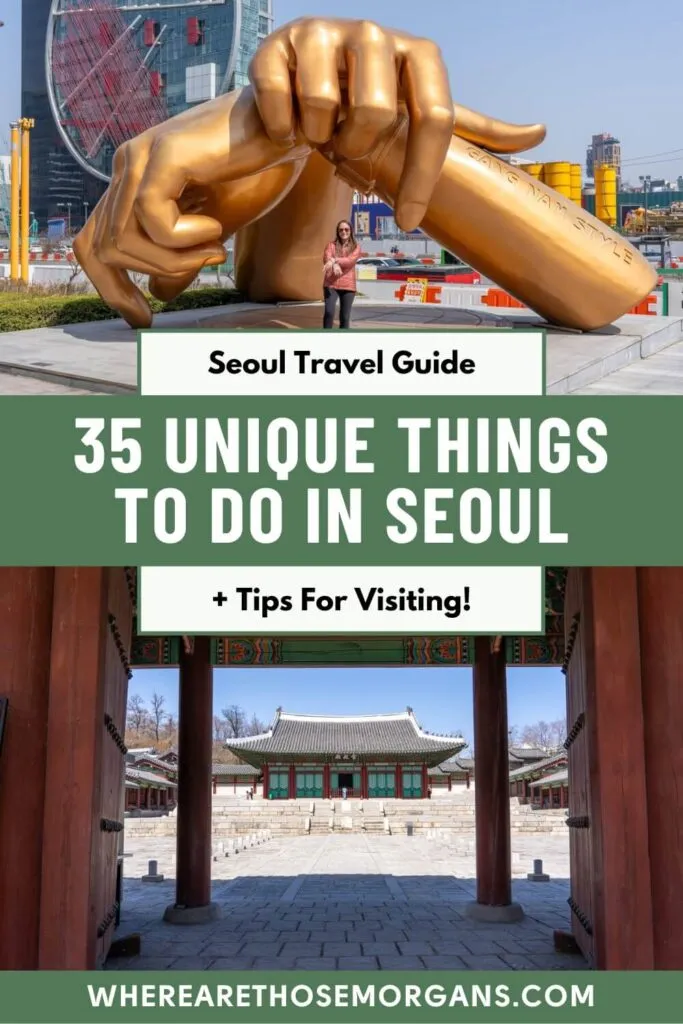
Note : This article contains affiliate links. When you make a purchase using one of these affiliate links, we may earn a small commission at no extra cost to you.
All Rights Reserved © Where Are Those Morgans, LLC. Republishing this article and/or any of its contents (text, photography, maps, graphics, etc.) in whole or in part is strictly prohibited.
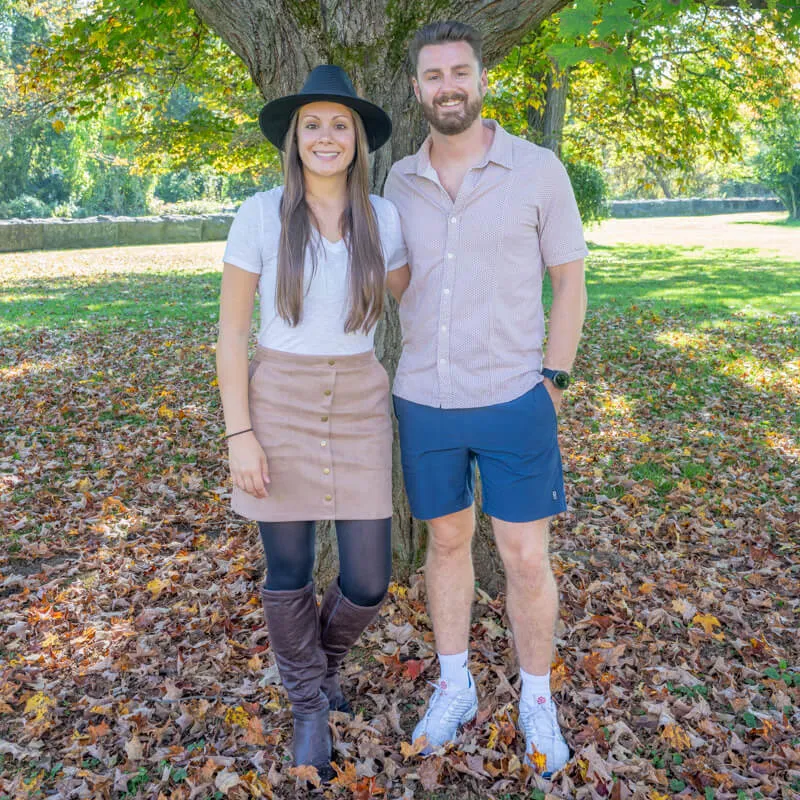
Mark and Kristen Morgan are travel, hiking and photography experts. Over the last 6 years traveling full time, they have explored more than 40 countries and 30 US states.
Where Are Those Morgans has been featured in USA Today, Gestalten, Get Your Guide, CityPASS and Condé Nast Traveler along with various other publications. Read more about us .
Leave a Comment Cancel reply
Subscribe to our newsletter
Get the latest in travel straight to your inbox
Click here to subscribe

23 Epic Things to Do in SEOUL, South Korea (2024 Edition)
- Last Updated: February 5, 2024
From grand palaces to locations of incredible historical significance topped off with some to-die-for food, here’s our ultimate list of the best things to do in Seoul, South Korea.
If you were to ask somebody to name some Asia’s most interesting and dynamic capital cities, there is a good chance that Seoul would be overlooked.
Surprising when you consider that it is one of the continent’s most visited cities with tourism to Seoul booming in recent years.
Although there is a clear influence from the regions big hitters (China and Japan), Seoul clearly demonstrates the country’s own unique culture from its historical buildings to modern day K-Pop and Jaebeol’s (huge conglomerates like Samsung or LG).
There is no shortage of unique things to do in Seoul.
READ MORE: Check out our perfect 3 days in Seoul itinerary to make the most of your short trip!
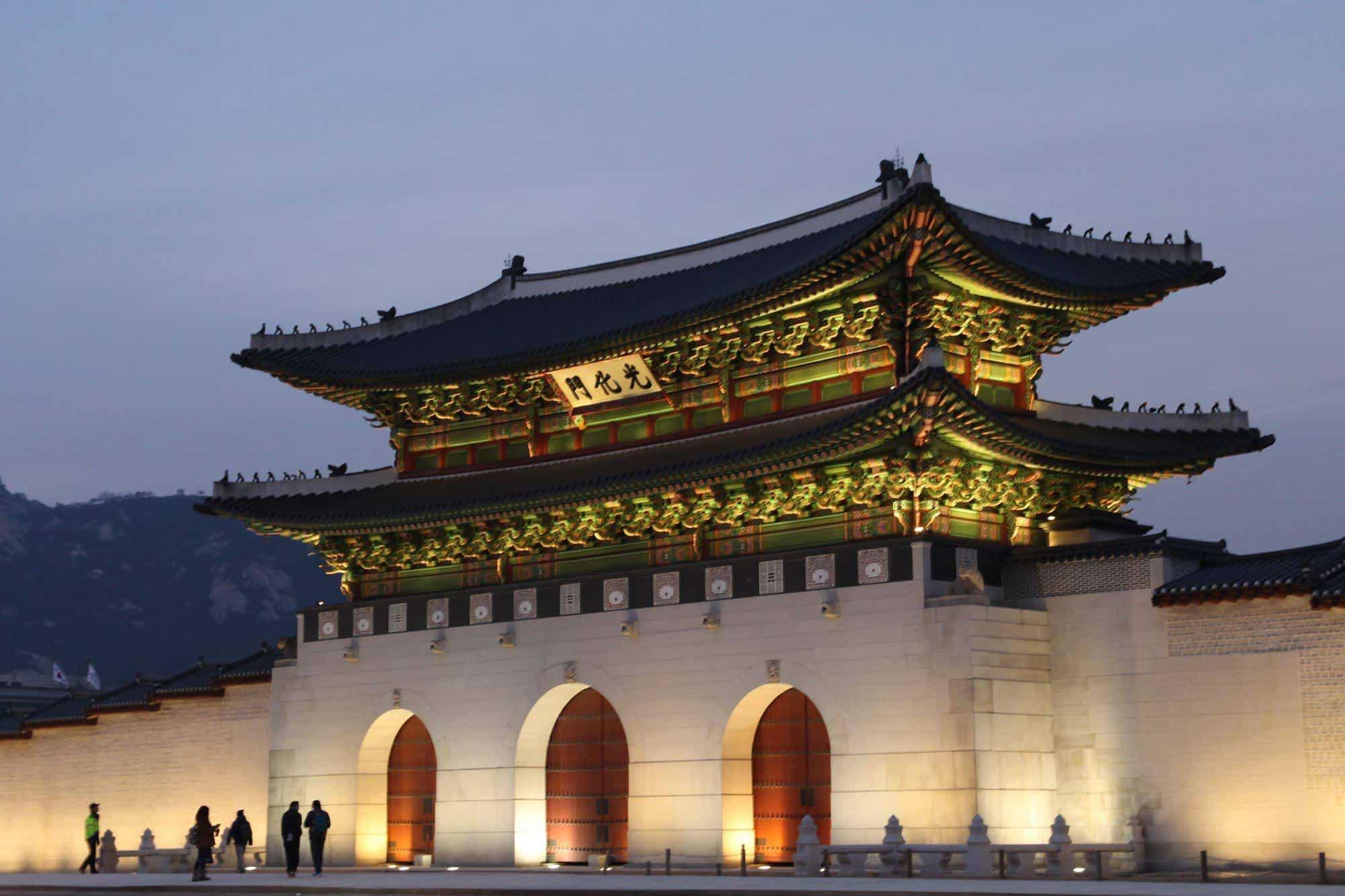
Table of Contents
A Brief Overview on Korea’s History
Gyeongbokgung, bukchon hanok village, changdeokgung, jongmyo shrine and park, take a break from palaces, shrines and temples and eat at insa-dong, cheong-gye-cheon, take in awesome views of seoul from namsan & the n seoul tower, take a night time stroll around deoksugung, shopping, eating and people watching in myeong-dong, shop and eat at namdaemun, national museum of korea, korean war memorial, explore hongdae, noryangjin fish market, relax in hondgae’s parks, gangnam style in gangnam, visit the olympic park, gwangjang market, visit a jimjilbang, how to get to seoul, south korea, getting around seoul, language issues, best time to visit seoul, korean fried chicken, dumplings and pancakes, sweets and treats, the best hostel in seoul – zzzip in hongdae, best budget accommodation for couples in seoul – mini hotel insa in insadong, best mid-range hotel in seoul – dh naissance hotel in dongdaemum, best luxury hotel in seoul – lotte hotel seoul in myedong.
Korea has been the centre of a tug of war between China and Japan for the last couple of hundred years.
Prior to Imperial Japan’s taking control following the first Sino-Japanese war (1894-95) Korea was a tributary of the Ming and then rather begrudgingly, Qing Dynasty; in effect it was China who was in control.
When World War 2 ended in 1945 it still wasn’t an independent nation. Although its previous rulers had been vanquished and booted out, the country was split in two: the Russian backed North and the American backed South.
Interestingly up until the 1970’s it was actually North Korea that was more developed, a far cry from today.
After overcoming poor governance, military dictatorships and a faltering economy South Korea grew year upon year and now has roughly the 11th largest GDP (some analysts have it slightly lower) and is regarded as one of the most technologically advanced nations on earth.
Seoul is the epicentre of this development. A city where the palaces of bygone dynasty’s stand alongside giant skyscrapers, K-Pop and night markets compete for pennies and attention and the Jaebeol’s are in and out the press (more often than not for something unpleasant). There truly is nowhere else like Seoul.
Our list of the Best Things to Do in Seoul, South Korea
Seoul is made of 25 Gu (districts) with a lot of sights concentrated in Jongno-gu, Jung-gu and Yongsan-gu.
Make no mistake, Seoul is huge but its excellent metro system means it’s very easy to get around, meaning you should have no issues seeing Seoul’s awesome sights.
READ MORE: Check out our mini-guide to the best hiking in South Korea !
Gwanghwamun & Jongno-gu
This area contains some of the most popular Seoul attractions. It’s well connected to the rest of the city and most of the sights in this area are within walking distance of each other.
Start here for the best places to go in Seoul!
This is one of Seoul’s most famous landmarks. Built in 1395 this huge palace was the home of the royal family until 1592 when it was burnt down during a Japanese invasion.
Despite its popularity it is very easy to find moments of zen, especially if you visit early in the day.
There are a number of interesting museums and exhibitions in palace and from 10am until 4pm, on the hour you can view the changing of the guard in the main courtyard. If you’re not sure what to do in Seoul, this is a pretty awesome place to start.
- Address: 161 Sajik-ro, Sejongno, Jongno-gu
- Opening hours: every day from 9 AM – 6 PM (closed on Tuesdays)
- Price: 3,000 won
- Nearest Subway: Gyeongbokgung
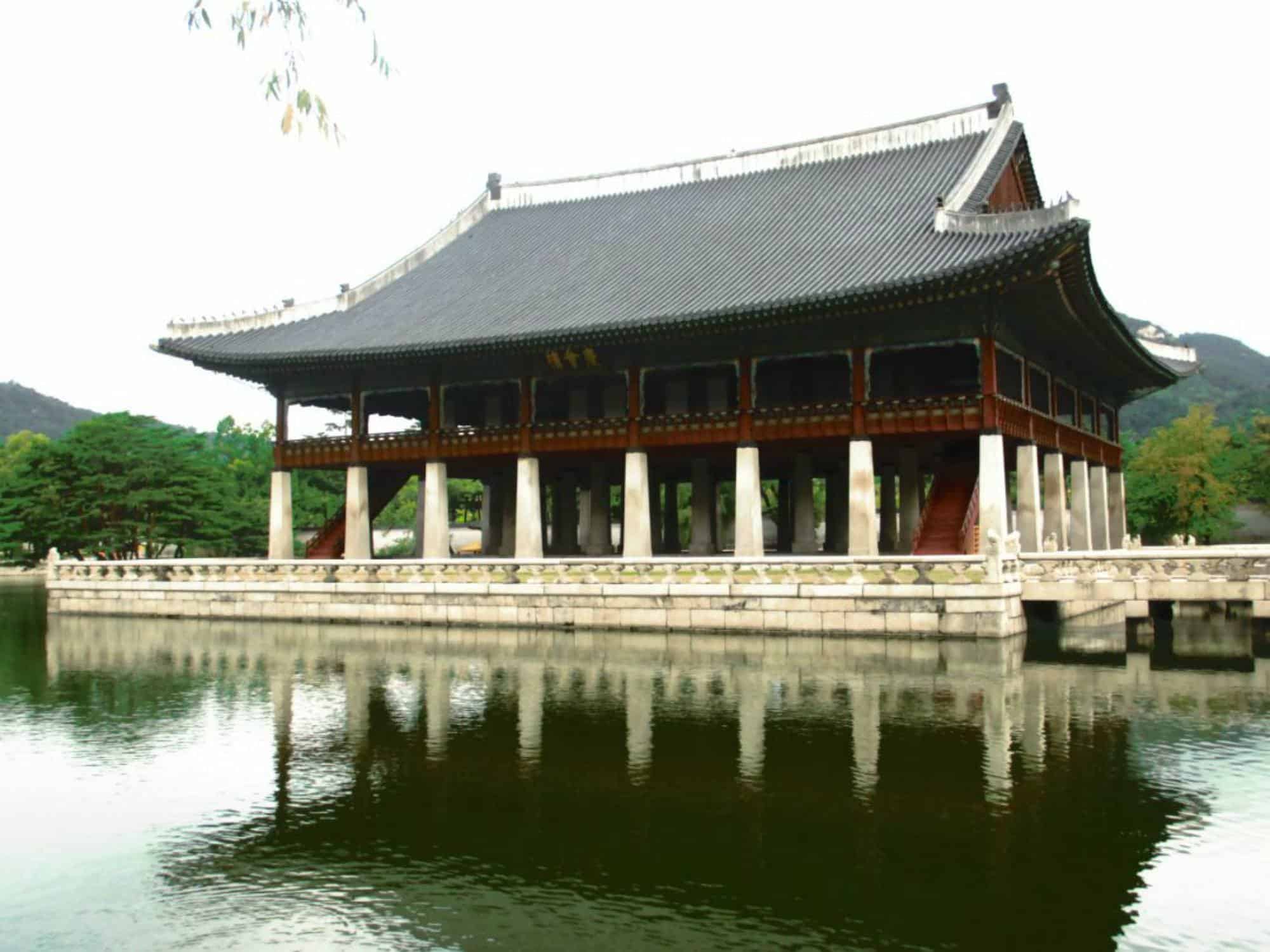
This village, situated in between Gyeongbokgung and Changdeokgung is home to roughly 900 Hanok (traditional Korean homes). It is full of small museums, art galleries and craft workshops and is a great place to explore.
At sunset or early morning it can be especially nice.
Do be aware that this place can get very busy with tourists who are in the area visiting Gyeongbokgung and Changdeokgung. In spite of all the museums, cafes and workshops this is still a residential area for some, so do bear that in mind when exploring.
- Nearest Subway: Anguk
Looking for a guided city tour of Seoul? Click the button below to join the best one in town!
The palace of Illustrious Virtue has a strong claim to being the most beautiful of Seoul’s palaces. You can check out some of the outer buildings by yourself however to explore the core of the palace and its gardens then you will need to join a guided tour.
There are two options; the Palace Building Area or the Secret Garden, with the latter being slightly more expensive. Check out tour schedules and find which time suits you best.
The Secret Garden tour whilst being slightly more expensive it is one of the most interesting things to do with regards to Seoul’s dynastic past.
During peak tourist seasons it’s advisable to try and book as far ahead as possible. Schedules vary between the summer and winter months but there are a number of English tours on offer.
- Address: 99 Yulgok-ro, Waryong-dong, Jongno-gu
- Opening hours: every day from 9 AM – 5PM (closed on Mondays)
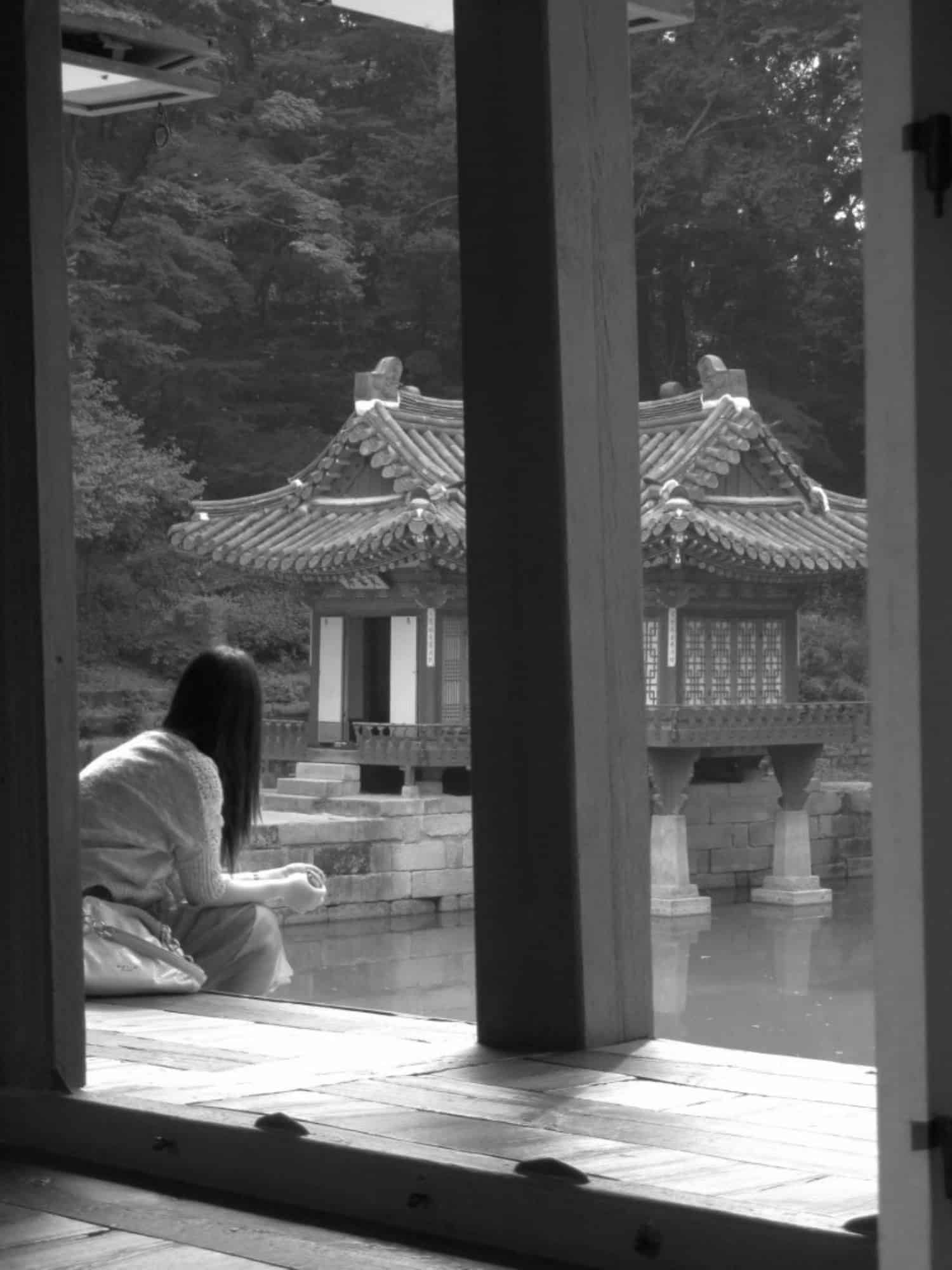
This temple is home to the Jogye Order of Korean Buddhism and as a result is particularly spectacular around major buddhist festivals. You can combine this with a trip to Insa-dong.
- Address: 55 Ujeongguk-ro, Gyeonji-dong, Jongno-gu
- Price: Free of charge
Read next: The Perfect 2 Week Taiwan Itinerary
Located to the south of Changdeokgung this huge park is home a shrine of the same name as well as a number of others. It is the World Heritage-listed Jongmyo Shrine that is the most important.
It is here that spirit tablets of Joseon kings, queens and most loyal government officials are kept. It is believed that their spirits reside in the special hole bored into the wooden tablets.
Whilst the park is nothing too spectacular it’s certainly a nice break for the hustle and bustle of Central Seoul.
- Address: 157 Jong-ro, Hunjeong-dong, Jongno-gu
- Opening hours: February-May, September-October from 9 AM – 6 PM Jun-August from 9 AM – 6:30 November – January from 9 AM – 5:30 PM
- Price: 1,000 won
- Nearest Subway: Jongno 3-ga
Explore the UNESCO World Heritage Sites of Changdeokgung Palace and Jongmyo Shrine on a tour with Get Your Guide
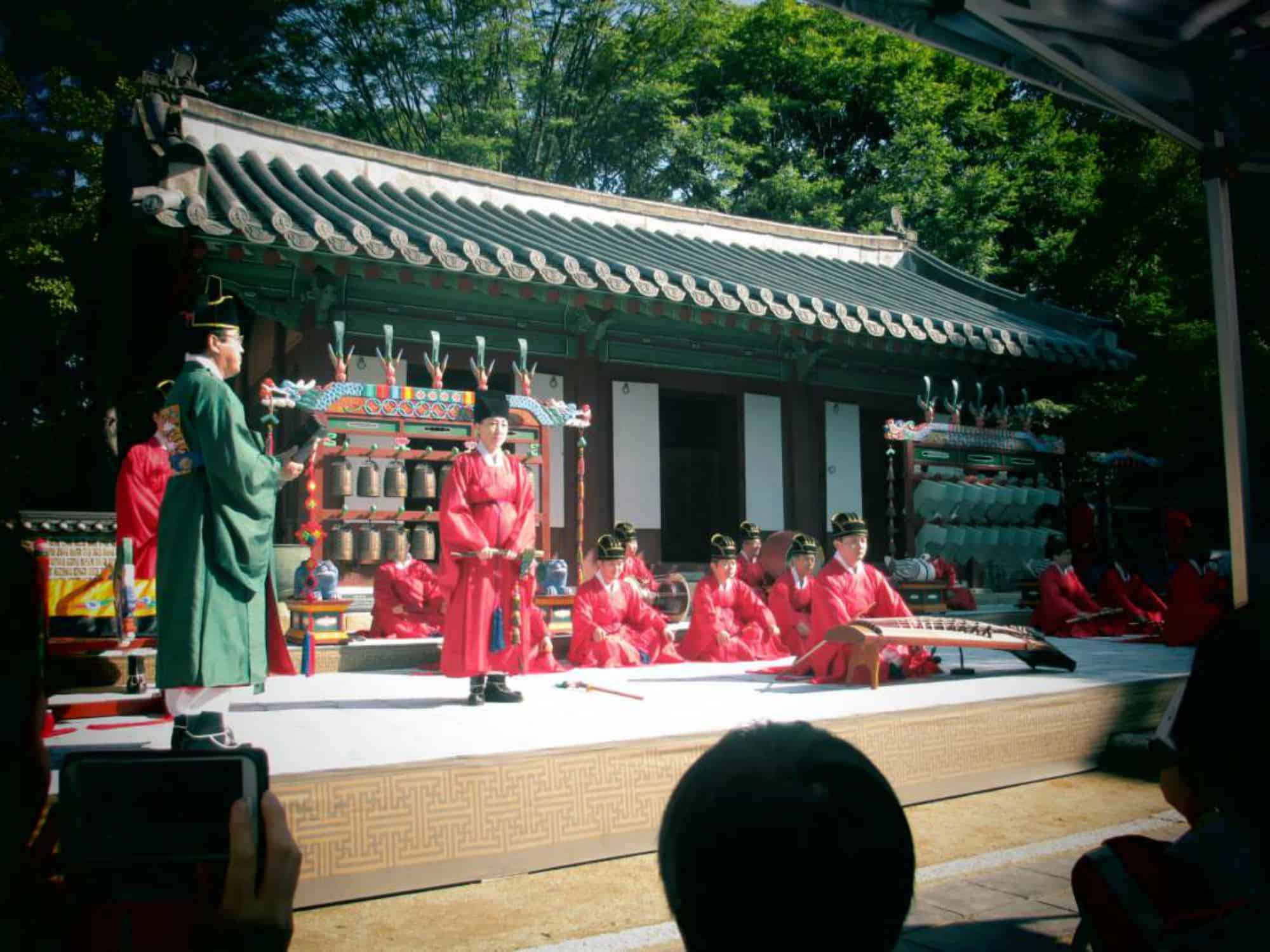
South of Bukchon is Insadong, an area chock full of restaurants, bars and cafes. A great place to to take a break between the sights above.
This stream that flows from northern Seoul down to the Han River has undergone a major facelift in recent years. Roads and raised highways were torn down and replaced with walkways, waterfalls, footbridges and public artworks.
Understandably this has been a big hit with the people of Seoul with summer and is especially popular with families.
- Nearest Subway: Gwanghwamun
Myeong-dong and Jung-gu
Now it’s time to head to the other popular neighbourhoods of Myeong-dong and Jung-go to explore some of the best Seoul tourism activities.
Perched on top of Namsan is the N Seoul Tower, one of Seoul’s most iconic sights. You can do the awesome but slightly knackering hike up to the N Seoul Tower or you can take a cable car from close to Myeong-dong subway station.
Views from Namsan and in particular the N Seoul Tower are spectacular. Visiting in the evening can give you some awesome city views, however the wait to get up the N Seoul Tower at night can be long, so just plan wisely and book ahead if you can.
If you’re not fussed about going up the tower itself, the views from Namsan are still pretty awesome. This is definitely one of best evening’s Seoul attractions.
- Address: 105 Namsangongwon-gil, Yongsan 2(i)ga-dong, Yongsan-gu
- Opening hours: every day from 10 AM – 11 PM (except Saturday from 10 AM – 12 AM)
- Price: 11,000 won
- Nearest Subway Stations: There are two options here, Hoehyeon and Myeong-dong. If you’re hiking you can start one and hike up and loop round Namsan and finish at the other. If you want to save your knees then you can head to Myeong-dong and from there it’ a short walk to the cable car station.
The Palace of Virtuous Longevity is unique in that it’s the only Seoul landmark that you can visit at night. Naturally this is one of the best times to visit, it’s only a short walk from the neon craziness that is Myeong-dong.
The perfect way to walk off an amazing meal and certainly a unique idea for what to do in Seoul!
If visiting during the day you may be lucky enough to catch a changing of the guard ceremony or join a free guided tour of complex. For times check out their website here .
If you do wish to go on a private guided tour – book an evening tour with Get Your Guide
- Address: 99 Sejong-daero, Jeong-dong, Jung-gu
- Opening hours: every day from 9 AM – 9 PM (closed on Mondays)
- Price: 1,000 won (general admission)
- Nearest Subway: City Hall
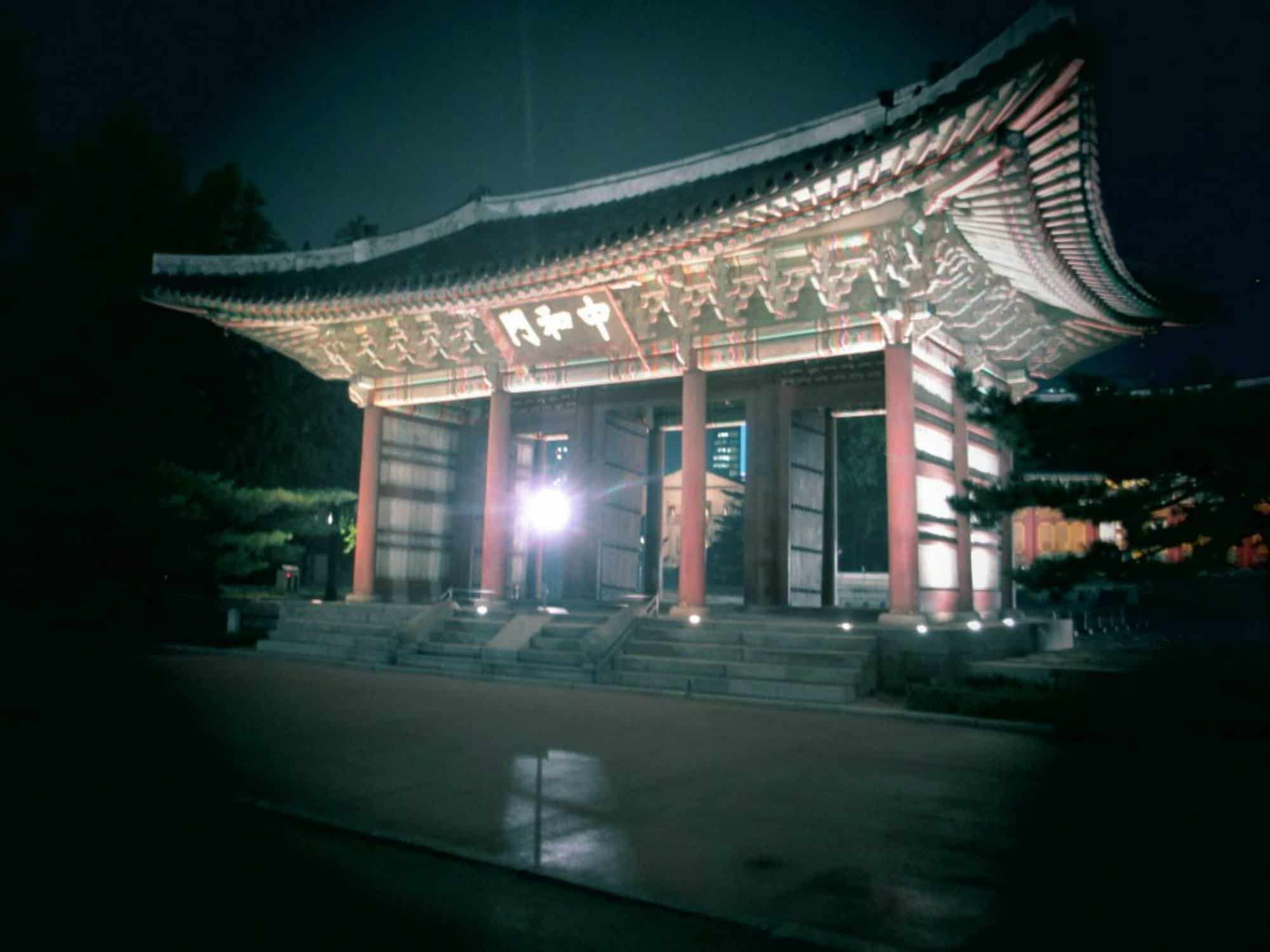
Myeong-dong is chock full of restaurants, bars and shops and certainly one of Seoul’s glitzier districts. Although it’s not quite at the level of Gangnam, there are still plenty of opportunities to splash the cash.
Down some of the smaller alleyways, closer to the subway station there are some excellent BBQ restaurants which are a must if you’re in South Korea. The nearer you get to Myeng-dong’s neon nucleus the wider the variety of food.
If you’ve had your fill and your pennies are running low then this is an excellent place to people watch.
- Nearest Subway: Myeong-dong
While you’re in Myeong-dong, why not book in for an epic Nanta show at the theatre ?
This sprawling 24 hour market sells anything and everything. By the evening food stalls are the name of the game and you can pick up some great bibimbap, pancakes, kimchi and various other Korean goodies.
Naturally prices are cheaper than in restaurants and most have some kind of outdoor seating, although it can be very busy so you may be looking for a seat for a while. However like in Taiwan, eating at these outdoor food markets offer some of the best local cuisine. You can’t claim you’ve had the full Seoul sightseeing experience without venturing out to its street markets.
Book a 4-hour tour to some of Seoul’s best known traditional markets +(bonus visit to the UNESCO World Heritage Site – Changdeokgung Palace).
- Address: 21 Namdaemunsijang 4-gil, Hoehyeon-dong, Jung-gu
- Opening hours: 24h/7
- Nearest Subway: Hoehyeon
READ MORE: Check out our list of the best things to do in Jeonju, Korea .
Itaewon & Yongsan-gu
This area is one of the most popular expat hangouts in the city. A big reason for this is that the fact that there is an American military base close by. Expect to find a number of American bars and burger joints in this part of town.
A lot of people stay in this area, and if a night of bar hopping appeals then this may the place for you. A pub crawl in Seoul can be a fun way to meet new friends and mingle with the locals. However if you want to avoid the drunks and burger bars then you may want to look elsewhere for your evening entertainment.
The area is home to two excellent museums that are well worth a visit and help provide a deep insight into Korea’s past, present and future, and definitely two of the best things to do in Seoul.
The museum takes you on an in depth tour from Korea’s feudal beginnings right through to the end of the Joseon Dynasty in 1897, the countries last.
Entrance to the main exhibits are free of charge, however the regular special exhibits are not and a ticket will need to be purchased.
There is a lot to see here with everything being displayed in both English and Korean.
- Address: 137 Seobinggo-ro, Seobinggo-dong, Yongsan-gu
- Opening hours: every day from 10 AM – 6 PM (Wednesday & Saturday from 10 AM – 9 PM, Sunday from 10 AM – 7 PM)
- Price: Free of charge (separate charge for special exhibitions)
- Nearest Subway: Ichon
Frequently known as the forgotten war in the Western World, the Korean War was a battle between the competing ideologies of the USA and China and the Soviet Union.
The war raged from 1950 until 1953 when an armistice agreement was signed between the USA, China and North Korea. South Korea was not a signatory to this ceasefire and a formal peace treaty between the two Korea’s and their allies was never formally agreed meaning that the two sides are technically still at war.
As well as a memorial to those that fought and died in Korean War the site is also home to a number of excellent exhibitions giving information into one of the most brutal conflicts of the 20th century.
The Korean War started in 1950 when North Korea launched a surprise invasion of the South. Initially the North made spectacular gains, partially thanks to weaponry and support from the Soviet Union.
However the USA soon pushed the North close to the Chinese border and then China joined in. There are many who believe that without China’s intervention North Korea would have been ceased to exist.
This museum offers a lot of insight into Korean history and for all wanting to get to know the culture better – it’s a Seoul must see!
- Address: 29 Itaewon-ro, Namyeong-dong, Yongsan-gu
- Opening hours: every day from 9:30 AM – 6 PM (closed on Mondays)
- Price: Free of charge (only parking fees – 3,000 won per 2 hrs)
- Nearest Subway: Samgakji
Western Seoul
Moving further into our Seoul travel guide, it’s time to head to the Gu of Western Seoul.
Seoul’s main student area is home to funky live music venues, cafes and some awesome restaurants. Do not expect fine dining here, it’s all about keeping the prices down. The area is also home to some excellent hotpot and BBQ restaurants.
If you’re looking to catch some of South Korea’s finest unsigned indie acts then this is the place to do it!
- Nearest Subway: Hongik University and Sangsu
South Korean cuisine is home to some outrageously good seafood dishes and the Noryangjin fish market is the place to buy the freshest seafood in Seoul.
If you have ever been to the Tsujiki fish market in Tokyo this is not as big, but unlike Tsujiki there are less idiotic tourists pissing off the local traders so they are still ok with visitors coming early and checking it out during the peak market hours.
Auctions get going at around 5am, so naturally thats the best time to visit, but stay out of the way and be quiet. Do remember that this is a working market, so keep out of the way of workers and trucks hauling around the fish that will pay their salaries.
- Address: 674 Nodeul-ro, Noryangjin-dong
- Nearest Subway: Noryangjin
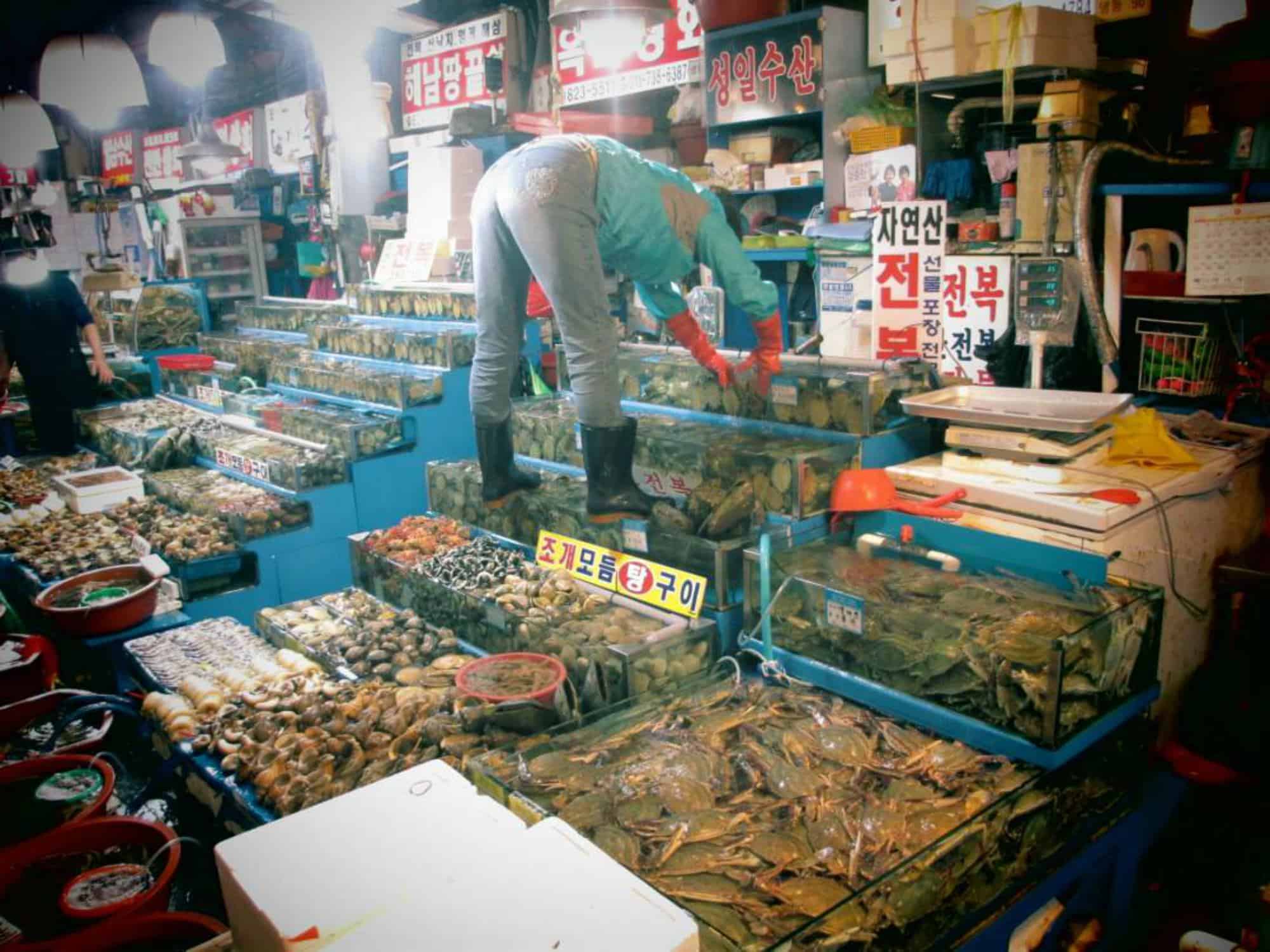
This area is home to two parks which are great to while away a sunny afternoon. Peace Park which is home to the World Cup stadium is east of Hongdae.
Seonyudo Park is built on an island in the middle of the Han River that was formerly home to a water filtration plant. Now it’s full of ponds, plant nurseries and exhibitions – far more visually appealing.
- Nearest Subway: World Cup Stadium for Peace Park and Seonyudo for the park of the same name.
Gangnam & South of the River
Head south of the river to find more ideas for what to see in Seoul, Korea!
This district will always be synonymous with Gangam Style, the song that has caused many a hangover riddled guy or girl to look back on the previous nights dancing with shame.
When this song came out I had not yet been to Seoul, but a good friend of mine lived there for a year. It was him who informed me that Gangam was actually a very fancy, upmarket area in Seoul.
Think Kensington or Mayfair in London. Not sure if the song “Mayfair Style” would sell as well.
It’s certainly an interesting area to explore, with plenty of awesome and surprisingly affordable restaurants hidden in the cities back alleys.
If that’s not your thing then there are plenty of fashion brands and expensive restaurants that have made Gangnam their home.
- Nearest Subways: Cheongdam and Samseong
Seoul being named as the host city for the 1988 Olympics was a demonstration of just how far South Korea had come.
Home to some interesting museums, various Olympic memorials and venues and some lovely walking trails this is a great place to spend a sunny afternoon. There are also bikes available to hire.
- Nearest Subway Stations: Mongchontoseong and Olympic Park
Dongdaemun and Eastern Seoul
Dongdaemun is home to some of the best places to visit in Seoul.
If you are looking for a market to stuff your face with amazing Korea street food then then this is the place! This place is positively buzzing most evenings, think the huge night markets in Tainan and Taipei as a rough comparison.
Come with an empty stomach and be prepared to stagger back home, because eating really is one of the top Seoul tourist attractions.
Without a shadow of a doubt this one of Seoul’s most brilliantly chaotic places. Even if you’re not here for the food it’s certainly one of the most interesting things to see in Seoul.
- Address: 88 Changgyeonggung-ro, Jongno 4(sa)-ga
- Opening hours: every day from 9 AM – 5PM
- Nearest Subway: Jongno 5-ga
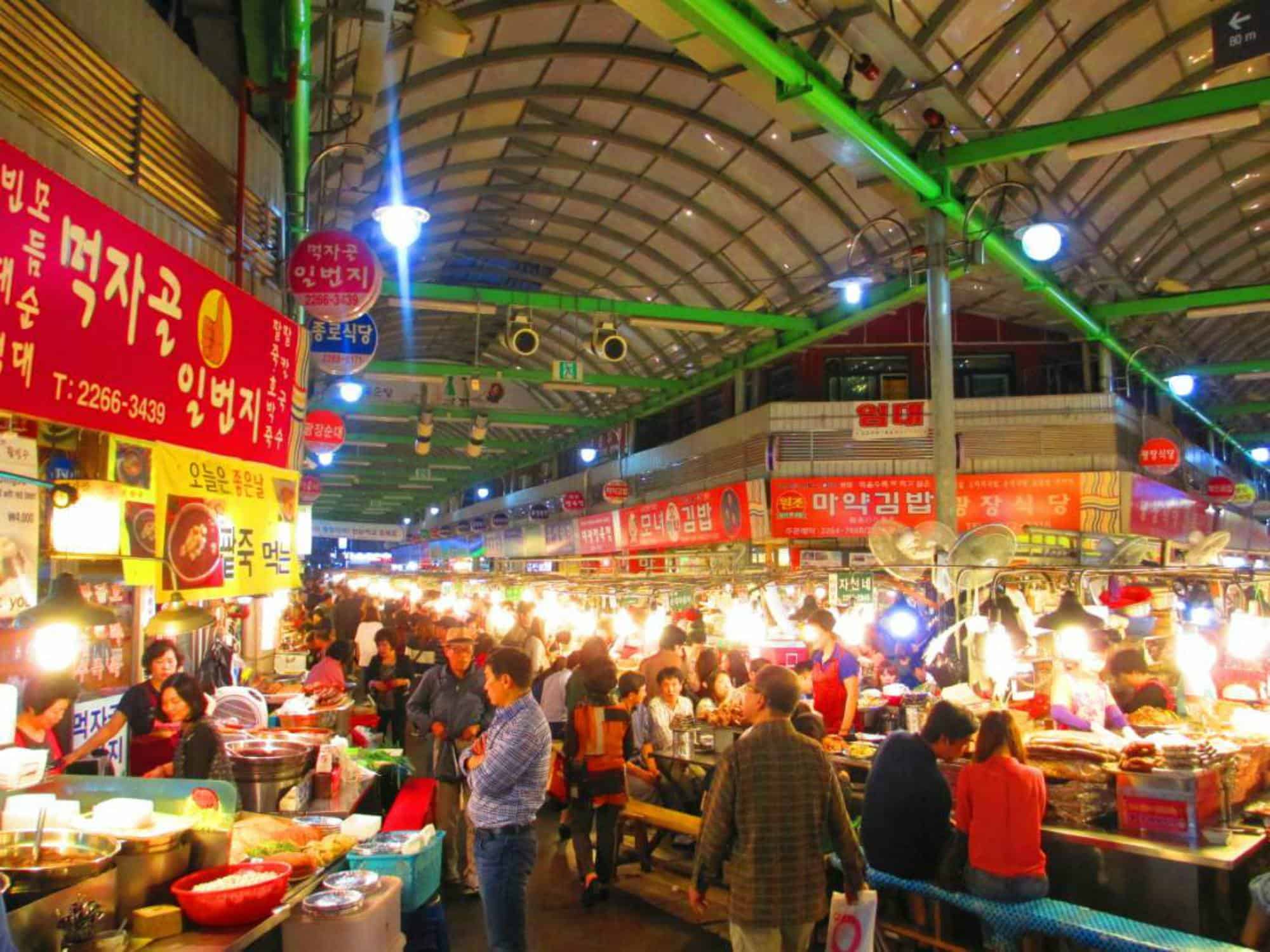
Northern Seoul
Head over to Northern Seoul for another day of exploring in the South Korean city.
Offering great views over Seoul this 342m peak is open to the public, however security is quite tight.
In 1968 North Korean Agents attempted to assassinate South Korea’s president by climbing over the Seoul’s old city walls at Bukaksan and into the presidential compound.
Although the mission was unsuccessful the area still remains under tight security, due to the fact the presidential palace is so close.
This was the city’s last line of defence, and some of the views of the surrounding countryside and Seoul itself are particularly stunning. Do be aware that there are some points where photos are not allowed. Bring your passport.
- How to get there: Head to Anguk, take exit 2 and jump on bus No. 2 to Waryong Park. The hike starts here and ends at Changuimun Gate. From Here you can take buses 1020, 7022 and 7212 back to Anguk.
Best Day Trip from Seoul
Sometimes you need to get out of the city too, so to inspire you here’s my recommendation for the best day trip from Seoul.
On of the most popular day trips from Seoul is to the DMZ which includes a trip to Panmunjeon. Incidentally this is also one of the best things to in Seoul.
However if you visit during a National Holiday there is a chance you may not be able to visit this area (sadly this was the case for me). This is definitely one of the most unique places in the world, let alone in Seoul.
This one is one of the most popular DMZ tours available. However try and book at least two weeks in advance, further if you’re travelling during peak season.
Once you have booked you will be sent the details of where to meet. You WILL need to bring you passport and dress appropriately, as described on the website.
All Over Seoul
Some Seoul activities can be found just about anywhere in the city. If you’re looking for general Seoul tourist attractions, and not just the main points of interest, these are for you!
Visiting a Jimjilbang is one of the best things to do in Seoul. A Jimjilbang is a Korean onsen/sauna/spa complex offering baths, massages, games rooms, saunas and a bunch of other bits and bobs.
A number of Jimjibang’s have options to stay all night with various sleeping rooms within the complex and baths running throughout the night.
There are plenty of these in Seoul, however the price for day time rates and night time rates is likely to differ. Plan appropriately to make sure you don’t get a surprisingly large bill.
All nighters can sometimes work out cheaper than a hotel, and you will feel fresh as a daisy the next morning.
These do have a reputation for being seedy (understandable when you describe it). However the chances of you finding such a place through a google search is pretty slim. Alternatively you can ask your guesthouse or hotel for a recommendation.
South Korea is home to some awesome live music. Dongdaemun has some excellent jazz and blues clubs whereas Hongdae is the place to go for Indie.
If K-Pop is what you’re after, and with the an ever growing fan base you wouldn’t be alone, check out the best spots online. There are various gigs going on throughout the year hosting some of the genre’s biggest acts.
To have the best K-Pop experience, you can book a tour with Get Your Guide , which will lead you to the K-Pop themed restaurant in Seoul’s posh area, Gangnam. Fantastic food, great tunes and amazing views of the Seokchon Lake and the city – a perfect recipe for a great night out!
One of Seoul’s most unique cultural exports this is the best place to experience it and see what all the fuss is about (hint: it’s pretty awesome).
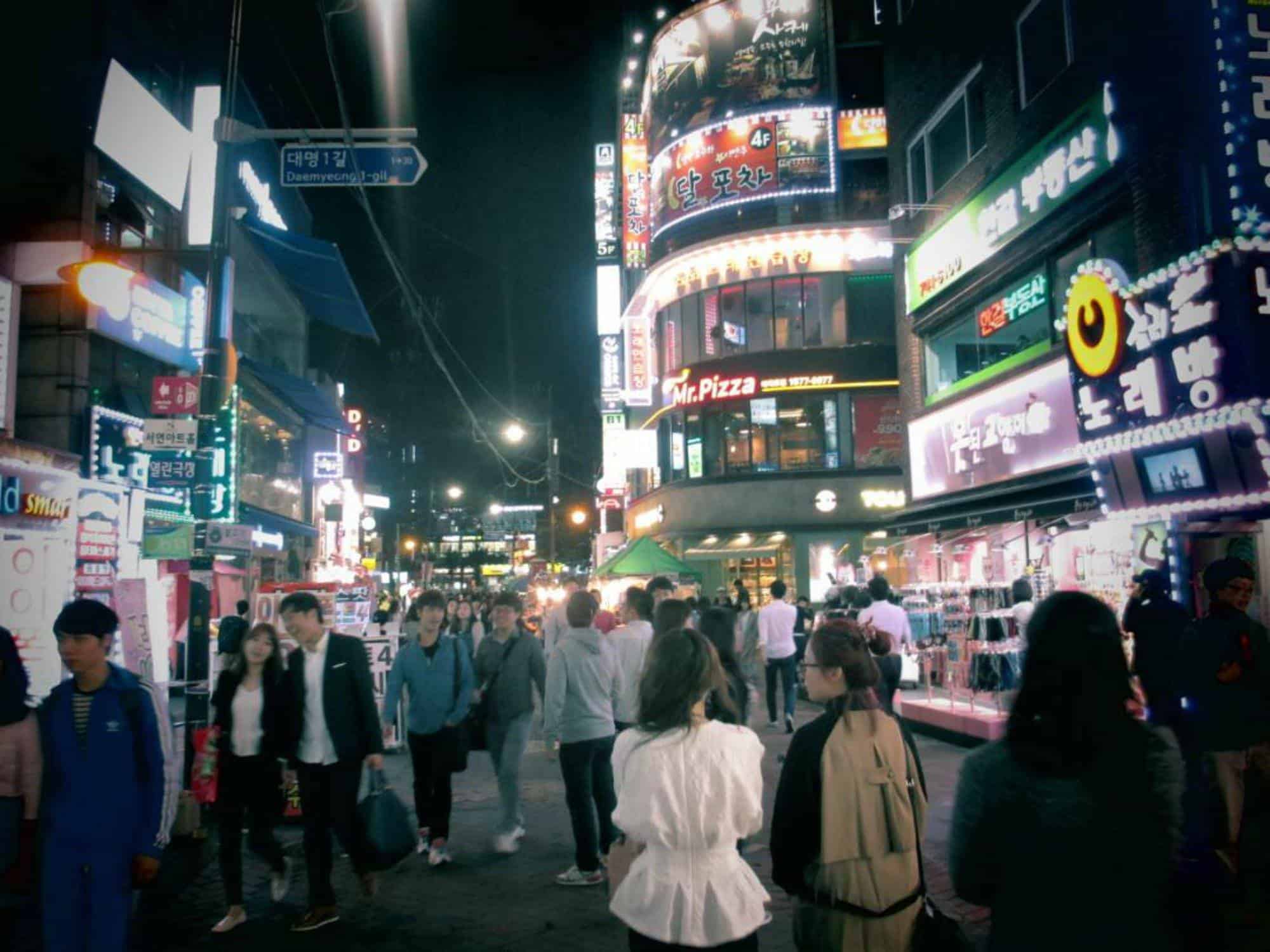
Seoul Travel Guide
To help you with your visit, here’s some of our best Seoul travel tips to help you make the most of your holiday.
Seoul is a regional hub and as a result it’s not uncommon to have long distance fights transferring in Europe, meaning that you could easily extend a layover into a long weekend.
It also means that getting to Seoul is very easy from most major cities in East and South East Asia.
Seoul has two airports, Incheon and Gimpo. The vast majority of international flights will land at Incheon, save for some flights to and from China and Japan that will land at Gimpo.
Both airports have excellent connections to Seoul by train or bus, however check where the final stop is as depending on where you are staying one may be more convenient that the other.
Public travel within Korea is generally very good. There is an excellent rail and bus network with internal flights between the countries major cities.
Arriving in Seoul by bus will bring you to one of the cities two bus stations; Seoul Express Bus Terminal or Central City Express Bus Terminal. Both of these are connected directly to the cities subway system.
If coming in by train you will arrive at one of the cities five train stations, all of which are connected to the subway system.
Seoul’s public transport system is excellent, it is definitely the easiest way to get around the city. To make things more convenient you can purchase T money or cashbee cards to save having to buy tickets for every trip.
Just swipe in and out and top up when you need to.
Whilst English is taught in all primary and secondary schools in Korea, DO NOT expect everybody to speak English. Every student in the United Kingdom learns French, German or Spanish until at least 14 and that certainly does not translate into adulthood.
It seems to be a particularly common complaint on articles focusing on East Asia. In 2018 a combined 7.7 million tourists from Japan and China visited South Korea.
The country welcomed just under 1 million US visitors (the most from any English speaking country). In East Asia English is not as useful as we believe it to be. Mandarin and Japanese are far more important in terms of tourism and commerce.
Expect to do plenty of pointing, guessing and the like in Seoul, especially at the night markets or restaurants. There are plenty of restaurants that do not have English menus, which can lead to truly memorable exchanges!
Seoul is a very popular short break destination for Chinese, Japanese and Taiwanese tourists. Therefore you may want to avoid visiting during any National Holidays in these countries as well in South Korea.
During Chinese New Year and the October National Holiday flight and hotel prices can jump as Chinese tourists swarm to sightsee and shop. If the only time you can go is during one of these times try to avoid staying in big shopping areas like Myedong and Gangnam.
Summers swelter and winters freeze, outside of these two seasons it’s generally very pleasant. Still, no matter what time you visit, you’ll still fall in love with all the top things to do in Seoul!
Eating in Seoul
Eating is the highlight of any trip to Seoul. The dazzling array of food on offer in Seoul in simply stunning, from cheap and cheerful street eats to Michelin Star restaurants.
Kimchi maybe the first thing people think when they think of Korean food, however there is far more to the Korean palette than spicy pickled cabbage.
The quintessential Korean cuisine, it is impossible to visit Seoul and not chow down on some Korean BBQ. These restaurants range from small joints down an alley way, to huge chains.
The traditional way to eat is to grill the meat, dip it in the sauce and then wrap it in a lettuce leaf, absolutely one of the best things to do in Seoul.
One of the fun activities that we always like to partake in when traveling is learning how to cook traditional dishes! If you’re a foodie but also love to cook, sign up for a traditional Korean cooking class .
Rice with meat and veg. A simplistic definition for one of South Korea’s most defining dishes. These can be found anywhere and are usually a quick meal rather than a full blown sit down affair. Bibimbaps can come in a mind boggling array of flavours a tastes.
Heaven on a plate is how a good friend of mine described this, and he is not far wrong. Make sure you try this at least once during your time in Seoul.
Usually accompaniments that can be found at most restaurants. Whilst dumplings have definite similarities with dumplings served in both China and Japan the pancakes are a very special Korean treat.
South Korea has a wide variety of seafood dishes on offer. One of the most unique things to try in Seoul is live octopus tentacle. Certainly not for the faint hearted.
In 2016 South Korea won the World Bakery Cup (yes there really is such a thing). Bakeries are dotted all over Seoul and serve some fantastic sweet options.
Naturally this is a very simplistic overview and there is plenty more to eat than what is written here. Get stuck in and chow down on some of the best food you never knew existed.
Accommodation – Where to Stay in Seoul
Seoul is blessed with a huge range of accommodation options, everything from dorms to 5 star luxury. The biggest issue is deciding where to stay in Seoul.
Below I’ve given a rough summation of some of the best places to stay in Seoul. Each of them have their own advantages and disadvantages, you just need to decide what’s going to be best for you.
Insadong and the surrounding area is an excellent option, with accommodation and eateries to suit all budgets and tastes plus excellent transport links this is a great place to start. It’s also walking distance to some of Seoul’s most spectacular palaces and shrines. Definitely a slower pace of life here than in Hongdae or Myedong.
Hongdae is at the cheaper end of the scale but you are a little further from most sights, however with numerous cheap eats, bars and live houses this could be another great option.
Myedong is home to a fair few places, but if you’re looking for a quieter area this may not be for you. At night this area is alive as people eat, drink and shop. That being said there are a number of quiet back alleys offering some awesome Korean food.
Gangnam is home a bunch of boutiques and expensive hotels, so if you’re watching the pennies, this may not be the place for you. Also some parts are a little far from most of the main sights
Dongdaemum has a few places but it’s quite far from most sights, but is well connected by subway and it’s certainly on the quieter side of things.
Check out our list below of some of the best places to stay in Seoul.
This hostel out in Seoul’s student student district consistently receives excellent reviews. It offers dorms, singles, twins, doubles and triples. However dorms make up the majority of its guests.
It offers free breakfast and luggage storage as well as a roof terrace and all non dorm rooms have an ensuite.
If you are travelling as a couple it’s worth checking the cost of two dorm beds versus a private room. Similar to Japan, a private room can be the same price or even cheaper than two dorm beds.
- Nearest Subway – Hapjeong
This excellent little guesthouse located in the heart of Insadong is a few minutes walk from Anguk subway station and sights such as Gyeongbokgung, Bukchon and Changdeokgung. It offers free breakfast and is close to a number of awesome restaurants.
It can be a little tricky to find in the maze of alleys around Insadong but the effort is well worth it. The host is also able to offer excellent advice and tips, be it the best restaurant to visit or the best time to check out certain parts of Seoul. All this for a very wallet friendly price.
- Nearest Subway – Anguk
This 3-star hotel in Dongdaemun gets rave reviews from guests. Located 140m from Sungshin Women’s University Subway Station it has excellent transport links in spite of the fact it’s a little further away from the centre than most.
With a fully multi-lingual staff team as well as spa’s and sauna’s on offer it’s unsurprising that this place is so popular with its guests.
- Nearest Subway – Sungshin Women’s University
Lotte is one of South Korea’s most recognised and respected brands. This 5-star hotel offers all of the luxuries you would expect. Throw in its location in the heart of Myedong along with is swimming pool, sauna and hot spring spa it’s easy to see why this is one of the most popular luxury options in Seoul.
It’s directly connected to Euljiro 1-ga subway station making travel around Seoul extremely convenient. In addition its central location means that there are plenty of awesome sights within walking distance.
- Nearest Subway – Euljiro 1-ga
DISCLAIMER: Some of the links in this article are affiliate links, which means if you book accommodation, tours or buy a product, we will receive a small commission at no extra cost to you. These commissions help us keep creating more free travel content to help people plan their holidays and adventures. We only recommend the best accommodations, tours and products that ourselves or our fantastic editorial team have personally experienced, and regularly review these. Thanks for your support, kind friend!
Richard Barnes
Hi, We’re Alesha and Jarryd!

We’ve been traveling the world together since 2008, searching for the planet’s best destinations and adventures.
Love Travel?
Sign up for our free weekly newsletter for the best travel tips, ideas and deals!
We respect your privacy. Unsubscribe at any time.
READ MORE...
The PERFECT 3 Days in SEOUL Itinerary (2024 Guide)
8 amazing things to do in jeonju, south korea, life experiences while wwoofing in south korea, related posts, 5 most scenic hiking spots in south korea, 1 thought on “23 epic things to do in seoul, south korea (2024 edition)”.
Hi Richard! So nice to see a 2023 guide to Seoul!! There is so much out of date information out there and Seoul changes fast! Glad to see you are keeping up with the pace. I would suggest however that you could add another epic thing to do in Seoul to your list! Bike tours are a comfortable and fun bway to see Seoul and with a guide to keep you on the best route it is safe and efficient. There are so many bike lanes in Korea however often taking a quiet back street (rather than the big road with the bike lane) is the most rewarding. “we Ride Korea” is a company that offers some really good English tour options. The e-bike tours are not cheap but well worth it. In addition, “We Ride Korea” also offer a rickshaw service so anyone can join in the fun. I am positive they would be happy to hear from you. Have a wonderful time in Korea!
Leave a comment Cancel reply
Save my name, email, and website in this browser for the next time I comment.

9 Unmissable Things To Do In Miami

The 12 Best UK Beaches To Visit In 2023

The Best Areas To Stay When Visiting Warsaw, Poland

The Ultimate 2 Week Queensland Roadtrip: 2023 Guide
- Yucatan Peninsula
- Winter in Europe
- Whitsundays
- Where you should stay
- where to stay in porto
- Where to stay in Bali
- where to stay cyprus
3 Non-Touristy Things To Do In Seoul
Editorial Note: Earth Curious contains affiliate links. If you make a purchase through these links, we will earn a commission at no extra cost to you. Thanks!
I get it—sometimes you don’t want to travel somewhere around the world and be a tourist. Sometimes, you just want to step foot in a new region far from home and simply put, do regular things.
Explore popular attractions? Nope. Instead, you’d rather focus on immersive experiences like living, eating, and drinking like a local. Or how about partaking in everyday customs and traditions? Sometimes, even a leisurely stroll along a downtown stream or a hike up a popular mountain is all you need to unwind, have fun, and enjoy peace while visiting another country.
With that, let’s say you’ve booked your flight to Seoul, and instead of searching for your typical top things to do list, you’re in dire need of solid recommendations on how to explore South Korea’s capital and largest city like a local. Well, here’s my list of 3 non-touristy things to do in Seoul.
Table of Contents
Eat like at local at gwangjang street food market , unwind at a jjimjilbang, or korea bath house, in seoul, spend your morning hiking seoul’s namsan mountain.
Sightseeing is one thing, but there’s nothing like arriving in Seoul and wining and dining like a local, especially at a street food market.
Street food markets are readily available across Seoul. They’re typically run by vendors and food trucks that can spruce up traditional, mouthwatering snacks and dishes in minutes, and are usually open into the wee hours of the night, meaning they’re the perfect after-hours hangout for workers and clubgoers.
At Gwangjang Market, Seoul’s oldest, largest, and arguably most popular street food market, you can eat everything from blood sausage, gimbap, tteokbokki rice rolls, and mungbean pancakes, to kimchi, yukhoe raw steak tartare, and live octopus.
It’s also not uncommon to see locals downing their food with Korean beer, such as Hite and Cass, and shots of Soju, the region’s national alcohol.
There are other markets and popular street food areas to try, too. Don’t forget to add Bamdokkaebi Night Market, Myeongdong Street Food Alley, Dongdaemun, and Namdaemun to your list.
Bath houses, or Jjimjilbangs, are also widespread throughout Seoul, and for good reason. They provide all the necessary tools to help guests relax, socialize comfortably, and feel beautiful. Wait a second, is it me or are those basic needs for just about everybody?
Korean bath houses can be equipped with same-sex spas, communal saunas, swimming pools, restaurants, movie rooms, game spaces, sleeping quarters, and offer a variety of services like massages, nail care, and facials.
There are many, like Dragon Hill Spa, that remain open 24 hours. The after- after spot once you’ve finished partying and eating at a street food market.
You may also want to check out LK Spa and Supsok Hangbang Land. And remember, entry fees vary depending on the time of day.
Seoul is far from being flat, and if you’re an avid hiker, there are plenty of mountains, big and small, to choose from for panoramic scenic views and a little R & R in nature.
One of the most coveted and rather easygoing places to hike in Seoul is Namsan Park, a sprawling mountain located in the city center. It’s known for its beautiful trails, wildlife, plush gardens, cable car, and is also home to N Seoul Tower, a popular observatory resting at the top of the mountain.
Should you want a little bit more difficulty, Bukhansan National Park provides multiple peaks with trails of varying levels of difficulty, and the way up offers incredible moutainscape views and vantage points of Seoul in the distance.
You’ll find that a longstanding tradition in Korea is to hike a mountain on New Year’s Day and watch the sunrise. Of course, you can do that every day if you wanted, but what better place to do so than the land of morning calm? Please, go ahead and tell me!
So there you have it—3 non-touristy things to do in Seoul that are sure to have you feeling like a local. Hey, sometimes it is best to set aside some time to explore normal every day activities in another country. After all, if more people did it, that gives someone like me more time to explore all those tourist attractions you’ve decided to skip. Now that’s a win-win. Safe and happy travels!

Leave a Reply Cancel reply
Your email address will not be published. Required fields are marked *
Save my name, email, and website in this browser for the next time I comment.
This site uses Akismet to reduce spam. Learn how your comment data is processed .
Related Posts

- New Zealand
Queenstown To Milford Sound: The Ultimate Roadtrip Guide

Bergen City Guide: Things To Do, See & Eat
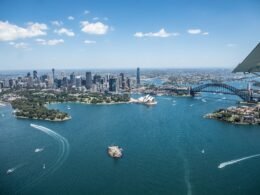
The Ultimate Guide To Visiting Sydney: What To See, Do & Eat

- United Arab Emirates
Do You Tip In Dubai?

- United States
How Many Days Is Enough To Visit The US?

How Expensive Is Australia As A Tourist?

- Netherlands
8 Incredible Places To Visit In The Netherlands
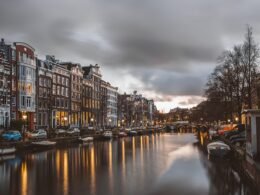
- Itineraries
Amsterdam Travel Guide: How To Spend 72 Hours In The City

IMAGES
VIDEO
COMMENTS
1. Seoul Eland Hangang River Cruise (from USD 10.05) Show all photos. The Seoul Eland Hangang River Cruise offers a delightful and scenic experience along the iconic Hangang River in Seoul, South Korea. This river cruise is a popular activity that allows visitors to explore the city from a unique perspective.
While the popular Seoul neighborhoods, like Dongdaemun and Gangnam, are beloved by Koreans and foreigners, only the locals know where the hidden gems are.There are many affordable activities to do in Seoul, but visiting these neighborhoods should be a top priority.Do as the locals do and visit these non-touristy, under-the-radar neighborhoods to get to know Seoul:
Here are KoreaToDo's TOP Hidden Attractions & Secret Places to Explore in Seoul(not in any particular order): 1. Starbucks The Bukhansan. Starbucks The Bukhansan offers stunning view of Bukhansan Mountain peaks. It is located near the popular Bukhansan National Park in the city center of Seoul.
How to get to Seonyudo Island Park. Getting to the island is easy no matter which side of the Han River you are coming from. From Seoul Station, take the subway for 8 stops all the way to Seonyudo Station. Take line 1 for 3 stops, change to line number 9 at Noryangjin, and ride for another 5 short stops.
My name is pronounced "rhyme" and I love (planned) wandering. Korea, the US and Hong Kong are all home to me :) 1. Hip boutiques in Hannam · 2. Gallery hopping in Samcheong-dong · 3. Explore the Brooklyn of Seoul, Seongsu-dong · 4. Bike along the Han River · 5. Bukhansan Dullegil.
Discover 31 hidden attractions, cool sights, and unusual things to do in Seoul from Yongma Land Abandoned Theme Park to Metro Farm. ... Try searching for a travel destination.
DON'T MISS One of the dawn chanting sessions. It starts before sunrise around 4am, but even if you're not an early riser, it's said to entirely recharge you. GETTING THERE It's in the ...
3. See the changing of the guards at the Gyeongbokgung Royal Palace. The Gyeongbokgung Royal Palace the main and most popular palace to visit of the five in Seoul. If you're going to take the time to see any, it should be this one. Try to time your visit to see the changing of the guards, which takes place every day except Tuesdays at 10am and 2pm
5: Take A Ghost Tour Around Seoul. Another spooky alternative activity in Seoul is a ghost tour where you can explore many hidden places in Seoul. Hosted by the Dark Side of Seoul, the English-language Seoul Ghost Walking Tour takes you around Seoul's most haunted streets and ghostly hotspots.
Non-tourist Transportation. The bus and subway took me where I needed to go. Most of the buses I rode in Seoul announced stops in English as well. Subway signs were also all in English. Use a T-Money transportation card. Then you can pay for all your transportation with one card.
We've highlighted our top nine non-touristy places to explore in Seoul so you can experience the city like a local. 1. Yangsu Bike Trail. One of our absolute favorite things to do in the area and past TEAN students have loved to explore the trails time and time again. The Yangsu Bike Trail is located about an hour east of Seoul.
With an incredible population of over 9 million people, Seoul, South Korea is known worldwide as a giant metropolis, celebrated for its rich history dating back as early as 18 BC, but most widely understood from its Joseon Dynasty beginnings in 1392. Today, Seoul is home to 4 UNESCO World Heritage Sites, state-of-the-art ecological parks and buildings, and a globally recognized performance ...
If you wear a traditional hanbok dress, they'll let you in for free. Why it's so awesome: The Gyeongbokgung Palace is often compared to the Forbidden City in Beijing and is a Seoul itinerary must-see. Built in 1395, it was the main royal palace of the Joseon family, who ruled Korea for hundreds of years.
Full Day- Essential Seoul City Tour & Gourmet Tourincluding Lunch & Dinner (rated very highly) Seoul City Sightseeing Tour Including Gyeongbokgung Palace, N Seoul Tower, & Namsangol Hanok Village (popular and sought-after) THING TO DO 5. Bukchon Hanok Village is one of the unusual things to do in Seoul.
2. N Seoul Tower. When it went up at the turn of the 1970s the N Seoul Tower was South Korea's first general broadcast tower. This Space Age building is at the summit of the 243-metre Namsan Mountain, and standing at more than 236 metres, the top of the tower is close to 480 metres above sea level.
12. Hike Inwangsan for easier city views. Less demanding than Bukhansan, 338m (1109ft) Ingwangsan still offers breathtaking views of Seoul for hikers, as well as a free history lesson. A series of ancient fortress walls are preserved here, and from the trail, you can spot Gyeongbokgung Palace in the distance.
Most major historical or cultural attractions in Korea are either free or cost less than W5,000 to visit. Of course, amusement parks and tickets to K-pop concerts can again be expensive in Korea. It's all about balance if you ask me. If you want to splurge on something, then visit some of these free places in Seoul to make up for it.
13. Take a day trip to the DMZ. One of the top day trips from Seoul, a visit to the northern border may well be the most unusual 24 hours you'll spend on the Korean peninsula. The 250km (160-mile) border between North and South known as the Demilitarized Zone (DMZ) is one of the world's most closely guarded borders.
Day 2: Nature Walks & Industrial Chic - Hidden Gems in Seoul Morning: Chill at Seonyudo Park - An Island Escape. Start your day with a visit to one the green hidden gems in Seoul: Seonyudo Park.This park was once an industrial water plant but has since been transformed into a tranquil green space on an island in the Han River.
Seoul is a place where East meets West, and old meets new. You have the famous Gyeongbokgung Palace amid skyscrapers, and traditional markets around the corner from Forever 21. There are so many fun things to do in Seoul because this city has it all! Seoul has incredible shopping, world-class food, rich culture and a lively nightlife scene.
Now, let's take a look at the best places to visit in Seoul! 1. Visit The Royal Palaces Visitors exploring the throne room at Gyeongbokgung Palace. The 5 royal palaces in Seoul were built during the Joseon Dynasty (1392-1910). They showcase beautiful architecture and centuries of important Korean history.
Our list of the Best Things to Do in Seoul, South Korea. Gwanghwamun & Jongno-gu. Gyeongbokgung. Bukchon Hanok Village. Changdeokgung. Jogye-sa. Jongmyo Shrine and Park. Take a Break from Palaces, Shrines and Temples and Eat at Insa-dong. Cheong-gye-cheon.
Go for a hike somewhere. Experience all the hiking adjosshis and ajummas. Get makolli and pajeon at the end of the hike on the mountain. Definitely check out a club in Gangnam. Nightlife is pretty much the best part of Korea. Go to Itaewon sometime from thursday~saturday night. Reply reply. uReallyShouldTrustMe. •.
So there you have it—3 non-touristy things to do in Seoul that are sure to have you feeling like a local. ... After all, if more people did it, that gives someone like me more time to explore all those tourist attractions you've decided to skip. Now that's a win-win. Safe and happy travels! 1. 0. 1. 0. Total. 1. Shares. Share. Tweet ...
Seoul is the epicenter of K-pop, and the best way to absorb this world is to visit a few K-pop sites. Get started on K-Star Road in Gangnam, which features life-sized statues of some of the biggest groups, depicted as bears. Next, you can visit the famous Gangnam Style statue, with its large gold-colored hands, and snap a selfie.